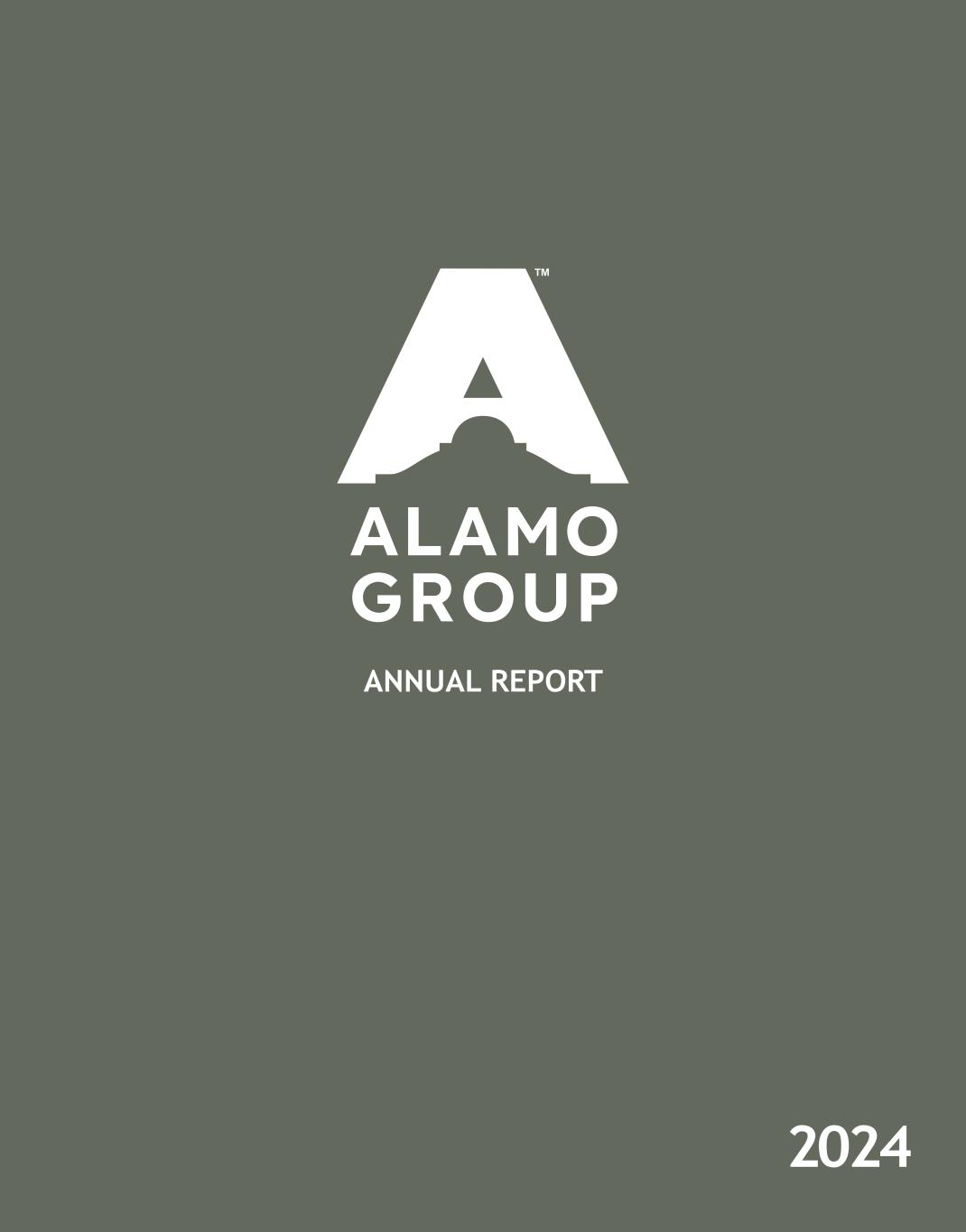
ANNUAL REPORT 2024

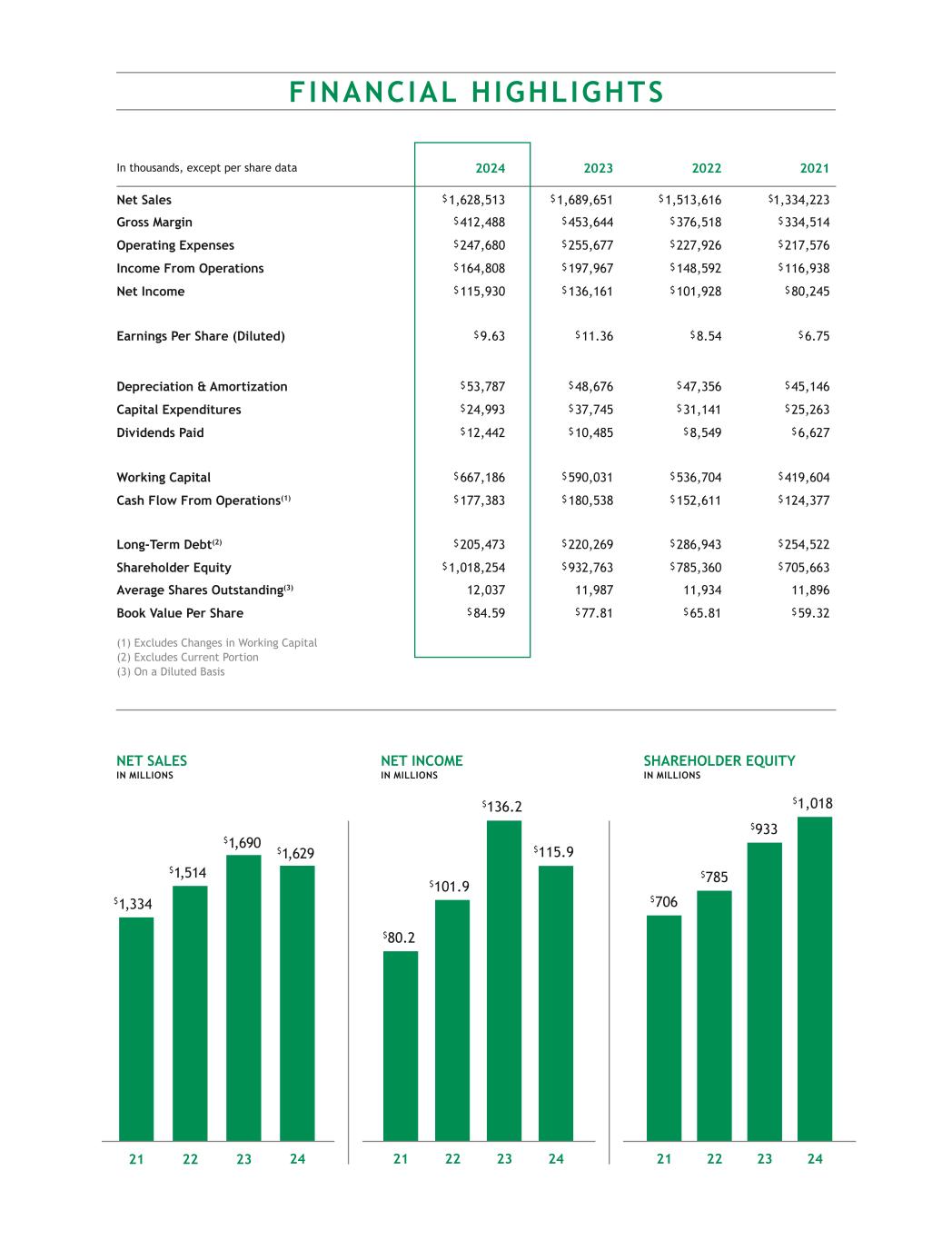
FINANCIAL HIGHLIGHTS In thousands, except per share data 2024 2023 2022 2021 Net Sales $1,628,513 $1,689,651 $1,513,616 $1,334,223 Gross Margin $412,488 $453,644 $376,518 $334,514 Operating Expenses $247,680 $255,677 $227,926 $217,576 Income From Operations $164,808 $197,967 $148,592 $116,938 Net Income $115,930 $136,161 $101,928 $80,245 Earnings Per Share (Diluted) $9.63 $11.36 $8.54 $6.75 Depreciation & Amortization $53,787 $48,676 $47,356 $45,146 Capital Expenditures $24,993 $37,745 $31,141 $25,263 Dividends Paid $12,442 $10,485 $8,549 $6,627 Working Capital $667,186 $590,031 $536,704 $419,604 Cash Flow From Operations(1) $177,383 $180,538 $152,611 $124,377 Long-Term Debt(2) $205,473 $220,269 $286,943 $254,522 Shareholder Equity $1,018,254 $932,763 $785,360 $705,663 Average Shares Outstanding(3) 12,037 11,987 11,934 11,896 Book Value Per Share $84.59 $77.81 $65.81 $59.32 (1) Excludes Changes in Working Capital (2) Excludes Current Portion (3) On a Diluted Basis NET SALES NET INCOME SHAREHOLDER EQUITY IN MILLIONS IN MILLIONS IN MILLIONS 24 $1,629 $115.9 24 $1,018 2422 23 $ $1,514 $1,690 1,334 21 $101.9 $136.2 $80.2 22 2321 $785 $933 $706 22 2321

What a difference a year makes. We entered 2024 following the best year in company history, with strong momentum across all of our markets and high expectations for another record year. However, as the year progressed, the combined effects of elevated interest rates and excess channel inventories drove activity levels sharply lower in several markets served by our Vegetation Management Division. Concurrently, demand within our Industrial Equipment Division remained historically strong as the governmental and industrial contractor markets continued to display significant strength throughout the year despite it being an election year in the United States. Sales in the Vegetation Management Division declined 19.8% due to lower demand from the agricultural and forestry/tree care sectors, while sales in the Industrial Equipment Division increased by 18.7%, sustained by historically strong demand from governmental agencies and industrial contractors. As a result of these divergent market forces and the sale of the Herschel parts business in August, the company’s consolidated 2024 sales declined $61.1 million or 3.6% compared to the prior year. To address the impact of the softness in Vegetation Management, we implemented a series of measures to eliminate excess capacity, reduce operating costs, and reduce working capital. These actions included two large manufacturing facility consolidations in the USA, a series of initiatives to reduce inventory across the company, and a focus at all levels on cash management. Associated with these actions, we reduced our global employee population by nearly 14%. Taken together, these actions will result in annual cost reduction of $25–30 million starting in the third quarter of 2024. Our cash management initiatives produced solid results. Year-over-year inventory declined by 9% and accounts receivable declined by 16%. I am also pleased to report that our balance sheet strengthened considerably during the second half of the year. Intense focus on working capital efficiency allowed the company to accelerate debt repayments such that we ended the year with net debt of just $23 million, a year-over-year debt reduction of $160 million. This was obviously a very busy year across the company. The combination of the strong performance of the Industrial Equipment Division and the aggressive cost reduction and efficiency measures taken in the Vegetation Management Division allowed the company to produce a double-digit operating margin for the year despite the significant market headwinds we encountered in Vegetation Management. As we enter 2025, we are optimistic that we will see a steady, if modest, improvement in markets for our Vegetation Management Division in the second half of the year. The Industrial Equipment Division enters the year with good momentum and a strong backlog that give us confidence of another strong performance in that part of the company. With the benefit of the actions taken in 2024 and supported by additional efficiency improvement measures to be taken in 2025, we anticipate that the company will produce improved top and bottom-line performance this year. As always, we are deeply grateful for the support of our shareholders and other stakeholders for your continued support. Jeffery A. Leonard President and CEO Alamo Group Inc. LETTER TO OUR SHAREHOLDERS

EARNINGS PER SHARE EBITDA* DILUTED IN MILLIONS * EBITDA is a non-GAAP financial measure, defined for this purpose as net income before interest, taxes, depreciation and amortization. 2322 $6.75 $8.54 $11.36 22 23 $194.6 $220.6 $247.7 $163.4 2124 $9.63 21 24

ALAMO GROUP CORPORATE PROFILE Alamo Group is a leader in the design, manufacture, distribution and service of high quality equipment for infrastructure maintenance, agriculture and other applications. Our products include truck—and tractor— mounted mowing and other vegetation maintenance equipment, street sweepers, snow removal equipment, excavators, vacuum trucks, other industrial equipment, agricultural implements, forestry equipment and related after-market parts and services. The Company, founded in 1969, has approximately 3,750 employees and operates 28 plants in North America, Europe, Australia and Brazil as of December 31, 2024. The corporate offices of Alamo Group Inc. are located in Seguin, Texas. Vegetation Management Division Our Vegetation Management Division produces a wide range of equipment for the maintenance, management and recycling of organic materials. The Division’s products include a wide array of mowing equipment from rotary cutters to boom-mounted flail mowers as well as forestry and tree-care equipment such as tree chippers, stump grinders, mulchers, and brush cutters. Industrial Equipment Division Our Industrial Equipment Division produces a wide range of equipment for infrastructure maintenance on and around highways, airports, industrial properties, parks and recreational facilities, commercial landscapes and other specialty use areas. The Division’s products include excavators, vacuum trucks, street sweepers, truck mounted attenuator trucks, debris collectors and snow removal equipment. SALES BY DIVISION IN MILLIONS Vegetation Management Industrial Equipment $1,334 $1,514 $1,690 2221 $521 $813 $937 $577 $979 $711 23 $1,629 $785 $844 24
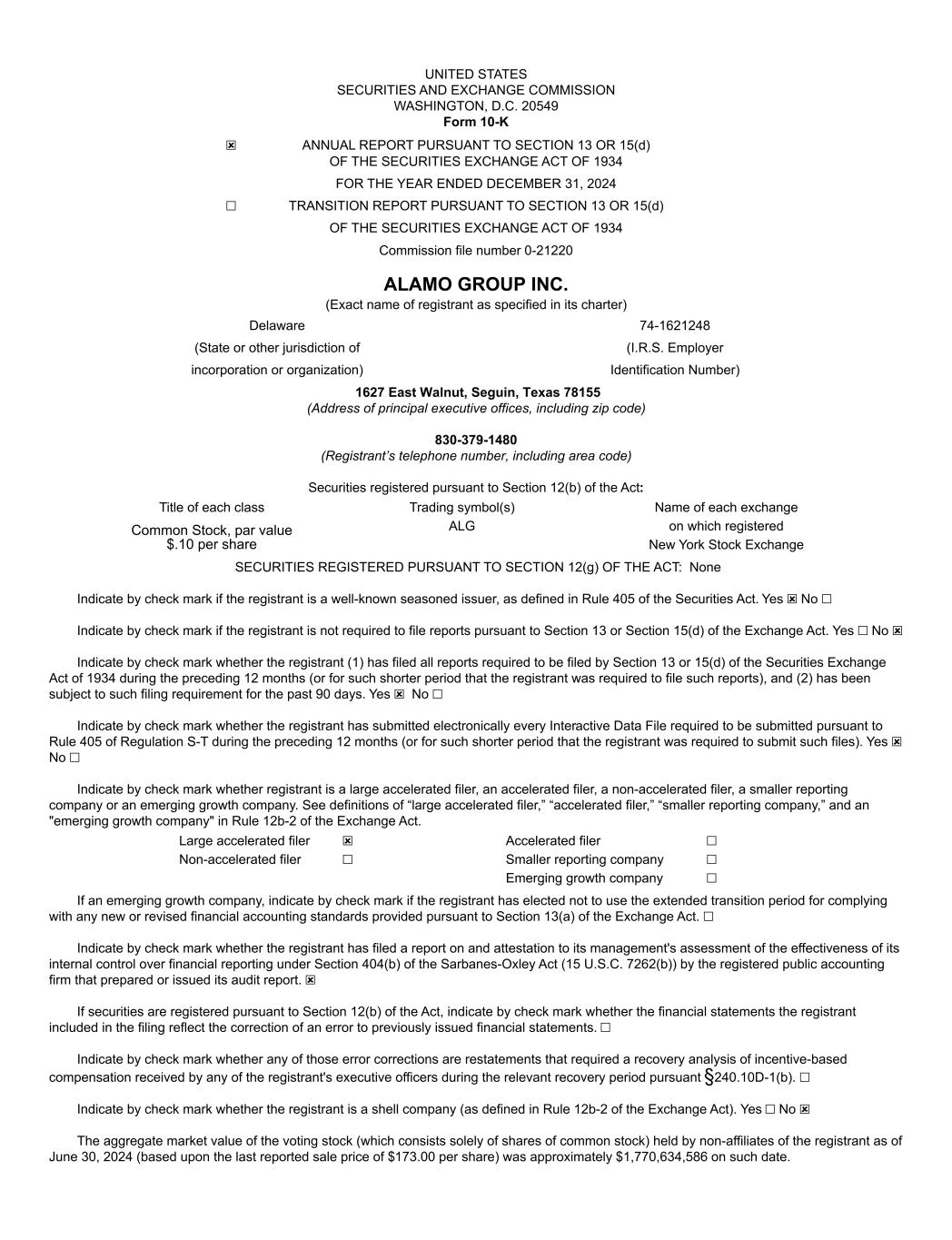
UNITED STATES SECURITIES AND EXCHANGE COMMISSION WASHINGTON, D.C. 20549 Form 10-K ☒ ANNUAL REPORT PURSUANT TO SECTION 13 OR 15(d) OF THE SECURITIES EXCHANGE ACT OF 1934 FOR THE YEAR ENDED DECEMBER 31, 2024 ☐ TRANSITION REPORT PURSUANT TO SECTION 13 OR 15(d) OF THE SECURITIES EXCHANGE ACT OF 1934 Commission file number 0-21220 ALAMO GROUP INC. (Exact name of registrant as specified in its charter) Delaware 74-1621248 (State or other jurisdiction of (I.R.S. Employer incorporation or organization) Identification Number) 1627 East Walnut, Seguin, Texas 78155 (Address of principal executive offices, including zip code) 830-379-1480 (Registrant’s telephone number, including area code) Securities registered pursuant to Section 12(b) of the Act: Title of each class Trading symbol(s) Name of each exchange Common Stock, par value $.10 per share ALG on which registered New York Stock Exchange SECURITIES REGISTERED PURSUANT TO SECTION 12(g) OF THE ACT: None Indicate by check mark if the registrant is a well-known seasoned issuer, as defined in Rule 405 of the Securities Act. Yes ☒ No ☐ Indicate by check mark if the registrant is not required to file reports pursuant to Section 13 or Section 15(d) of the Exchange Act. Yes ☐ No ☒ Indicate by check mark whether the registrant (1) has filed all reports required to be filed by Section 13 or 15(d) of the Securities Exchange Act of 1934 during the preceding 12 months (or for such shorter period that the registrant was required to file such reports), and (2) has been subject to such filing requirement for the past 90 days. Yes ☒ No ☐ Indicate by check mark whether the registrant has submitted electronically every Interactive Data File required to be submitted pursuant to Rule 405 of Regulation S-T during the preceding 12 months (or for such shorter period that the registrant was required to submit such files). Yes ☒ No ☐ Indicate by check mark whether registrant is a large accelerated filer, an accelerated filer, a non-accelerated filer, a smaller reporting company or an emerging growth company. See definitions of “large accelerated filer,” “accelerated filer,” “smaller reporting company,” and an "emerging growth company" in Rule 12b-2 of the Exchange Act. Large accelerated filer ☒ Accelerated filer ☐ Non-accelerated filer ☐ Smaller reporting company ☐ Emerging growth company ☐ If an emerging growth company, indicate by check mark if the registrant has elected not to use the extended transition period for complying with any new or revised financial accounting standards provided pursuant to Section 13(a) of the Exchange Act. ☐ Indicate by check mark whether the registrant has filed a report on and attestation to its management's assessment of the effectiveness of its internal control over financial reporting under Section 404(b) of the Sarbanes-Oxley Act (15 U.S.C. 7262(b)) by the registered public accounting firm that prepared or issued its audit report. ☒ If securities are registered pursuant to Section 12(b) of the Act, indicate by check mark whether the financial statements the registrant included in the filing reflect the correction of an error to previously issued financial statements. ☐ Indicate by check mark whether any of those error corrections are restatements that required a recovery analysis of incentive-based compensation received by any of the registrant's executive officers during the relevant recovery period pursuant §240.10D-1(b). ☐ Indicate by check mark whether the registrant is a shell company (as defined in Rule 12b-2 of the Exchange Act). Yes ☐ No ☒ The aggregate market value of the voting stock (which consists solely of shares of common stock) held by non-affiliates of the registrant as of June 30, 2024 (based upon the last reported sale price of $173.00 per share) was approximately $1,770,634,586 on such date.
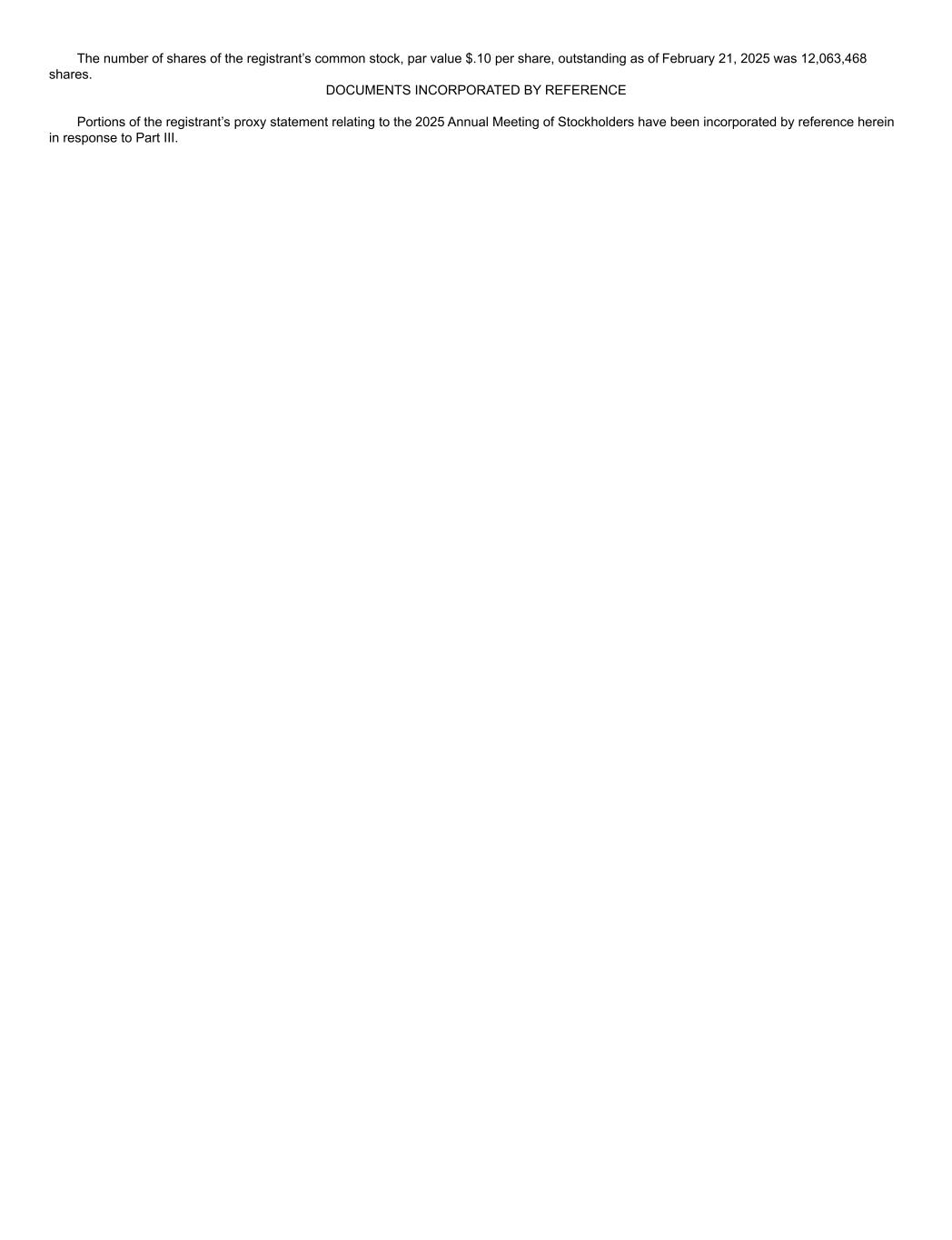
The number of shares of the registrant’s common stock, par value $.10 per share, outstanding as of February 21, 2025 was 12,063,468 shares. DOCUMENTS INCORPORATED BY REFERENCE Portions of the registrant’s proxy statement relating to the 2025 Annual Meeting of Stockholders have been incorporated by reference herein in response to Part III.
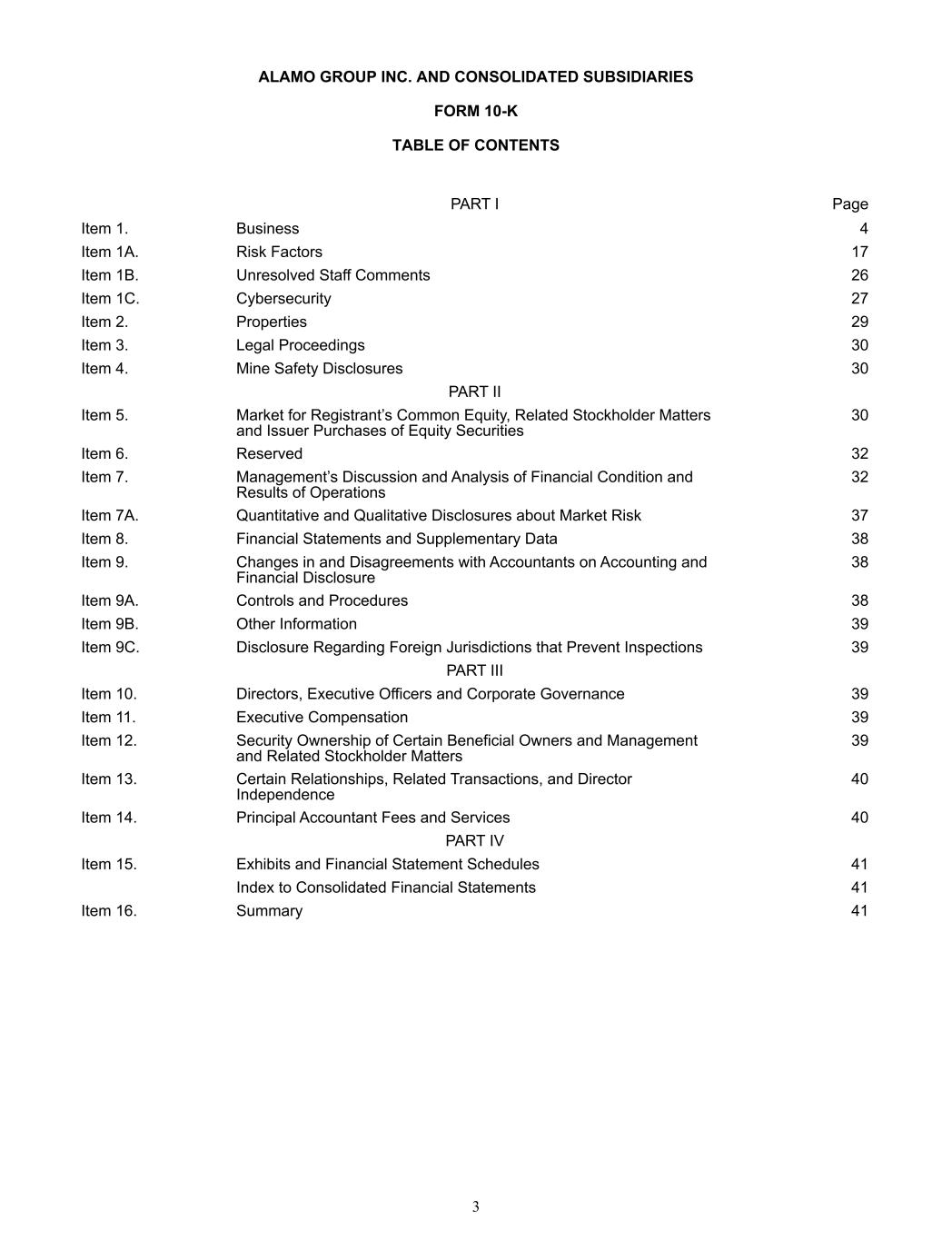
ALAMO GROUP INC. AND CONSOLIDATED SUBSIDIARIES FORM 10-K TABLE OF CONTENTS PART I Page Item 1. Business 4 Item 1A. Risk Factors 17 Item 1B. Unresolved Staff Comments 26 Item 1C. Cybersecurity 27 Item 2. Properties 29 Item 3. Legal Proceedings 30 Item 4. Mine Safety Disclosures 30 PART II Item 5. Market for Registrant’s Common Equity, Related Stockholder Matters and Issuer Purchases of Equity Securities 30 Item 6. Reserved 32 Item 7. Management’s Discussion and Analysis of Financial Condition and Results of Operations 32 Item 7A. Quantitative and Qualitative Disclosures about Market Risk 37 Item 8. Financial Statements and Supplementary Data 38 Item 9. Changes in and Disagreements with Accountants on Accounting and Financial Disclosure 38 Item 9A. Controls and Procedures 38 Item 9B. Other Information 39 Item 9C. Disclosure Regarding Foreign Jurisdictions that Prevent Inspections 39 PART III Item 10. Directors, Executive Officers and Corporate Governance 39 Item 11. Executive Compensation 39 Item 12. Security Ownership of Certain Beneficial Owners and Management and Related Stockholder Matters 39 Item 13. Certain Relationships, Related Transactions, and Director Independence 40 Item 14. Principal Accountant Fees and Services 40 PART IV Item 15. Exhibits and Financial Statement Schedules 41 Index to Consolidated Financial Statements 41 Item 16. Summary 41 3
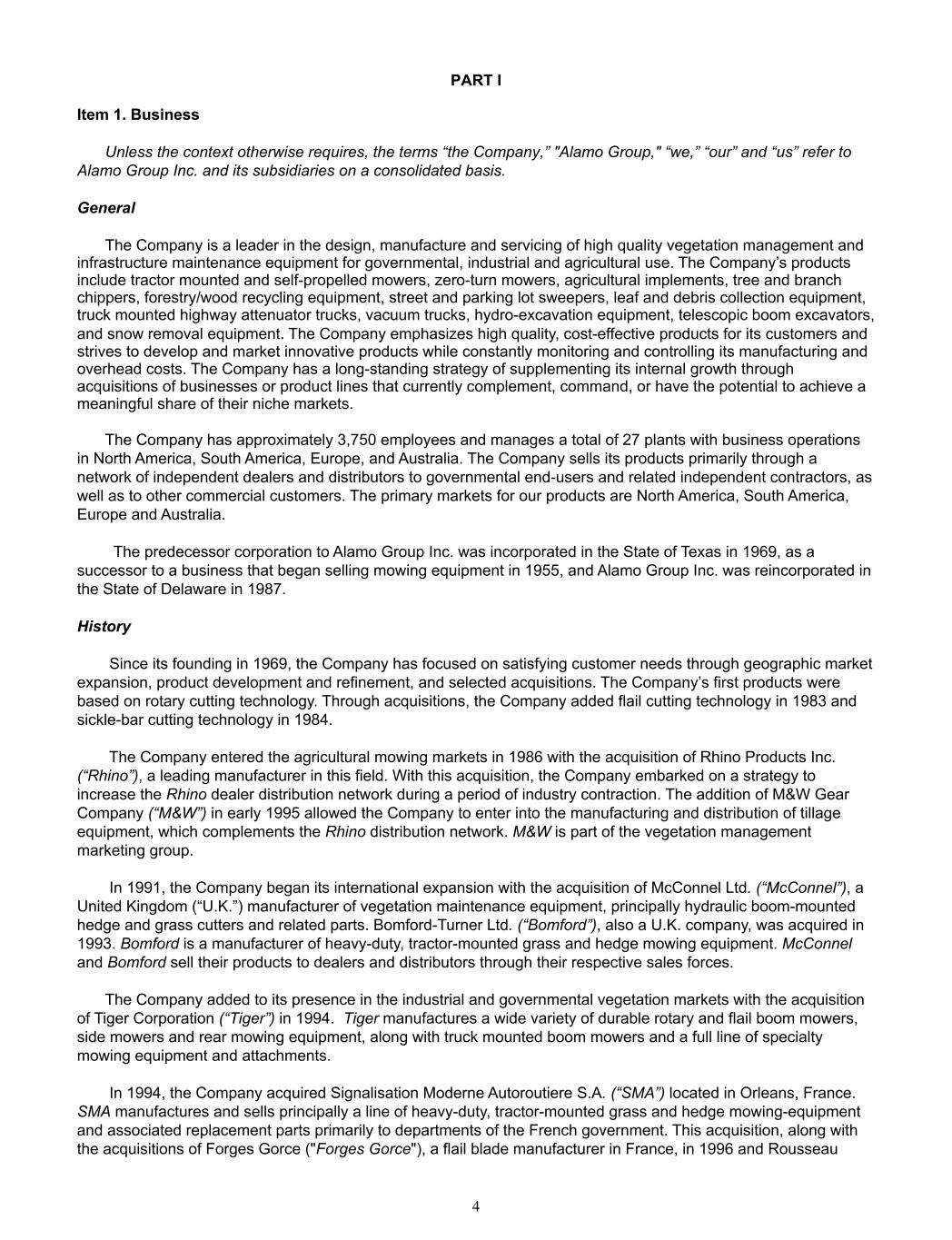
PART I Item 1. Business Unless the context otherwise requires, the terms “the Company,” "Alamo Group," “we,” “our” and “us” refer to Alamo Group Inc. and its subsidiaries on a consolidated basis. General The Company is a leader in the design, manufacture and servicing of high quality vegetation management and infrastructure maintenance equipment for governmental, industrial and agricultural use. The Company’s products include tractor mounted and self-propelled mowers, zero-turn mowers, agricultural implements, tree and branch chippers, forestry/wood recycling equipment, street and parking lot sweepers, leaf and debris collection equipment, truck mounted highway attenuator trucks, vacuum trucks, hydro-excavation equipment, telescopic boom excavators, and snow removal equipment. The Company emphasizes high quality, cost-effective products for its customers and strives to develop and market innovative products while constantly monitoring and controlling its manufacturing and overhead costs. The Company has a long-standing strategy of supplementing its internal growth through acquisitions of businesses or product lines that currently complement, command, or have the potential to achieve a meaningful share of their niche markets. The Company has approximately 3,750 employees and manages a total of 27 plants with business operations in North America, South America, Europe, and Australia. The Company sells its products primarily through a network of independent dealers and distributors to governmental end-users and related independent contractors, as well as to other commercial customers. The primary markets for our products are North America, South America, Europe and Australia. The predecessor corporation to Alamo Group Inc. was incorporated in the State of Texas in 1969, as a successor to a business that began selling mowing equipment in 1955, and Alamo Group Inc. was reincorporated in the State of Delaware in 1987. History Since its founding in 1969, the Company has focused on satisfying customer needs through geographic market expansion, product development and refinement, and selected acquisitions. The Company’s first products were based on rotary cutting technology. Through acquisitions, the Company added flail cutting technology in 1983 and sickle-bar cutting technology in 1984. The Company entered the agricultural mowing markets in 1986 with the acquisition of Rhino Products Inc. (“Rhino”), a leading manufacturer in this field. With this acquisition, the Company embarked on a strategy to increase the Rhino dealer distribution network during a period of industry contraction. The addition of M&W Gear Company (“M&W”) in early 1995 allowed the Company to enter into the manufacturing and distribution of tillage equipment, which complements the Rhino distribution network. M&W is part of the vegetation management marketing group. In 1991, the Company began its international expansion with the acquisition of McConnel Ltd. (“McConnel”), a United Kingdom (“U.K.”) manufacturer of vegetation maintenance equipment, principally hydraulic boom-mounted hedge and grass cutters and related parts. Bomford-Turner Ltd. (“Bomford”), also a U.K. company, was acquired in 1993. Bomford is a manufacturer of heavy-duty, tractor-mounted grass and hedge mowing equipment. McConnel and Bomford sell their products to dealers and distributors through their respective sales forces. The Company added to its presence in the industrial and governmental vegetation markets with the acquisition of Tiger Corporation (“Tiger”) in 1994. Tiger manufactures a wide variety of durable rotary and flail boom mowers, side mowers and rear mowing equipment, along with truck mounted boom mowers and a full line of specialty mowing equipment and attachments. In 1994, the Company acquired Signalisation Moderne Autoroutiere S.A. (“SMA”) located in Orleans, France. SMA manufactures and sells principally a line of heavy-duty, tractor-mounted grass and hedge mowing-equipment and associated replacement parts primarily to departments of the French government. This acquisition, along with the acquisitions of Forges Gorce ("Forges Gorce"), a flail blade manufacturer in France, in 1996 and Rousseau 4
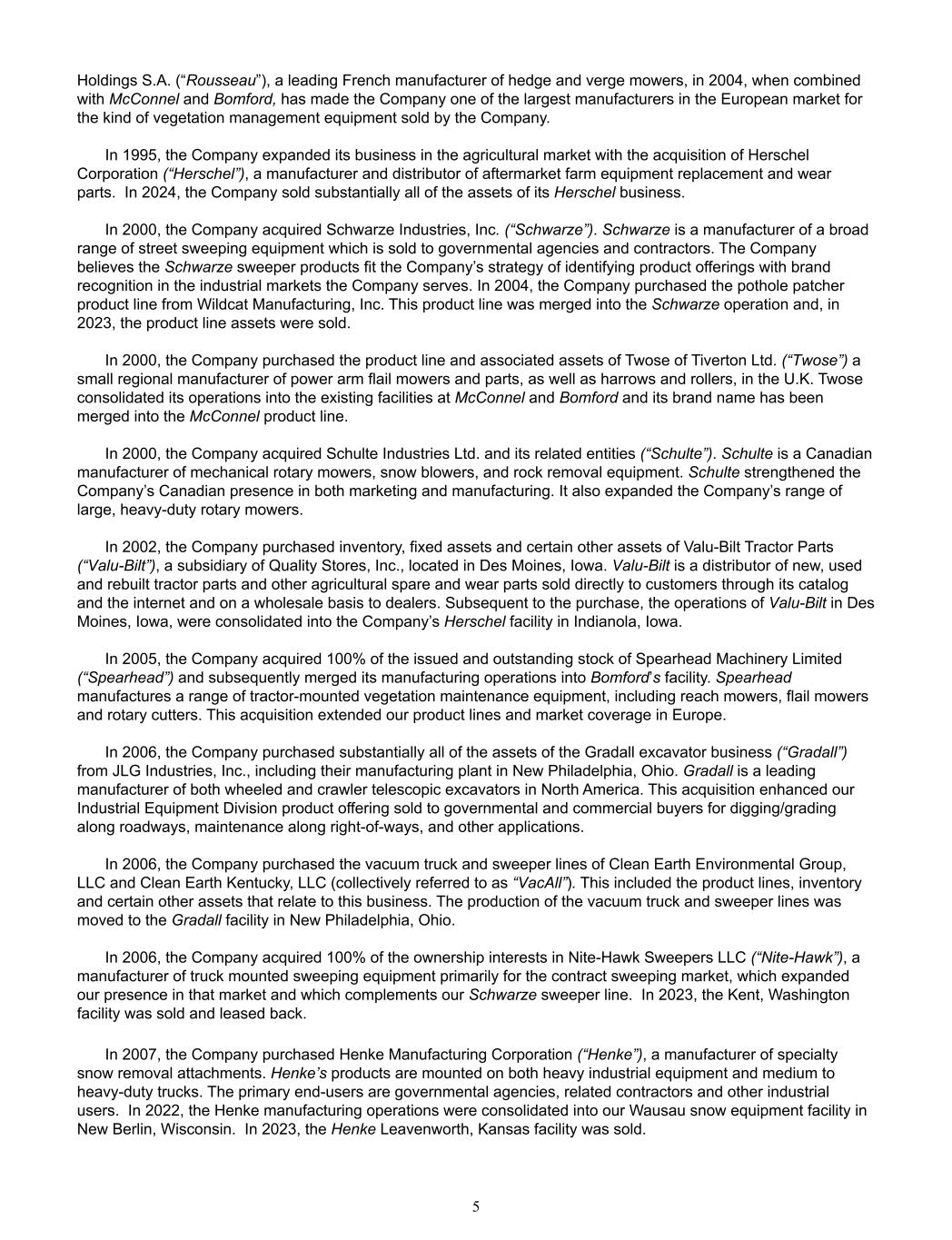
Holdings S.A. (“Rousseau”), a leading French manufacturer of hedge and verge mowers, in 2004, when combined with McConnel and Bomford, has made the Company one of the largest manufacturers in the European market for the kind of vegetation management equipment sold by the Company. In 1995, the Company expanded its business in the agricultural market with the acquisition of Herschel Corporation (“Herschel”), a manufacturer and distributor of aftermarket farm equipment replacement and wear parts. In 2024, the Company sold substantially all of the assets of its Herschel business. In 2000, the Company acquired Schwarze Industries, Inc. (“Schwarze”). Schwarze is a manufacturer of a broad range of street sweeping equipment which is sold to governmental agencies and contractors. The Company believes the Schwarze sweeper products fit the Company’s strategy of identifying product offerings with brand recognition in the industrial markets the Company serves. In 2004, the Company purchased the pothole patcher product line from Wildcat Manufacturing, Inc. This product line was merged into the Schwarze operation and, in 2023, the product line assets were sold. In 2000, the Company purchased the product line and associated assets of Twose of Tiverton Ltd. (“Twose”) a small regional manufacturer of power arm flail mowers and parts, as well as harrows and rollers, in the U.K. Twose consolidated its operations into the existing facilities at McConnel and Bomford and its brand name has been merged into the McConnel product line. In 2000, the Company acquired Schulte Industries Ltd. and its related entities (“Schulte”). Schulte is a Canadian manufacturer of mechanical rotary mowers, snow blowers, and rock removal equipment. Schulte strengthened the Company’s Canadian presence in both marketing and manufacturing. It also expanded the Company’s range of large, heavy-duty rotary mowers. In 2002, the Company purchased inventory, fixed assets and certain other assets of Valu-Bilt Tractor Parts (“Valu-Bilt”), a subsidiary of Quality Stores, Inc., located in Des Moines, Iowa. Valu-Bilt is a distributor of new, used and rebuilt tractor parts and other agricultural spare and wear parts sold directly to customers through its catalog and the internet and on a wholesale basis to dealers. Subsequent to the purchase, the operations of Valu-Bilt in Des Moines, Iowa, were consolidated into the Company’s Herschel facility in Indianola, Iowa. In 2005, the Company acquired 100% of the issued and outstanding stock of Spearhead Machinery Limited (“Spearhead”) and subsequently merged its manufacturing operations into Bomford’s facility. Spearhead manufactures a range of tractor-mounted vegetation maintenance equipment, including reach mowers, flail mowers and rotary cutters. This acquisition extended our product lines and market coverage in Europe. In 2006, the Company purchased substantially all of the assets of the Gradall excavator business (“Gradall”) from JLG Industries, Inc., including their manufacturing plant in New Philadelphia, Ohio. Gradall is a leading manufacturer of both wheeled and crawler telescopic excavators in North America. This acquisition enhanced our Industrial Equipment Division product offering sold to governmental and commercial buyers for digging/grading along roadways, maintenance along right-of-ways, and other applications. In 2006, the Company purchased the vacuum truck and sweeper lines of Clean Earth Environmental Group, LLC and Clean Earth Kentucky, LLC (collectively referred to as “VacAll”). This included the product lines, inventory and certain other assets that relate to this business. The production of the vacuum truck and sweeper lines was moved to the Gradall facility in New Philadelphia, Ohio. In 2006, the Company acquired 100% of the ownership interests in Nite-Hawk Sweepers LLC (“Nite-Hawk”), a manufacturer of truck mounted sweeping equipment primarily for the contract sweeping market, which expanded our presence in that market and which complements our Schwarze sweeper line. In 2023, the Kent, Washington facility was sold and leased back. In 2007, the Company purchased Henke Manufacturing Corporation (“Henke”), a manufacturer of specialty snow removal attachments. Henke’s products are mounted on both heavy industrial equipment and medium to heavy-duty trucks. The primary end-users are governmental agencies, related contractors and other industrial users. In 2022, the Henke manufacturing operations were consolidated into our Wausau snow equipment facility in New Berlin, Wisconsin. In 2023, the Henke Leavenworth, Kansas facility was sold. 5
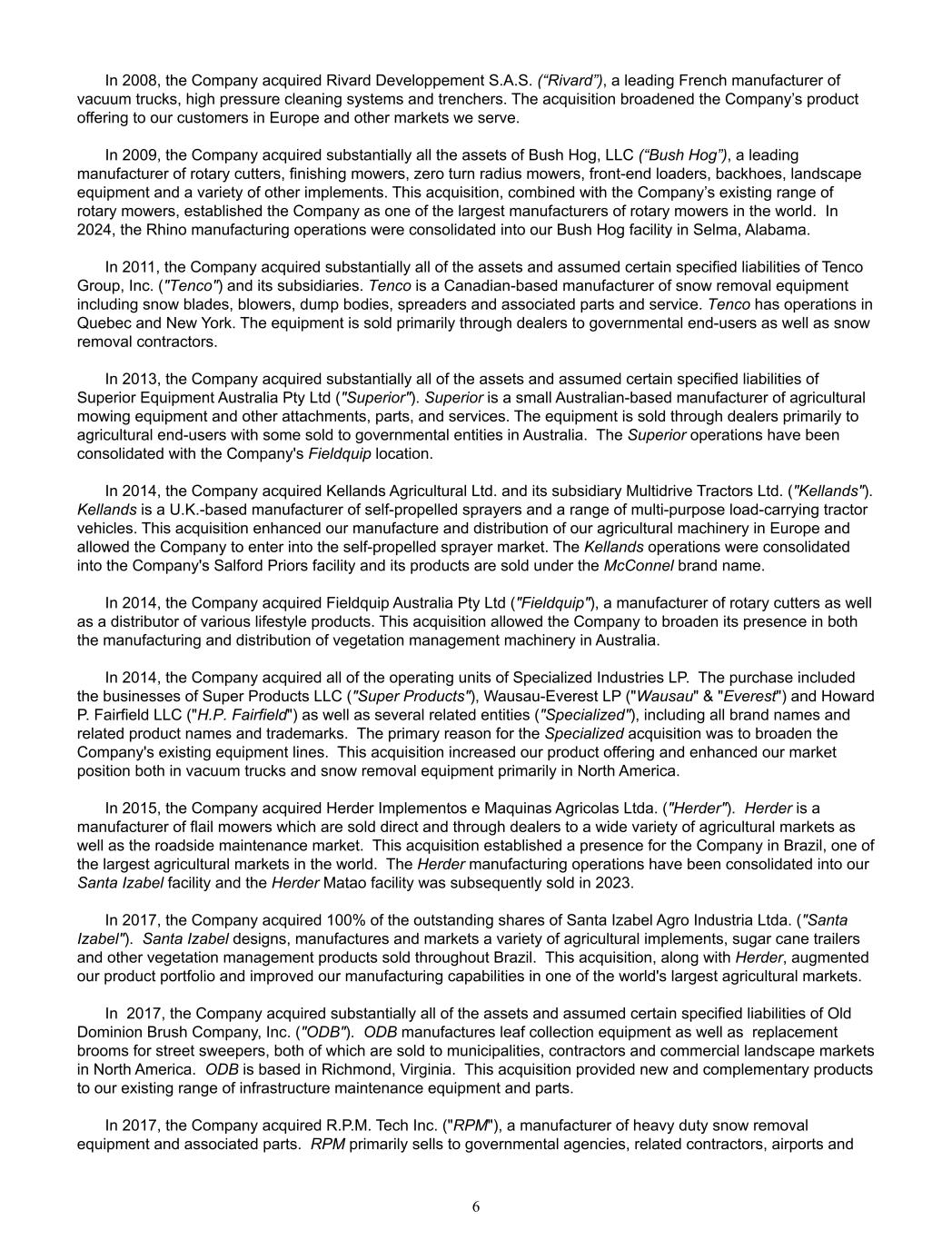
In 2008, the Company acquired Rivard Developpement S.A.S. (“Rivard”), a leading French manufacturer of vacuum trucks, high pressure cleaning systems and trenchers. The acquisition broadened the Company’s product offering to our customers in Europe and other markets we serve. In 2009, the Company acquired substantially all the assets of Bush Hog, LLC (“Bush Hog”), a leading manufacturer of rotary cutters, finishing mowers, zero turn radius mowers, front-end loaders, backhoes, landscape equipment and a variety of other implements. This acquisition, combined with the Company’s existing range of rotary mowers, established the Company as one of the largest manufacturers of rotary mowers in the world. In 2024, the Rhino manufacturing operations were consolidated into our Bush Hog facility in Selma, Alabama. In 2011, the Company acquired substantially all of the assets and assumed certain specified liabilities of Tenco Group, Inc. ("Tenco") and its subsidiaries. Tenco is a Canadian-based manufacturer of snow removal equipment including snow blades, blowers, dump bodies, spreaders and associated parts and service. Tenco has operations in Quebec and New York. The equipment is sold primarily through dealers to governmental end-users as well as snow removal contractors. In 2013, the Company acquired substantially all of the assets and assumed certain specified liabilities of Superior Equipment Australia Pty Ltd ("Superior"). Superior is a small Australian-based manufacturer of agricultural mowing equipment and other attachments, parts, and services. The equipment is sold through dealers primarily to agricultural end-users with some sold to governmental entities in Australia. The Superior operations have been consolidated with the Company's Fieldquip location. In 2014, the Company acquired Kellands Agricultural Ltd. and its subsidiary Multidrive Tractors Ltd. ("Kellands"). Kellands is a U.K.-based manufacturer of self-propelled sprayers and a range of multi-purpose load-carrying tractor vehicles. This acquisition enhanced our manufacture and distribution of our agricultural machinery in Europe and allowed the Company to enter into the self-propelled sprayer market. The Kellands operations were consolidated into the Company's Salford Priors facility and its products are sold under the McConnel brand name. In 2014, the Company acquired Fieldquip Australia Pty Ltd ("Fieldquip"), a manufacturer of rotary cutters as well as a distributor of various lifestyle products. This acquisition allowed the Company to broaden its presence in both the manufacturing and distribution of vegetation management machinery in Australia. In 2014, the Company acquired all of the operating units of Specialized Industries LP. The purchase included the businesses of Super Products LLC ("Super Products"), Wausau-Everest LP ("Wausau" & "Everest") and Howard P. Fairfield LLC ("H.P. Fairfield") as well as several related entities ("Specialized"), including all brand names and related product names and trademarks. The primary reason for the Specialized acquisition was to broaden the Company's existing equipment lines. This acquisition increased our product offering and enhanced our market position both in vacuum trucks and snow removal equipment primarily in North America. In 2015, the Company acquired Herder Implementos e Maquinas Agricolas Ltda. ("Herder"). Herder is a manufacturer of flail mowers which are sold direct and through dealers to a wide variety of agricultural markets as well as the roadside maintenance market. This acquisition established a presence for the Company in Brazil, one of the largest agricultural markets in the world. The Herder manufacturing operations have been consolidated into our Santa Izabel facility and the Herder Matao facility was subsequently sold in 2023. In 2017, the Company acquired 100% of the outstanding shares of Santa Izabel Agro Industria Ltda. ("Santa Izabel"). Santa Izabel designs, manufactures and markets a variety of agricultural implements, sugar cane trailers and other vegetation management products sold throughout Brazil. This acquisition, along with Herder, augmented our product portfolio and improved our manufacturing capabilities in one of the world's largest agricultural markets. In 2017, the Company acquired substantially all of the assets and assumed certain specified liabilities of Old Dominion Brush Company, Inc. ("ODB"). ODB manufactures leaf collection equipment as well as replacement brooms for street sweepers, both of which are sold to municipalities, contractors and commercial landscape markets in North America. ODB is based in Richmond, Virginia. This acquisition provided new and complementary products to our existing range of infrastructure maintenance equipment and parts. In 2017, the Company acquired R.P.M. Tech Inc. ("RPM"), a manufacturer of heavy duty snow removal equipment and associated parts. RPM primarily sells to governmental agencies, related contractors, airports and 6
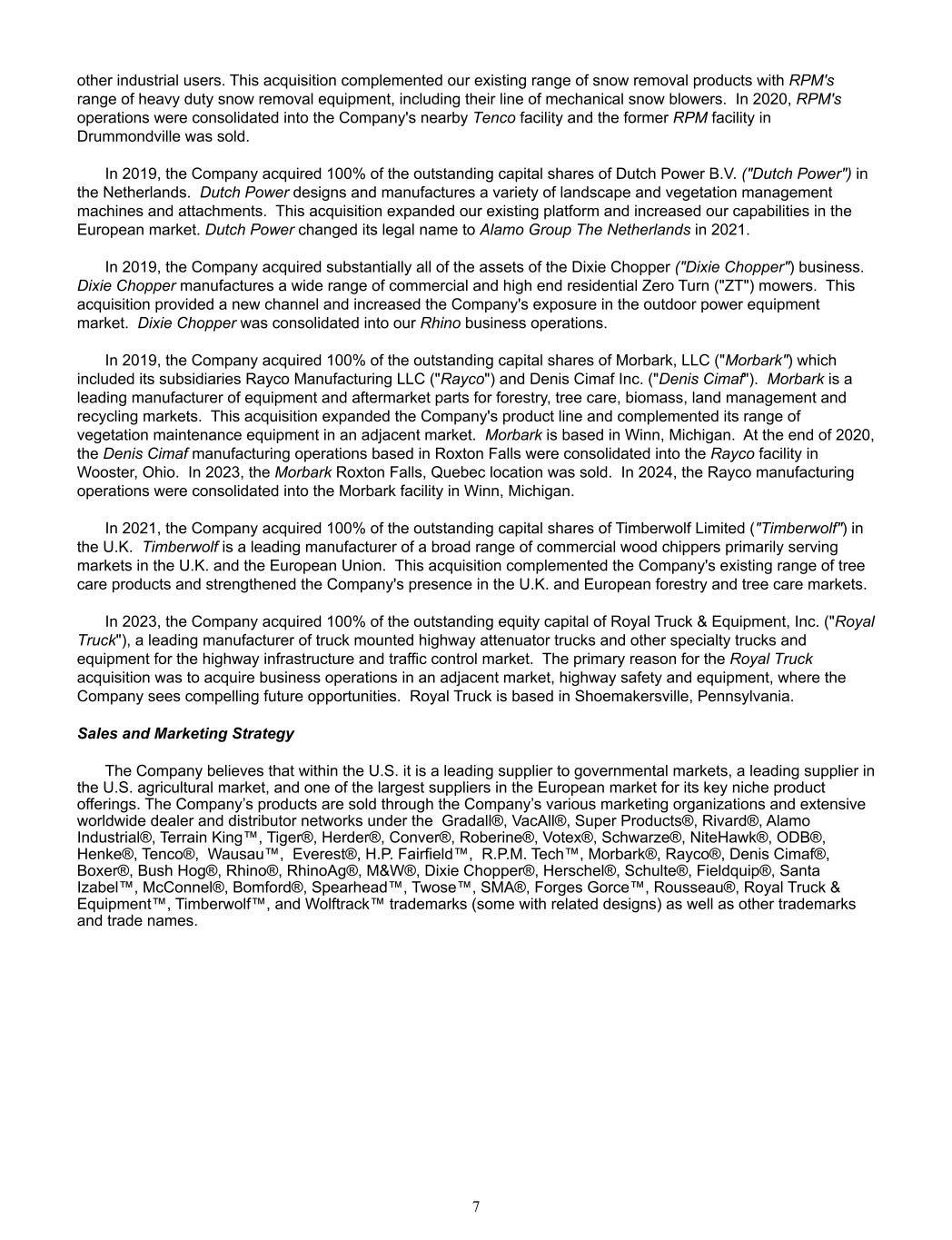
other industrial users. This acquisition complemented our existing range of snow removal products with RPM's range of heavy duty snow removal equipment, including their line of mechanical snow blowers. In 2020, RPM's operations were consolidated into the Company's nearby Tenco facility and the former RPM facility in Drummondville was sold. In 2019, the Company acquired 100% of the outstanding capital shares of Dutch Power B.V. ("Dutch Power") in the Netherlands. Dutch Power designs and manufactures a variety of landscape and vegetation management machines and attachments. This acquisition expanded our existing platform and increased our capabilities in the European market. Dutch Power changed its legal name to Alamo Group The Netherlands in 2021. In 2019, the Company acquired substantially all of the assets of the Dixie Chopper ("Dixie Chopper") business. Dixie Chopper manufactures a wide range of commercial and high end residential Zero Turn ("ZT") mowers. This acquisition provided a new channel and increased the Company's exposure in the outdoor power equipment market. Dixie Chopper was consolidated into our Rhino business operations. In 2019, the Company acquired 100% of the outstanding capital shares of Morbark, LLC ("Morbark") which included its subsidiaries Rayco Manufacturing LLC ("Rayco") and Denis Cimaf Inc. ("Denis Cimaf"). Morbark is a leading manufacturer of equipment and aftermarket parts for forestry, tree care, biomass, land management and recycling markets. This acquisition expanded the Company's product line and complemented its range of vegetation maintenance equipment in an adjacent market. Morbark is based in Winn, Michigan. At the end of 2020, the Denis Cimaf manufacturing operations based in Roxton Falls were consolidated into the Rayco facility in Wooster, Ohio. In 2023, the Morbark Roxton Falls, Quebec location was sold. In 2024, the Rayco manufacturing operations were consolidated into the Morbark facility in Winn, Michigan. In 2021, the Company acquired 100% of the outstanding capital shares of Timberwolf Limited ("Timberwolf") in the U.K. Timberwolf is a leading manufacturer of a broad range of commercial wood chippers primarily serving markets in the U.K. and the European Union. This acquisition complemented the Company's existing range of tree care products and strengthened the Company's presence in the U.K. and European forestry and tree care markets. In 2023, the Company acquired 100% of the outstanding equity capital of Royal Truck & Equipment, Inc. ("Royal Truck"), a leading manufacturer of truck mounted highway attenuator trucks and other specialty trucks and equipment for the highway infrastructure and traffic control market. The primary reason for the Royal Truck acquisition was to acquire business operations in an adjacent market, highway safety and equipment, where the Company sees compelling future opportunities. Royal Truck is based in Shoemakersville, Pennsylvania. Sales and Marketing Strategy The Company believes that within the U.S. it is a leading supplier to governmental markets, a leading supplier in the U.S. agricultural market, and one of the largest suppliers in the European market for its key niche product offerings. The Company’s products are sold through the Company’s various marketing organizations and extensive worldwide dealer and distributor networks under the Gradall®, VacAll®, Super Products®, Rivard®, Alamo Industrial®, Terrain King™, Tiger®, Herder®, Conver®, Roberine®, Votex®, Schwarze®, NiteHawk®, ODB®, Henke®, Tenco®, Wausau™, Everest®, H.P. Fairfield™, R.P.M. Tech™, Morbark®, Rayco®, Denis Cimaf®, Boxer®, Bush Hog®, Rhino®, RhinoAg®, M&W®, Dixie Chopper®, Herschel®, Schulte®, Fieldquip®, Santa Izabel™, McConnel®, Bomford®, Spearhead™, Twose™, SMA®, Forges Gorce™, Rousseau®, Royal Truck & Equipment™, Timberwolf™, and Wolftrack™ trademarks (some with related designs) as well as other trademarks and trade names. 7
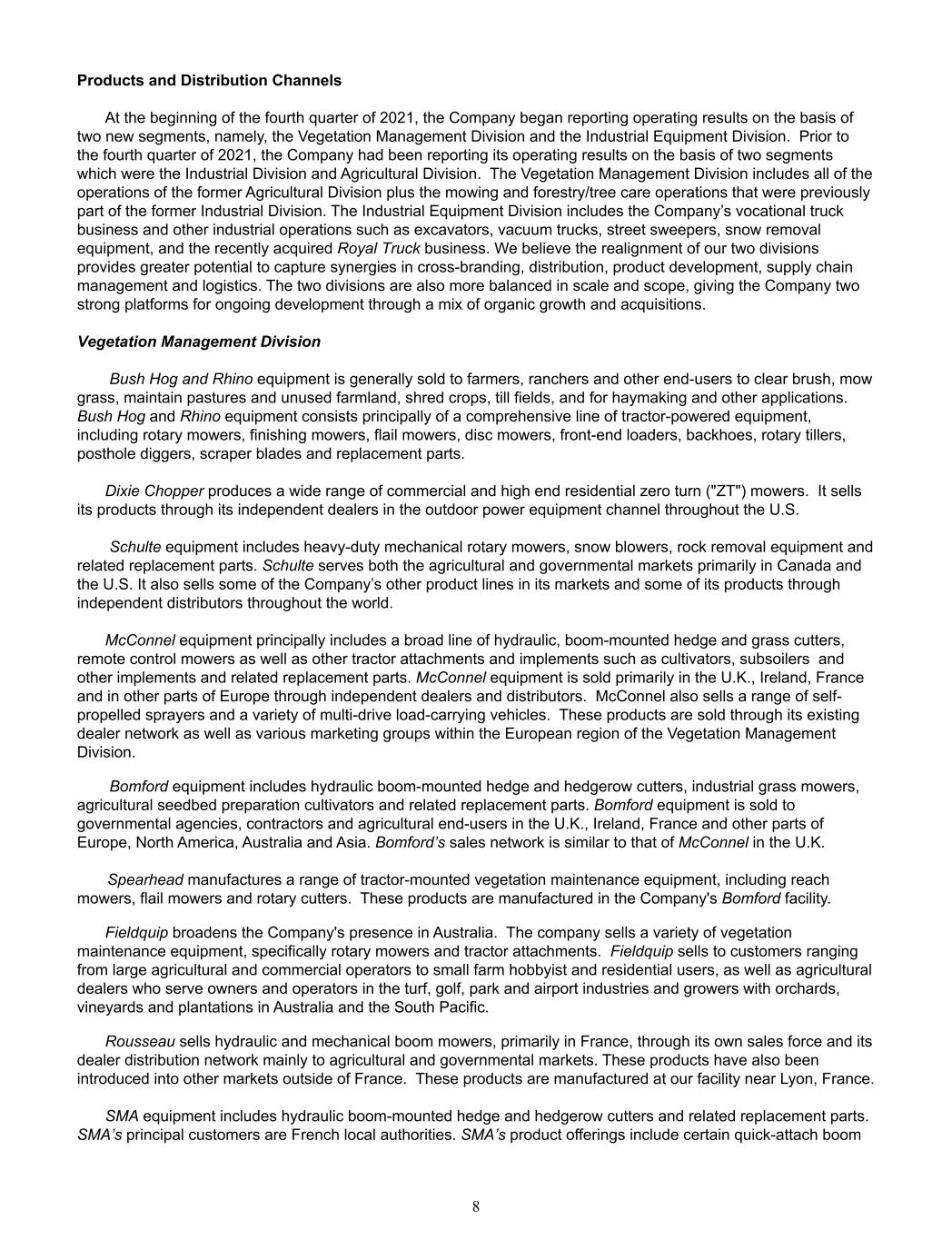
Products and Distribution Channels At the beginning of the fourth quarter of 2021, the Company began reporting operating results on the basis of two new segments, namely, the Vegetation Management Division and the Industrial Equipment Division. Prior to the fourth quarter of 2021, the Company had been reporting its operating results on the basis of two segments which were the Industrial Division and Agricultural Division. The Vegetation Management Division includes all of the operations of the former Agricultural Division plus the mowing and forestry/tree care operations that were previously part of the former Industrial Division. The Industrial Equipment Division includes the Company’s vocational truck business and other industrial operations such as excavators, vacuum trucks, street sweepers, snow removal equipment, and the recently acquired Royal Truck business. We believe the realignment of our two divisions provides greater potential to capture synergies in cross-branding, distribution, product development, supply chain management and logistics. The two divisions are also more balanced in scale and scope, giving the Company two strong platforms for ongoing development through a mix of organic growth and acquisitions. Vegetation Management Division Bush Hog and Rhino equipment is generally sold to farmers, ranchers and other end-users to clear brush, mow grass, maintain pastures and unused farmland, shred crops, till fields, and for haymaking and other applications. Bush Hog and Rhino equipment consists principally of a comprehensive line of tractor-powered equipment, including rotary mowers, finishing mowers, flail mowers, disc mowers, front-end loaders, backhoes, rotary tillers, posthole diggers, scraper blades and replacement parts. Dixie Chopper produces a wide range of commercial and high end residential zero turn ("ZT") mowers. It sells its products through its independent dealers in the outdoor power equipment channel throughout the U.S. Schulte equipment includes heavy-duty mechanical rotary mowers, snow blowers, rock removal equipment and related replacement parts. Schulte serves both the agricultural and governmental markets primarily in Canada and the U.S. It also sells some of the Company’s other product lines in its markets and some of its products through independent distributors throughout the world. McConnel equipment principally includes a broad line of hydraulic, boom-mounted hedge and grass cutters, remote control mowers as well as other tractor attachments and implements such as cultivators, subsoilers and other implements and related replacement parts. McConnel equipment is sold primarily in the U.K., Ireland, France and in other parts of Europe through independent dealers and distributors. McConnel also sells a range of self- propelled sprayers and a variety of multi-drive load-carrying vehicles. These products are sold through its existing dealer network as well as various marketing groups within the European region of the Vegetation Management Division. Bomford equipment includes hydraulic boom-mounted hedge and hedgerow cutters, industrial grass mowers, agricultural seedbed preparation cultivators and related replacement parts. Bomford equipment is sold to governmental agencies, contractors and agricultural end-users in the U.K., Ireland, France and other parts of Europe, North America, Australia and Asia. Bomford’s sales network is similar to that of McConnel in the U.K. Spearhead manufactures a range of tractor-mounted vegetation maintenance equipment, including reach mowers, flail mowers and rotary cutters. These products are manufactured in the Company's Bomford facility. Fieldquip broadens the Company's presence in Australia. The company sells a variety of vegetation maintenance equipment, specifically rotary mowers and tractor attachments. Fieldquip sells to customers ranging from large agricultural and commercial operators to small farm hobbyist and residential users, as well as agricultural dealers who serve owners and operators in the turf, golf, park and airport industries and growers with orchards, vineyards and plantations in Australia and the South Pacific. Rousseau sells hydraulic and mechanical boom mowers, primarily in France, through its own sales force and its dealer distribution network mainly to agricultural and governmental markets. These products have also been introduced into other markets outside of France. These products are manufactured at our facility near Lyon, France. SMA equipment includes hydraulic boom-mounted hedge and hedgerow cutters and related replacement parts. SMA’s principal customers are French local authorities. SMA’s product offerings include certain quick-attach boom 8
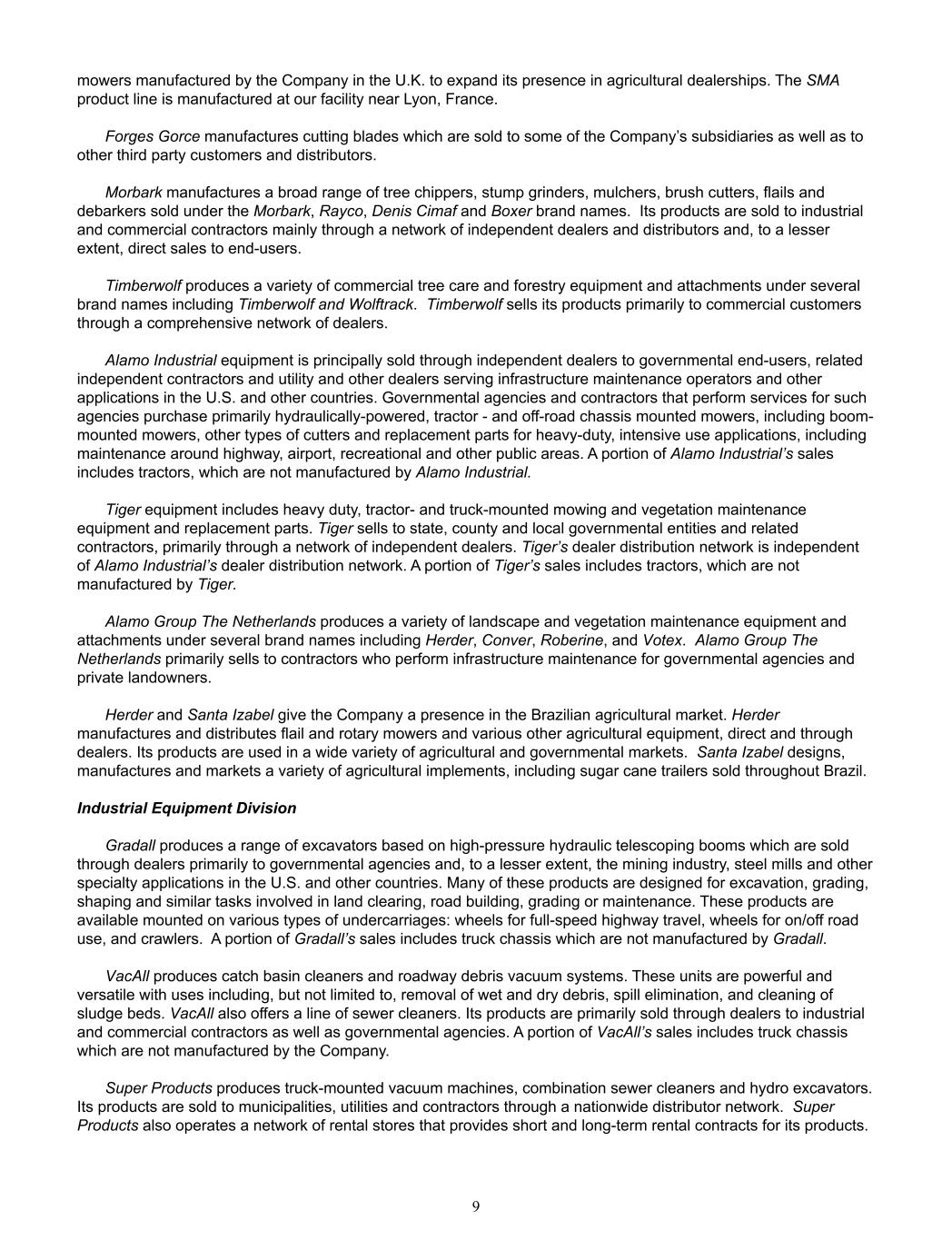
mowers manufactured by the Company in the U.K. to expand its presence in agricultural dealerships. The SMA product line is manufactured at our facility near Lyon, France. Forges Gorce manufactures cutting blades which are sold to some of the Company’s subsidiaries as well as to other third party customers and distributors. Morbark manufactures a broad range of tree chippers, stump grinders, mulchers, brush cutters, flails and debarkers sold under the Morbark, Rayco, Denis Cimaf and Boxer brand names. Its products are sold to industrial and commercial contractors mainly through a network of independent dealers and distributors and, to a lesser extent, direct sales to end-users. Timberwolf produces a variety of commercial tree care and forestry equipment and attachments under several brand names including Timberwolf and Wolftrack. Timberwolf sells its products primarily to commercial customers through a comprehensive network of dealers. Alamo Industrial equipment is principally sold through independent dealers to governmental end-users, related independent contractors and utility and other dealers serving infrastructure maintenance operators and other applications in the U.S. and other countries. Governmental agencies and contractors that perform services for such agencies purchase primarily hydraulically-powered, tractor - and off-road chassis mounted mowers, including boom- mounted mowers, other types of cutters and replacement parts for heavy-duty, intensive use applications, including maintenance around highway, airport, recreational and other public areas. A portion of Alamo Industrial’s sales includes tractors, which are not manufactured by Alamo Industrial. Tiger equipment includes heavy duty, tractor- and truck-mounted mowing and vegetation maintenance equipment and replacement parts. Tiger sells to state, county and local governmental entities and related contractors, primarily through a network of independent dealers. Tiger’s dealer distribution network is independent of Alamo Industrial’s dealer distribution network. A portion of Tiger’s sales includes tractors, which are not manufactured by Tiger. Alamo Group The Netherlands produces a variety of landscape and vegetation maintenance equipment and attachments under several brand names including Herder, Conver, Roberine, and Votex. Alamo Group The Netherlands primarily sells to contractors who perform infrastructure maintenance for governmental agencies and private landowners. Herder and Santa Izabel give the Company a presence in the Brazilian agricultural market. Herder manufactures and distributes flail and rotary mowers and various other agricultural equipment, direct and through dealers. Its products are used in a wide variety of agricultural and governmental markets. Santa Izabel designs, manufactures and markets a variety of agricultural implements, including sugar cane trailers sold throughout Brazil. Industrial Equipment Division Gradall produces a range of excavators based on high-pressure hydraulic telescoping booms which are sold through dealers primarily to governmental agencies and, to a lesser extent, the mining industry, steel mills and other specialty applications in the U.S. and other countries. Many of these products are designed for excavation, grading, shaping and similar tasks involved in land clearing, road building, grading or maintenance. These products are available mounted on various types of undercarriages: wheels for full-speed highway travel, wheels for on/off road use, and crawlers. A portion of Gradall’s sales includes truck chassis which are not manufactured by Gradall. VacAll produces catch basin cleaners and roadway debris vacuum systems. These units are powerful and versatile with uses including, but not limited to, removal of wet and dry debris, spill elimination, and cleaning of sludge beds. VacAll also offers a line of sewer cleaners. Its products are primarily sold through dealers to industrial and commercial contractors as well as governmental agencies. A portion of VacAll’s sales includes truck chassis which are not manufactured by the Company. Super Products produces truck-mounted vacuum machines, combination sewer cleaners and hydro excavators. Its products are sold to municipalities, utilities and contractors through a nationwide distributor network. Super Products also operates a network of rental stores that provides short and long-term rental contracts for its products. 9
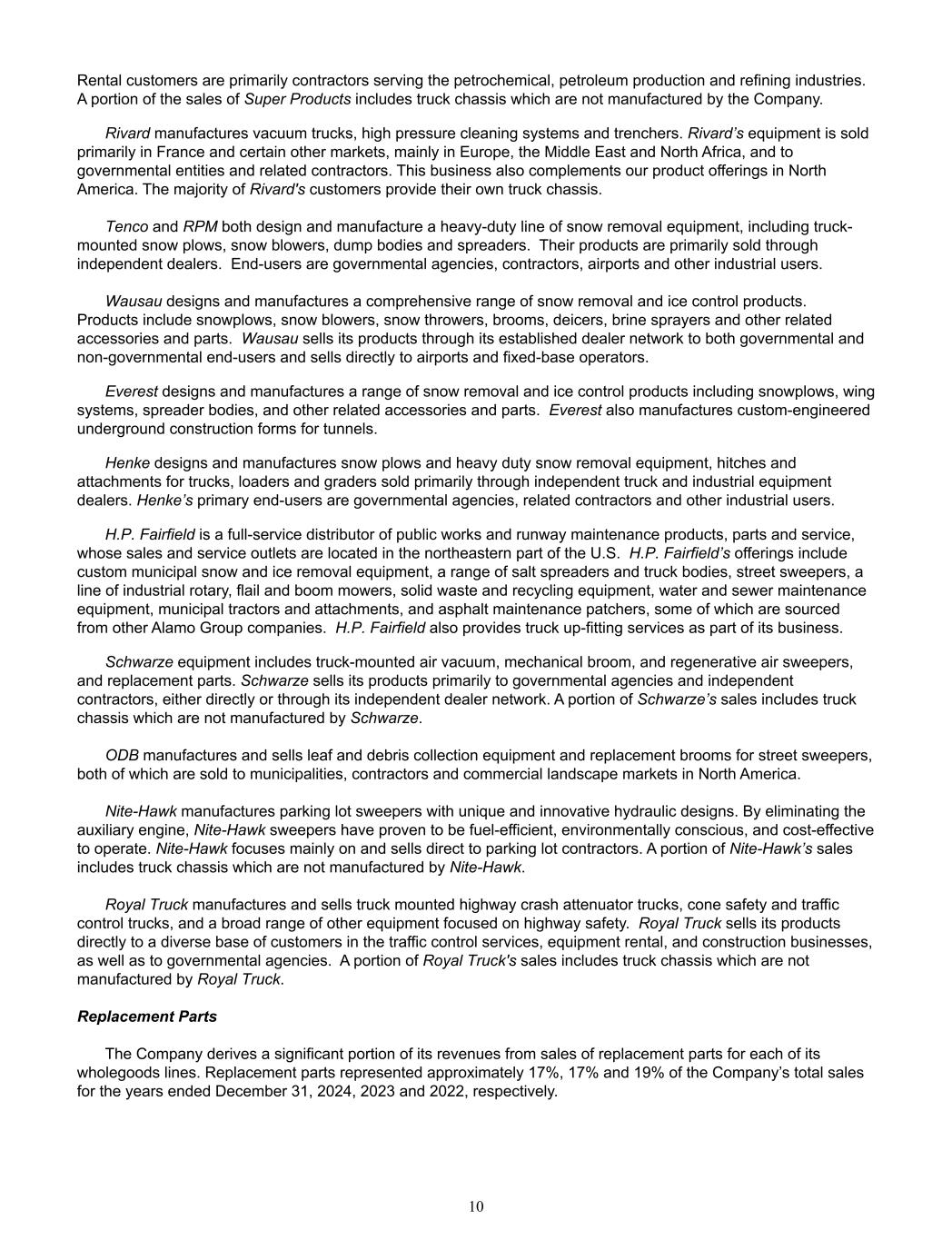
Rental customers are primarily contractors serving the petrochemical, petroleum production and refining industries. A portion of the sales of Super Products includes truck chassis which are not manufactured by the Company. Rivard manufactures vacuum trucks, high pressure cleaning systems and trenchers. Rivard’s equipment is sold primarily in France and certain other markets, mainly in Europe, the Middle East and North Africa, and to governmental entities and related contractors. This business also complements our product offerings in North America. The majority of Rivard's customers provide their own truck chassis. Tenco and RPM both design and manufacture a heavy-duty line of snow removal equipment, including truck- mounted snow plows, snow blowers, dump bodies and spreaders. Their products are primarily sold through independent dealers. End-users are governmental agencies, contractors, airports and other industrial users. Wausau designs and manufactures a comprehensive range of snow removal and ice control products. Products include snowplows, snow blowers, snow throwers, brooms, deicers, brine sprayers and other related accessories and parts. Wausau sells its products through its established dealer network to both governmental and non-governmental end-users and sells directly to airports and fixed-base operators. Everest designs and manufactures a range of snow removal and ice control products including snowplows, wing systems, spreader bodies, and other related accessories and parts. Everest also manufactures custom-engineered underground construction forms for tunnels. Henke designs and manufactures snow plows and heavy duty snow removal equipment, hitches and attachments for trucks, loaders and graders sold primarily through independent truck and industrial equipment dealers. Henke’s primary end-users are governmental agencies, related contractors and other industrial users. H.P. Fairfield is a full-service distributor of public works and runway maintenance products, parts and service, whose sales and service outlets are located in the northeastern part of the U.S. H.P. Fairfield’s offerings include custom municipal snow and ice removal equipment, a range of salt spreaders and truck bodies, street sweepers, a line of industrial rotary, flail and boom mowers, solid waste and recycling equipment, water and sewer maintenance equipment, municipal tractors and attachments, and asphalt maintenance patchers, some of which are sourced from other Alamo Group companies. H.P. Fairfield also provides truck up-fitting services as part of its business. Schwarze equipment includes truck-mounted air vacuum, mechanical broom, and regenerative air sweepers, and replacement parts. Schwarze sells its products primarily to governmental agencies and independent contractors, either directly or through its independent dealer network. A portion of Schwarze’s sales includes truck chassis which are not manufactured by Schwarze. ODB manufactures and sells leaf and debris collection equipment and replacement brooms for street sweepers, both of which are sold to municipalities, contractors and commercial landscape markets in North America. Nite-Hawk manufactures parking lot sweepers with unique and innovative hydraulic designs. By eliminating the auxiliary engine, Nite-Hawk sweepers have proven to be fuel-efficient, environmentally conscious, and cost-effective to operate. Nite-Hawk focuses mainly on and sells direct to parking lot contractors. A portion of Nite-Hawk’s sales includes truck chassis which are not manufactured by Nite-Hawk. Royal Truck manufactures and sells truck mounted highway crash attenuator trucks, cone safety and traffic control trucks, and a broad range of other equipment focused on highway safety. Royal Truck sells its products directly to a diverse base of customers in the traffic control services, equipment rental, and construction businesses, as well as to governmental agencies. A portion of Royal Truck's sales includes truck chassis which are not manufactured by Royal Truck. Replacement Parts The Company derives a significant portion of its revenues from sales of replacement parts for each of its wholegoods lines. Replacement parts represented approximately 17%, 17% and 19% of the Company’s total sales for the years ended December 31, 2024, 2023 and 2022, respectively. 10
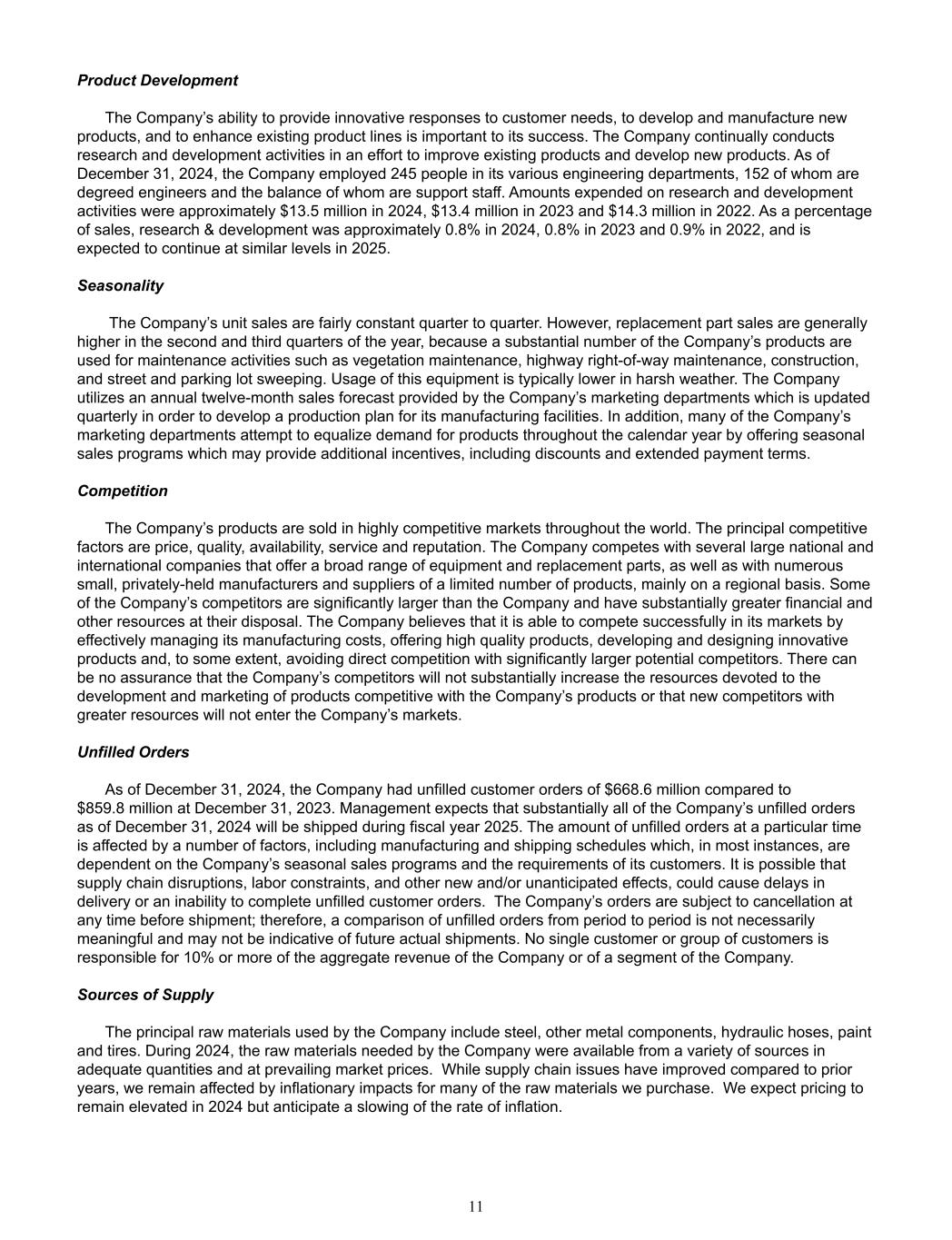
Product Development The Company’s ability to provide innovative responses to customer needs, to develop and manufacture new products, and to enhance existing product lines is important to its success. The Company continually conducts research and development activities in an effort to improve existing products and develop new products. As of December 31, 2024, the Company employed 245 people in its various engineering departments, 152 of whom are degreed engineers and the balance of whom are support staff. Amounts expended on research and development activities were approximately $13.5 million in 2024, $13.4 million in 2023 and $14.3 million in 2022. As a percentage of sales, research & development was approximately 0.8% in 2024, 0.8% in 2023 and 0.9% in 2022, and is expected to continue at similar levels in 2025. Seasonality The Company’s unit sales are fairly constant quarter to quarter. However, replacement part sales are generally higher in the second and third quarters of the year, because a substantial number of the Company’s products are used for maintenance activities such as vegetation maintenance, highway right-of-way maintenance, construction, and street and parking lot sweeping. Usage of this equipment is typically lower in harsh weather. The Company utilizes an annual twelve-month sales forecast provided by the Company’s marketing departments which is updated quarterly in order to develop a production plan for its manufacturing facilities. In addition, many of the Company’s marketing departments attempt to equalize demand for products throughout the calendar year by offering seasonal sales programs which may provide additional incentives, including discounts and extended payment terms. Competition The Company’s products are sold in highly competitive markets throughout the world. The principal competitive factors are price, quality, availability, service and reputation. The Company competes with several large national and international companies that offer a broad range of equipment and replacement parts, as well as with numerous small, privately-held manufacturers and suppliers of a limited number of products, mainly on a regional basis. Some of the Company’s competitors are significantly larger than the Company and have substantially greater financial and other resources at their disposal. The Company believes that it is able to compete successfully in its markets by effectively managing its manufacturing costs, offering high quality products, developing and designing innovative products and, to some extent, avoiding direct competition with significantly larger potential competitors. There can be no assurance that the Company’s competitors will not substantially increase the resources devoted to the development and marketing of products competitive with the Company’s products or that new competitors with greater resources will not enter the Company’s markets. Unfilled Orders As of December 31, 2024, the Company had unfilled customer orders of $668.6 million compared to $859.8 million at December 31, 2023. Management expects that substantially all of the Company’s unfilled orders as of December 31, 2024 will be shipped during fiscal year 2025. The amount of unfilled orders at a particular time is affected by a number of factors, including manufacturing and shipping schedules which, in most instances, are dependent on the Company’s seasonal sales programs and the requirements of its customers. It is possible that supply chain disruptions, labor constraints, and other new and/or unanticipated effects, could cause delays in delivery or an inability to complete unfilled customer orders. The Company’s orders are subject to cancellation at any time before shipment; therefore, a comparison of unfilled orders from period to period is not necessarily meaningful and may not be indicative of future actual shipments. No single customer or group of customers is responsible for 10% or more of the aggregate revenue of the Company or of a segment of the Company. Sources of Supply The principal raw materials used by the Company include steel, other metal components, hydraulic hoses, paint and tires. During 2024, the raw materials needed by the Company were available from a variety of sources in adequate quantities and at prevailing market prices. While supply chain issues have improved compared to prior years, we remain affected by inflationary impacts for many of the raw materials we purchase. We expect pricing to remain elevated in 2024 but anticipate a slowing of the rate of inflation. 11

While the Company manufactures many of the parts for its products, a significant percentage of parts, including most drivelines, gearboxes, industrial engines, and hydraulic components, are purchased from outside suppliers which manufacture to the Company’s specifications. In addition, the Company, through its subsidiaries, purchases tractors and truck chassis as a number of the Company’s products are mounted and shipped with a tractor or truck chassis. Tractors and truck chassis are generally available, but during 2023 we experienced delays in receiving truck chassis which caused us to delay shipments of some of our products and created operational inefficiencies in some of our facilities, particularly within our Industrial Equipment Division. The Company sources its purchased goods from international and domestic suppliers. No one supplier is responsible for supplying more than 10% of the principal raw materials or purchased goods used by the Company. Patents, Trademarks and Trade Names The Company owns various U.S. and international patents, trademarks and trade names. While the Company considers its patents, trademarks and trade names to be advantageous to its business, it is not dependent on any single patent, trademark, trade name or group of patents, trademarks, or trade names. The net book value of patents, trademarks and trade names was $70.8 million and $77.1 million as of December 31, 2024 and 2023, respectively. Environmental and Other Governmental Regulations Like other manufacturers, the Company is subject to a broad range of federal, state, local and foreign laws, rules and regulations including those relating to climate change; emissions to air, including Tier 4 or similar engine emission regulations; discharges to water; restrictions placed on water usage and water availability; product and associated packaging; use of certain chemicals; restricted substances, including "conflict minerals" disclosure rules; import and export compliance, including country of origin certification requirements; worker and product user health and safety; energy efficiency; product life-cycles; outdoor noise laws; and the generation, use, handling, labeling, collection, management, storage, transportation, treatment, and disposal of hazardous substances, wastes, and other regulated materials. The U.S. Environmental Protection Agency ("EPA"), the California Air Resources Board ("CARB"), and similar regulators in other U.S. states and foreign jurisdictions in which we sell our products have emission requirements setting maximum emission standards for certain equipment. In addition to the EPA's implementation of Tier 4 emission requirements applicable to diesel engines, China, the European Union ("EU") and the United Kingdom also have adopted similar regulations, and similar emission regulations are also being considered in other markets in which we sell our products. CARB continues to propose new regulations, including Tier 5 off-road diesel engine emissions standards that are in development. In addition, CARB has started to implement on-road zero emissions equipment regulations that will likely create increasingly stringent requirements on exhaust and other emissions from some of the products we manufacture. These new on-road zero emissions regulations have started to limit the availability of some on-road vehicle chassis that use diesel engines in California and possibly in other states that plan to adopt these CARB regulations. The U.S. federal government, several U.S. states, and certain international markets where we sell our products, including the EU and some EU member countries have introduced product life-cycle laws, rules, or regulations, which are intended to reduce waste and environmental and human health impact, and require manufacturers to label, collect, dispose, and recycle certain products, including some of our products, at the end of their useful life. These include, among other laws and regulations: (i) the Registration, Evaluation, Authorization and Restriction of Chemicals ("REACH") directive, U.S. Toxic Substances Control Act ("TSCA"), or similar substance level laws, rules, or regulations that require notification of use of certain chemicals, or ban or restrict the use of certain chemicals; (ii) California Proposition 65 and other product substance restriction laws, some of which require certain labeling of products; (iii) energy efficiency laws, rules, or regulations, which are intended to reduce the use and inefficiencies associated with energy and natural resource consumption and require specified efficiency ratings and capabilities for certain products; (iv) conflict minerals laws, such as those contained in the Dodd-Frank Wall Street Reform and Consumer Protection Act and the rules promulgated by the U.S. Securities and Exchange Commission ("SEC"), which require specific procedures for the determination and disclosure of the use of certain minerals, known as "conflict minerals," which are mined from the Democratic Republic of the Congo and adjoining countries; and (v) supply chain transparency laws and regulations addressing modern slavery and human trafficking. 12
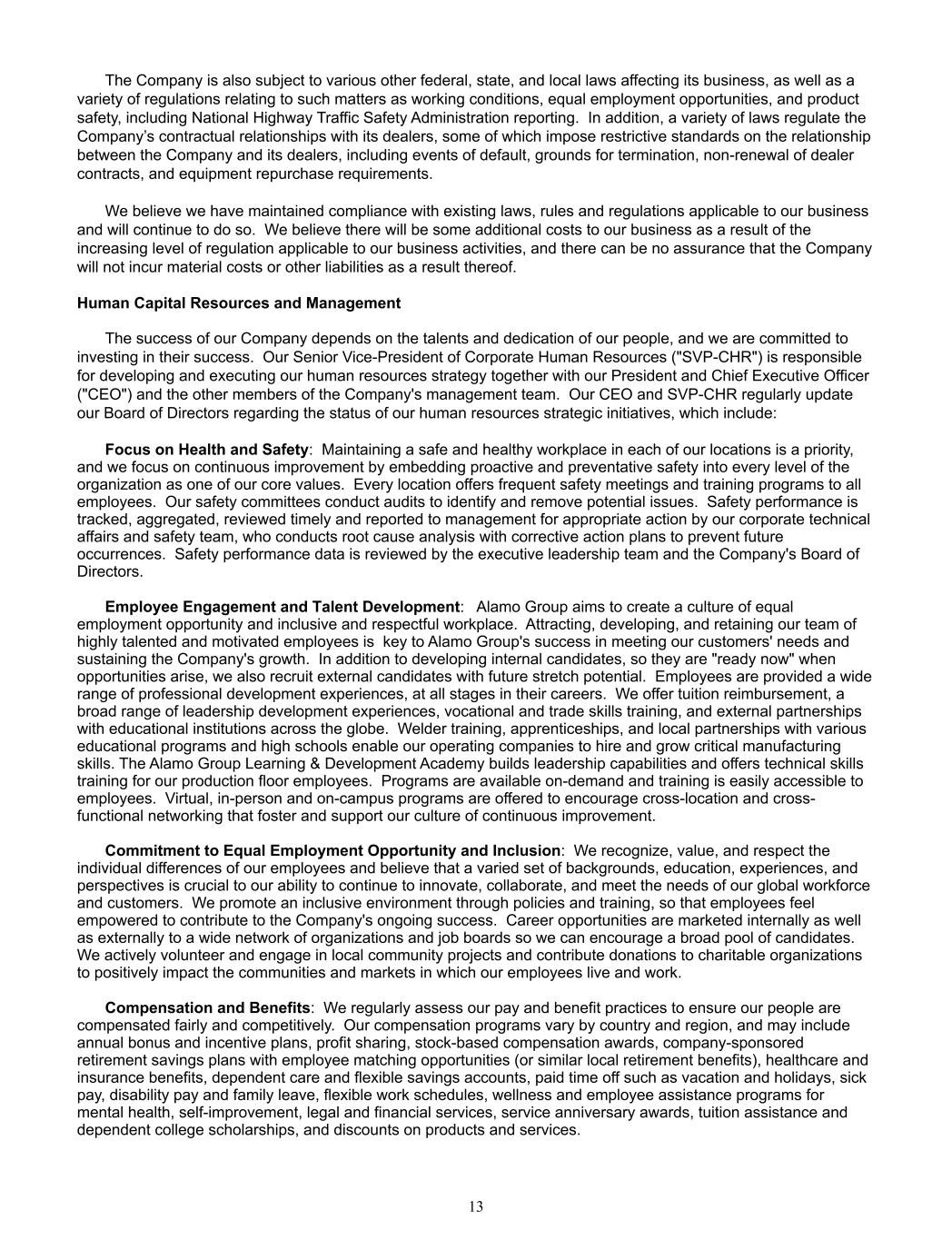
The Company is also subject to various other federal, state, and local laws affecting its business, as well as a variety of regulations relating to such matters as working conditions, equal employment opportunities, and product safety, including National Highway Traffic Safety Administration reporting. In addition, a variety of laws regulate the Company’s contractual relationships with its dealers, some of which impose restrictive standards on the relationship between the Company and its dealers, including events of default, grounds for termination, non-renewal of dealer contracts, and equipment repurchase requirements. We believe we have maintained compliance with existing laws, rules and regulations applicable to our business and will continue to do so. We believe there will be some additional costs to our business as a result of the increasing level of regulation applicable to our business activities, and there can be no assurance that the Company will not incur material costs or other liabilities as a result thereof. Human Capital Resources and Management The success of our Company depends on the talents and dedication of our people, and we are committed to investing in their success. Our Senior Vice-President of Corporate Human Resources ("SVP-CHR") is responsible for developing and executing our human resources strategy together with our President and Chief Executive Officer ("CEO") and the other members of the Company's management team. Our CEO and SVP-CHR regularly update our Board of Directors regarding the status of our human resources strategic initiatives, which include: Focus on Health and Safety: Maintaining a safe and healthy workplace in each of our locations is a priority, and we focus on continuous improvement by embedding proactive and preventative safety into every level of the organization as one of our core values. Every location offers frequent safety meetings and training programs to all employees. Our safety committees conduct audits to identify and remove potential issues. Safety performance is tracked, aggregated, reviewed timely and reported to management for appropriate action by our corporate technical affairs and safety team, who conducts root cause analysis with corrective action plans to prevent future occurrences. Safety performance data is reviewed by the executive leadership team and the Company's Board of Directors. Employee Engagement and Talent Development: Alamo Group aims to create a culture of equal employment opportunity and inclusive and respectful workplace. Attracting, developing, and retaining our team of highly talented and motivated employees is key to Alamo Group's success in meeting our customers' needs and sustaining the Company's growth. In addition to developing internal candidates, so they are "ready now" when opportunities arise, we also recruit external candidates with future stretch potential. Employees are provided a wide range of professional development experiences, at all stages in their careers. We offer tuition reimbursement, a broad range of leadership development experiences, vocational and trade skills training, and external partnerships with educational institutions across the globe. Welder training, apprenticeships, and local partnerships with various educational programs and high schools enable our operating companies to hire and grow critical manufacturing skills. The Alamo Group Learning & Development Academy builds leadership capabilities and offers technical skills training for our production floor employees. Programs are available on-demand and training is easily accessible to employees. Virtual, in-person and on-campus programs are offered to encourage cross-location and cross- functional networking that foster and support our culture of continuous improvement. Commitment to Equal Employment Opportunity and Inclusion: We recognize, value, and respect the individual differences of our employees and believe that a varied set of backgrounds, education, experiences, and perspectives is crucial to our ability to continue to innovate, collaborate, and meet the needs of our global workforce and customers. We promote an inclusive environment through policies and training, so that employees feel empowered to contribute to the Company's ongoing success. Career opportunities are marketed internally as well as externally to a wide network of organizations and job boards so we can encourage a broad pool of candidates. We actively volunteer and engage in local community projects and contribute donations to charitable organizations to positively impact the communities and markets in which our employees live and work. Compensation and Benefits: We regularly assess our pay and benefit practices to ensure our people are compensated fairly and competitively. Our compensation programs vary by country and region, and may include annual bonus and incentive plans, profit sharing, stock-based compensation awards, company-sponsored retirement savings plans with employee matching opportunities (or similar local retirement benefits), healthcare and insurance benefits, dependent care and flexible savings accounts, paid time off such as vacation and holidays, sick pay, disability pay and family leave, flexible work schedules, wellness and employee assistance programs for mental health, self-improvement, legal and financial services, service anniversary awards, tuition assistance and dependent college scholarships, and discounts on products and services. 13
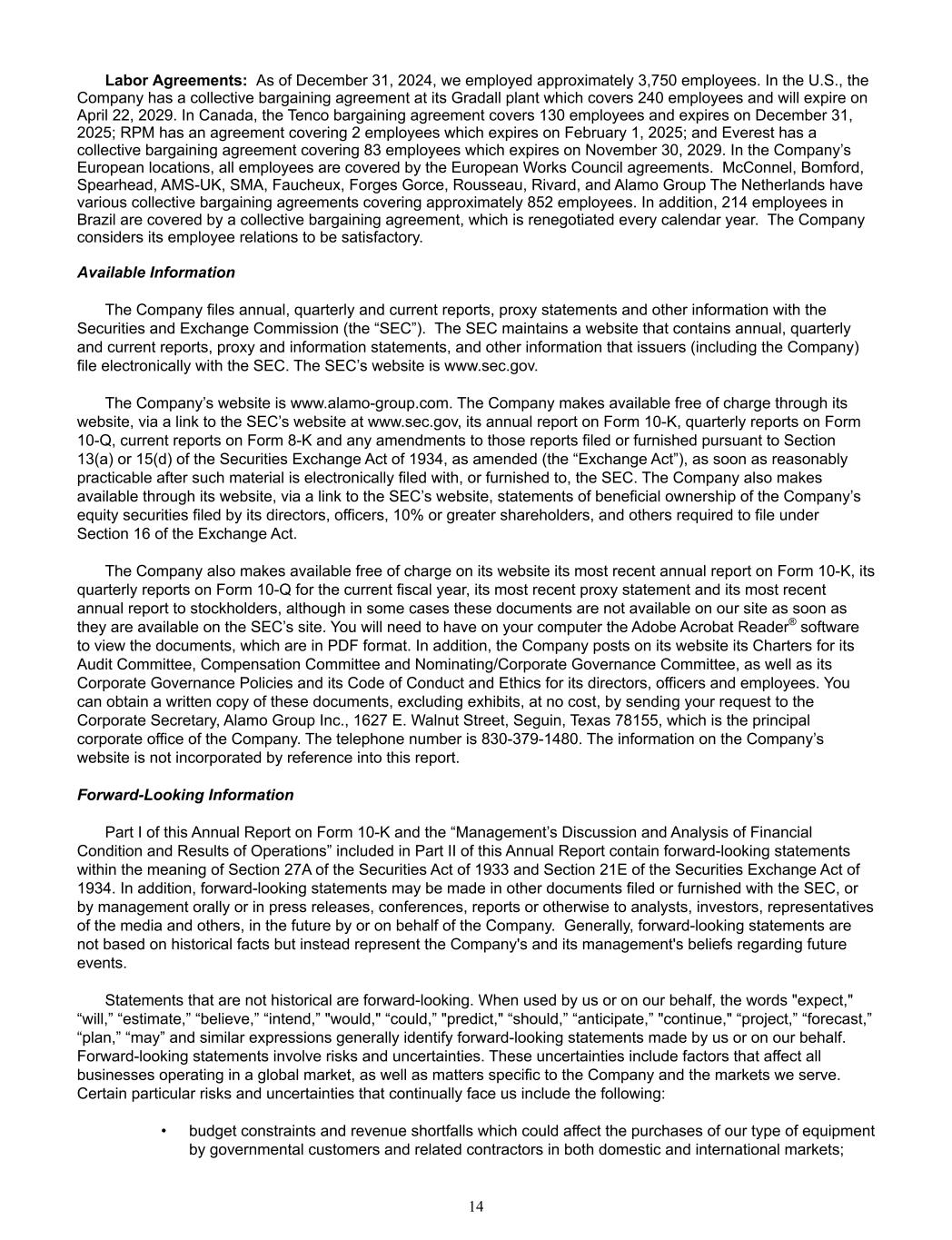
Labor Agreements: As of December 31, 2024, we employed approximately 3,750 employees. In the U.S., the Company has a collective bargaining agreement at its Gradall plant which covers 240 employees and will expire on April 22, 2029. In Canada, the Tenco bargaining agreement covers 130 employees and expires on December 31, 2025; RPM has an agreement covering 2 employees which expires on February 1, 2025; and Everest has a collective bargaining agreement covering 83 employees which expires on November 30, 2029. In the Company’s European locations, all employees are covered by the European Works Council agreements. McConnel, Bomford, Spearhead, AMS-UK, SMA, Faucheux, Forges Gorce, Rousseau, Rivard, and Alamo Group The Netherlands have various collective bargaining agreements covering approximately 852 employees. In addition, 214 employees in Brazil are covered by a collective bargaining agreement, which is renegotiated every calendar year. The Company considers its employee relations to be satisfactory. Available Information The Company files annual, quarterly and current reports, proxy statements and other information with the Securities and Exchange Commission (the “SEC”). The SEC maintains a website that contains annual, quarterly and current reports, proxy and information statements, and other information that issuers (including the Company) file electronically with the SEC. The SEC’s website is www.sec.gov. The Company’s website is www.alamo-group.com. The Company makes available free of charge through its website, via a link to the SEC’s website at www.sec.gov, its annual report on Form 10-K, quarterly reports on Form 10-Q, current reports on Form 8-K and any amendments to those reports filed or furnished pursuant to Section 13(a) or 15(d) of the Securities Exchange Act of 1934, as amended (the “Exchange Act”), as soon as reasonably practicable after such material is electronically filed with, or furnished to, the SEC. The Company also makes available through its website, via a link to the SEC’s website, statements of beneficial ownership of the Company’s equity securities filed by its directors, officers, 10% or greater shareholders, and others required to file under Section 16 of the Exchange Act. The Company also makes available free of charge on its website its most recent annual report on Form 10-K, its quarterly reports on Form 10-Q for the current fiscal year, its most recent proxy statement and its most recent annual report to stockholders, although in some cases these documents are not available on our site as soon as they are available on the SEC’s site. You will need to have on your computer the Adobe Acrobat Reader® software to view the documents, which are in PDF format. In addition, the Company posts on its website its Charters for its Audit Committee, Compensation Committee and Nominating/Corporate Governance Committee, as well as its Corporate Governance Policies and its Code of Conduct and Ethics for its directors, officers and employees. You can obtain a written copy of these documents, excluding exhibits, at no cost, by sending your request to the Corporate Secretary, Alamo Group Inc., 1627 E. Walnut Street, Seguin, Texas 78155, which is the principal corporate office of the Company. The telephone number is 830-379-1480. The information on the Company’s website is not incorporated by reference into this report. Forward-Looking Information Part I of this Annual Report on Form 10-K and the “Management’s Discussion and Analysis of Financial Condition and Results of Operations” included in Part II of this Annual Report contain forward-looking statements within the meaning of Section 27A of the Securities Act of 1933 and Section 21E of the Securities Exchange Act of 1934. In addition, forward-looking statements may be made in other documents filed or furnished with the SEC, or by management orally or in press releases, conferences, reports or otherwise to analysts, investors, representatives of the media and others, in the future by or on behalf of the Company. Generally, forward-looking statements are not based on historical facts but instead represent the Company's and its management's beliefs regarding future events. Statements that are not historical are forward-looking. When used by us or on our behalf, the words "expect," “will,” “estimate,” “believe,” “intend,” "would," “could,” "predict," “should,” “anticipate,” "continue," “project,” “forecast,” “plan,” “may” and similar expressions generally identify forward-looking statements made by us or on our behalf. Forward-looking statements involve risks and uncertainties. These uncertainties include factors that affect all businesses operating in a global market, as well as matters specific to the Company and the markets we serve. Certain particular risks and uncertainties that continually face us include the following: • budget constraints and revenue shortfalls which could affect the purchases of our type of equipment by governmental customers and related contractors in both domestic and international markets; 14
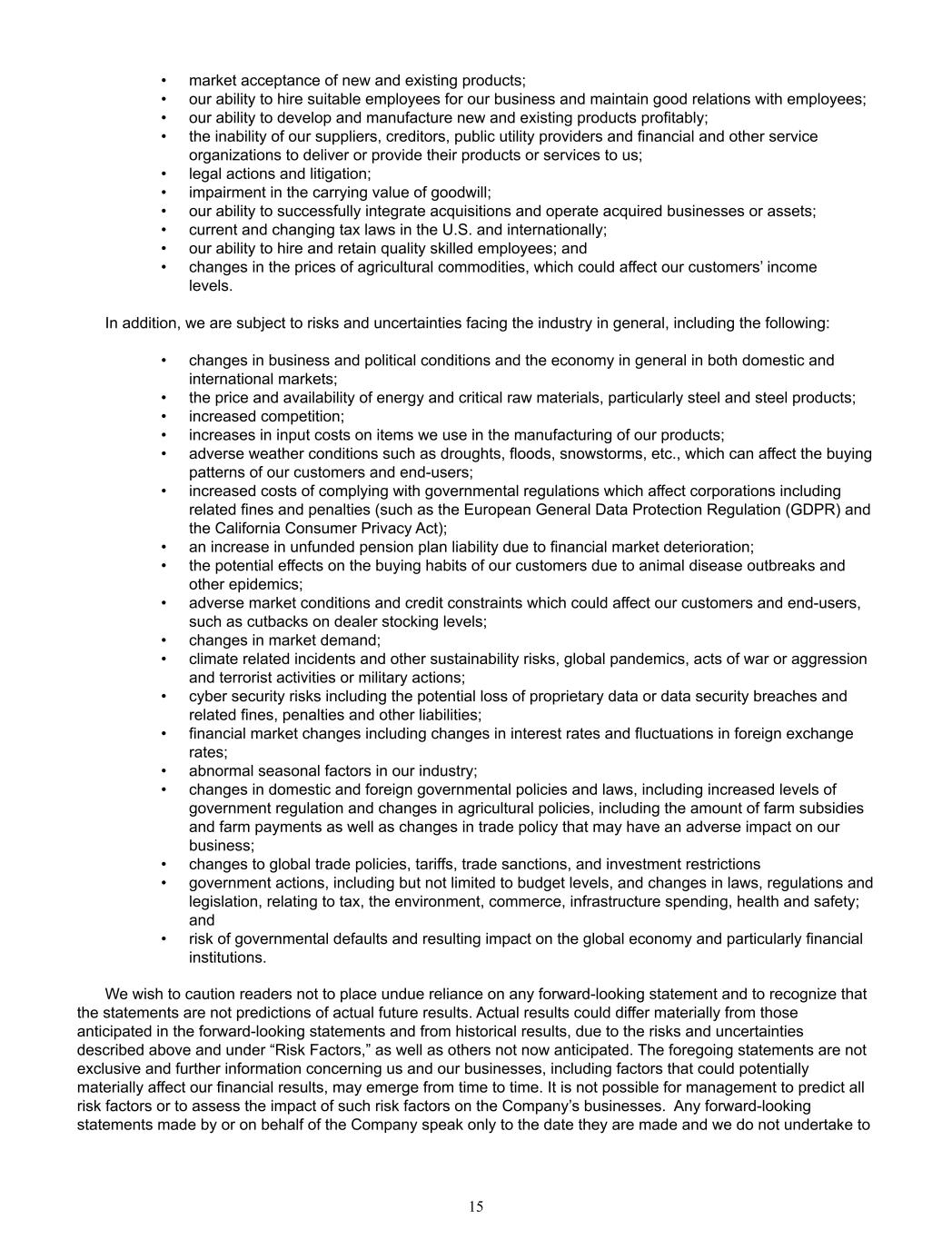
• market acceptance of new and existing products; • our ability to hire suitable employees for our business and maintain good relations with employees; • our ability to develop and manufacture new and existing products profitably; • the inability of our suppliers, creditors, public utility providers and financial and other service organizations to deliver or provide their products or services to us; • legal actions and litigation; • impairment in the carrying value of goodwill; • our ability to successfully integrate acquisitions and operate acquired businesses or assets; • current and changing tax laws in the U.S. and internationally; • our ability to hire and retain quality skilled employees; and • changes in the prices of agricultural commodities, which could affect our customers’ income levels. In addition, we are subject to risks and uncertainties facing the industry in general, including the following: • changes in business and political conditions and the economy in general in both domestic and international markets; • the price and availability of energy and critical raw materials, particularly steel and steel products; • increased competition; • increases in input costs on items we use in the manufacturing of our products; • adverse weather conditions such as droughts, floods, snowstorms, etc., which can affect the buying patterns of our customers and end-users; • increased costs of complying with governmental regulations which affect corporations including related fines and penalties (such as the European General Data Protection Regulation (GDPR) and the California Consumer Privacy Act); • an increase in unfunded pension plan liability due to financial market deterioration; • the potential effects on the buying habits of our customers due to animal disease outbreaks and other epidemics; • adverse market conditions and credit constraints which could affect our customers and end-users, such as cutbacks on dealer stocking levels; • changes in market demand; • climate related incidents and other sustainability risks, global pandemics, acts of war or aggression and terrorist activities or military actions; • cyber security risks including the potential loss of proprietary data or data security breaches and related fines, penalties and other liabilities; • financial market changes including changes in interest rates and fluctuations in foreign exchange rates; • abnormal seasonal factors in our industry; • changes in domestic and foreign governmental policies and laws, including increased levels of government regulation and changes in agricultural policies, including the amount of farm subsidies and farm payments as well as changes in trade policy that may have an adverse impact on our business; • changes to global trade policies, tariffs, trade sanctions, and investment restrictions • government actions, including but not limited to budget levels, and changes in laws, regulations and legislation, relating to tax, the environment, commerce, infrastructure spending, health and safety; and • risk of governmental defaults and resulting impact on the global economy and particularly financial institutions. We wish to caution readers not to place undue reliance on any forward-looking statement and to recognize that the statements are not predictions of actual future results. Actual results could differ materially from those anticipated in the forward-looking statements and from historical results, due to the risks and uncertainties described above and under “Risk Factors,” as well as others not now anticipated. The foregoing statements are not exclusive and further information concerning us and our businesses, including factors that could potentially materially affect our financial results, may emerge from time to time. It is not possible for management to predict all risk factors or to assess the impact of such risk factors on the Company’s businesses. Any forward-looking statements made by or on behalf of the Company speak only to the date they are made and we do not undertake to 15

update forward-looking statements to reflect the impact of circumstances or events that arise after the forward- looking statements were made. Information About our Executive Officers Certain information is set forth below concerning the executive officers of the Company (the "Executives"), each of whom has been appointed to serve until the 2025 annual meeting of directors or until their successor is duly appointed and qualified. Name Age Position Jeffery A. Leonard 65 President and Chief Executive Officer Agnieszka K. Kamps 48 Executive Vice President and Chief Financial Officer Edward T. Rizzuti 55 Executive Vice President, Corporate Development and Investor Relations and Secretary Dan E. Malone 64 Executive Vice President, Chief Sustainability Officer Richard H. Raborn 59 Executive Vice President, Alamo Vegetation Management Division Kevin J. Thomas 60 Executive Vice President, Alamo Industrial Equipment Division Janet S. Pollock 66 Senior Vice President, Corporate Human Resources Lori L. Sullivan 55 Vice President, Internal Audit Jeffery A. Leonard was appointed President and Chief Executive Officer of the Company in May of 2021. Mr. Leonard was also appointed as a director of the Company in June of 2021. Mr. Leonard joined the Company in 2011, and served as Executive Vice President of the Company's former Industrial Division from 2011 to 2021. Mr. Leonard previously was Senior Vice President of Metso Minerals Industries Inc., a supplier of technology and services for mining, construction, power generation, automation, recycling, and pulp and paper industries. On December 20, 2024, Mr. Leonard notified the Board of his intention to retire as President and CEO by mid-year and upon the appointment of his successor. Mr. Leonard's intention to retire as President and CEO is due to personal reasons and is not the result of any disagreement with the Company. Agnieszka K. Kamps was appointed Executive Vice President and Chief Financial Officer of the Company in May of 2024 after being appointed Executive Vice President and Treasurer in March of 2024. Prior to joining the Company, Ms. Kamps served as Vice President and Chief Financial Officer of Americas Styrenics, LLC since January 2021. Prior to her role with Americas Styrenics, Ms. Kamps served in various accounting management capacities with several Siemens companies and with United Technologies. Edward T. Rizzuti was appointed Vice President, General Counsel of Alamo Group Inc. in July of 2015, assumed the Secretary role in May of 2018, and was promoted to Executive Vice President in November of 2021. Mr. Rizzuti was named Chief Legal Officer in April of 2024 and transitioned to the role of Executive Vice President Corporate Development and Investor Relations in January of 2025. Prior to joining the Company, from 2010 to 2015, Mr. Rizzuti served as Vice President, General Counsel and Secretary for Erickson Incorporated, a publicly traded aircraft manufacturing and operating company based in Portland, Oregon. Dan E. Malone was appointed Executive Vice President, Chief Sustainability Officer in July of 2021. Mr. Malone joined the Company in 2007 and served as Executive Vice President, Chief Financial Officer from 2007 to 2021. Prior to joining the Company, Mr. Malone held the position of Executive Vice President, Chief Financial Officer & Corporate Secretary at Igloo Products Corporation, a manufacturer of insulated consumer goods, from 2002 to January 2007. Mr. Malone was Vice President and Chief Financial Officer of The York Group, Inc. from 2000 to 2002, and held various financial positions from 1987 to 2000 with Cooper Industries, Inc. and its various subsidiaries. 16
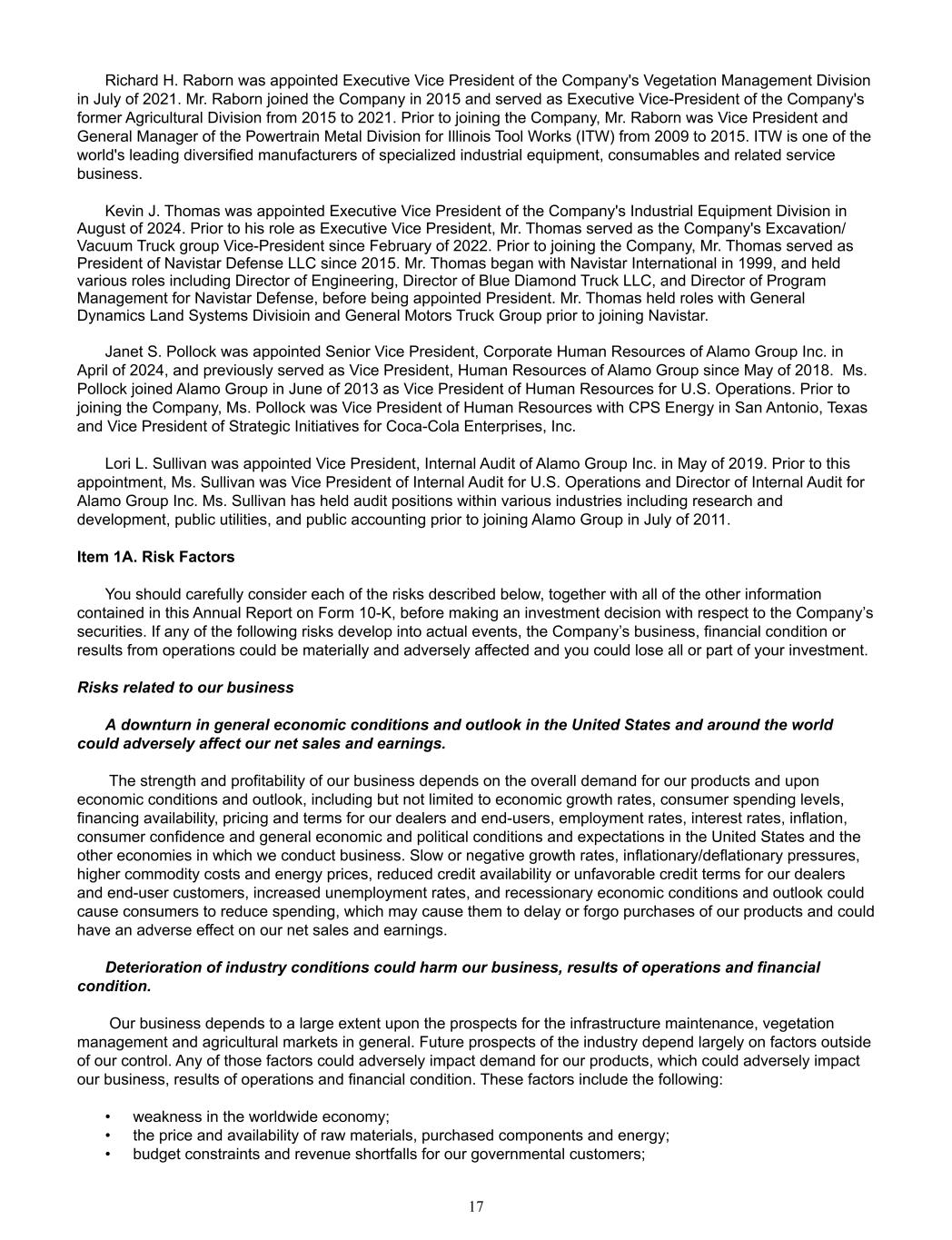
Richard H. Raborn was appointed Executive Vice President of the Company's Vegetation Management Division in July of 2021. Mr. Raborn joined the Company in 2015 and served as Executive Vice-President of the Company's former Agricultural Division from 2015 to 2021. Prior to joining the Company, Mr. Raborn was Vice President and General Manager of the Powertrain Metal Division for Illinois Tool Works (ITW) from 2009 to 2015. ITW is one of the world's leading diversified manufacturers of specialized industrial equipment, consumables and related service business. Kevin J. Thomas was appointed Executive Vice President of the Company's Industrial Equipment Division in August of 2024. Prior to his role as Executive Vice President, Mr. Thomas served as the Company's Excavation/ Vacuum Truck group Vice-President since February of 2022. Prior to joining the Company, Mr. Thomas served as President of Navistar Defense LLC since 2015. Mr. Thomas began with Navistar International in 1999, and held various roles including Director of Engineering, Director of Blue Diamond Truck LLC, and Director of Program Management for Navistar Defense, before being appointed President. Mr. Thomas held roles with General Dynamics Land Systems Divisioin and General Motors Truck Group prior to joining Navistar. Janet S. Pollock was appointed Senior Vice President, Corporate Human Resources of Alamo Group Inc. in April of 2024, and previously served as Vice President, Human Resources of Alamo Group since May of 2018. Ms. Pollock joined Alamo Group in June of 2013 as Vice President of Human Resources for U.S. Operations. Prior to joining the Company, Ms. Pollock was Vice President of Human Resources with CPS Energy in San Antonio, Texas and Vice President of Strategic Initiatives for Coca-Cola Enterprises, Inc. Lori L. Sullivan was appointed Vice President, Internal Audit of Alamo Group Inc. in May of 2019. Prior to this appointment, Ms. Sullivan was Vice President of Internal Audit for U.S. Operations and Director of Internal Audit for Alamo Group Inc. Ms. Sullivan has held audit positions within various industries including research and development, public utilities, and public accounting prior to joining Alamo Group in July of 2011. Item 1A. Risk Factors You should carefully consider each of the risks described below, together with all of the other information contained in this Annual Report on Form 10-K, before making an investment decision with respect to the Company’s securities. If any of the following risks develop into actual events, the Company’s business, financial condition or results from operations could be materially and adversely affected and you could lose all or part of your investment. Risks related to our business A downturn in general economic conditions and outlook in the United States and around the world could adversely affect our net sales and earnings. The strength and profitability of our business depends on the overall demand for our products and upon economic conditions and outlook, including but not limited to economic growth rates, consumer spending levels, financing availability, pricing and terms for our dealers and end-users, employment rates, interest rates, inflation, consumer confidence and general economic and political conditions and expectations in the United States and the other economies in which we conduct business. Slow or negative growth rates, inflationary/deflationary pressures, higher commodity costs and energy prices, reduced credit availability or unfavorable credit terms for our dealers and end-user customers, increased unemployment rates, and recessionary economic conditions and outlook could cause consumers to reduce spending, which may cause them to delay or forgo purchases of our products and could have an adverse effect on our net sales and earnings. Deterioration of industry conditions could harm our business, results of operations and financial condition. Our business depends to a large extent upon the prospects for the infrastructure maintenance, vegetation management and agricultural markets in general. Future prospects of the industry depend largely on factors outside of our control. Any of those factors could adversely impact demand for our products, which could adversely impact our business, results of operations and financial condition. These factors include the following: • weakness in the worldwide economy; • the price and availability of raw materials, purchased components and energy; • budget constraints and revenue shortfalls for our governmental customers; 17

• changes in domestic and foreign governmental policies and laws, including increased levels of governmental regulation and associated liabilities; • the levels of interest rates; • the value of the U.S. dollar relative to the foreign currencies in countries where we sell our products but don’t have a manufacturing presence; • impact of tighter credit markets on the Company, its dealers and end-users; • impairment in the carrying value of goodwill; and • increase in unfunded pension plan liability due to financial market deterioration. In addition, our business is susceptible to a number of factors that specifically affect agricultural customer spending patterns, including the following: • animal disease outbreaks, epidemics and crop pests; • weather conditions, such as droughts, floods and snowstorms; • changes in farm incomes; • cattle and agricultural commodity prices; • changes in governmental agricultural policies worldwide; • the level of worldwide farm output and demand for farm products; and • limits on agricultural imports/exports. Our dependence on, and the price and availability of, raw materials as well as purchased components may adversely affect our business, results of operations and financial condition. We purchase commodities, components, parts, accessories and other goods, such as steel, truck chassis, engines, transmissions, hydraulics, electrification components, and other items necessary for the manufacture of our end-products. The lack of availability or the increased cost of these purchased materials and components due to supply chain disruptions, inflation, increased tariffs, including broad-based reciprocal international tariffs, and/or other uncontrollable events have negatively affected our business operations and profitability and may continue to do so in the future. Historically, we have mitigated commodity, component, parts, and other input cost increases, in part, by increasing prices on our products and executing on our strategic productivity initiatives. However, we may not be able to fully offset increased input costs in the future. If our price increases are not accepted by our customers and the market or we are not able to realize anticipated manufacturing efficiencies, our net sales, profit margins, earnings, and market share could be adversely affected. Further, if we are unable to timely source items such as truck chassis, engines, hydraulics and other critical components our business, results of operations and financial condition may be adversely affected. Skilled labor shortages or our inability to retain qualified employees could adversely affect our operations. Our ability to maintain our productivity at competitive levels may be limited by our ability to employ, compensate, train and retain personnel necessary to meet our requirements. We may experience shortages of qualified personnel such as engineers, project managers, supervisors, and select skilled trades. We cannot be certain that we will be able to maintain an adequate skilled or unskilled labor force or key technical personnel necessary to operate efficiently and to support our growth strategy and operations. Shortages of skilled labor, such as welders and machine operators, are ongoing and could negatively affect our production capabilities, lead to production inefficiencies, or increase our cost of operating. Labor shortages or increased labor costs could impair our ability to operate our business, meet customer commitments or grow our revenues, and could materially and adversely impact our business, results of operations and financial results. We depend on governmental sales, and a decrease in such sales could adversely affect our business, results of operations and financial condition. A substantial portion of our revenues is derived from sales to federal, state, provincial and local governmental entities and related contractors, both in the U.S. and in other countries in which we sell our products. These sales depend primarily on the levels of budgeted and appropriated expenditures for highway, airport, roadside and parks maintenance by various governmental entities and are affected by changes in local and national economic conditions. Federal, state, provincial and local government budgets were negatively affected by the COVID-19 pandemic and its resurgence or a similar pandemic or event could have a material negative impact on our business and financial condition. 18
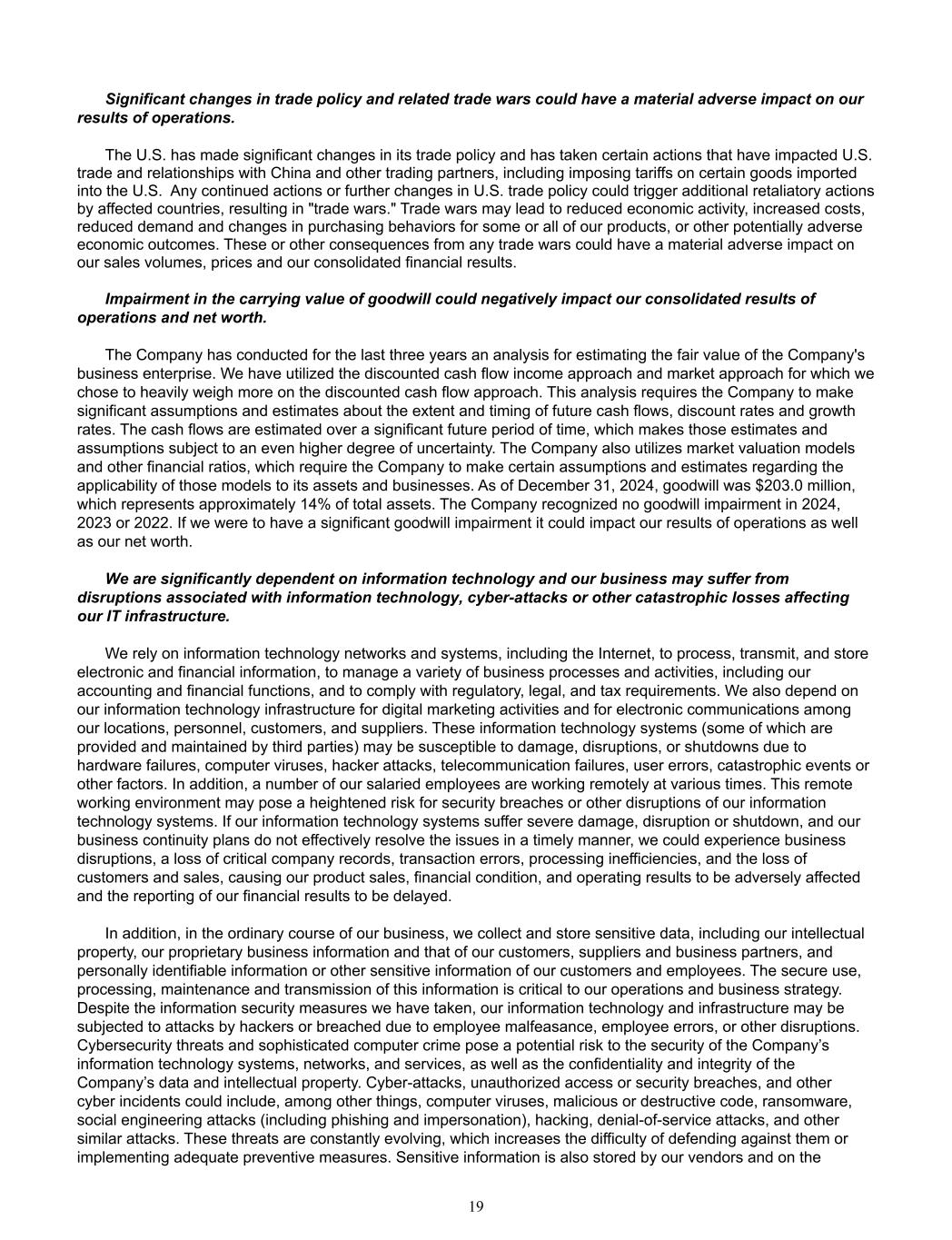
Significant changes in trade policy and related trade wars could have a material adverse impact on our results of operations. The U.S. has made significant changes in its trade policy and has taken certain actions that have impacted U.S. trade and relationships with China and other trading partners, including imposing tariffs on certain goods imported into the U.S. Any continued actions or further changes in U.S. trade policy could trigger additional retaliatory actions by affected countries, resulting in "trade wars." Trade wars may lead to reduced economic activity, increased costs, reduced demand and changes in purchasing behaviors for some or all of our products, or other potentially adverse economic outcomes. These or other consequences from any trade wars could have a material adverse impact on our sales volumes, prices and our consolidated financial results. Impairment in the carrying value of goodwill could negatively impact our consolidated results of operations and net worth. The Company has conducted for the last three years an analysis for estimating the fair value of the Company's business enterprise. We have utilized the discounted cash flow income approach and market approach for which we chose to heavily weigh more on the discounted cash flow approach. This analysis requires the Company to make significant assumptions and estimates about the extent and timing of future cash flows, discount rates and growth rates. The cash flows are estimated over a significant future period of time, which makes those estimates and assumptions subject to an even higher degree of uncertainty. The Company also utilizes market valuation models and other financial ratios, which require the Company to make certain assumptions and estimates regarding the applicability of those models to its assets and businesses. As of December 31, 2024, goodwill was $203.0 million, which represents approximately 14% of total assets. The Company recognized no goodwill impairment in 2024, 2023 or 2022. If we were to have a significant goodwill impairment it could impact our results of operations as well as our net worth. We are significantly dependent on information technology and our business may suffer from disruptions associated with information technology, cyber-attacks or other catastrophic losses affecting our IT infrastructure. We rely on information technology networks and systems, including the Internet, to process, transmit, and store electronic and financial information, to manage a variety of business processes and activities, including our accounting and financial functions, and to comply with regulatory, legal, and tax requirements. We also depend on our information technology infrastructure for digital marketing activities and for electronic communications among our locations, personnel, customers, and suppliers. These information technology systems (some of which are provided and maintained by third parties) may be susceptible to damage, disruptions, or shutdowns due to hardware failures, computer viruses, hacker attacks, telecommunication failures, user errors, catastrophic events or other factors. In addition, a number of our salaried employees are working remotely at various times. This remote working environment may pose a heightened risk for security breaches or other disruptions of our information technology systems. If our information technology systems suffer severe damage, disruption or shutdown, and our business continuity plans do not effectively resolve the issues in a timely manner, we could experience business disruptions, a loss of critical company records, transaction errors, processing inefficiencies, and the loss of customers and sales, causing our product sales, financial condition, and operating results to be adversely affected and the reporting of our financial results to be delayed. In addition, in the ordinary course of our business, we collect and store sensitive data, including our intellectual property, our proprietary business information and that of our customers, suppliers and business partners, and personally identifiable information or other sensitive information of our customers and employees. The secure use, processing, maintenance and transmission of this information is critical to our operations and business strategy. Despite the information security measures we have taken, our information technology and infrastructure may be subjected to attacks by hackers or breached due to employee malfeasance, employee errors, or other disruptions. Cybersecurity threats and sophisticated computer crime pose a potential risk to the security of the Company’s information technology systems, networks, and services, as well as the confidentiality and integrity of the Company’s data and intellectual property. Cyber-attacks, unauthorized access or security breaches, and other cyber incidents could include, among other things, computer viruses, malicious or destructive code, ransomware, social engineering attacks (including phishing and impersonation), hacking, denial-of-service attacks, and other similar attacks. These threats are constantly evolving, which increases the difficulty of defending against them or implementing adequate preventive measures. Sensitive information is also stored by our vendors and on the 19

platforms and networks of third-party providers. Cyber-attacks on the Company, our vendors, or our third-party providers could result in inappropriate access to our intellectual property, Company data, or personally identifiable information of our global workforce, suppliers, or customers. Potential consequences of a successful cyber-attack or other cybersecurity breach or incident include remediation costs, legal costs, increased cybersecurity protection costs, lost revenues resulting from the unauthorized use of proprietary information or the failure to retain or attract customers following an attack, litigation and legal risks including governmental or regulatory enforcement actions, increased insurance premiums, reputational damage that adversely affects customer or investor confidence, and damage to the Company’s competitiveness, stock price, and long-term shareholder value. While we have taken steps to address these risks by implementing enhanced security technologies, internal controls, and business continuity plans, these measures may not be adequate. We cannot assure that the steps we have taken will be sufficient to protect our systems, information or other property. Our systems and information may be vulnerable to theft, loss, damage and interruption from a number of potential threats and events. Changes in the regulatory environment regarding privacy and data protection regulations could have a material adverse impact on our results of operations. Federal, state, provincial and local governments have been moving to adopt privacy rules and regulations that may impact us in the future. In 2018, the EU adopted a comprehensive overhaul of its data protection regime in the form of the General Data Protection Regulation (“GDPR”) which imposes a strict data protection compliance regime with severe penalties of 4% of worldwide turnover or €20.0 million, whichever is greater, and includes new rights such as the right of erasure of personal data. Although the GDPR applies across the EU, as has been the case under the current data protection regime, EU Member States have some national derogations and local data protection authorities (“DPAs”) will still have the ability to interpret the GDPR, which has the potential to create inconsistencies on a country-by-country basis. In addition, certain U.S. states have enacted privacy and data protection laws. For example, the State of California enacted the California Consumer Privacy Act ("CCPA") which became effective in 2020 and was further amended and extended by the California Privacy Rights Act ("CPRA") which became effective in 2023. Implementation of, and compliance with, the GDPR, CCPA, CPRA, and other similar laws could increase our cost of doing business and/or force us to change our business practices in a manner adverse to our business. In addition, violations of the GDPR, CCPA, CPRA, and other laws may result in significant fines, penalties and damage to our brand and business which could, individually or in the aggregate, materially harm our business and reputation. Privacy legislation, enforcement and policy activity in this area continues to rapidly expand. Compliance costs and costs related with implementing privacy-related and data protection measures could be significant. Further, noncompliance could expose us to significant monetary penalties, damage to our reputation, and even possible criminal sanctions. Even our inadvertent failure to comply with privacy-related or data protection laws and regulations could have a material adverse impact on our results of operations. We operate in a highly competitive industry, and some of our competitors and potential competitors have greater resources than we do. Our products are sold in highly competitive markets throughout the world. We compete with several large national and international companies that offer a broad range of equipment and replacement parts that compete with our products, as well as with numerous small, privately-held manufacturers and suppliers of a limited number of products mainly on a regional basis. Some of our competitors are significantly larger than we are and have substantially greater financial and other resources at their disposal. We believe that we are able to compete successfully in our markets by, to some extent, avoiding direct competition with significantly larger potential competitors. There can be no assurance that our competitors will not substantially increase the resources devoted to the development and marketing of products competitive with our products or that new competitors with greater resources will not enter our markets. Any failure to effectively compete could have an adverse effect on our business, results of operations and financial condition. Failure to develop new products or keep pace with technological developments may have a material adverse impact on our results of operations. Our industry is affected by future technological developments. The introduction of new products or processes with innovative technologies could render our existing products or processes obsolete or unmarketable. Our success depends, to some extent, upon our ability to develop, market and sell cost-effective new products and applications that keep pace with technological developments in the markets we serve. We may not be successful in 20
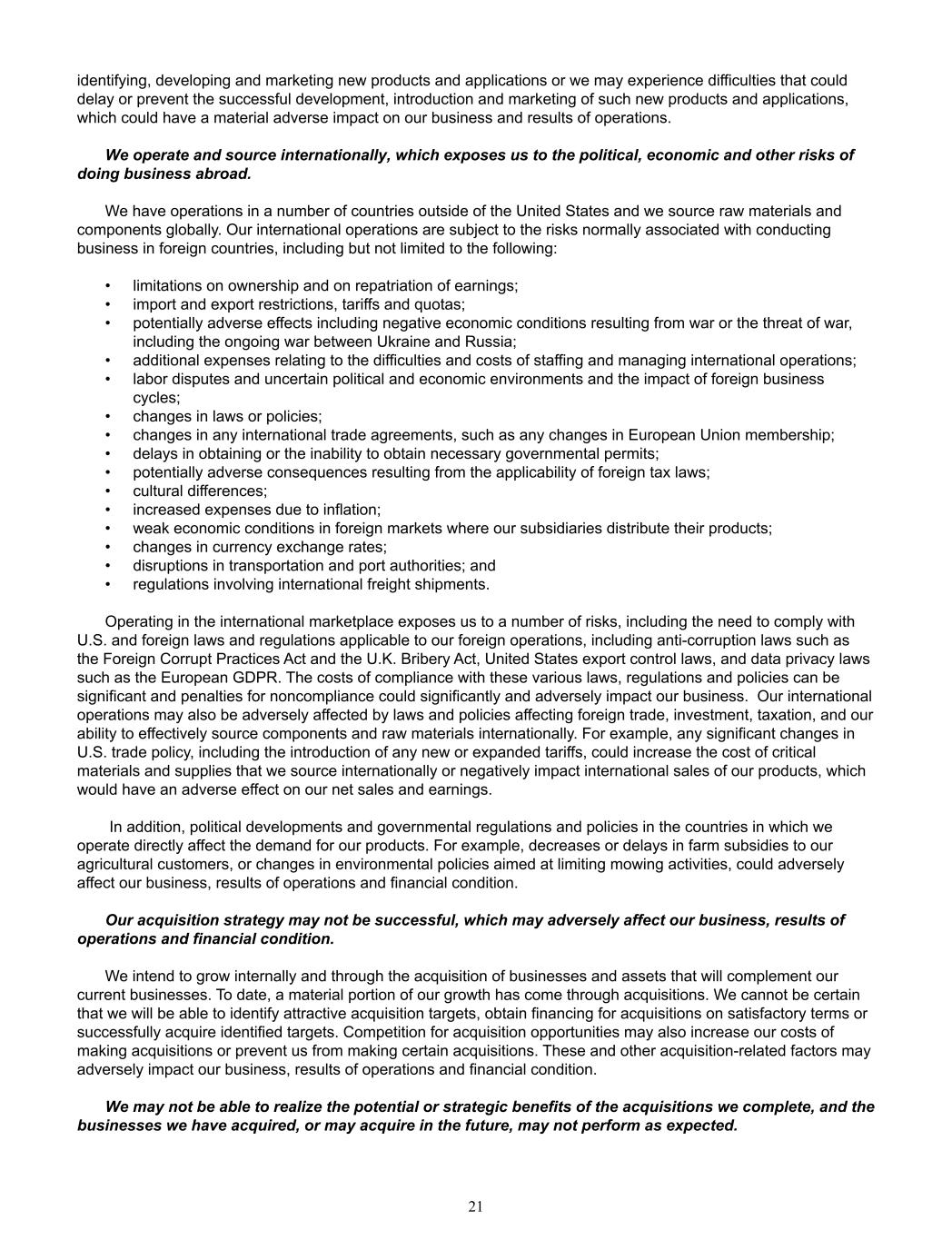
identifying, developing and marketing new products and applications or we may experience difficulties that could delay or prevent the successful development, introduction and marketing of such new products and applications, which could have a material adverse impact on our business and results of operations. We operate and source internationally, which exposes us to the political, economic and other risks of doing business abroad. We have operations in a number of countries outside of the United States and we source raw materials and components globally. Our international operations are subject to the risks normally associated with conducting business in foreign countries, including but not limited to the following: • limitations on ownership and on repatriation of earnings; • import and export restrictions, tariffs and quotas; • potentially adverse effects including negative economic conditions resulting from war or the threat of war, including the ongoing war between Ukraine and Russia; • additional expenses relating to the difficulties and costs of staffing and managing international operations; • labor disputes and uncertain political and economic environments and the impact of foreign business cycles; • changes in laws or policies; • changes in any international trade agreements, such as any changes in European Union membership; • delays in obtaining or the inability to obtain necessary governmental permits; • potentially adverse consequences resulting from the applicability of foreign tax laws; • cultural differences; • increased expenses due to inflation; • weak economic conditions in foreign markets where our subsidiaries distribute their products; • changes in currency exchange rates; • disruptions in transportation and port authorities; and • regulations involving international freight shipments. Operating in the international marketplace exposes us to a number of risks, including the need to comply with U.S. and foreign laws and regulations applicable to our foreign operations, including anti-corruption laws such as the Foreign Corrupt Practices Act and the U.K. Bribery Act, United States export control laws, and data privacy laws such as the European GDPR. The costs of compliance with these various laws, regulations and policies can be significant and penalties for noncompliance could significantly and adversely impact our business. Our international operations may also be adversely affected by laws and policies affecting foreign trade, investment, taxation, and our ability to effectively source components and raw materials internationally. For example, any significant changes in U.S. trade policy, including the introduction of any new or expanded tariffs, could increase the cost of critical materials and supplies that we source internationally or negatively impact international sales of our products, which would have an adverse effect on our net sales and earnings. In addition, political developments and governmental regulations and policies in the countries in which we operate directly affect the demand for our products. For example, decreases or delays in farm subsidies to our agricultural customers, or changes in environmental policies aimed at limiting mowing activities, could adversely affect our business, results of operations and financial condition. Our acquisition strategy may not be successful, which may adversely affect our business, results of operations and financial condition. We intend to grow internally and through the acquisition of businesses and assets that will complement our current businesses. To date, a material portion of our growth has come through acquisitions. We cannot be certain that we will be able to identify attractive acquisition targets, obtain financing for acquisitions on satisfactory terms or successfully acquire identified targets. Competition for acquisition opportunities may also increase our costs of making acquisitions or prevent us from making certain acquisitions. These and other acquisition-related factors may adversely impact our business, results of operations and financial condition. We may not be able to realize the potential or strategic benefits of the acquisitions we complete, and the businesses we have acquired, or may acquire in the future, may not perform as expected. 21

Acquisitions are an important part of our growth strategy and we have completed a number of acquisitions over the past several years. We acquired Timberwolf in 2021 and Royal Truck in 2023. Acquisitions can be difficult, time- consuming, and pose a number of risks, including: • potential negative impact on our earnings per share as a result of acquisition costs and related financing costs, among other things; • the assumption of liabilities that are unknown to us at the time of closing; • failure of acquired products to achieve projected sales; • potential downward pressure on operating margins due to lower operating margins of acquired businesses, increased headcount costs and other expenses associated with adding and supporting new products; • disruption of ongoing business operations, including diversion of management’s attention and uncertainty for employees and customers, particularly during the post-acquisition integration process; and • potential negative impact on our relationships with customers, distributors and vendors. If we do not manage these risks, the acquisitions that we complete may have an adverse effect on our business, our results of operations or financial condition. In addition, we may not be successful in integrating acquired businesses into our existing operations and achieving projected synergies. We could face many risks in integrating acquired businesses, including but not limited to the following: • we may incur substantial costs, delays or other operational or financial challenges in integrating acquired businesses, including integrating each company's accounting, information technology, human resource and other administrative systems to facilitate effective management; • we may be unable to achieve expected cost reductions, to take advantage of cross-selling opportunities, or to eliminate redundant operations, facilities and systems; • we may encounter problems in integrating the acquired products with our existing and/or new products; • we may need to implement or improve controls, procedures and policies appropriate for a public company which could take a significant amount of time and expense; • acquisitions may divert our management’s attention from the operation of our existing businesses; • we may not be able to retain key personnel of acquired businesses; • there may be cultural challenges associated with integrating management and employees from the acquired businesses into our organization; and • we may encounter unanticipated events, circumstances and legal risk and associated liabilities. Our integration of acquired businesses requires significant efforts from the management of each entity, including coordinating existing business plans and research and development efforts. Integrating operations may distract management’s attention from the day-to-day operation of the combined companies. Ultimately, our attempts to integrate the operations, technology and personnel of acquired businesses may not be successful. If we are unable to successfully integrate acquired businesses, our future results may be negatively impacted. We may not achieve anticipated cost savings or synergies associated with restructuring some of our business operations. Efforts to restructure some of our business operations may not be successful. We may encounter significant challenges in integrating the operations, management, and cultures of the affected entities. These challenges could include difficulties in combining business processes, systems, and employee teams, which may lead to operational inefficiencies, loss of productivity, or failure to achieve anticipated cost savings or synergies. Disposal of non-core assets may adversely affect our business, results of operations and financial condition. We may sell or otherwise dispose of certain non-core assets or businesses. The failure to execute such transactions successfully or to achieve favorable terms may result in a loss of value, reduced liquidity, or the inability to reinvest in more strategic opportunities. 22
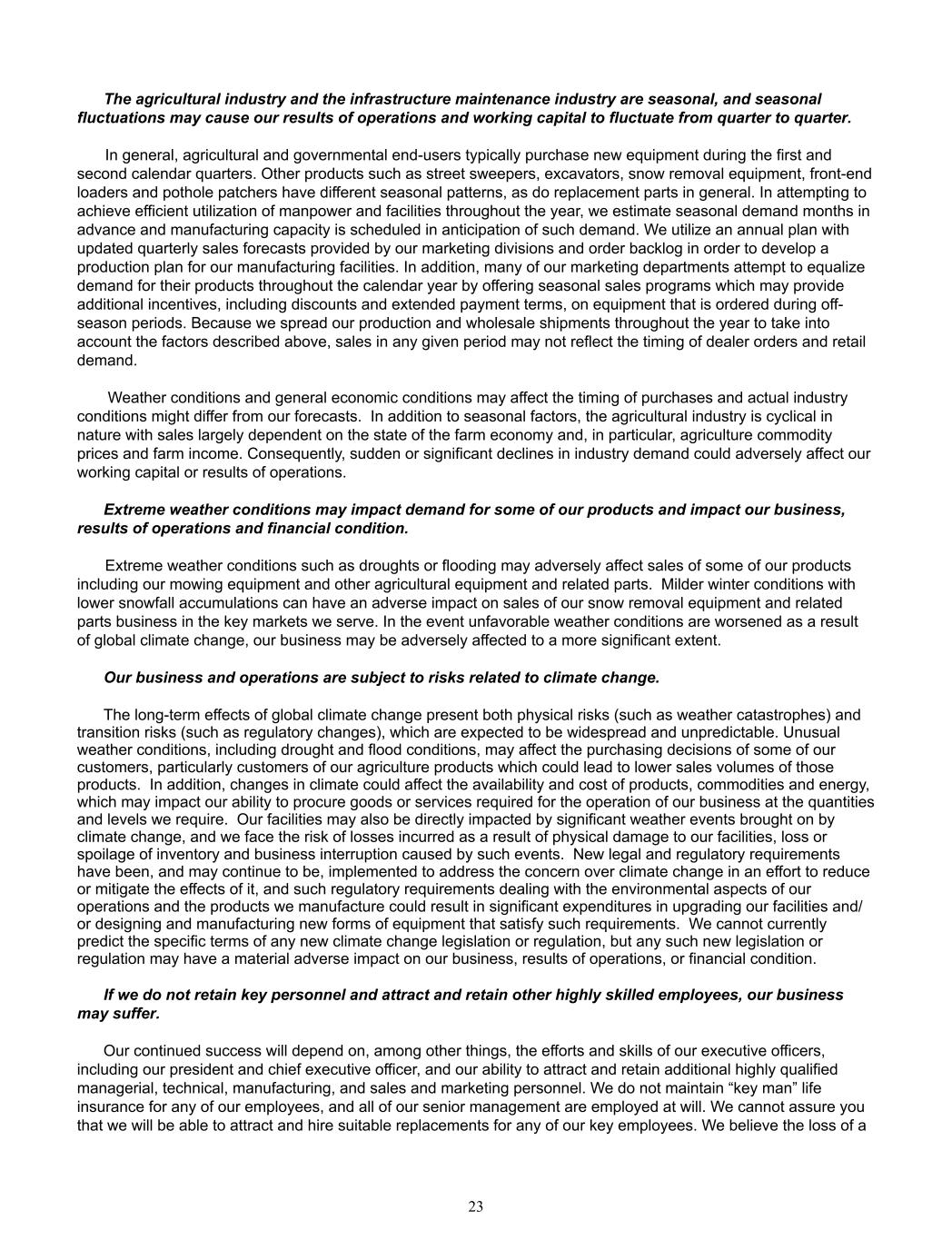
The agricultural industry and the infrastructure maintenance industry are seasonal, and seasonal fluctuations may cause our results of operations and working capital to fluctuate from quarter to quarter. In general, agricultural and governmental end-users typically purchase new equipment during the first and second calendar quarters. Other products such as street sweepers, excavators, snow removal equipment, front-end loaders and pothole patchers have different seasonal patterns, as do replacement parts in general. In attempting to achieve efficient utilization of manpower and facilities throughout the year, we estimate seasonal demand months in advance and manufacturing capacity is scheduled in anticipation of such demand. We utilize an annual plan with updated quarterly sales forecasts provided by our marketing divisions and order backlog in order to develop a production plan for our manufacturing facilities. In addition, many of our marketing departments attempt to equalize demand for their products throughout the calendar year by offering seasonal sales programs which may provide additional incentives, including discounts and extended payment terms, on equipment that is ordered during off- season periods. Because we spread our production and wholesale shipments throughout the year to take into account the factors described above, sales in any given period may not reflect the timing of dealer orders and retail demand. Weather conditions and general economic conditions may affect the timing of purchases and actual industry conditions might differ from our forecasts. In addition to seasonal factors, the agricultural industry is cyclical in nature with sales largely dependent on the state of the farm economy and, in particular, agriculture commodity prices and farm income. Consequently, sudden or significant declines in industry demand could adversely affect our working capital or results of operations. Extreme weather conditions may impact demand for some of our products and impact our business, results of operations and financial condition. Extreme weather conditions such as droughts or flooding may adversely affect sales of some of our products including our mowing equipment and other agricultural equipment and related parts. Milder winter conditions with lower snowfall accumulations can have an adverse impact on sales of our snow removal equipment and related parts business in the key markets we serve. In the event unfavorable weather conditions are worsened as a result of global climate change, our business may be adversely affected to a more significant extent. Our business and operations are subject to risks related to climate change. The long-term effects of global climate change present both physical risks (such as weather catastrophes) and transition risks (such as regulatory changes), which are expected to be widespread and unpredictable. Unusual weather conditions, including drought and flood conditions, may affect the purchasing decisions of some of our customers, particularly customers of our agriculture products which could lead to lower sales volumes of those products. In addition, changes in climate could affect the availability and cost of products, commodities and energy, which may impact our ability to procure goods or services required for the operation of our business at the quantities and levels we require. Our facilities may also be directly impacted by significant weather events brought on by climate change, and we face the risk of losses incurred as a result of physical damage to our facilities, loss or spoilage of inventory and business interruption caused by such events. New legal and regulatory requirements have been, and may continue to be, implemented to address the concern over climate change in an effort to reduce or mitigate the effects of it, and such regulatory requirements dealing with the environmental aspects of our operations and the products we manufacture could result in significant expenditures in upgrading our facilities and/ or designing and manufacturing new forms of equipment that satisfy such requirements. We cannot currently predict the specific terms of any new climate change legislation or regulation, but any such new legislation or regulation may have a material adverse impact on our business, results of operations, or financial condition. If we do not retain key personnel and attract and retain other highly skilled employees, our business may suffer. Our continued success will depend on, among other things, the efforts and skills of our executive officers, including our president and chief executive officer, and our ability to attract and retain additional highly qualified managerial, technical, manufacturing, and sales and marketing personnel. We do not maintain “key man” life insurance for any of our employees, and all of our senior management are employed at will. We cannot assure you that we will be able to attract and hire suitable replacements for any of our key employees. We believe the loss of a 23
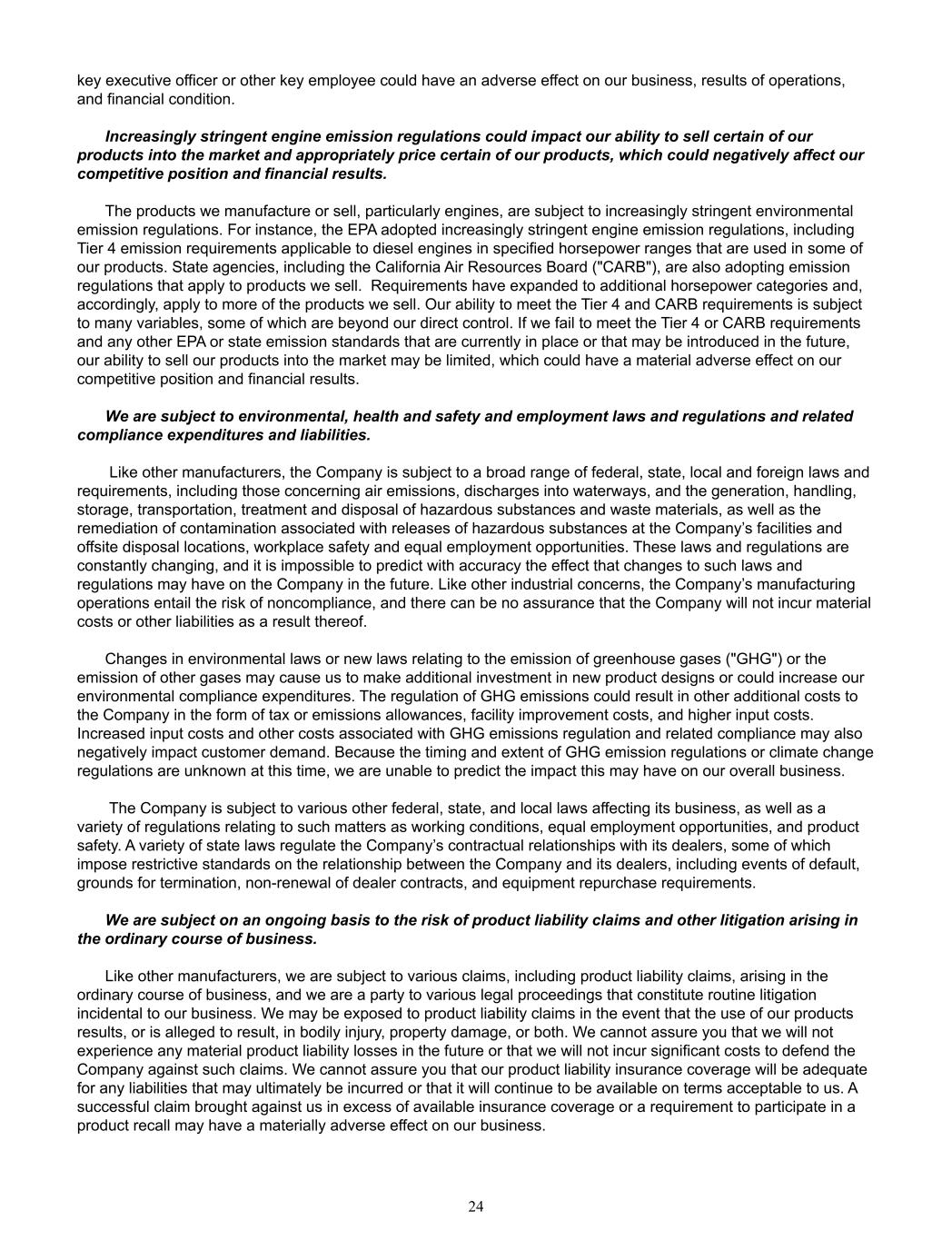
key executive officer or other key employee could have an adverse effect on our business, results of operations, and financial condition. Increasingly stringent engine emission regulations could impact our ability to sell certain of our products into the market and appropriately price certain of our products, which could negatively affect our competitive position and financial results. The products we manufacture or sell, particularly engines, are subject to increasingly stringent environmental emission regulations. For instance, the EPA adopted increasingly stringent engine emission regulations, including Tier 4 emission requirements applicable to diesel engines in specified horsepower ranges that are used in some of our products. State agencies, including the California Air Resources Board ("CARB"), are also adopting emission regulations that apply to products we sell. Requirements have expanded to additional horsepower categories and, accordingly, apply to more of the products we sell. Our ability to meet the Tier 4 and CARB requirements is subject to many variables, some of which are beyond our direct control. If we fail to meet the Tier 4 or CARB requirements and any other EPA or state emission standards that are currently in place or that may be introduced in the future, our ability to sell our products into the market may be limited, which could have a material adverse effect on our competitive position and financial results. We are subject to environmental, health and safety and employment laws and regulations and related compliance expenditures and liabilities. Like other manufacturers, the Company is subject to a broad range of federal, state, local and foreign laws and requirements, including those concerning air emissions, discharges into waterways, and the generation, handling, storage, transportation, treatment and disposal of hazardous substances and waste materials, as well as the remediation of contamination associated with releases of hazardous substances at the Company’s facilities and offsite disposal locations, workplace safety and equal employment opportunities. These laws and regulations are constantly changing, and it is impossible to predict with accuracy the effect that changes to such laws and regulations may have on the Company in the future. Like other industrial concerns, the Company’s manufacturing operations entail the risk of noncompliance, and there can be no assurance that the Company will not incur material costs or other liabilities as a result thereof. Changes in environmental laws or new laws relating to the emission of greenhouse gases ("GHG") or the emission of other gases may cause us to make additional investment in new product designs or could increase our environmental compliance expenditures. The regulation of GHG emissions could result in other additional costs to the Company in the form of tax or emissions allowances, facility improvement costs, and higher input costs. Increased input costs and other costs associated with GHG emissions regulation and related compliance may also negatively impact customer demand. Because the timing and extent of GHG emission regulations or climate change regulations are unknown at this time, we are unable to predict the impact this may have on our overall business. The Company is subject to various other federal, state, and local laws affecting its business, as well as a variety of regulations relating to such matters as working conditions, equal employment opportunities, and product safety. A variety of state laws regulate the Company’s contractual relationships with its dealers, some of which impose restrictive standards on the relationship between the Company and its dealers, including events of default, grounds for termination, non-renewal of dealer contracts, and equipment repurchase requirements. We are subject on an ongoing basis to the risk of product liability claims and other litigation arising in the ordinary course of business. Like other manufacturers, we are subject to various claims, including product liability claims, arising in the ordinary course of business, and we are a party to various legal proceedings that constitute routine litigation incidental to our business. We may be exposed to product liability claims in the event that the use of our products results, or is alleged to result, in bodily injury, property damage, or both. We cannot assure you that we will not experience any material product liability losses in the future or that we will not incur significant costs to defend the Company against such claims. We cannot assure you that our product liability insurance coverage will be adequate for any liabilities that may ultimately be incurred or that it will continue to be available on terms acceptable to us. A successful claim brought against us in excess of available insurance coverage or a requirement to participate in a product recall may have a materially adverse effect on our business. 24
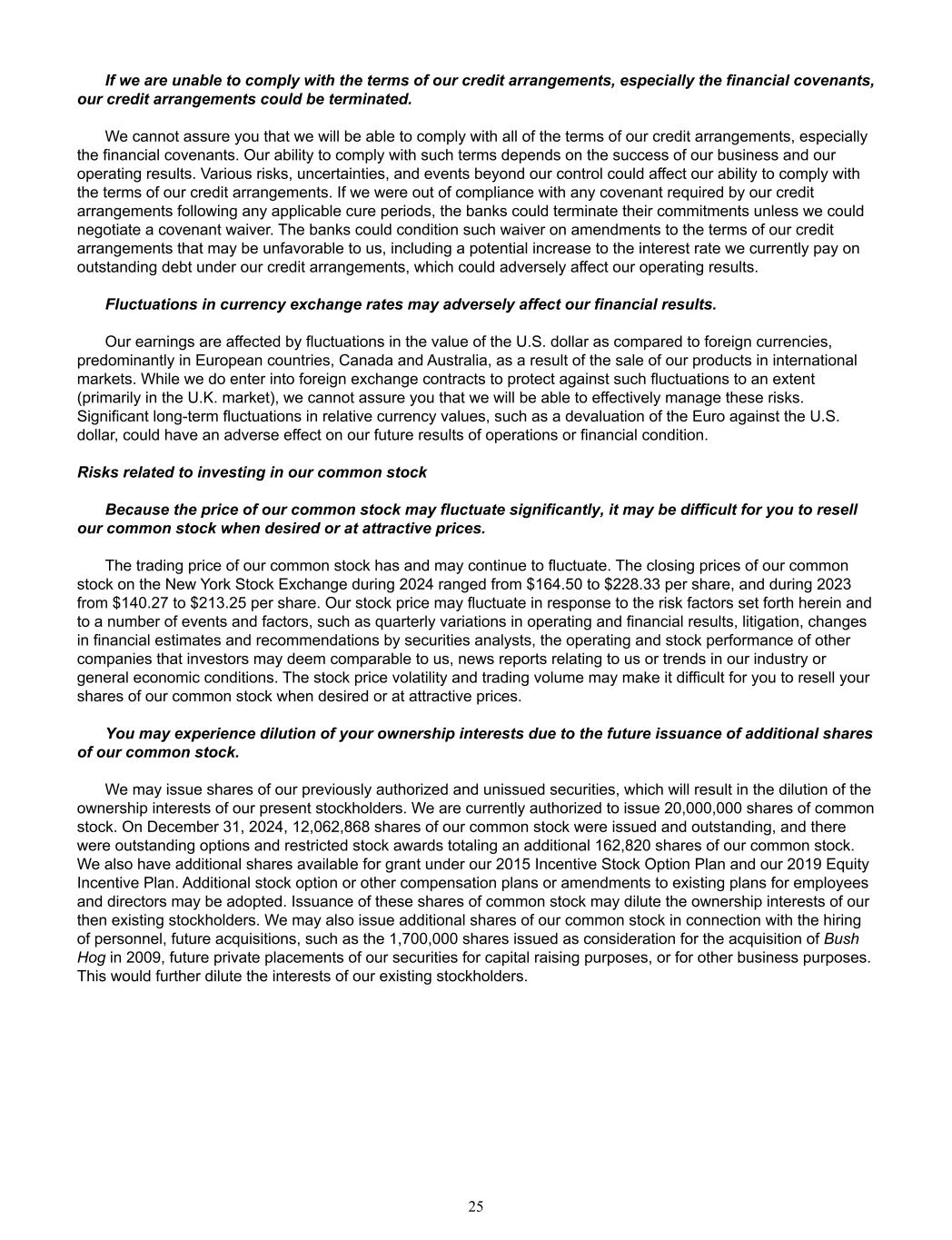
If we are unable to comply with the terms of our credit arrangements, especially the financial covenants, our credit arrangements could be terminated. We cannot assure you that we will be able to comply with all of the terms of our credit arrangements, especially the financial covenants. Our ability to comply with such terms depends on the success of our business and our operating results. Various risks, uncertainties, and events beyond our control could affect our ability to comply with the terms of our credit arrangements. If we were out of compliance with any covenant required by our credit arrangements following any applicable cure periods, the banks could terminate their commitments unless we could negotiate a covenant waiver. The banks could condition such waiver on amendments to the terms of our credit arrangements that may be unfavorable to us, including a potential increase to the interest rate we currently pay on outstanding debt under our credit arrangements, which could adversely affect our operating results. Fluctuations in currency exchange rates may adversely affect our financial results. Our earnings are affected by fluctuations in the value of the U.S. dollar as compared to foreign currencies, predominantly in European countries, Canada and Australia, as a result of the sale of our products in international markets. While we do enter into foreign exchange contracts to protect against such fluctuations to an extent (primarily in the U.K. market), we cannot assure you that we will be able to effectively manage these risks. Significant long-term fluctuations in relative currency values, such as a devaluation of the Euro against the U.S. dollar, could have an adverse effect on our future results of operations or financial condition. Risks related to investing in our common stock Because the price of our common stock may fluctuate significantly, it may be difficult for you to resell our common stock when desired or at attractive prices. The trading price of our common stock has and may continue to fluctuate. The closing prices of our common stock on the New York Stock Exchange during 2024 ranged from $164.50 to $228.33 per share, and during 2023 from $140.27 to $213.25 per share. Our stock price may fluctuate in response to the risk factors set forth herein and to a number of events and factors, such as quarterly variations in operating and financial results, litigation, changes in financial estimates and recommendations by securities analysts, the operating and stock performance of other companies that investors may deem comparable to us, news reports relating to us or trends in our industry or general economic conditions. The stock price volatility and trading volume may make it difficult for you to resell your shares of our common stock when desired or at attractive prices. You may experience dilution of your ownership interests due to the future issuance of additional shares of our common stock. We may issue shares of our previously authorized and unissued securities, which will result in the dilution of the ownership interests of our present stockholders. We are currently authorized to issue 20,000,000 shares of common stock. On December 31, 2024, 12,062,868 shares of our common stock were issued and outstanding, and there were outstanding options and restricted stock awards totaling an additional 162,820 shares of our common stock. We also have additional shares available for grant under our 2015 Incentive Stock Option Plan and our 2019 Equity Incentive Plan. Additional stock option or other compensation plans or amendments to existing plans for employees and directors may be adopted. Issuance of these shares of common stock may dilute the ownership interests of our then existing stockholders. We may also issue additional shares of our common stock in connection with the hiring of personnel, future acquisitions, such as the 1,700,000 shares issued as consideration for the acquisition of Bush Hog in 2009, future private placements of our securities for capital raising purposes, or for other business purposes. This would further dilute the interests of our existing stockholders. 25
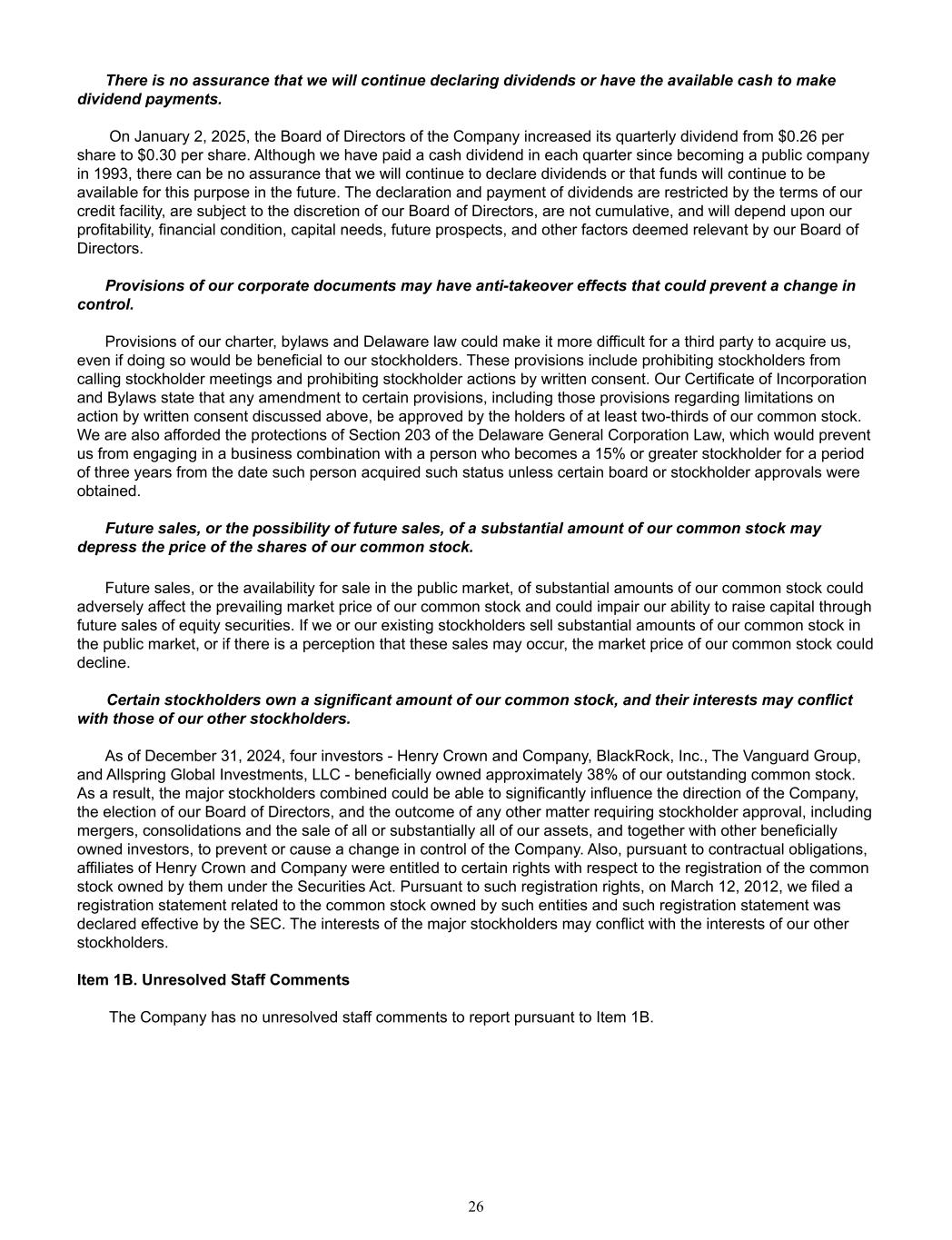
There is no assurance that we will continue declaring dividends or have the available cash to make dividend payments. On January 2, 2025, the Board of Directors of the Company increased its quarterly dividend from $0.26 per share to $0.30 per share. Although we have paid a cash dividend in each quarter since becoming a public company in 1993, there can be no assurance that we will continue to declare dividends or that funds will continue to be available for this purpose in the future. The declaration and payment of dividends are restricted by the terms of our credit facility, are subject to the discretion of our Board of Directors, are not cumulative, and will depend upon our profitability, financial condition, capital needs, future prospects, and other factors deemed relevant by our Board of Directors. Provisions of our corporate documents may have anti-takeover effects that could prevent a change in control. Provisions of our charter, bylaws and Delaware law could make it more difficult for a third party to acquire us, even if doing so would be beneficial to our stockholders. These provisions include prohibiting stockholders from calling stockholder meetings and prohibiting stockholder actions by written consent. Our Certificate of Incorporation and Bylaws state that any amendment to certain provisions, including those provisions regarding limitations on action by written consent discussed above, be approved by the holders of at least two-thirds of our common stock. We are also afforded the protections of Section 203 of the Delaware General Corporation Law, which would prevent us from engaging in a business combination with a person who becomes a 15% or greater stockholder for a period of three years from the date such person acquired such status unless certain board or stockholder approvals were obtained. Future sales, or the possibility of future sales, of a substantial amount of our common stock may depress the price of the shares of our common stock. Future sales, or the availability for sale in the public market, of substantial amounts of our common stock could adversely affect the prevailing market price of our common stock and could impair our ability to raise capital through future sales of equity securities. If we or our existing stockholders sell substantial amounts of our common stock in the public market, or if there is a perception that these sales may occur, the market price of our common stock could decline. Certain stockholders own a significant amount of our common stock, and their interests may conflict with those of our other stockholders. As of December 31, 2024, four investors - Henry Crown and Company, BlackRock, Inc., The Vanguard Group, and Allspring Global Investments, LLC - beneficially owned approximately 38% of our outstanding common stock. As a result, the major stockholders combined could be able to significantly influence the direction of the Company, the election of our Board of Directors, and the outcome of any other matter requiring stockholder approval, including mergers, consolidations and the sale of all or substantially all of our assets, and together with other beneficially owned investors, to prevent or cause a change in control of the Company. Also, pursuant to contractual obligations, affiliates of Henry Crown and Company were entitled to certain rights with respect to the registration of the common stock owned by them under the Securities Act. Pursuant to such registration rights, on March 12, 2012, we filed a registration statement related to the common stock owned by such entities and such registration statement was declared effective by the SEC. The interests of the major stockholders may conflict with the interests of our other stockholders. Item 1B. Unresolved Staff Comments The Company has no unresolved staff comments to report pursuant to Item 1B. 26

Item 1C. Cybersecurity Risk Management and Strategy Our cybersecurity program framework is based on the Center for Internet Security's ("CIS") Critical Security Controls. We have policies and procedures in place based on best practices and guidelines from the National Institute of Standards and Technology ("NIST"), an agency of the United States Department of Commerce, and the Cybersecurity & Infrastructure Security Agency, an agency of the United States Department of Homeland Security. Our Information Technology ("IT") team works to protect not only our information, but also the information of third parties we may hold or control, including by implementing physical, electronic, and procedural safeguards to protect the confidentiality, integrity, and availability of Company computer systems. We also limit physical access to server, storage, and network equipment to necessary staff. We assess the security of our networks, websites, and systems with automated vulnerability detection services from a provider that is validated by the NIST, based on the Security Content Automation Protocol ("SCAP") standard. We perform an annual review of our efforts to manage risk with controls that align with and map to key compliance frameworks, such as NIST and the ISO 27000 series of standards. We perform quarterly IT risk assessments that include cybersecurity risk assessments focused on action plans developed through annual reviews. We also respond to risks as they are discovered real-time. We are guided by an Information Security Incident Response Policy and corresponding Information Security Incident Response Procedure we implement when handling IT security incidents. Our process of assessing, identifying, and managing material risks from cybersecurity threats is integrated into our overall enterprise risk management system. Our process of managing risks from cybersecurity threats includes monitoring information channels from trusted security information sources. We review third-party service providers that manage sensitive Company information prior to engaging any such provider. Our reviews align with relevant government compliance requirements and review of System and Organization Controls reports. We establish governance, processes, and tools for managing various third-party related risks, including information security. As a condition of working with the Company, third-party service providers who access sensitive business or customer information are expected to meet certain information security requirements. Our processes for assessing, classifying, and managing cybersecurity risks were created in collaboration with consultants and auditors. We maintain consulting relationships that provide guidance for responding to evolving cybersecurity risks. We require employees to undertake data protection, cybersecurity training, and compliance programs annually. Internal and external auditors also review our adherence to established IT and cybersecurity controls. Despite our efforts, cyber attacks, unauthorized access or security breaches, or other cyber incidents such as computer viruses, malicious or destructive code, ransomware, social engineering attacks, hacking, denial-of-service attacks, and other similar attacks could materially affect us and disrupt our business. To date, we have not identified any risks from cybersecurity threats, including as a result of any previous cybersecurity incidents, that have, or are likely to, materially affect us, our business strategy, results of operation or financial condition. Potential consequences of a successful cyber attack or cybersecurity breaches or incidents could, however, include remediation costs, disruption of manufacturing capabilities, legal costs, increased cybersecurity protection costs, lost revenues resulting from the unauthorized use of proprietary information or the failure to retain or attract customers following an attack, litigation and legal risks including governmental or regulatory enforcement actions, increased insurance premiums, reputational damage that adversely affects customer or investor confidence, and damage to the Company's competitiveness, stock price, and long-term shareholder value. For more information about the cybersecurity risks we face, see the risk factor titled “We are significantly dependent on information technology and our business may suffer from disruptions associated with information technology, cyber-attacks or other catastrophic losses affecting our IT infrastructure” in Item 1A. Risk Factors. Governance Our Board considers cybersecurity risk as part of its risk oversight function and has delegated responsibility for the periodic review and evaluation of the Company’s policies and programs for identifying cybersecurity risks to the Audit Committee. In addition, the entire Board receives quarterly updates on the Company's cybersecurity action plans and annual reports containing full cybersecurity control assessments and action plans from senior management, and periodically reviews information regarding the Company's cybersecurity risks. We have an Information Technology Steering Committee ("ITSC"), comprised of the Company President and Chief Executive Officer, the Executive Vice Presidents of our Vegetation Management and Industrial Equipment Divisions, the Chief 27
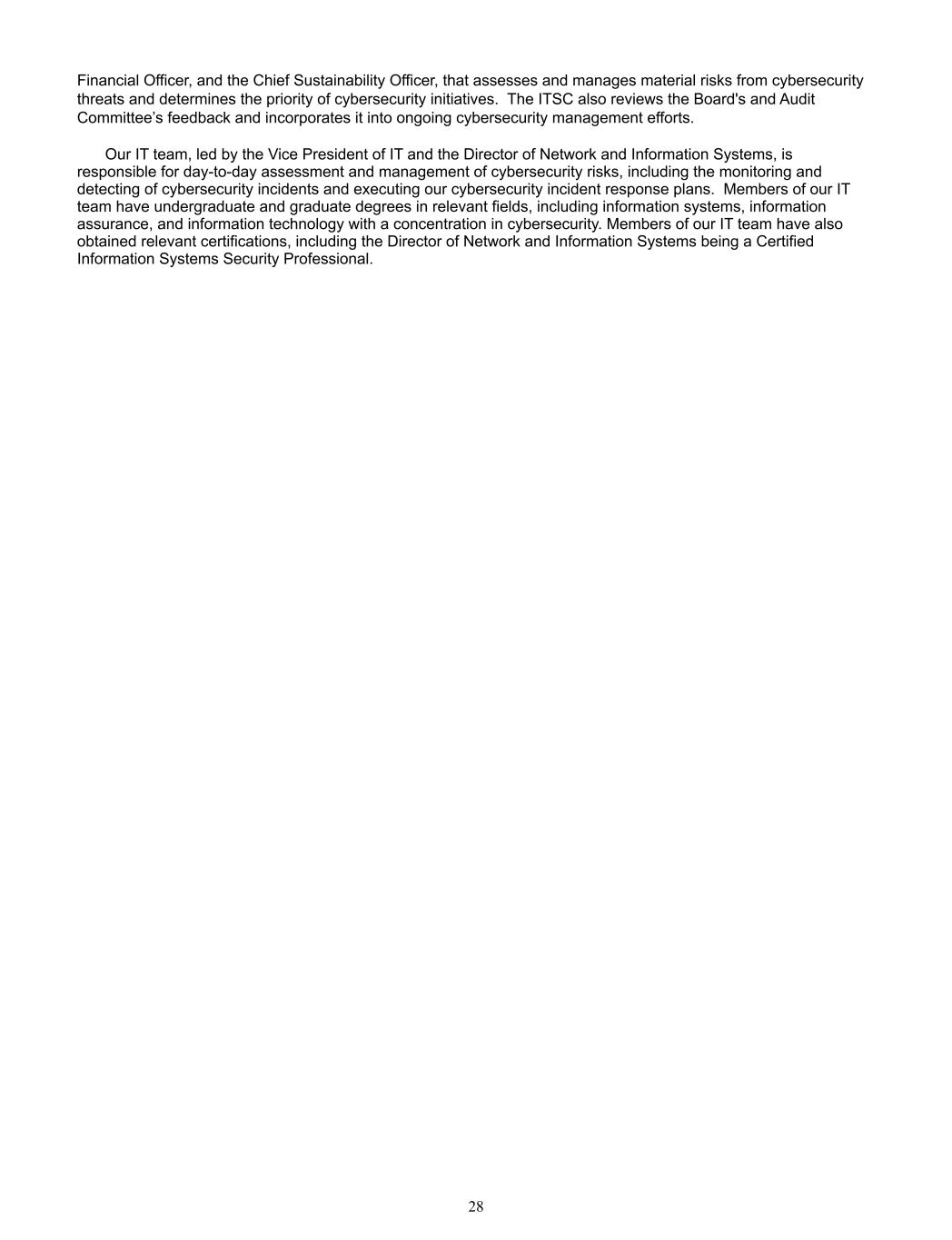
Financial Officer, and the Chief Sustainability Officer, that assesses and manages material risks from cybersecurity threats and determines the priority of cybersecurity initiatives. The ITSC also reviews the Board's and Audit Committee’s feedback and incorporates it into ongoing cybersecurity management efforts. Our IT team, led by the Vice President of IT and the Director of Network and Information Systems, is responsible for day-to-day assessment and management of cybersecurity risks, including the monitoring and detecting of cybersecurity incidents and executing our cybersecurity incident response plans. Members of our IT team have undergraduate and graduate degrees in relevant fields, including information systems, information assurance, and information technology with a concentration in cybersecurity. Members of our IT team have also obtained relevant certifications, including the Director of Network and Information Systems being a Certified Information Systems Security Professional. 28

Item 2. Properties As of February 21, 2025, the Company utilized twenty-seven principal manufacturing plants with fifteen located in the United States, eight in Europe, three in Canada, and one in Brazil. The facilities are listed below: Facility Square Footage Owned Principal Types of Products Manufactured And Assembled Winn, Michigan* 1,110,000 Owned Tree chippers, Grinders, Brush Cutters, and Debarkers for Morbark and Stump Cutters, Aerial Rimmers, Mulchers, Crawler Trucks for Rayco and Denis Cimaf Selma, Alabama* 744,000 Owned Mechanical Rotary Mowers, Finishing Mowers, Backhoes, Front-End Loaders for Bush Hog New Philadelphia, Ohio* 430,000 Owned Telescopic Excavators for Gradall and Vacuum Trucks for VacAll Wooster, Ohio* 400,000 Leased Fabrication and assembly of products for various product lines Gibson City, Illinois 275,000 Owned Mechanical Mowers, Blades, Deep Tillage Equipment, and other implements for Rhino, Bush Hog and OEMs Seguin, Texas* 230,000 Owned Hydraulic and Mechanical Rotary and Flail Mowers, Sickle-Bar Mowers, and Boom-Mounted Equipment for Alamo Industrial Neuville, France* 195,000 Owned Hydraulic and Mechanical Boom-Mounted Hedge and Grass Cutters for Rousseau and SMA Sao Joao da Boa Vista, Brazil* 183,000 Owned Mowing Equipment, Sugar Cane Trailers and other equipment for Santa Izabel Mukwonago, Wisconsin* 171,000 Owned Truck-Mounted Vacuum Trucks for Super Products Salford Priors, England* 168,000 Owned Tractor-Mounted Power Arm Flails and other Equipment for Bomford and Twose and Spearhead Ludlow, England* 167,000 Owned Hydraulic Boom-Mounted Hedge and Grass Cutters and other Equipment for McConnel and Twose Richmond, Virginia* 157,000 Leased Leaf Collection Equipment and Street Sweeper Replacement Brooms for ODB Huntsville, Alabama* 135,000 Owned Air and Mechanical Street Sweeping Equipment for Schwarze Daumeray, France* 125,000 Owned Vacuum Trucks, High Pressure Cleaning Systems and Trenchers for Rivard New Berlin, Wisconsin* 120,000 Owned Municipal Snow Removal and Ice Control Equipment for Wausau Coatesville, Indiana* 115,000 Owned Zero Turn Radius Mowers for Dixie Chopper Middelburg, the Netherlands* 110,000 Owned Boom Mowers, Flail Mowers and Stump Grinders for Dutch Power Englefeld, Saskatchewan, Canada* 105,000 Owned Mechanical Rotary Mowers, Snow Blowers, and Rock Removal Equipment for Schulte St. Valerien, Quebec, Canada* 104,000 Owned Snow and Ice Removal Equipment for Tenco Giessen, the Netherlands* 72,000 Owned Aquatic Harvesting Boats and Remote Control Mowing Equipment for Alamo Group The Netherlands Sioux Falls, South Dakota* 66,000 Owned Hydraulic and Mechanical Mowing Equipment for Tiger Shoemakersville, Pennsylvania* 65,000 Leased Truck Mounted Highway Attenuator Trucks and Other Specialty Trucks and Equipment for Royal Truck and Equipment Hopkinton, New Hampshire* 55,000 Owned Distributor of Public Works and Runway Maintenance Products for H.P. Fairfield Skowhegan, Maine* 47,000 Owned Distributor of Public Works and Runway Maintenance Products for H.P. Fairfield Ayer's Cliff, Quebec, Canada* 41,000 Owned Municipal Snow Removal and Ice Control Equipment for Everest Suffolk, England* 35,000 Leased Commercial wood chippers and other forestry equipment for Timberwolf Kent, Washington* 25,000 Leased Truck-Mounted Sweeping Equipment for the contractor market branded NiteHawk Peschadoires, France* 22,000 Owned Replacement Parts for Blades, Knives and Shackles for Forges Gorce Oakey, Australia 18,000 Leased Agriculture Mowing Equipment and other Attachments for Fieldquip Installation & Rental Facilities, Warehouses & Sales 540,000 Leased / Owned Services Parts Distribution, Installation Facilities and Sales and After Market Office Offices, Seguin & New Braunfels, Texas 29,000 Leased / Owned Corporate Office Total 6,059,000 81% * Principal manufacturing plants 29
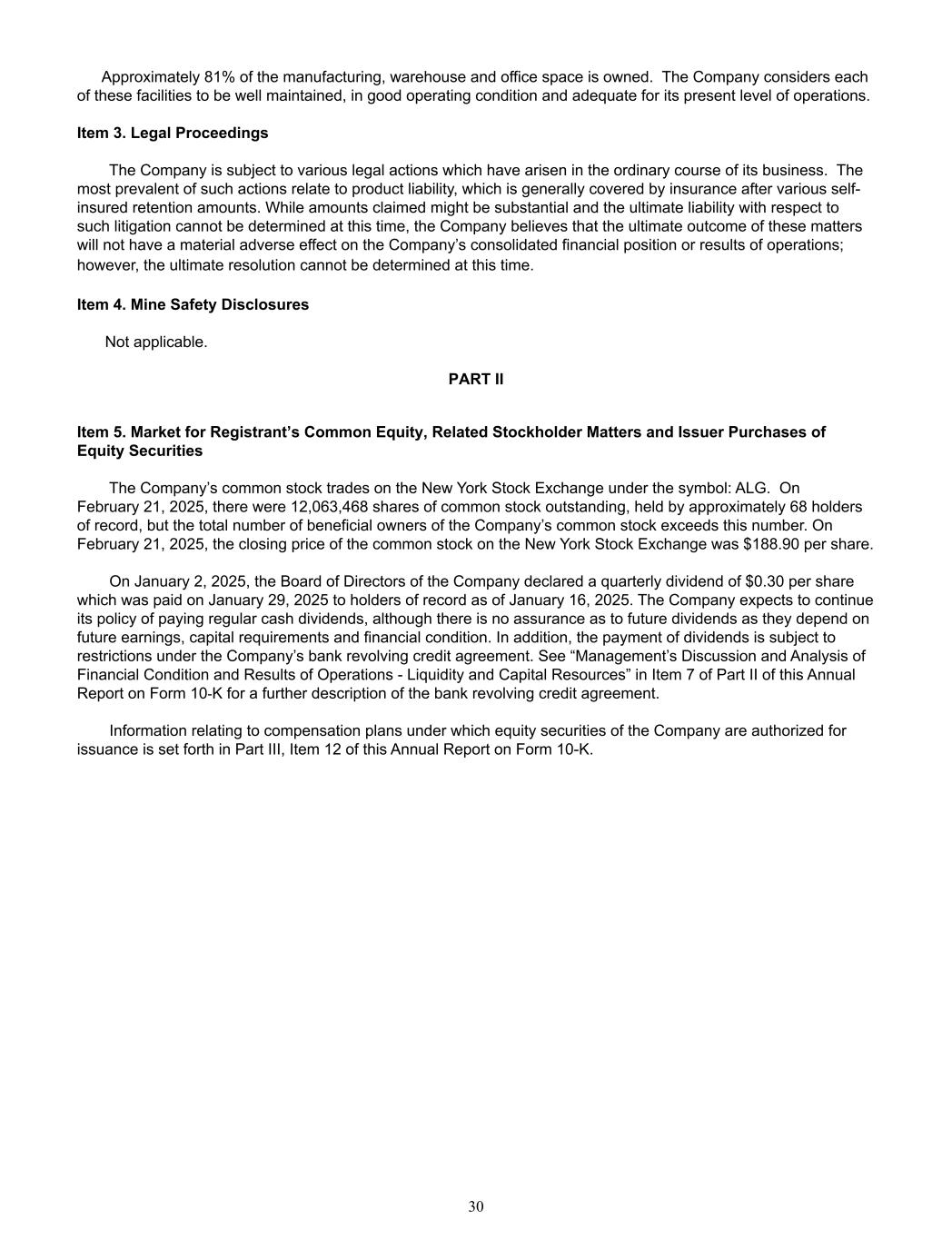
Approximately 81% of the manufacturing, warehouse and office space is owned. The Company considers each of these facilities to be well maintained, in good operating condition and adequate for its present level of operations. Item 3. Legal Proceedings The Company is subject to various legal actions which have arisen in the ordinary course of its business. The most prevalent of such actions relate to product liability, which is generally covered by insurance after various self- insured retention amounts. While amounts claimed might be substantial and the ultimate liability with respect to such litigation cannot be determined at this time, the Company believes that the ultimate outcome of these matters will not have a material adverse effect on the Company’s consolidated financial position or results of operations; however, the ultimate resolution cannot be determined at this time. Item 4. Mine Safety Disclosures Not applicable. PART II Item 5. Market for Registrant’s Common Equity, Related Stockholder Matters and Issuer Purchases of Equity Securities The Company’s common stock trades on the New York Stock Exchange under the symbol: ALG. On February 21, 2025, there were 12,063,468 shares of common stock outstanding, held by approximately 68 holders of record, but the total number of beneficial owners of the Company’s common stock exceeds this number. On February 21, 2025, the closing price of the common stock on the New York Stock Exchange was $188.90 per share. On January 2, 2025, the Board of Directors of the Company declared a quarterly dividend of $0.30 per share which was paid on January 29, 2025 to holders of record as of January 16, 2025. The Company expects to continue its policy of paying regular cash dividends, although there is no assurance as to future dividends as they depend on future earnings, capital requirements and financial condition. In addition, the payment of dividends is subject to restrictions under the Company’s bank revolving credit agreement. See “Management’s Discussion and Analysis of Financial Condition and Results of Operations - Liquidity and Capital Resources” in Item 7 of Part II of this Annual Report on Form 10-K for a further description of the bank revolving credit agreement. Information relating to compensation plans under which equity securities of the Company are authorized for issuance is set forth in Part III, Item 12 of this Annual Report on Form 10-K. 30

Stock Price Performance Graph The information contained in this Stock Performance Graph section shall not be deemed to be “soliciting material” or “filed” with the SEC or subject to the liabilities of Section 18 of the Exchange Act, except to the extent that Alamo Group Inc. specifically incorporates it by reference into a document filed under the Securities Act or the Exchange Act. The following graph and table set forth the cumulative total return to the Company's stockholders of our Common Stock during a five-year period ended December 31, 2024, as well as the performance of an overall stock market index (the S&P SmallCap 600 Index) and a published industry or line-of-business index (the S&P 500 Industrials Index) for the same period. COMPARISON OF 5 YEAR CUMULATIVE TOTAL RETURN* Among Alamo Group Inc., the S&P SmallCap 600 Index, and the S&P 500 Industrials Index Alamo Group Inc. S&P SmallCap 600 S&P 500 Industrials 12/19 12/20 12/21 12/22 12/23 12/24 $0 $20 $40 $60 $80 $100 $120 $140 $160 $180 $200 *$100 invested on 12/31/19 in stock or index, including reinvestment of dividends. Fiscal year ending December 31. Copyright© 2025 Standard & Poor's, a division of S&P Global. All rights reserved. 12/19 12/20 12/21 12/22 12/23 12/24 Alamo Group Inc. 100.00 110.41 118.24 114.36 170.62 151.71 S&P SmallCap 600 100.00 111.29 141.13 118.41 137.42 149.37 S&P 500 Industrials 100.00 111.06 134.52 127.15 150.20 176.44 Purchase of Equity Securities On October 31 2024, the Company announced that its Board of Directors approved a share repurchase program under which the Company is authorized to repurchase in the aggregate up to $50.0 million of its outstanding stock over 5 years, through October 30, 2029. The extent to which the Company may repurchase 31
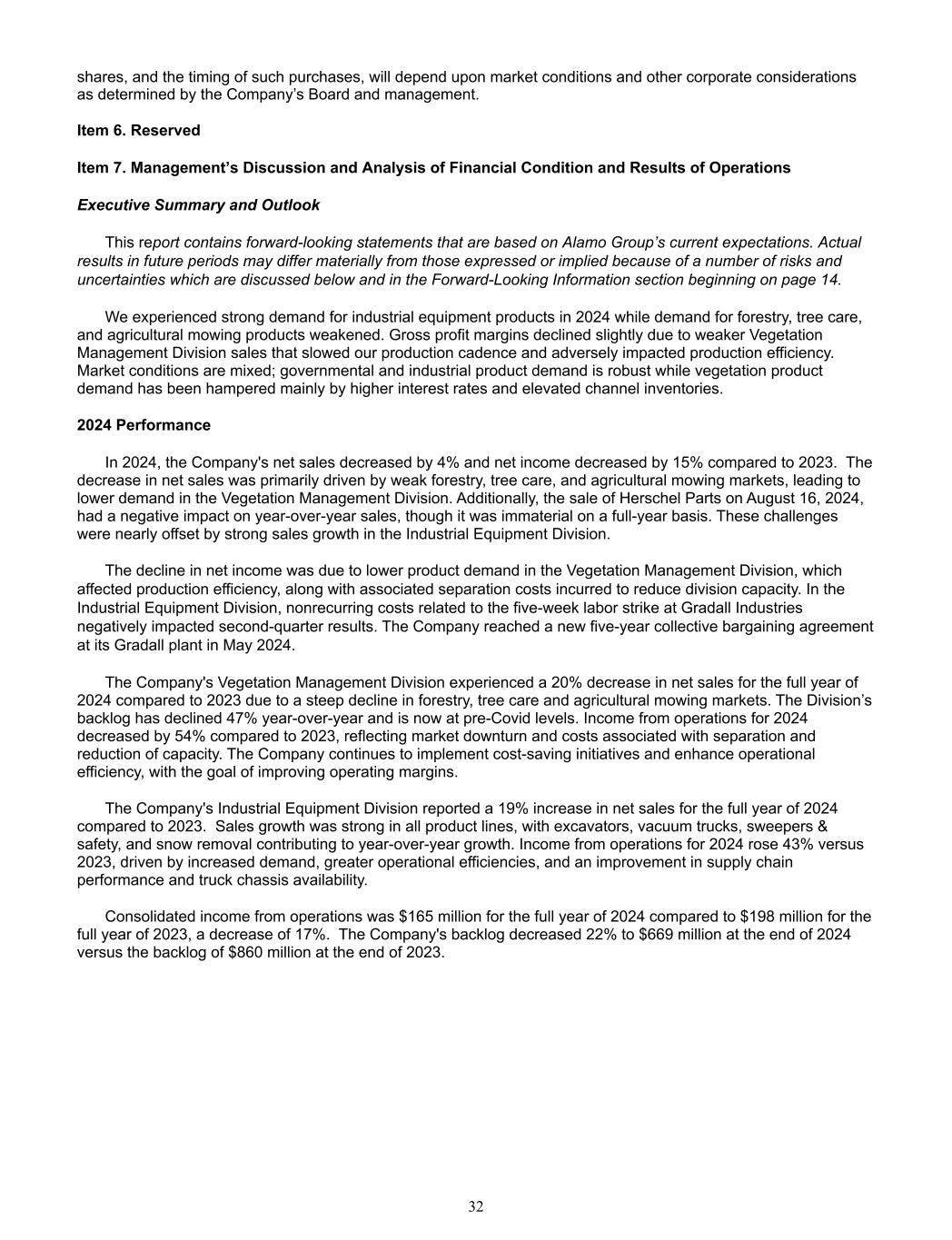
shares, and the timing of such purchases, will depend upon market conditions and other corporate considerations as determined by the Company’s Board and management. Item 6. Reserved Item 7. Management’s Discussion and Analysis of Financial Condition and Results of Operations Executive Summary and Outlook This report contains forward-looking statements that are based on Alamo Group’s current expectations. Actual results in future periods may differ materially from those expressed or implied because of a number of risks and uncertainties which are discussed below and in the Forward-Looking Information section beginning on page 14. We experienced strong demand for industrial equipment products in 2024 while demand for forestry, tree care, and agricultural mowing products weakened. Gross profit margins declined slightly due to weaker Vegetation Management Division sales that slowed our production cadence and adversely impacted production efficiency. Market conditions are mixed; governmental and industrial product demand is robust while vegetation product demand has been hampered mainly by higher interest rates and elevated channel inventories. 2024 Performance In 2024, the Company's net sales decreased by 4% and net income decreased by 15% compared to 2023. The decrease in net sales was primarily driven by weak forestry, tree care, and agricultural mowing markets, leading to lower demand in the Vegetation Management Division. Additionally, the sale of Herschel Parts on August 16, 2024, had a negative impact on year-over-year sales, though it was immaterial on a full-year basis. These challenges were nearly offset by strong sales growth in the Industrial Equipment Division. The decline in net income was due to lower product demand in the Vegetation Management Division, which affected production efficiency, along with associated separation costs incurred to reduce division capacity. In the Industrial Equipment Division, nonrecurring costs related to the five-week labor strike at Gradall Industries negatively impacted second-quarter results. The Company reached a new five-year collective bargaining agreement at its Gradall plant in May 2024. The Company's Vegetation Management Division experienced a 20% decrease in net sales for the full year of 2024 compared to 2023 due to a steep decline in forestry, tree care and agricultural mowing markets. The Division’s backlog has declined 47% year-over-year and is now at pre-Covid levels. Income from operations for 2024 decreased by 54% compared to 2023, reflecting market downturn and costs associated with separation and reduction of capacity. The Company continues to implement cost-saving initiatives and enhance operational efficiency, with the goal of improving operating margins. The Company's Industrial Equipment Division reported a 19% increase in net sales for the full year of 2024 compared to 2023. Sales growth was strong in all product lines, with excavators, vacuum trucks, sweepers & safety, and snow removal contributing to year-over-year growth. Income from operations for 2024 rose 43% versus 2023, driven by increased demand, greater operational efficiencies, and an improvement in supply chain performance and truck chassis availability. Consolidated income from operations was $165 million for the full year of 2024 compared to $198 million for the full year of 2023, a decrease of 17%. The Company's backlog decreased 22% to $669 million at the end of 2024 versus the backlog of $860 million at the end of 2023. 32
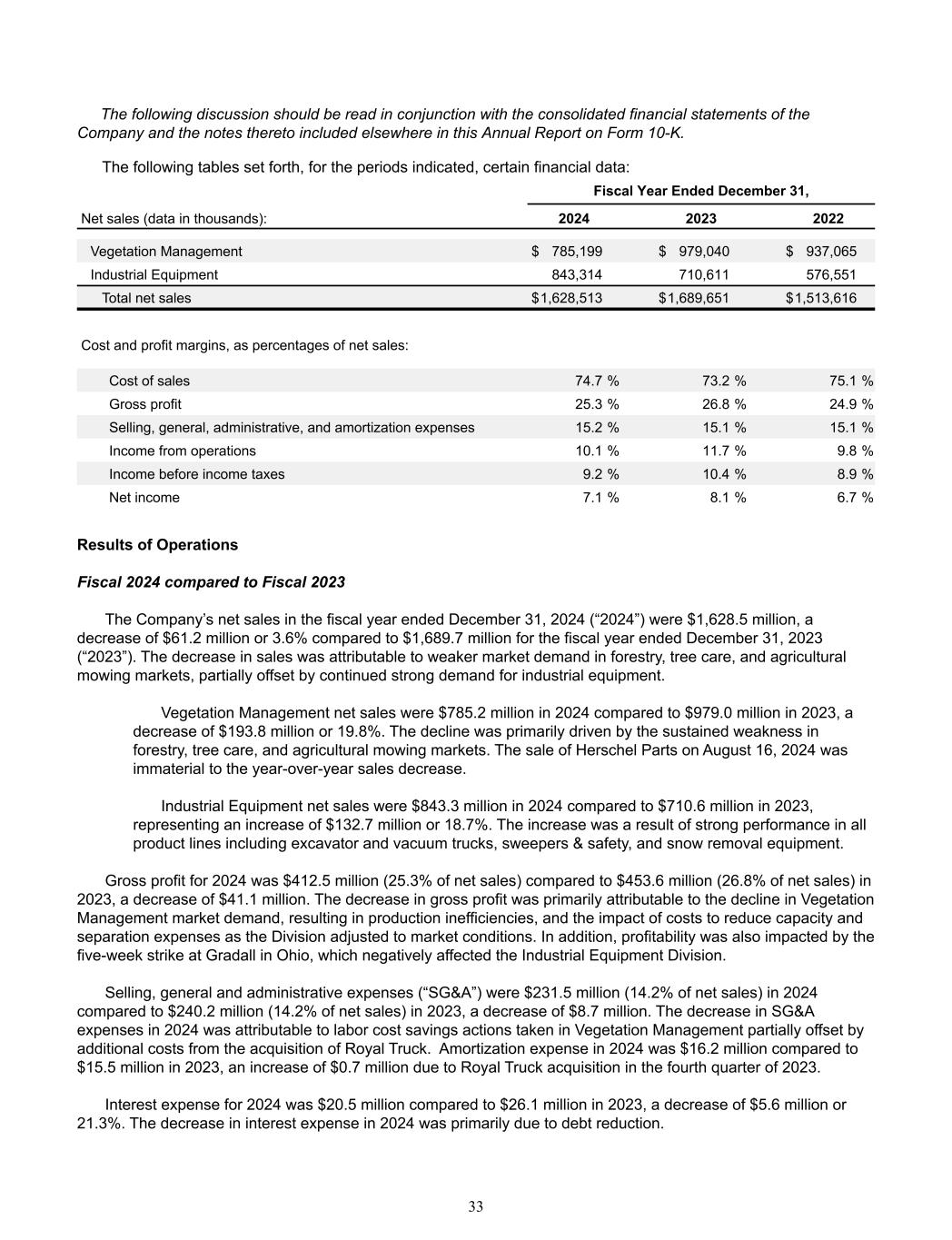
The following discussion should be read in conjunction with the consolidated financial statements of the Company and the notes thereto included elsewhere in this Annual Report on Form 10-K. The following tables set forth, for the periods indicated, certain financial data: Fiscal Year Ended December 31, Net sales (data in thousands): 2024 2023 2022 Vegetation Management $ 785,199 $ 979,040 $ 937,065 Industrial Equipment 843,314 710,611 576,551 Total net sales $ 1,628,513 $ 1,689,651 $ 1,513,616 Cost and profit margins, as percentages of net sales: Cost of sales 74.7 % 73.2 % 75.1 % Gross profit 25.3 % 26.8 % 24.9 % Selling, general, administrative, and amortization expenses 15.2 % 15.1 % 15.1 % Income from operations 10.1 % 11.7 % 9.8 % Income before income taxes 9.2 % 10.4 % 8.9 % Net income 7.1 % 8.1 % 6.7 % Results of Operations Fiscal 2024 compared to Fiscal 2023 The Company’s net sales in the fiscal year ended December 31, 2024 (“2024”) were $1,628.5 million, a decrease of $61.2 million or 3.6% compared to $1,689.7 million for the fiscal year ended December 31, 2023 (“2023”). The decrease in sales was attributable to weaker market demand in forestry, tree care, and agricultural mowing markets, partially offset by continued strong demand for industrial equipment. Vegetation Management net sales were $785.2 million in 2024 compared to $979.0 million in 2023, a decrease of $193.8 million or 19.8%. The decline was primarily driven by the sustained weakness in forestry, tree care, and agricultural mowing markets. The sale of Herschel Parts on August 16, 2024 was immaterial to the year-over-year sales decrease. Industrial Equipment net sales were $843.3 million in 2024 compared to $710.6 million in 2023, representing an increase of $132.7 million or 18.7%. The increase was a result of strong performance in all product lines including excavator and vacuum trucks, sweepers & safety, and snow removal equipment. Gross profit for 2024 was $412.5 million (25.3% of net sales) compared to $453.6 million (26.8% of net sales) in 2023, a decrease of $41.1 million. The decrease in gross profit was primarily attributable to the decline in Vegetation Management market demand, resulting in production inefficiencies, and the impact of costs to reduce capacity and separation expenses as the Division adjusted to market conditions. In addition, profitability was also impacted by the five-week strike at Gradall in Ohio, which negatively affected the Industrial Equipment Division. Selling, general and administrative expenses (“SG&A”) were $231.5 million (14.2% of net sales) in 2024 compared to $240.2 million (14.2% of net sales) in 2023, a decrease of $8.7 million. The decrease in SG&A expenses in 2024 was attributable to labor cost savings actions taken in Vegetation Management partially offset by additional costs from the acquisition of Royal Truck. Amortization expense in 2024 was $16.2 million compared to $15.5 million in 2023, an increase of $0.7 million due to Royal Truck acquisition in the fourth quarter of 2023. Interest expense for 2024 was $20.5 million compared to $26.1 million in 2023, a decrease of $5.6 million or 21.3%. The decrease in interest expense in 2024 was primarily due to debt reduction. 33

Interest income for 2024 was $2.6 million compared to $1.5 million in 2023, an increase of $1.1 million or 77.6%. The increase in 2024 was primarily due to higher cash on hand. Other income (expense), net was income of $2.7 million during 2024 compared to income of $1.8 million in 2023. The increase was primarily driven by foreign exchange transaction gains, offset by fixed asset losses. Provision for income taxes was $33.7 million (22.5% of income before income taxes) for 2024 compared to $39.0 million (22.2% of income before income taxes) in 2023. Net income for 2024 was $115.9 million compared to $136.2 million in 2023, with the decrease in 2024 net income resulting from the factors described above. Fiscal 2023 compared to Fiscal 2022 The Company’s net sales in the fiscal year ended December 31, 2023 (“2023”) were $1,689.7 million, an increase of $176.1 million or 11.6% compared to $1,513.6 million for the fiscal year ended December 31, 2022 (“2022”). The increase in sales was attributable to continued strong customer demand for our products in both the Vegetation Management and Industrial Equipment Divisions, improved pricing, and higher throughput due to gradually improving supply chain conditions. Supply chain disruptions and a shortage of skilled labor negatively impacted net sales, especially in the first half of the year earlier. Net Vegetation Management sales were $979.0 million in 2023 compared to $937.1 million in 2022, an increase of $41.9 million or 4.5%, coming from a strong performance in European agricultural and governmental mowing, forestry and tree care, and North American governmental mowing equipment. Skilled labor shortages and certain supplier issues constrained this division during 2023. Net Industrial Equipment sales were $710.6 million in 2023 compared to $576.6 million in 2022, representing an increase of $134.0 million or 23.3%. The increase was a result of strong performance in all product lines including excavator and vacuum trucks, sweepers and debris collection, and snow removal equipment further supported by the acquisition of Royal Truck. This division was negatively impacted by a shortage of skilled labor and disruptions in parts of its supply chain, predominantly causing delays in receiving truck chassis. Gross profit for 2023 was $453.6 million (26.8% of net sales) compared to $376.5 million (24.9% of net sales) in 2022, an increase of $77.1 million. The increase in gross profit was mainly attributable to higher sales volume and better operational performance during 2023 compared to 2022 as well as improved pricing which led to higher profitability as a percentage of sales in 2023 compared to 2022, though these results were partially offset by the negative impacts of supply chain disruptions and material inflation previously mentioned. Selling, general and administrative expenses (“SG&A”) were $240.2 million (14.2% of net sales) in 2023 compared to $212.6 million (14.0% of net sales) in 2022, an increase of $27.6 million. The increase in SG&A expenses in 2023 was largely attributable to higher marketing expenses related to trade shows, sales promotions and commissions and to a lesser extent, sales volume-driven administration expense. Amortization expense in 2023 was $15.5 million compared to $15.3 million in 2022, an increase of $0.2 million. Interest expense for 2023 was $26.1 million compared to $14.4 million in 2022, an increase of $11.7 million or 81.7%. The increase in interest expense in 2023 primarily came from higher interest rates compared to 2022. Other income (expense), net was income of $1.8 million during 2023 compared to expense of $0.7 million in 2022. The increase in 2023 was primarily the result of a gain on fixed assets relating to the sale of a manufacturing facility located in Kent, Washington partially offset by loss on currency exchange. The expense in 2022 was primarily the result of an excise tax audit and to a lesser extent, changes in exchange rates. Provision for income taxes was $39.0 million (22.2% of income before income taxes) for 2023 compared to $32.4 million (24.1% of income before income taxes) in 2022. Net income for 2023 was $136.2 million compared to $101.9 million in 2022, with the increase in 2023 net income resulting from the factors described above. 34
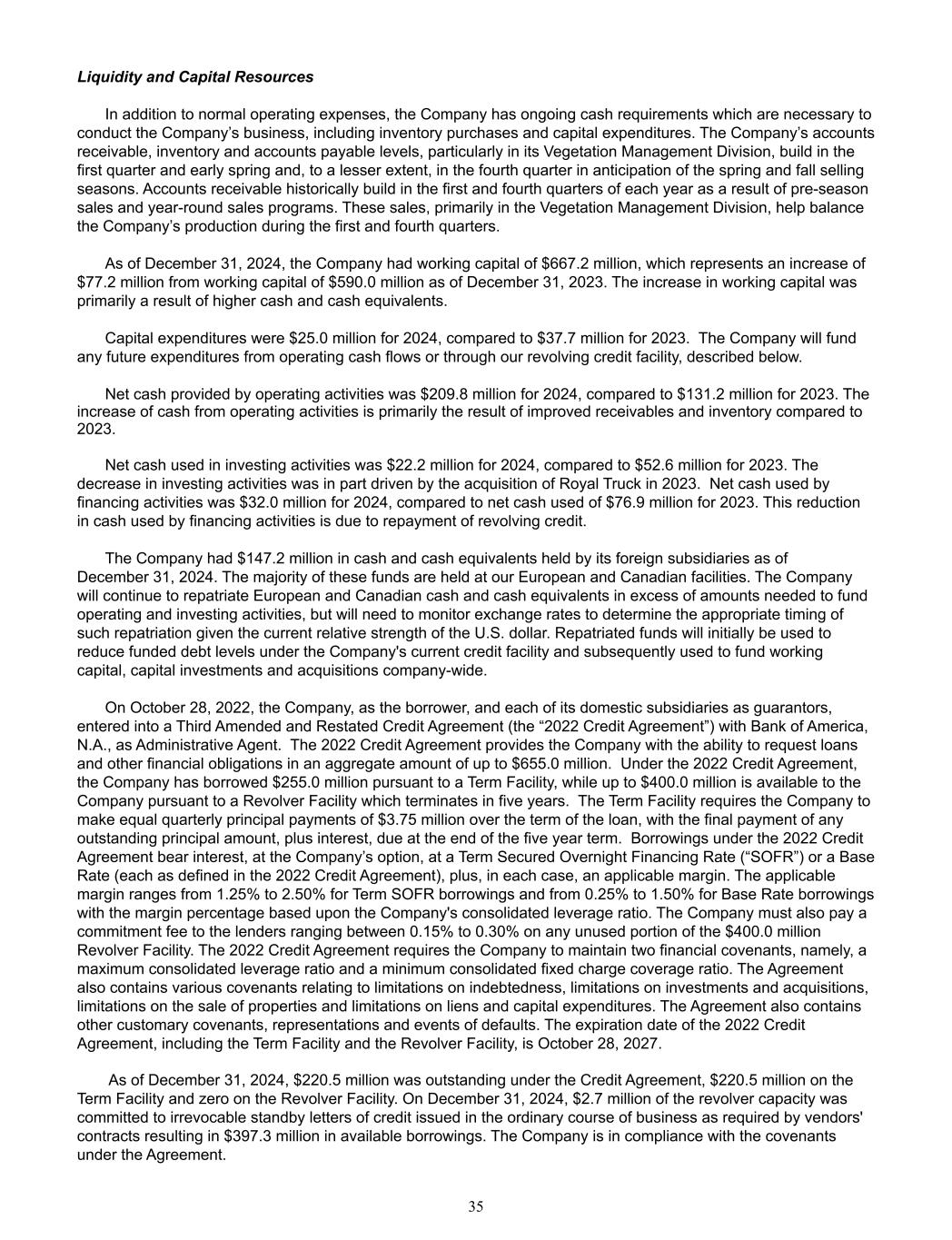
Liquidity and Capital Resources In addition to normal operating expenses, the Company has ongoing cash requirements which are necessary to conduct the Company’s business, including inventory purchases and capital expenditures. The Company’s accounts receivable, inventory and accounts payable levels, particularly in its Vegetation Management Division, build in the first quarter and early spring and, to a lesser extent, in the fourth quarter in anticipation of the spring and fall selling seasons. Accounts receivable historically build in the first and fourth quarters of each year as a result of pre-season sales and year-round sales programs. These sales, primarily in the Vegetation Management Division, help balance the Company’s production during the first and fourth quarters. As of December 31, 2024, the Company had working capital of $667.2 million, which represents an increase of $77.2 million from working capital of $590.0 million as of December 31, 2023. The increase in working capital was primarily a result of higher cash and cash equivalents. Capital expenditures were $25.0 million for 2024, compared to $37.7 million for 2023. The Company will fund any future expenditures from operating cash flows or through our revolving credit facility, described below. Net cash provided by operating activities was $209.8 million for 2024, compared to $131.2 million for 2023. The increase of cash from operating activities is primarily the result of improved receivables and inventory compared to 2023. Net cash used in investing activities was $22.2 million for 2024, compared to $52.6 million for 2023. The decrease in investing activities was in part driven by the acquisition of Royal Truck in 2023. Net cash used by financing activities was $32.0 million for 2024, compared to net cash used of $76.9 million for 2023. This reduction in cash used by financing activities is due to repayment of revolving credit. The Company had $147.2 million in cash and cash equivalents held by its foreign subsidiaries as of December 31, 2024. The majority of these funds are held at our European and Canadian facilities. The Company will continue to repatriate European and Canadian cash and cash equivalents in excess of amounts needed to fund operating and investing activities, but will need to monitor exchange rates to determine the appropriate timing of such repatriation given the current relative strength of the U.S. dollar. Repatriated funds will initially be used to reduce funded debt levels under the Company's current credit facility and subsequently used to fund working capital, capital investments and acquisitions company-wide. On October 28, 2022, the Company, as the borrower, and each of its domestic subsidiaries as guarantors, entered into a Third Amended and Restated Credit Agreement (the “2022 Credit Agreement”) with Bank of America, N.A., as Administrative Agent. The 2022 Credit Agreement provides the Company with the ability to request loans and other financial obligations in an aggregate amount of up to $655.0 million. Under the 2022 Credit Agreement, the Company has borrowed $255.0 million pursuant to a Term Facility, while up to $400.0 million is available to the Company pursuant to a Revolver Facility which terminates in five years. The Term Facility requires the Company to make equal quarterly principal payments of $3.75 million over the term of the loan, with the final payment of any outstanding principal amount, plus interest, due at the end of the five year term. Borrowings under the 2022 Credit Agreement bear interest, at the Company’s option, at a Term Secured Overnight Financing Rate (“SOFR”) or a Base Rate (each as defined in the 2022 Credit Agreement), plus, in each case, an applicable margin. The applicable margin ranges from 1.25% to 2.50% for Term SOFR borrowings and from 0.25% to 1.50% for Base Rate borrowings with the margin percentage based upon the Company's consolidated leverage ratio. The Company must also pay a commitment fee to the lenders ranging between 0.15% to 0.30% on any unused portion of the $400.0 million Revolver Facility. The 2022 Credit Agreement requires the Company to maintain two financial covenants, namely, a maximum consolidated leverage ratio and a minimum consolidated fixed charge coverage ratio. The Agreement also contains various covenants relating to limitations on indebtedness, limitations on investments and acquisitions, limitations on the sale of properties and limitations on liens and capital expenditures. The Agreement also contains other customary covenants, representations and events of defaults. The expiration date of the 2022 Credit Agreement, including the Term Facility and the Revolver Facility, is October 28, 2027. As of December 31, 2024, $220.5 million was outstanding under the Credit Agreement, $220.5 million on the Term Facility and zero on the Revolver Facility. On December 31, 2024, $2.7 million of the revolver capacity was committed to irrevocable standby letters of credit issued in the ordinary course of business as required by vendors' contracts resulting in $397.3 million in available borrowings. The Company is in compliance with the covenants under the Agreement. 35

Management believes the Agreement and the Company’s ability to internally generate funds from operations should be sufficient to meet the Company’s cash requirements for the foreseeable future. However, future challenges affecting the banking industry and credit markets in general could potentially cause changes to credit availability, which creates a level of uncertainty. Inflation The Company is exposed to the risk that the price of energy, steel and other purchased components may increase and the Company may not be able to increase the price of its products correspondingly. If this occurs, the Company’s results of operations would be adversely impacted. In 2024, while inflation moderated compared to prior years, the cost of commodities, components, parts, and accessories remained elevated relative to historical levels. Throughout 2024, we continued to implement strategic pricing actions and operational efficiency measures to help offset these sustained cost pressures. While the rate of inflation decreased during 2024, prices for many key inputs remained higher than pre-pandemic levels. Looking ahead to 2025, we expect the cost environment to remain challenging, though with less volatility than in recent years. We anticipate modest increases in the average cost of commodities, components, parts, and accessories compared to 2024 levels. However, cost inflation continues to be an ongoing challenge that could have a material impact on the Company's business and financial results, particularly if there are unexpected shifts in political policy changes (including the imposition of tariffs), global economic environment or supply chain dynamics. New Accounting Pronouncements As discussed in Note 2 of Notes to Consolidated Financial Statements, certain new financial accounting pronouncements became effective January 1, 2024, or will become effective in the future. The effect on our financial statements upon adoption of these pronouncements is discussed in the above-referenced note. Payment due by period Critical Accounting Estimates Management’s Discussion and Analysis of Financial Condition and Results of Operations are based upon our Consolidated Financial Statements, which have been prepared in accordance with U.S. Generally Accepted Accounting Principles (“GAAP”). The preparation of these financial statements requires management to make estimates and assumptions that affect the reported amounts of assets, liabilities, revenue and expenses, and related disclosure of contingent assets and liabilities. Management bases its estimates on historical experience and on various other assumptions that are believed to be reasonable under the circumstances, the results of which form the basis for making judgments about the carrying values of assets and liabilities that are not readily apparent from other sources. Actual results may differ from these estimates under different assumptions or conditions. Critical Accounting Policies An accounting policy is deemed to be critical if it requires an accounting estimate to be made based on assumptions about matters that are highly uncertain at the time the estimate is made, and if different estimates that reasonably could have been used, or changes in the accounting estimates that are reasonably likely to occur periodically, could materially impact the financial statements. Management believes the following critical accounting policy reflects its more significant estimates and assumptions used in the preparation of the Consolidated Financial Statements. For further information on the critical accounting policies, see Note 1 of our Notes to Consolidated Financial Statements. Business Combinations We account for the acquisition of a business in accordance with the accounting standards codification guidance for business combinations, whereby the total consideration transferred is allocated to the assets acquired and liabilities assumed, including amounts attributable to intangible assets based on their respective estimated fair values as of the date of acquisition. Goodwill represents the excess of consideration transferred over the estimated fair value of the net assets acquired in a business combination. Assigning estimated fair values to the assets acquired and liabilities assumed requires the use of significant estimates, judgments, inputs, and assumptions regarding the fair value of intangible assets that are separately identifiable from goodwill, inventory step-up, and property, plant, and equipment, and are based on available 36
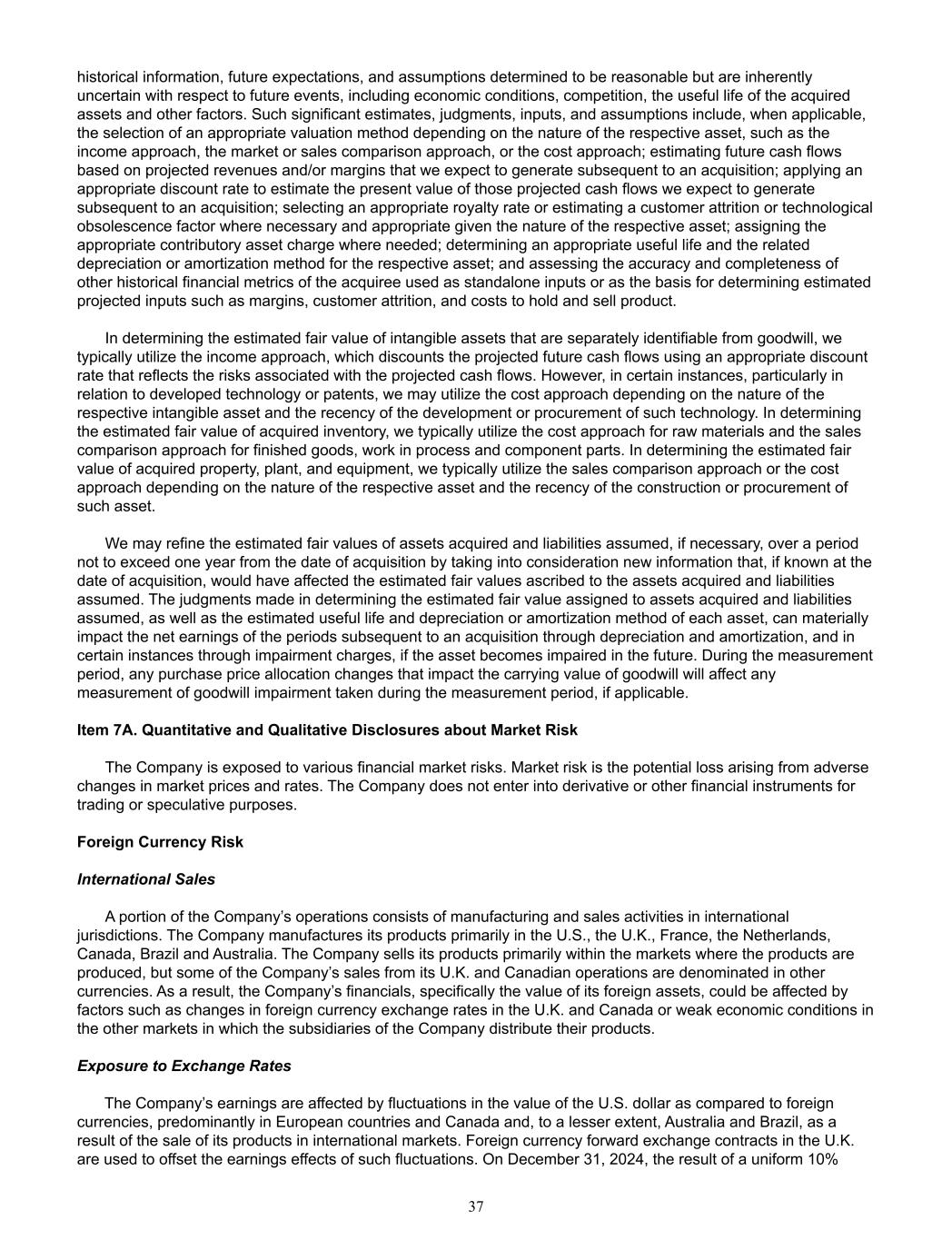
historical information, future expectations, and assumptions determined to be reasonable but are inherently uncertain with respect to future events, including economic conditions, competition, the useful life of the acquired assets and other factors. Such significant estimates, judgments, inputs, and assumptions include, when applicable, the selection of an appropriate valuation method depending on the nature of the respective asset, such as the income approach, the market or sales comparison approach, or the cost approach; estimating future cash flows based on projected revenues and/or margins that we expect to generate subsequent to an acquisition; applying an appropriate discount rate to estimate the present value of those projected cash flows we expect to generate subsequent to an acquisition; selecting an appropriate royalty rate or estimating a customer attrition or technological obsolescence factor where necessary and appropriate given the nature of the respective asset; assigning the appropriate contributory asset charge where needed; determining an appropriate useful life and the related depreciation or amortization method for the respective asset; and assessing the accuracy and completeness of other historical financial metrics of the acquiree used as standalone inputs or as the basis for determining estimated projected inputs such as margins, customer attrition, and costs to hold and sell product. In determining the estimated fair value of intangible assets that are separately identifiable from goodwill, we typically utilize the income approach, which discounts the projected future cash flows using an appropriate discount rate that reflects the risks associated with the projected cash flows. However, in certain instances, particularly in relation to developed technology or patents, we may utilize the cost approach depending on the nature of the respective intangible asset and the recency of the development or procurement of such technology. In determining the estimated fair value of acquired inventory, we typically utilize the cost approach for raw materials and the sales comparison approach for finished goods, work in process and component parts. In determining the estimated fair value of acquired property, plant, and equipment, we typically utilize the sales comparison approach or the cost approach depending on the nature of the respective asset and the recency of the construction or procurement of such asset. We may refine the estimated fair values of assets acquired and liabilities assumed, if necessary, over a period not to exceed one year from the date of acquisition by taking into consideration new information that, if known at the date of acquisition, would have affected the estimated fair values ascribed to the assets acquired and liabilities assumed. The judgments made in determining the estimated fair value assigned to assets acquired and liabilities assumed, as well as the estimated useful life and depreciation or amortization method of each asset, can materially impact the net earnings of the periods subsequent to an acquisition through depreciation and amortization, and in certain instances through impairment charges, if the asset becomes impaired in the future. During the measurement period, any purchase price allocation changes that impact the carrying value of goodwill will affect any measurement of goodwill impairment taken during the measurement period, if applicable. Item 7A. Quantitative and Qualitative Disclosures about Market Risk The Company is exposed to various financial market risks. Market risk is the potential loss arising from adverse changes in market prices and rates. The Company does not enter into derivative or other financial instruments for trading or speculative purposes. Foreign Currency Risk International Sales A portion of the Company’s operations consists of manufacturing and sales activities in international jurisdictions. The Company manufactures its products primarily in the U.S., the U.K., France, the Netherlands, Canada, Brazil and Australia. The Company sells its products primarily within the markets where the products are produced, but some of the Company’s sales from its U.K. and Canadian operations are denominated in other currencies. As a result, the Company’s financials, specifically the value of its foreign assets, could be affected by factors such as changes in foreign currency exchange rates in the U.K. and Canada or weak economic conditions in the other markets in which the subsidiaries of the Company distribute their products. Exposure to Exchange Rates The Company’s earnings are affected by fluctuations in the value of the U.S. dollar as compared to foreign currencies, predominantly in European countries and Canada and, to a lesser extent, Australia and Brazil, as a result of the sale of its products in international markets. Foreign currency forward exchange contracts in the U.K. are used to offset the earnings effects of such fluctuations. On December 31, 2024, the result of a uniform 10% 37

strengthening in the value of the U.S. dollar relative to the currencies in which the Company’s sales are denominated would have been a decrease in gross profit of $13.1 million. Comparatively, on December 31, 2023, the result of a uniform 10% strengthening in the value of the dollar relative to the currencies in which the Company’s sales are denominated would have been a decrease in gross profit of approximately $12.5 million. This calculation assumes that each exchange rate would change in the same direction relative to the U.S. dollar. In addition to the direct effects of changes in exchange rates, which are a changed dollar value of the resulting sales, changes in exchange rates may also affect the volume of sales or the foreign currency sales price as competitors’ products become more or less attractive. The Company’s sensitivity analysis of the effects of changes in foreign currency exchange rates does not factor in a potential change in sales levels or local currency prices. The translation adjustment during 2024 was a loss of $29.0 million. On December 31, 2024, the British pound closed at 0.7991 relative to the U.S. dollar, and the Euro closed at 0.9657 relative to the U.S. dollar. By comparison, on December 31, 2023, the British pound closed at 0.7854 relative to the U.S. dollar, and the Euro closed at 0.9060 relative to the U.S. dollar. No assurance can be given as to future valuation of the British pound or Euro or how further movements in those or other currencies could affect future earnings or the financial position of the Company. Interest Rate Risk The majority of the Company’s long-term debt bears interest at variable rates. However, as discussed below in Note 13. Long-Term Debt, effective August 30, 2024, the Company put in place an interest rate swap that converted the variable interest rate on the Term Facility to a fixed rate of 3.7855% plus an interest margin percentage for the full amount of the outstanding long-term debt for three years. Accordingly, the Company’s net income was affected by changes in interest rates for part of 2024. Assuming the average level of borrowings at variable rates and a two hundred basis point change in the 2024 average interest rate under these borrowings, the Company’s 2024 interest expense would have changed by approximately $5.6 million. In the event of an adverse change in interest rates, management could take actions to mitigate its exposure. Further, this analysis does not consider the effects of the change in the level of overall economic activity that could exist in such an environment. However, challenges affecting the banking industry and credit markets in general can potentially cause changes to credit availability and cost of borrowing, which creates a level of uncertainty. Item 8. Financial Statements and Supplementary Data The financial statements and supplementary data described in Item 15 of this report and included on pages 49 through 83 of this report are incorporated herein by reference. Item 9. Changes in and Disagreements with Accountants on Accounting and Financial Disclosure None. Item 9A. Controls and Procedures Disclosure Controls and Procedures. An evaluation was carried out, under the supervision and with the participation of the Company's management, including our President & Chief Executive Officer and Executive Vice President & Chief Financial Officer (Principal Financial Officer and Principal Accounting Officer), of the effectiveness of the design and operation of our disclosure controls and procedures (as defined in Rule 13a-15(e) under the Securities Exchange Act of 1934). Based upon the evaluation, the President & Chief Executive Officer and Executive Vice President & Chief Financial Officer (Principal Financial Officer and Principal Accounting Officer) concluded that the Company’s disclosure controls and procedures were effective at the end of the period covered by this report. Management’s Annual Report on Internal Control over Financial Reporting. Management’s report on the Company’s internal control over financial reporting is included on page 45 of this Annual Report on Form 10-K and incorporated by reference herein. The Company’s independent registered public accounting firm has audited and issued a report on the Company’s internal control over financial reporting which is included on page 48 of this Annual Report on Form 10-K and incorporated by reference herein. The effectiveness of our internal control over financial reporting as of December 31, 2024 has been audited by KPMG LLP, an independent registered public accounting firm, and the firm’s report on this matter is included in Item 8 of this Annual Report on Form 10-K. 38
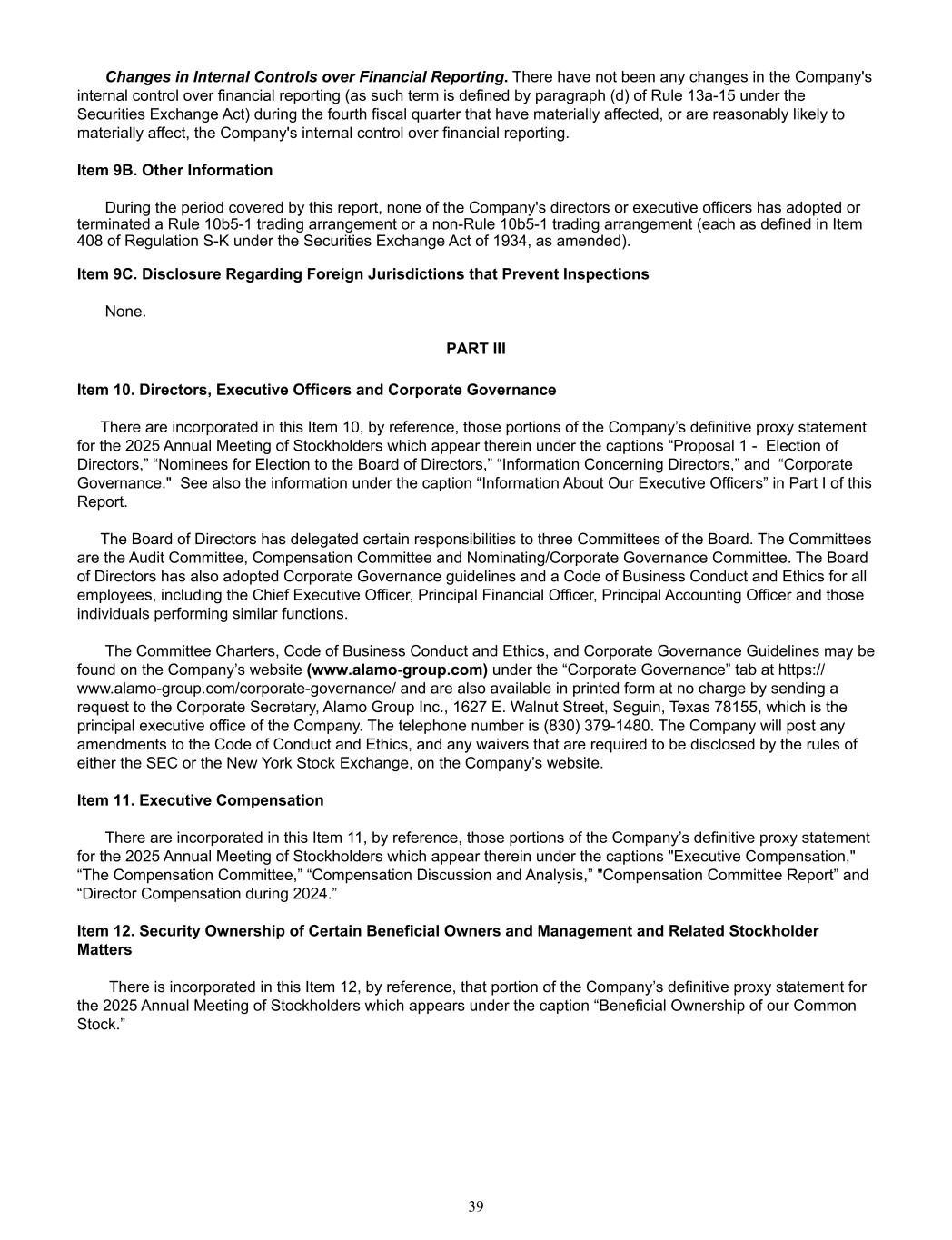
Changes in Internal Controls over Financial Reporting. There have not been any changes in the Company's internal control over financial reporting (as such term is defined by paragraph (d) of Rule 13a-15 under the Securities Exchange Act) during the fourth fiscal quarter that have materially affected, or are reasonably likely to materially affect, the Company's internal control over financial reporting. Item 9B. Other Information During the period covered by this report, none of the Company's directors or executive officers has adopted or terminated a Rule 10b5-1 trading arrangement or a non-Rule 10b5-1 trading arrangement (each as defined in Item 408 of Regulation S-K under the Securities Exchange Act of 1934, as amended). Item 9C. Disclosure Regarding Foreign Jurisdictions that Prevent Inspections None. PART III Item 10. Directors, Executive Officers and Corporate Governance There are incorporated in this Item 10, by reference, those portions of the Company’s definitive proxy statement for the 2025 Annual Meeting of Stockholders which appear therein under the captions “Proposal 1 - Election of Directors,” “Nominees for Election to the Board of Directors,” “Information Concerning Directors,” and “Corporate Governance." See also the information under the caption “Information About Our Executive Officers” in Part I of this Report. The Board of Directors has delegated certain responsibilities to three Committees of the Board. The Committees are the Audit Committee, Compensation Committee and Nominating/Corporate Governance Committee. The Board of Directors has also adopted Corporate Governance guidelines and a Code of Business Conduct and Ethics for all employees, including the Chief Executive Officer, Principal Financial Officer, Principal Accounting Officer and those individuals performing similar functions. The Committee Charters, Code of Business Conduct and Ethics, and Corporate Governance Guidelines may be found on the Company’s website (www.alamo-group.com) under the “Corporate Governance” tab at https:// www.alamo-group.com/corporate-governance/ and are also available in printed form at no charge by sending a request to the Corporate Secretary, Alamo Group Inc., 1627 E. Walnut Street, Seguin, Texas 78155, which is the principal executive office of the Company. The telephone number is (830) 379-1480. The Company will post any amendments to the Code of Conduct and Ethics, and any waivers that are required to be disclosed by the rules of either the SEC or the New York Stock Exchange, on the Company’s website. Item 11. Executive Compensation There are incorporated in this Item 11, by reference, those portions of the Company’s definitive proxy statement for the 2025 Annual Meeting of Stockholders which appear therein under the captions "Executive Compensation," “The Compensation Committee,” “Compensation Discussion and Analysis,” "Compensation Committee Report” and “Director Compensation during 2024.” Item 12. Security Ownership of Certain Beneficial Owners and Management and Related Stockholder Matters There is incorporated in this Item 12, by reference, that portion of the Company’s definitive proxy statement for the 2025 Annual Meeting of Stockholders which appears under the caption “Beneficial Ownership of our Common Stock.” 39
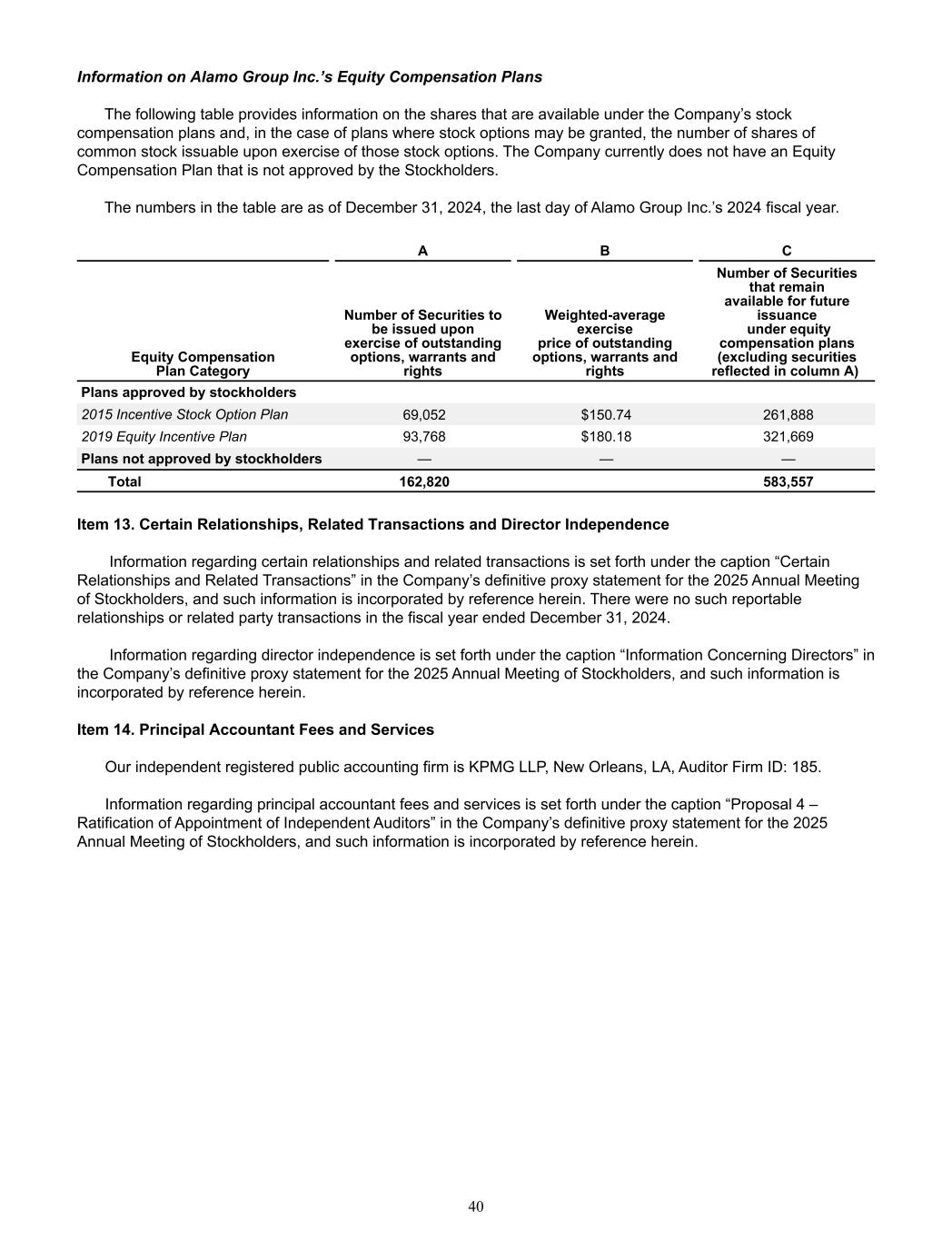
Information on Alamo Group Inc.’s Equity Compensation Plans The following table provides information on the shares that are available under the Company’s stock compensation plans and, in the case of plans where stock options may be granted, the number of shares of common stock issuable upon exercise of those stock options. The Company currently does not have an Equity Compensation Plan that is not approved by the Stockholders. The numbers in the table are as of December 31, 2024, the last day of Alamo Group Inc.’s 2024 fiscal year. A B C Equity Compensation Plan Category Number of Securities to be issued upon exercise of outstanding options, warrants and rights Weighted-average exercise price of outstanding options, warrants and rights Number of Securities that remain available for future issuance under equity compensation plans (excluding securities reflected in column A) Plans approved by stockholders 2015 Incentive Stock Option Plan 69,052 $150.74 261,888 2019 Equity Incentive Plan 93,768 $180.18 321,669 Plans not approved by stockholders — — — Total 162,820 583,557 Item 13. Certain Relationships, Related Transactions and Director Independence Information regarding certain relationships and related transactions is set forth under the caption “Certain Relationships and Related Transactions” in the Company’s definitive proxy statement for the 2025 Annual Meeting of Stockholders, and such information is incorporated by reference herein. There were no such reportable relationships or related party transactions in the fiscal year ended December 31, 2024. Information regarding director independence is set forth under the caption “Information Concerning Directors” in the Company’s definitive proxy statement for the 2025 Annual Meeting of Stockholders, and such information is incorporated by reference herein. Item 14. Principal Accountant Fees and Services Our independent registered public accounting firm is KPMG LLP, New Orleans, LA, Auditor Firm ID: 185. Information regarding principal accountant fees and services is set forth under the caption “Proposal 4 – Ratification of Appointment of Independent Auditors” in the Company’s definitive proxy statement for the 2025 Annual Meeting of Stockholders, and such information is incorporated by reference herein. 40
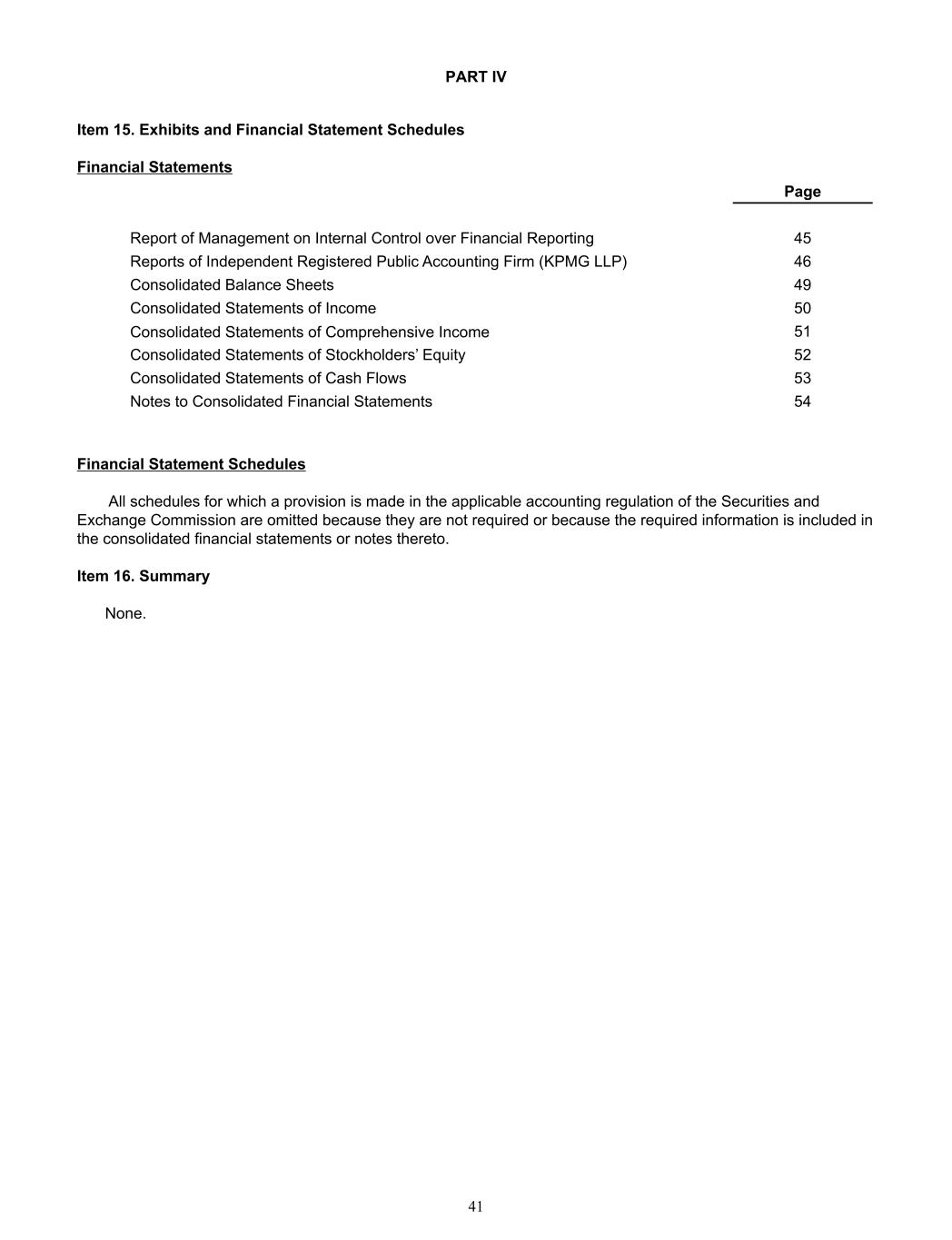
PART IV Item 15. Exhibits and Financial Statement Schedules Financial Statements Page Report of Management on Internal Control over Financial Reporting 45 Reports of Independent Registered Public Accounting Firm (KPMG LLP) 46 Consolidated Balance Sheets 49 Consolidated Statements of Income 50 Consolidated Statements of Comprehensive Income 51 Consolidated Statements of Stockholders’ Equity 52 Consolidated Statements of Cash Flows 53 Notes to Consolidated Financial Statements 54 Financial Statement Schedules All schedules for which a provision is made in the applicable accounting regulation of the Securities and Exchange Commission are omitted because they are not required or because the required information is included in the consolidated financial statements or notes thereto. Item 16. Summary None. 41
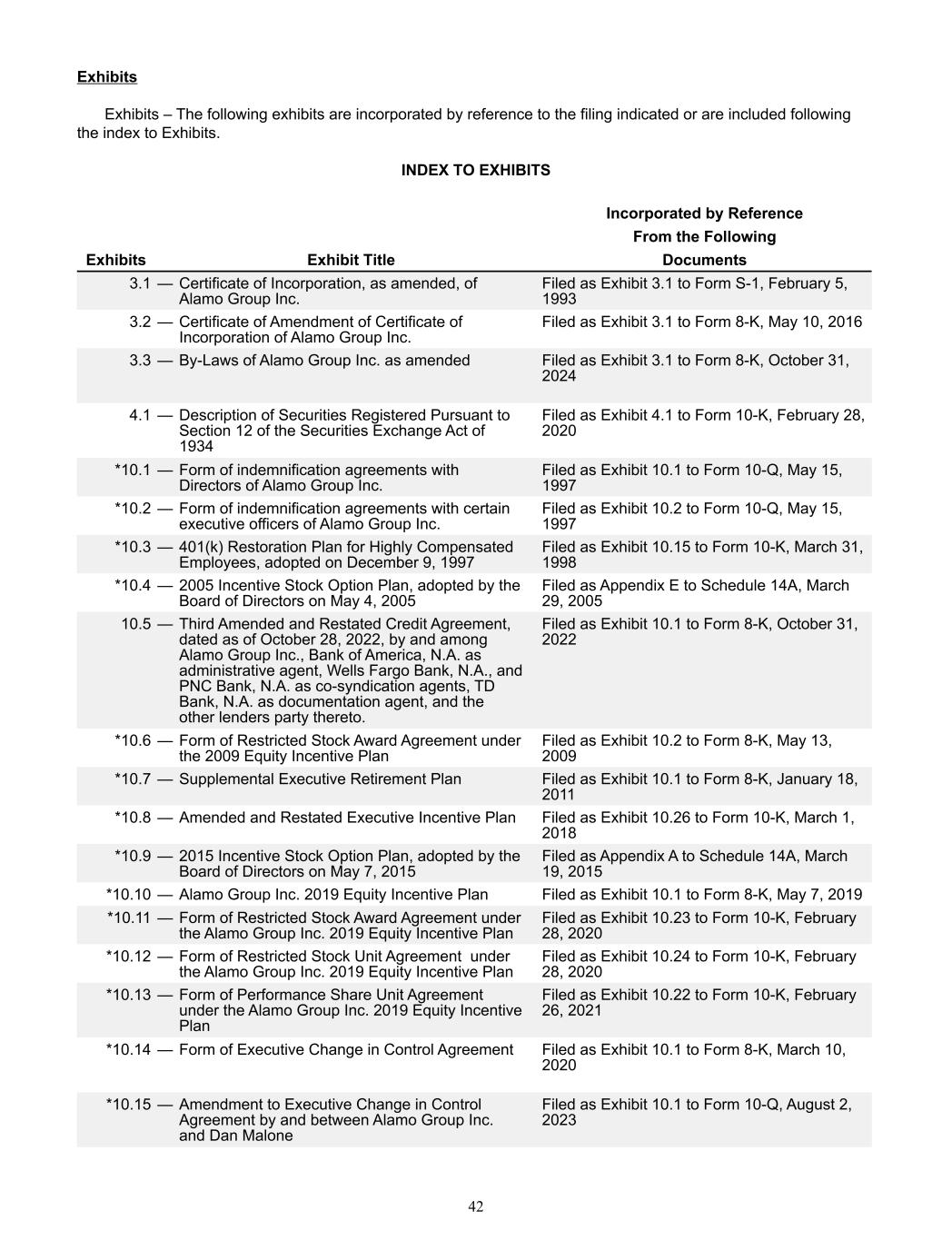
Exhibits Exhibits – The following exhibits are incorporated by reference to the filing indicated or are included following the index to Exhibits. INDEX TO EXHIBITS Incorporated by Reference From the Following Exhibits Exhibit Title Documents 3.1 — Certificate of Incorporation, as amended, of Alamo Group Inc. Filed as Exhibit 3.1 to Form S-1, February 5, 1993 3.2 — Certificate of Amendment of Certificate of Incorporation of Alamo Group Inc. Filed as Exhibit 3.1 to Form 8-K, May 10, 2016 3.3 — By-Laws of Alamo Group Inc. as amended Filed as Exhibit 3.1 to Form 8-K, October 31, 2024 4.1 — Description of Securities Registered Pursuant to Section 12 of the Securities Exchange Act of 1934 Filed as Exhibit 4.1 to Form 10-K, February 28, 2020 *10.1 — Form of indemnification agreements with Directors of Alamo Group Inc. Filed as Exhibit 10.1 to Form 10-Q, May 15, 1997 *10.2 — Form of indemnification agreements with certain executive officers of Alamo Group Inc. Filed as Exhibit 10.2 to Form 10-Q, May 15, 1997 *10.3 — 401(k) Restoration Plan for Highly Compensated Employees, adopted on December 9, 1997 Filed as Exhibit 10.15 to Form 10-K, March 31, 1998 *10.4 — 2005 Incentive Stock Option Plan, adopted by the Board of Directors on May 4, 2005 Filed as Appendix E to Schedule 14A, March 29, 2005 10.5 — Third Amended and Restated Credit Agreement, dated as of October 28, 2022, by and among Alamo Group Inc., Bank of America, N.A. as administrative agent, Wells Fargo Bank, N.A., and PNC Bank, N.A. as co-syndication agents, TD Bank, N.A. as documentation agent, and the other lenders party thereto. Filed as Exhibit 10.1 to Form 8-K, October 31, 2022 *10.6 — Form of Restricted Stock Award Agreement under the 2009 Equity Incentive Plan Filed as Exhibit 10.2 to Form 8-K, May 13, 2009 *10.7 — Supplemental Executive Retirement Plan Filed as Exhibit 10.1 to Form 8-K, January 18, 2011 *10.8 — Amended and Restated Executive Incentive Plan Filed as Exhibit 10.26 to Form 10-K, March 1, 2018 *10.9 — 2015 Incentive Stock Option Plan, adopted by the Board of Directors on May 7, 2015 Filed as Appendix A to Schedule 14A, March 19, 2015 *10.10 — Alamo Group Inc. 2019 Equity Incentive Plan Filed as Exhibit 10.1 to Form 8-K, May 7, 2019 *10.11 — Form of Restricted Stock Award Agreement under the Alamo Group Inc. 2019 Equity Incentive Plan Filed as Exhibit 10.23 to Form 10-K, February 28, 2020 *10.12 — Form of Restricted Stock Unit Agreement under the Alamo Group Inc. 2019 Equity Incentive Plan Filed as Exhibit 10.24 to Form 10-K, February 28, 2020 *10.13 — Form of Performance Share Unit Agreement under the Alamo Group Inc. 2019 Equity Incentive Plan Filed as Exhibit 10.22 to Form 10-K, February 26, 2021 *10.14 — Form of Executive Change in Control Agreement Filed as Exhibit 10.1 to Form 8-K, March 10, 2020 *10.15 — Amendment to Executive Change in Control Agreement by and between Alamo Group Inc. and Dan Malone Filed as Exhibit 10.1 to Form 10-Q, August 2, 2023 42
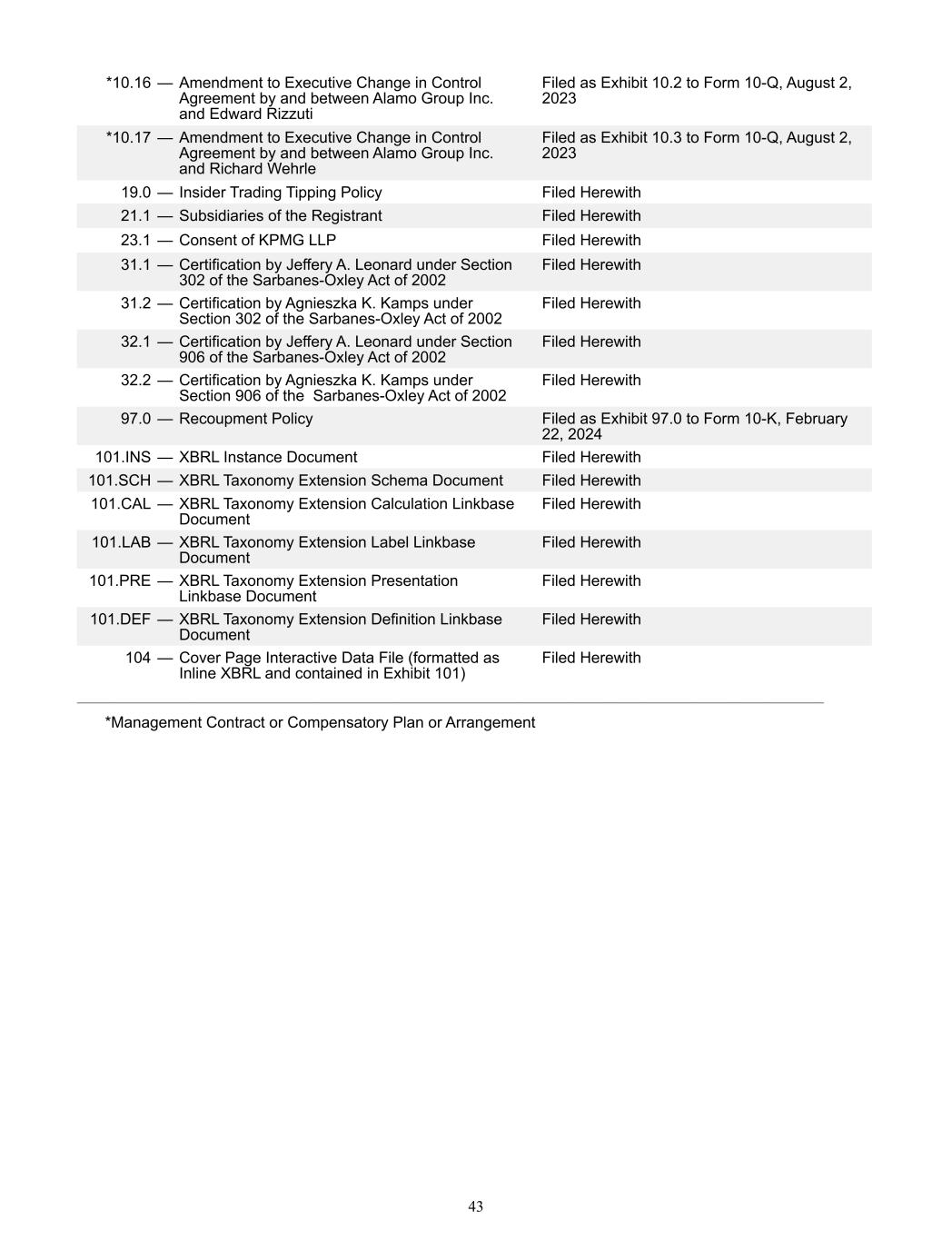
*10.16 — Amendment to Executive Change in Control Agreement by and between Alamo Group Inc. and Edward Rizzuti Filed as Exhibit 10.2 to Form 10-Q, August 2, 2023 *10.17 — Amendment to Executive Change in Control Agreement by and between Alamo Group Inc. and Richard Wehrle Filed as Exhibit 10.3 to Form 10-Q, August 2, 2023 19.0 — Insider Trading Tipping Policy Filed Herewith 21.1 — Subsidiaries of the Registrant Filed Herewith 23.1 — Consent of KPMG LLP Filed Herewith 31.1 — Certification by Jeffery A. Leonard under Section 302 of the Sarbanes-Oxley Act of 2002 Filed Herewith 31.2 — Certification by Agnieszka K. Kamps under Section 302 of the Sarbanes-Oxley Act of 2002 Filed Herewith 32.1 — Certification by Jeffery A. Leonard under Section 906 of the Sarbanes-Oxley Act of 2002 Filed Herewith 32.2 — Certification by Agnieszka K. Kamps under Section 906 of the Sarbanes-Oxley Act of 2002 Filed Herewith 97.0 — Recoupment Policy Filed as Exhibit 97.0 to Form 10-K, February 22, 2024 101.INS — XBRL Instance Document Filed Herewith 101.SCH — XBRL Taxonomy Extension Schema Document Filed Herewith 101.CAL — XBRL Taxonomy Extension Calculation Linkbase Document Filed Herewith 101.LAB — XBRL Taxonomy Extension Label Linkbase Document Filed Herewith 101.PRE — XBRL Taxonomy Extension Presentation Linkbase Document Filed Herewith 101.DEF — XBRL Taxonomy Extension Definition Linkbase Document Filed Herewith 104 — Cover Page Interactive Data File (formatted as Inline XBRL and contained in Exhibit 101) Filed Herewith ________________________________________________________________________________________________________________________ *Management Contract or Compensatory Plan or Arrangement 43
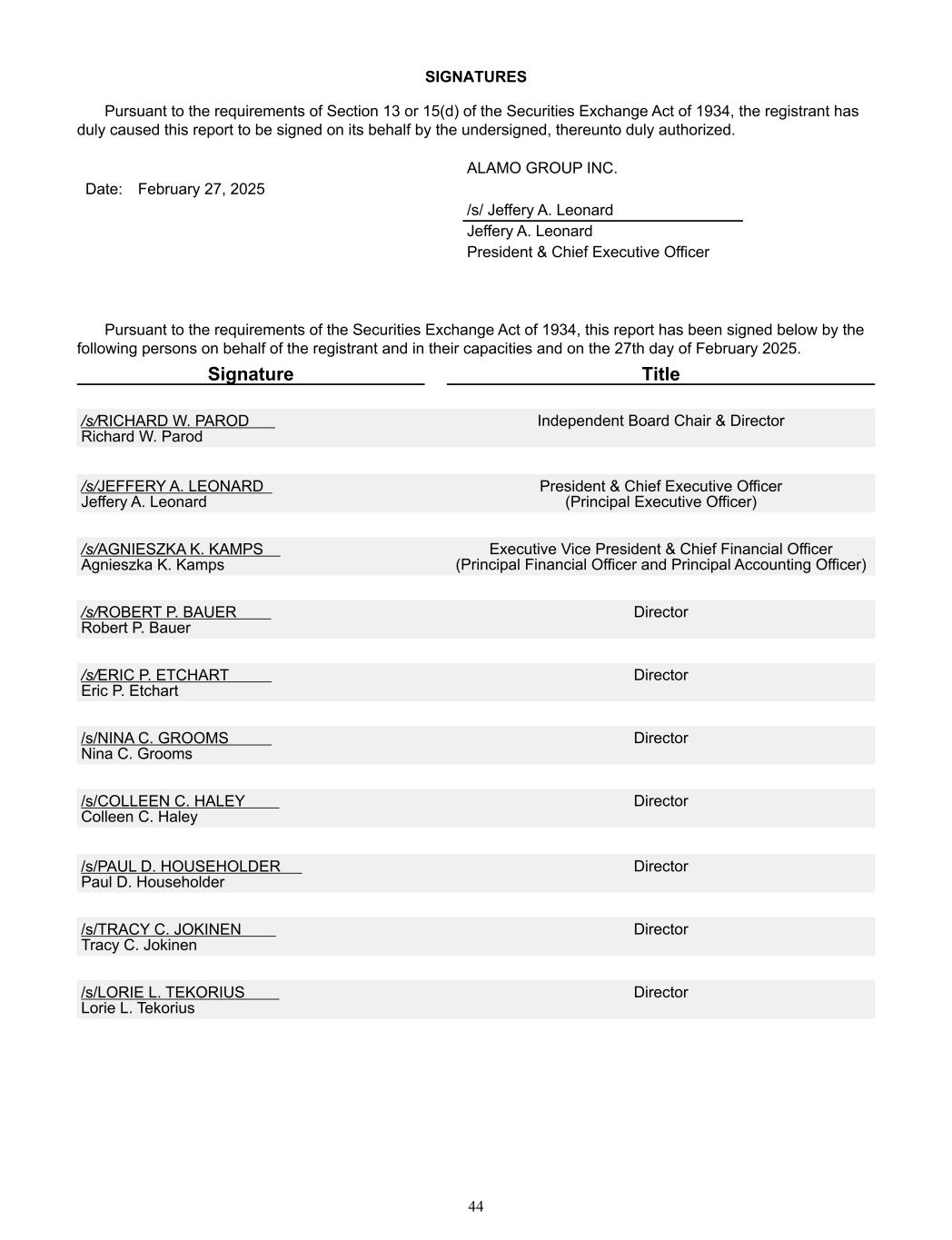
SIGNATURES Pursuant to the requirements of Section 13 or 15(d) of the Securities Exchange Act of 1934, the registrant has duly caused this report to be signed on its behalf by the undersigned, thereunto duly authorized. ALAMO GROUP INC. Date: February 27, 2025 /s/ Jeffery A. Leonard Jeffery A. Leonard President & Chief Executive Officer Pursuant to the requirements of the Securities Exchange Act of 1934, this report has been signed below by the following persons on behalf of the registrant and in their capacities and on the 27th day of February 2025. Signature Title /s/RICHARD W. PAROD Richard W. Parod Independent Board Chair & Director /s/JEFFERY A. LEONARD Jeffery A. Leonard President & Chief Executive Officer (Principal Executive Officer) /s/AGNIESZKA K. KAMPS Agnieszka K. Kamps Executive Vice President & Chief Financial Officer (Principal Financial Officer and Principal Accounting Officer) /s/ROBERT P. BAUER Robert P. Bauer Director /s/ERIC P. ETCHART Eric P. Etchart Director /s/NINA C. GROOMS Nina C. Grooms Director /s/COLLEEN C. HALEY Colleen C. Haley Director /s/PAUL D. HOUSEHOLDER Paul D. Householder Director /s/TRACY C. JOKINEN Tracy C. Jokinen Director /s/LORIE L. TEKORIUS Lorie L. Tekorius Director 44
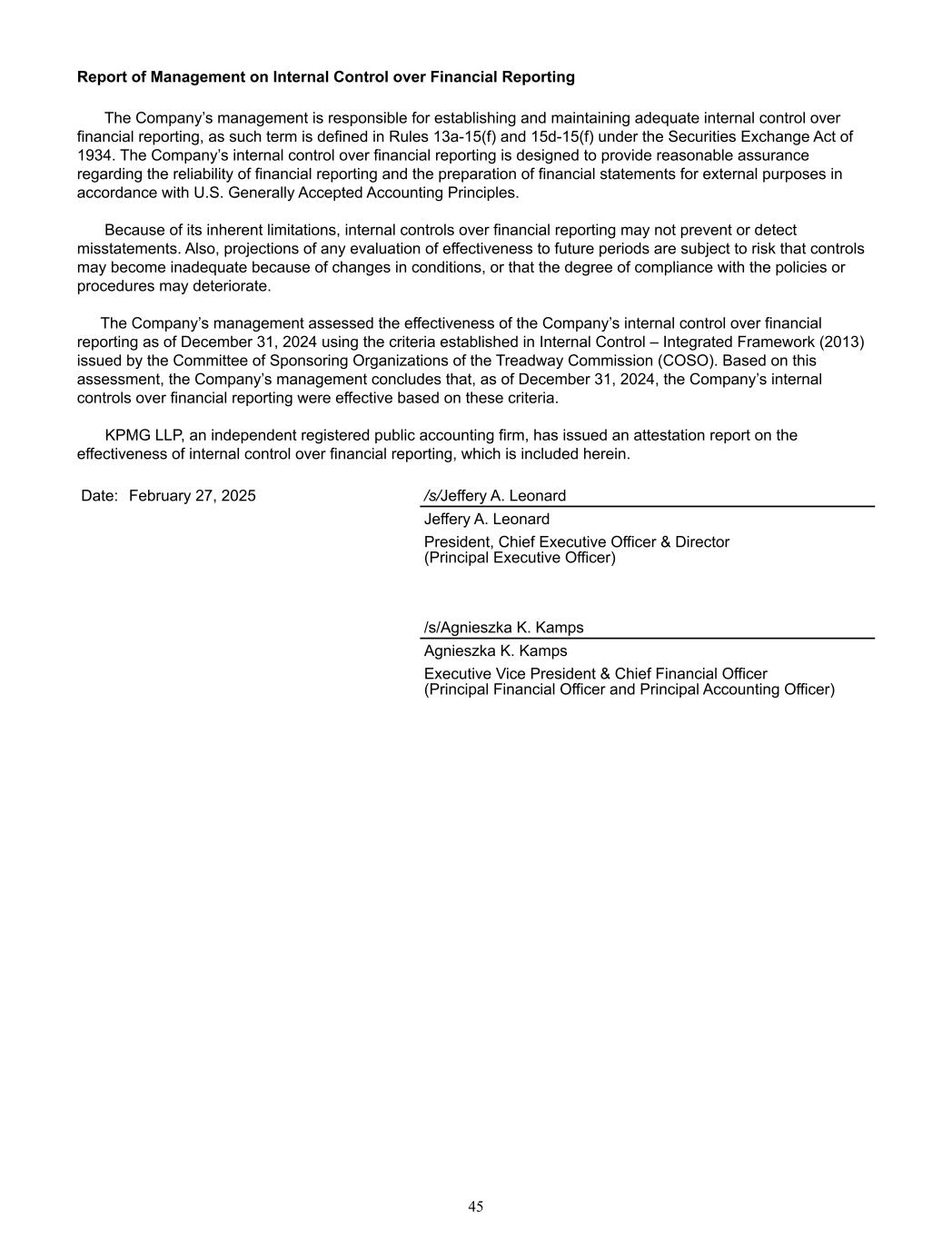
Report of Management on Internal Control over Financial Reporting The Company’s management is responsible for establishing and maintaining adequate internal control over financial reporting, as such term is defined in Rules 13a-15(f) and 15d-15(f) under the Securities Exchange Act of 1934. The Company’s internal control over financial reporting is designed to provide reasonable assurance regarding the reliability of financial reporting and the preparation of financial statements for external purposes in accordance with U.S. Generally Accepted Accounting Principles. Because of its inherent limitations, internal controls over financial reporting may not prevent or detect misstatements. Also, projections of any evaluation of effectiveness to future periods are subject to risk that controls may become inadequate because of changes in conditions, or that the degree of compliance with the policies or procedures may deteriorate. The Company’s management assessed the effectiveness of the Company’s internal control over financial reporting as of December 31, 2024 using the criteria established in Internal Control – Integrated Framework (2013) issued by the Committee of Sponsoring Organizations of the Treadway Commission (COSO). Based on this assessment, the Company’s management concludes that, as of December 31, 2024, the Company’s internal controls over financial reporting were effective based on these criteria. KPMG LLP, an independent registered public accounting firm, has issued an attestation report on the effectiveness of internal control over financial reporting, which is included herein. Date: February 27, 2025 /s/Jeffery A. Leonard Jeffery A. Leonard President, Chief Executive Officer & Director (Principal Executive Officer) /s/Agnieszka K. Kamps Agnieszka K. Kamps Executive Vice President & Chief Financial Officer (Principal Financial Officer and Principal Accounting Officer) 45

Report of Independent Registered Public Accounting Firm To the Stockholders and the Board of Directors Alamo Group Inc.: Opinion on the Consolidated Financial Statements We have audited the accompanying consolidated balance sheets of Alamo Group Inc. and subsidiaries (the Company) as of December 31, 2024 and 2023, the related consolidated statements of income, comprehensive income, stockholders’ equity, and cash flows for each of the years in the three-year period ended December 31, 2024, and the related notes (collectively, the consolidated financial statements). In our opinion, the consolidated financial statements present fairly, in all material respects, the financial position of the Company as of December 31, 2024 and 2023, and the results of its operations and its cash flows for each of the years in the three-year period ended December 31, 2024, in conformity with U.S. generally accepted accounting principles. We also have audited, in accordance with the standards of the Public Company Accounting Oversight Board (United States) (PCAOB), the Company’s internal control over financial reporting as of December 31, 2024, based on criteria established in Internal Control – Integrated Framework (2013) issued by the Committee of Sponsoring Organizations of the Treadway Commission, and our report dated February 27, 2025 expressed an unqualified opinion on the effectiveness of the Company’s internal control over financial reporting. Basis for Opinion These consolidated financial statements are the responsibility of the Company’s management. Our responsibility is to express an opinion on these consolidated financial statements based on our audits. We are a public accounting firm registered with the PCAOB and are required to be independent with respect to the Company in accordance with the U.S. federal securities laws and the applicable rules and regulations of the Securities and Exchange Commission and the PCAOB. We conducted our audits in accordance with the standards of the PCAOB. Those standards require that we plan and perform the audit to obtain reasonable assurance about whether the consolidated financial statements are free of material misstatement, whether due to error or fraud. Our audits included performing procedures to assess the risks of material misstatement of the consolidated financial statements, whether due to error or fraud, and performing procedures that respond to those risks. Such procedures included examining, on a test basis, evidence regarding the amounts and disclosures in the consolidated financial statements. Our audits also included evaluating the accounting principles used and significant estimates made by management, as well as evaluating the overall presentation of the consolidated financial statements. We believe that our audits provide a reasonable basis for our opinion. Critical Audit Matter The critical audit matter communicated below is a matter arising from the current period audit of the consolidated financial statements that was communicated or required to be communicated to the audit committee and that: (1) relates to accounts or disclosures that are material to the consolidated financial statements and (2) involved our especially challenging, subjective, or complex judgments. The communication of a critical audit matter does not alter in any way our opinion on the consolidated financial statements, taken as a whole, and we are not, by communicating the critical audit matter below, providing a separate opinion on the critical audit matter or on the accounts or disclosures to which it relates. Sufficiency of evidence over the existence of inventory As discussed in Note 6 to the consolidated financial statements, the value of inventory was $343 million as of December 31, 2024. To facilitate the global delivery of goods to customers, the Company operates across North America, South America, Europe and Australia. Within these locations, the Company has 27 principal manufacturing plants located in six countries. We identified the assessment of the sufficiency of evidence over the existence of inventory as a critical audit matter. The geographical dispersion of inventory required especially subjective auditor judgment in determining the sufficiency of audit evidence obtained over the existence of inventory. The following are the primary procedures we performed to address this critical audit matter. We applied auditor judgment to determine the nature and extent of procedures to be performed over the existence of inventory including determining where we would perform procedures. We evaluated the design and tested 46
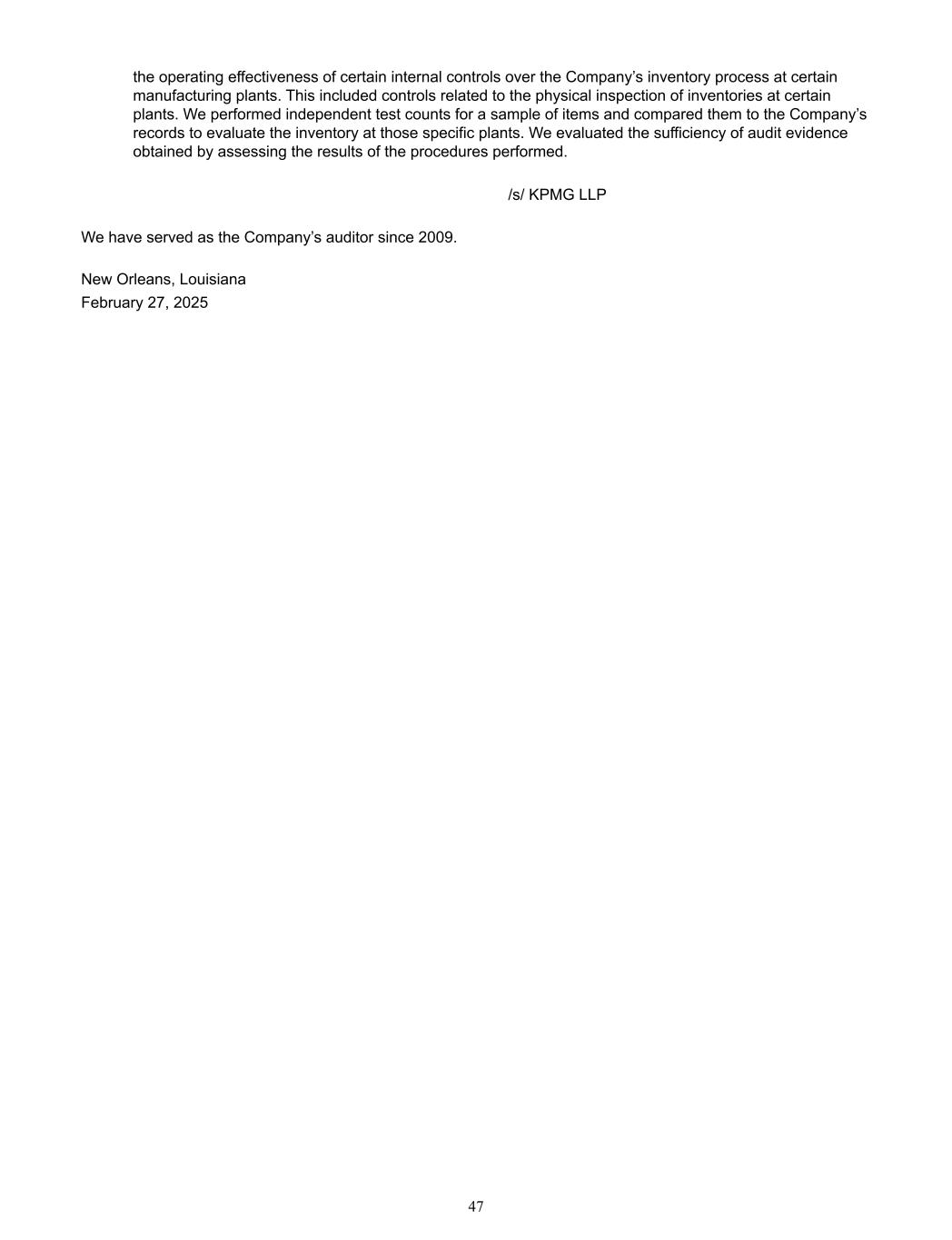
the operating effectiveness of certain internal controls over the Company’s inventory process at certain manufacturing plants. This included controls related to the physical inspection of inventories at certain plants. We performed independent test counts for a sample of items and compared them to the Company’s records to evaluate the inventory at those specific plants. We evaluated the sufficiency of audit evidence obtained by assessing the results of the procedures performed. /s/ KPMG LLP We have served as the Company’s auditor since 2009. New Orleans, Louisiana February 27, 2025 47
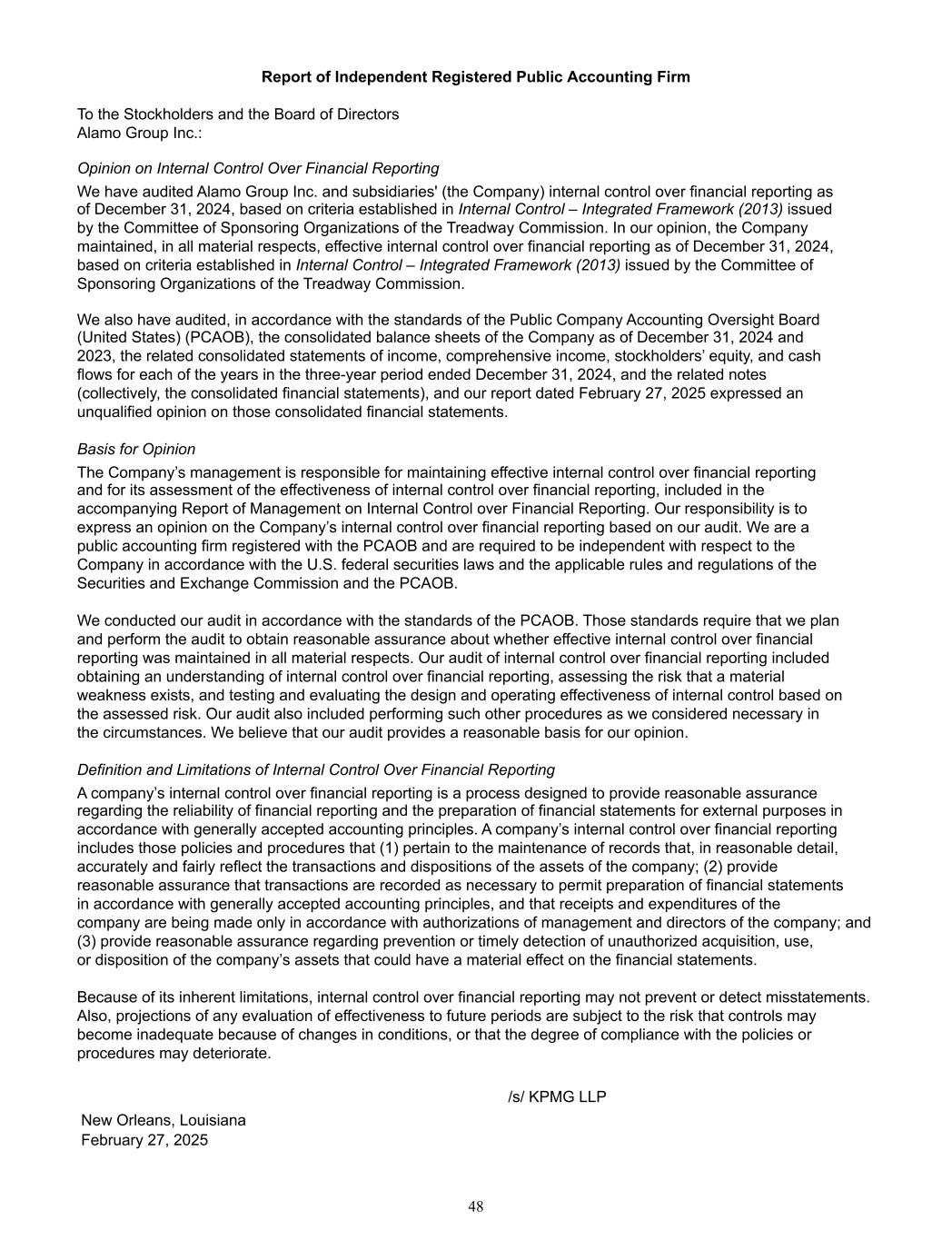
Report of Independent Registered Public Accounting Firm To the Stockholders and the Board of Directors Alamo Group Inc.: Opinion on Internal Control Over Financial Reporting We have audited Alamo Group Inc. and subsidiaries' (the Company) internal control over financial reporting as of December 31, 2024, based on criteria established in Internal Control – Integrated Framework (2013) issued by the Committee of Sponsoring Organizations of the Treadway Commission. In our opinion, the Company maintained, in all material respects, effective internal control over financial reporting as of December 31, 2024, based on criteria established in Internal Control – Integrated Framework (2013) issued by the Committee of Sponsoring Organizations of the Treadway Commission. We also have audited, in accordance with the standards of the Public Company Accounting Oversight Board (United States) (PCAOB), the consolidated balance sheets of the Company as of December 31, 2024 and 2023, the related consolidated statements of income, comprehensive income, stockholders’ equity, and cash flows for each of the years in the three-year period ended December 31, 2024, and the related notes (collectively, the consolidated financial statements), and our report dated February 27, 2025 expressed an unqualified opinion on those consolidated financial statements. Basis for Opinion The Company’s management is responsible for maintaining effective internal control over financial reporting and for its assessment of the effectiveness of internal control over financial reporting, included in the accompanying Report of Management on Internal Control over Financial Reporting. Our responsibility is to express an opinion on the Company’s internal control over financial reporting based on our audit. We are a public accounting firm registered with the PCAOB and are required to be independent with respect to the Company in accordance with the U.S. federal securities laws and the applicable rules and regulations of the Securities and Exchange Commission and the PCAOB. We conducted our audit in accordance with the standards of the PCAOB. Those standards require that we plan and perform the audit to obtain reasonable assurance about whether effective internal control over financial reporting was maintained in all material respects. Our audit of internal control over financial reporting included obtaining an understanding of internal control over financial reporting, assessing the risk that a material weakness exists, and testing and evaluating the design and operating effectiveness of internal control based on the assessed risk. Our audit also included performing such other procedures as we considered necessary in the circumstances. We believe that our audit provides a reasonable basis for our opinion. Definition and Limitations of Internal Control Over Financial Reporting A company’s internal control over financial reporting is a process designed to provide reasonable assurance regarding the reliability of financial reporting and the preparation of financial statements for external purposes in accordance with generally accepted accounting principles. A company’s internal control over financial reporting includes those policies and procedures that (1) pertain to the maintenance of records that, in reasonable detail, accurately and fairly reflect the transactions and dispositions of the assets of the company; (2) provide reasonable assurance that transactions are recorded as necessary to permit preparation of financial statements in accordance with generally accepted accounting principles, and that receipts and expenditures of the company are being made only in accordance with authorizations of management and directors of the company; and (3) provide reasonable assurance regarding prevention or timely detection of unauthorized acquisition, use, or disposition of the company’s assets that could have a material effect on the financial statements. Because of its inherent limitations, internal control over financial reporting may not prevent or detect misstatements. Also, projections of any evaluation of effectiveness to future periods are subject to the risk that controls may become inadequate because of changes in conditions, or that the degree of compliance with the policies or procedures may deteriorate. /s/ KPMG LLP New Orleans, Louisiana February 27, 2025 48
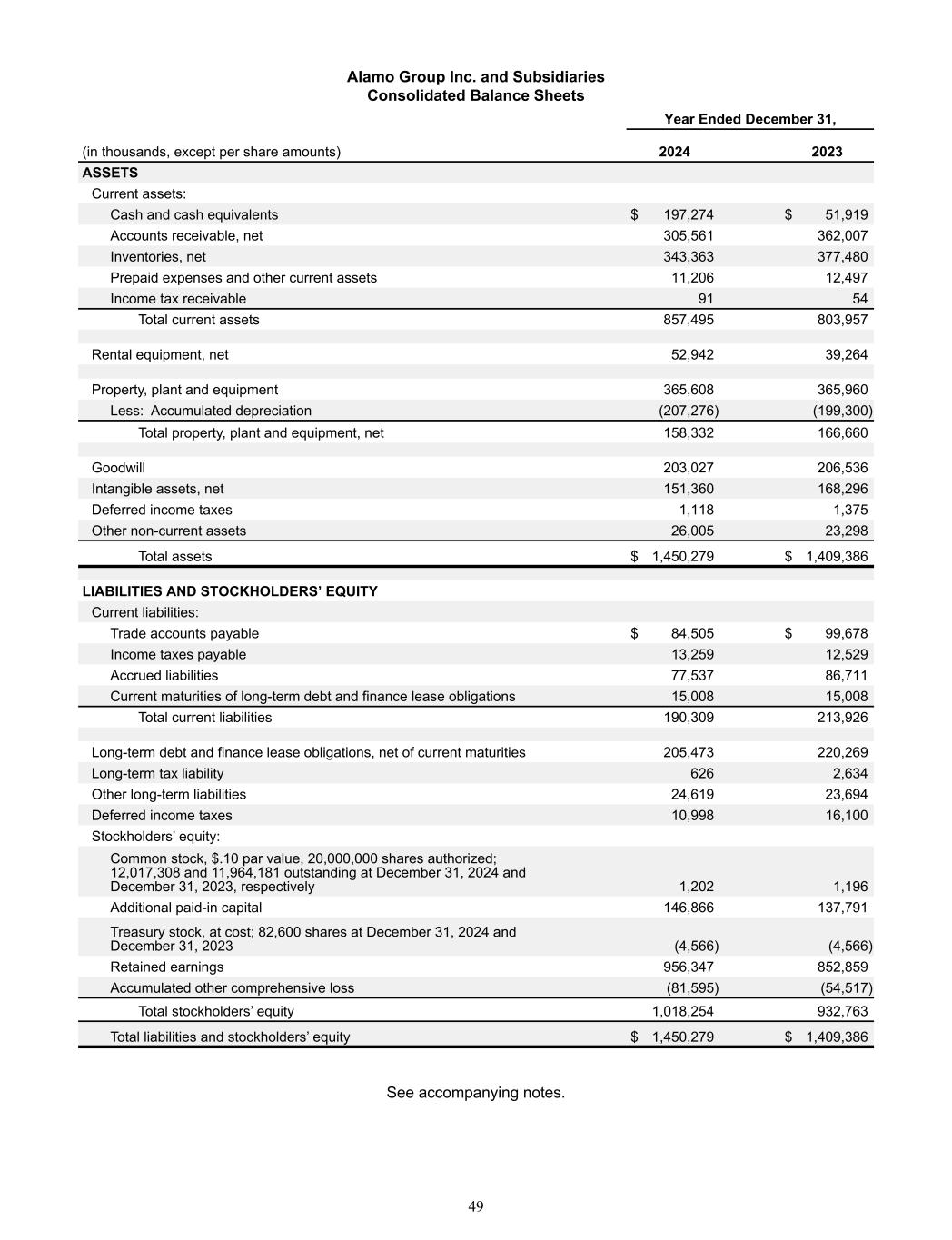
Alamo Group Inc. and Subsidiaries Consolidated Balance Sheets Year Ended December 31, (in thousands, except per share amounts) 2024 2023 ASSETS Current assets: Cash and cash equivalents $ 197,274 $ 51,919 Accounts receivable, net 305,561 362,007 Inventories, net 343,363 377,480 Prepaid expenses and other current assets 11,206 12,497 Income tax receivable 91 54 Total current assets 857,495 803,957 Rental equipment, net 52,942 39,264 Property, plant and equipment 365,608 365,960 Less: Accumulated depreciation (207,276) (199,300) Total property, plant and equipment, net 158,332 166,660 Goodwill 203,027 206,536 Intangible assets, net 151,360 168,296 Deferred income taxes 1,118 1,375 Other non-current assets 26,005 23,298 Total assets $ 1,450,279 $ 1,409,386 LIABILITIES AND STOCKHOLDERS’ EQUITY Current liabilities: Trade accounts payable $ 84,505 $ 99,678 Income taxes payable 13,259 12,529 Accrued liabilities 77,537 86,711 Current maturities of long-term debt and finance lease obligations 15,008 15,008 Total current liabilities 190,309 213,926 Long-term debt and finance lease obligations, net of current maturities 205,473 220,269 Long-term tax liability 626 2,634 Other long-term liabilities 24,619 23,694 Deferred income taxes 10,998 16,100 Stockholders’ equity: Common stock, $.10 par value, 20,000,000 shares authorized; 12,017,308 and 11,964,181 outstanding at December 31, 2024 and December 31, 2023, respectively 1,202 1,196 Additional paid-in capital 146,866 137,791 Treasury stock, at cost; 82,600 shares at December 31, 2024 and December 31, 2023 (4,566) (4,566) Retained earnings 956,347 852,859 Accumulated other comprehensive loss (81,595) (54,517) Total stockholders’ equity 1,018,254 932,763 Total liabilities and stockholders’ equity $ 1,450,279 $ 1,409,386 See accompanying notes. 49

Alamo Group Inc. and Subsidiaries Consolidated Statements of Income Year Ended December 31, (in thousands, except per share amounts) 2024 2023 2022 Net sales: Vegetation Management $ 785,199 $ 979,040 $ 937,065 Industrial Equipment 843,314 710,611 576,551 Total net sales 1,628,513 1,689,651 1,513,616 Cost of sales 1,216,025 1,236,007 1,137,098 Gross profit 412,488 453,644 376,518 Selling, general and administrative expenses 231,453 240,158 212,649 Amortization expense 16,227 15,519 15,277 Income from operations 164,808 197,967 148,592 Interest expense (20,548) (26,093) (14,361) Interest income 2,637 1,485 752 Other income (expense) 2,731 1,761 (673) Income before income taxes 149,628 175,120 134,310 Provision for income taxes 33,698 38,959 32,382 Net income $ 115,930 $ 136,161 $ 101,928 Net income per common share: Basic $ 9.69 $ 11.42 $ 8.58 Diluted $ 9.63 $ 11.36 $ 8.54 Average common shares: Basic 11,968 11,920 11,877 Diluted 12,037 11,987 11,934 See accompanying notes. 50
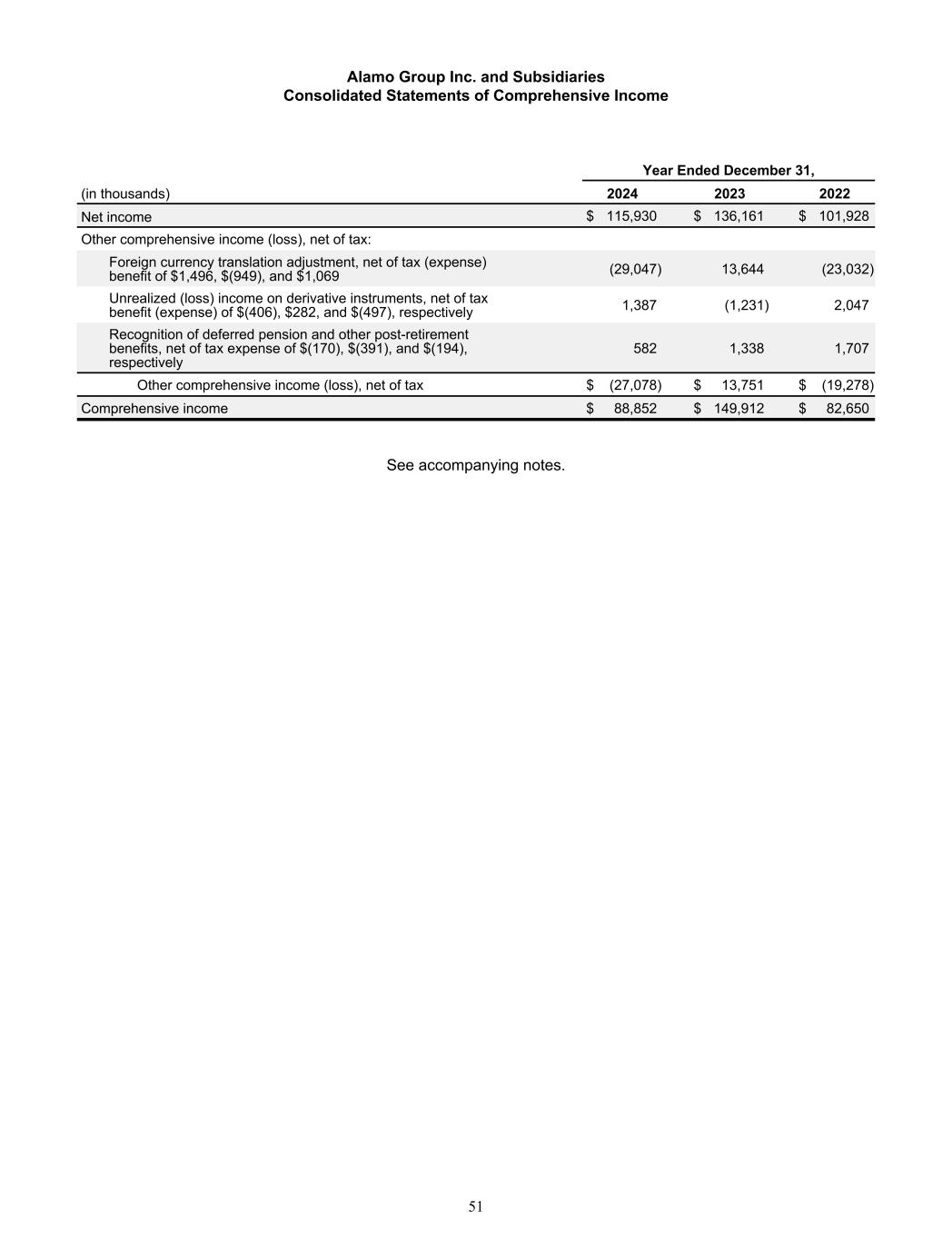
Alamo Group Inc. and Subsidiaries Consolidated Statements of Comprehensive Income Year Ended December 31, (in thousands) 2024 2023 2022 Net income $ 115,930 $ 136,161 $ 101,928 Other comprehensive income (loss), net of tax: Foreign currency translation adjustment, net of tax (expense) benefit of $1,496, $(949), and $1,069 (29,047) 13,644 (23,032) Unrealized (loss) income on derivative instruments, net of tax benefit (expense) of $(406), $282, and $(497), respectively 1,387 (1,231) 2,047 Recognition of deferred pension and other post-retirement benefits, net of tax expense of $(170), $(391), and $(194), respectively 582 1,338 1,707 Other comprehensive income (loss), net of tax $ (27,078) $ 13,751 $ (19,278) Comprehensive income $ 88,852 $ 149,912 $ 82,650 See accompanying notes. 51
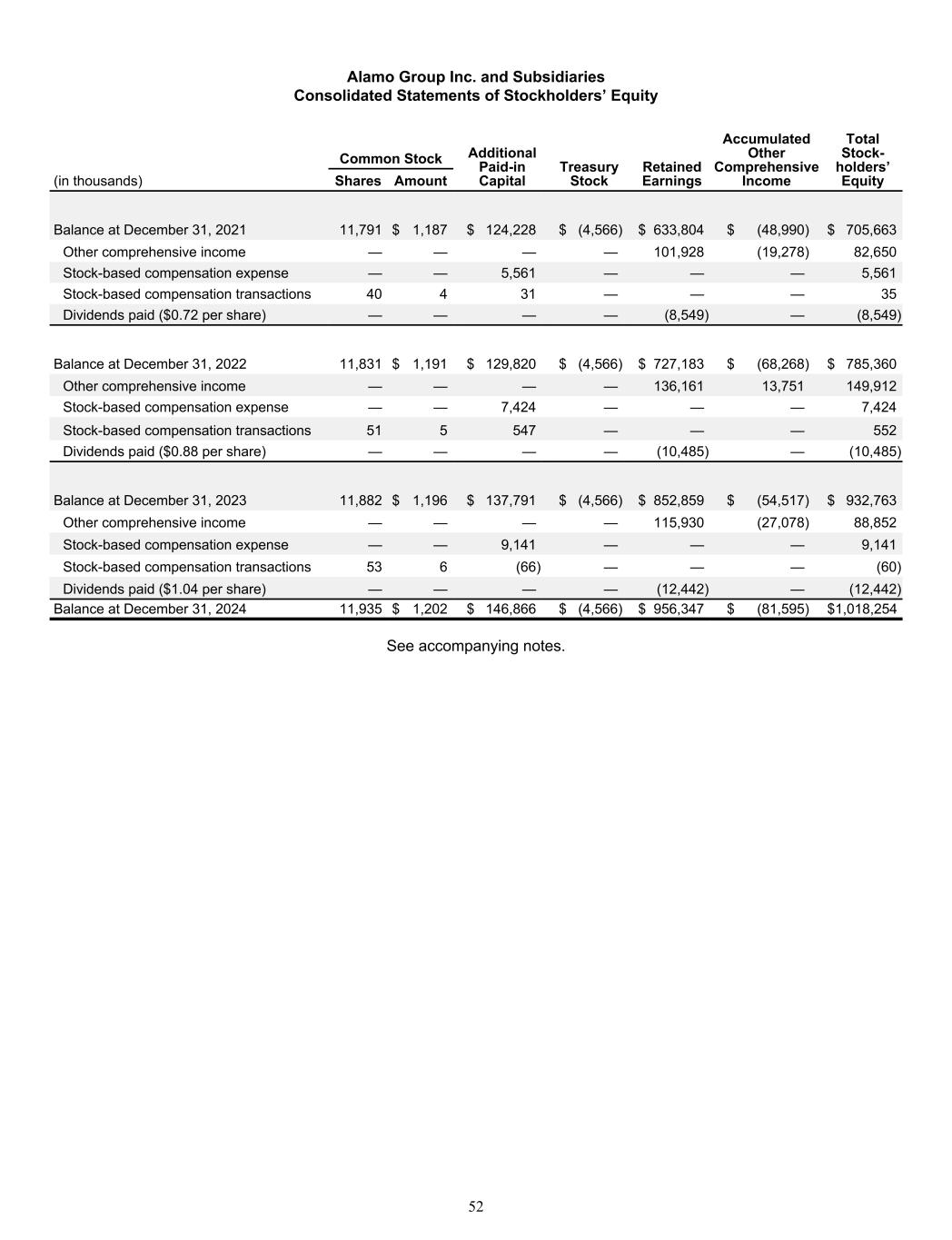
Alamo Group Inc. and Subsidiaries Consolidated Statements of Stockholders’ Equity Common Stock Additional Paid-in Capital Treasury Stock Retained Earnings Accumulated Other Comprehensive Income Total Stock- holders’ Equity(in thousands) Shares Amount Balance at December 31, 2021 11,791 $ 1,187 $ 124,228 $ (4,566) $ 633,804 $ (48,990) $ 705,663 Other comprehensive income — — — — 101,928 (19,278) 82,650 Stock-based compensation expense — — 5,561 — — — 5,561 Stock-based compensation transactions 40 4 31 — — — 35 Dividends paid ($0.72 per share) — — — — (8,549) — (8,549) Balance at December 31, 2022 11,831 $ 1,191 $ 129,820 $ (4,566) $ 727,183 $ (68,268) $ 785,360 Other comprehensive income — — — — 136,161 13,751 149,912 Stock-based compensation expense — — 7,424 — — — 7,424 Stock-based compensation transactions 51 5 547 — — — 552 Dividends paid ($0.88 per share) — — — — (10,485) — (10,485) Balance at December 31, 2023 11,882 $ 1,196 $ 137,791 $ (4,566) $ 852,859 $ (54,517) $ 932,763 Other comprehensive income — — — — 115,930 (27,078) 88,852 Stock-based compensation expense — — 9,141 — — — 9,141 Stock-based compensation transactions 53 6 (66) — — — (60) Dividends paid ($1.04 per share) — — — — (12,442) — (12,442) Balance at December 31, 2024 11,935 $ 1,202 $ 146,866 $ (4,566) $ 956,347 $ (81,595) $ 1,018,254 See accompanying notes. 52

Alamo Group Inc. and Subsidiaries Consolidated Statements of Cash Flows Year Ended December 31, (in thousands) 2024 2023 2022 Operating Activities Net income $ 115,930 $ 136,161 $ 101,928 Adjustments to reconcile net income to cash provided by operating activities: Provision for doubtful accounts 1,718 253 424 Depreciation - PP&E 26,865 23,665 23,673 Depreciation - Rental 9,992 8,789 7,739 Amortization of intangibles 16,227 15,519 15,277 Amortization of debt issuance 703 703 667 Stock-based compensation expense 9,141 7,424 5,561 Provision for deferred income tax benefit (3,607) (4,253) (2,337) Gain on sale of property, plant and equipment (639) (6,621) (161) Changes in operating assets and liabilities, net of acquisitions: Accounts receivable 47,012 (35,293) (85,055) Inventories 26,494 (10,844) (37,739) Rental equipment (23,830) (13,930) (9,196) Prepaid expenses and other (2,608) (835) (6,146) Trade accounts payable and accrued liabilities (15,673) 4,813 (2,879) Income taxes payable 1,000 6,705 2,934 Long term tax payable (2,007) (1,147) (635) Other assets and liabilities, net 3,060 45 475 Net cash provided by operating activities 209,778 131,154 14,530 Investing Activities Acquisitions, net of cash acquired — (27,560) (2,000) Purchase of property, plant and equipment (24,993) (37,745) (31,141) Proceeds from sale of property, plant and equipment 3,045 12,682 1,566 Purchase of patents (233) — (163) Net cash used in investing activities (22,181) (52,623) (31,738) Financing Activities Borrowings on bank revolving credit facility 195,000 183,000 222,000 Repayment on bank revolving credit facility (195,000) (235,000) (174,000) Principal payments on long-term debt and capital leases (15,069) (14,948) (15,031) Contingent consideration payment after acquisition (4,402) — — Dividends paid (12,442) (10,485) (8,549) Proceeds from exercise of stock options 1,912 1,586 803 Common stock repurchased (1,972) (1,034) (768) Net cash (used in) provided by financing activities (31,973) (76,881) 24,455 Effect of exchange rate changes on cash (10,269) 3,253 (2,346) Net change in cash and cash equivalents 145,355 4,903 4,901 Cash and cash equivalents at beginning of the year 51,919 47,016 42,115 Cash and cash equivalents at end of the year $ 197,274 $ 51,919 $ 47,016 Cash paid during the year for: Interest $ 20,787 $ 25,358 $ 14,575 Income taxes $ 40,426 $ 37,330 $ 35,102 See accompanying notes. 53
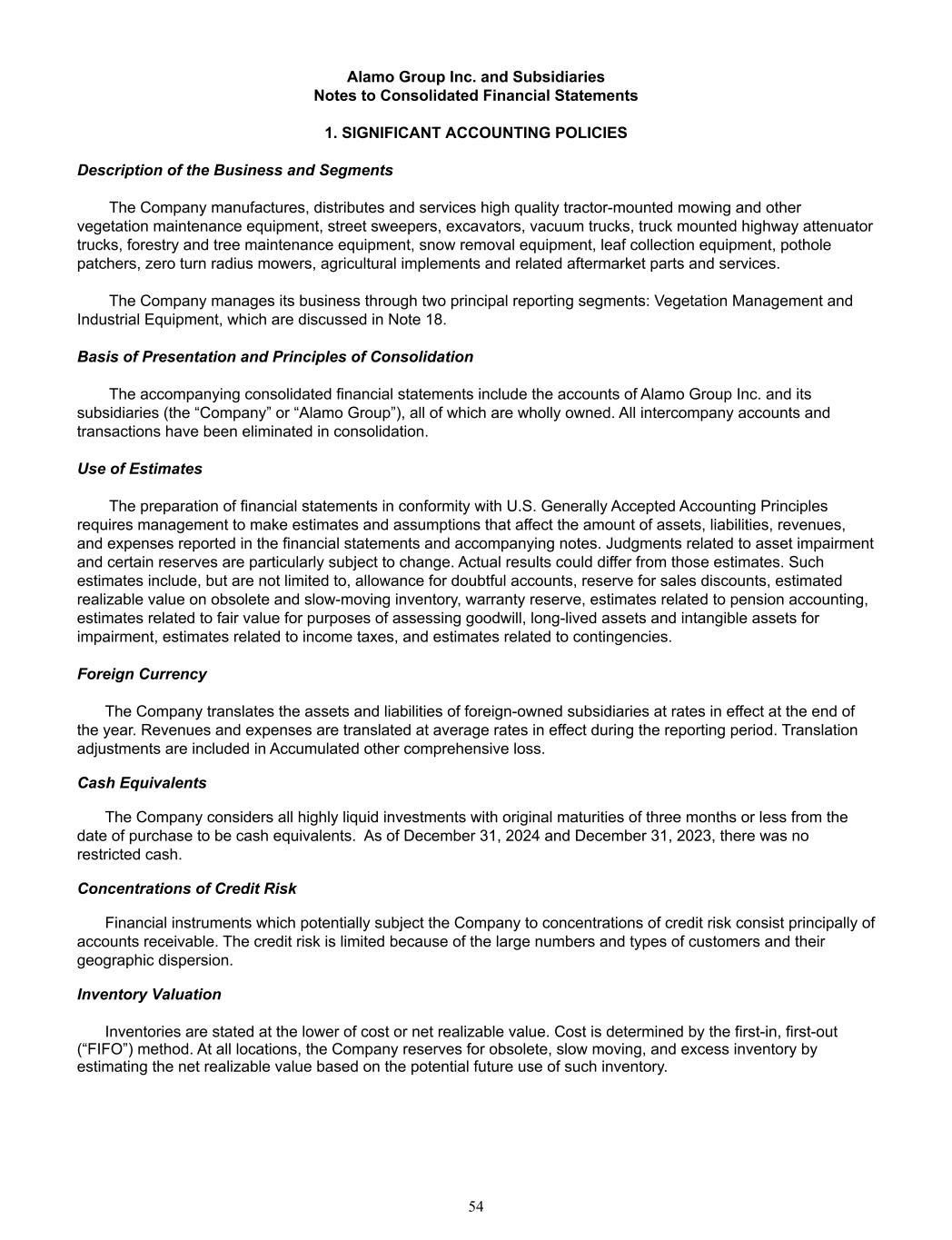
Alamo Group Inc. and Subsidiaries Notes to Consolidated Financial Statements 1. SIGNIFICANT ACCOUNTING POLICIES Description of the Business and Segments The Company manufactures, distributes and services high quality tractor-mounted mowing and other vegetation maintenance equipment, street sweepers, excavators, vacuum trucks, truck mounted highway attenuator trucks, forestry and tree maintenance equipment, snow removal equipment, leaf collection equipment, pothole patchers, zero turn radius mowers, agricultural implements and related aftermarket parts and services. The Company manages its business through two principal reporting segments: Vegetation Management and Industrial Equipment, which are discussed in Note 18. Basis of Presentation and Principles of Consolidation The accompanying consolidated financial statements include the accounts of Alamo Group Inc. and its subsidiaries (the “Company” or “Alamo Group”), all of which are wholly owned. All intercompany accounts and transactions have been eliminated in consolidation. Use of Estimates The preparation of financial statements in conformity with U.S. Generally Accepted Accounting Principles requires management to make estimates and assumptions that affect the amount of assets, liabilities, revenues, and expenses reported in the financial statements and accompanying notes. Judgments related to asset impairment and certain reserves are particularly subject to change. Actual results could differ from those estimates. Such estimates include, but are not limited to, allowance for doubtful accounts, reserve for sales discounts, estimated realizable value on obsolete and slow-moving inventory, warranty reserve, estimates related to pension accounting, estimates related to fair value for purposes of assessing goodwill, long-lived assets and intangible assets for impairment, estimates related to income taxes, and estimates related to contingencies. Foreign Currency The Company translates the assets and liabilities of foreign-owned subsidiaries at rates in effect at the end of the year. Revenues and expenses are translated at average rates in effect during the reporting period. Translation adjustments are included in Accumulated other comprehensive loss. Cash Equivalents The Company considers all highly liquid investments with original maturities of three months or less from the date of purchase to be cash equivalents. As of December 31, 2024 and December 31, 2023, there was no restricted cash. Concentrations of Credit Risk Financial instruments which potentially subject the Company to concentrations of credit risk consist principally of accounts receivable. The credit risk is limited because of the large numbers and types of customers and their geographic dispersion. Inventory Valuation Inventories are stated at the lower of cost or net realizable value. Cost is determined by the first-in, first-out (“FIFO”) method. At all locations, the Company reserves for obsolete, slow moving, and excess inventory by estimating the net realizable value based on the potential future use of such inventory. 54
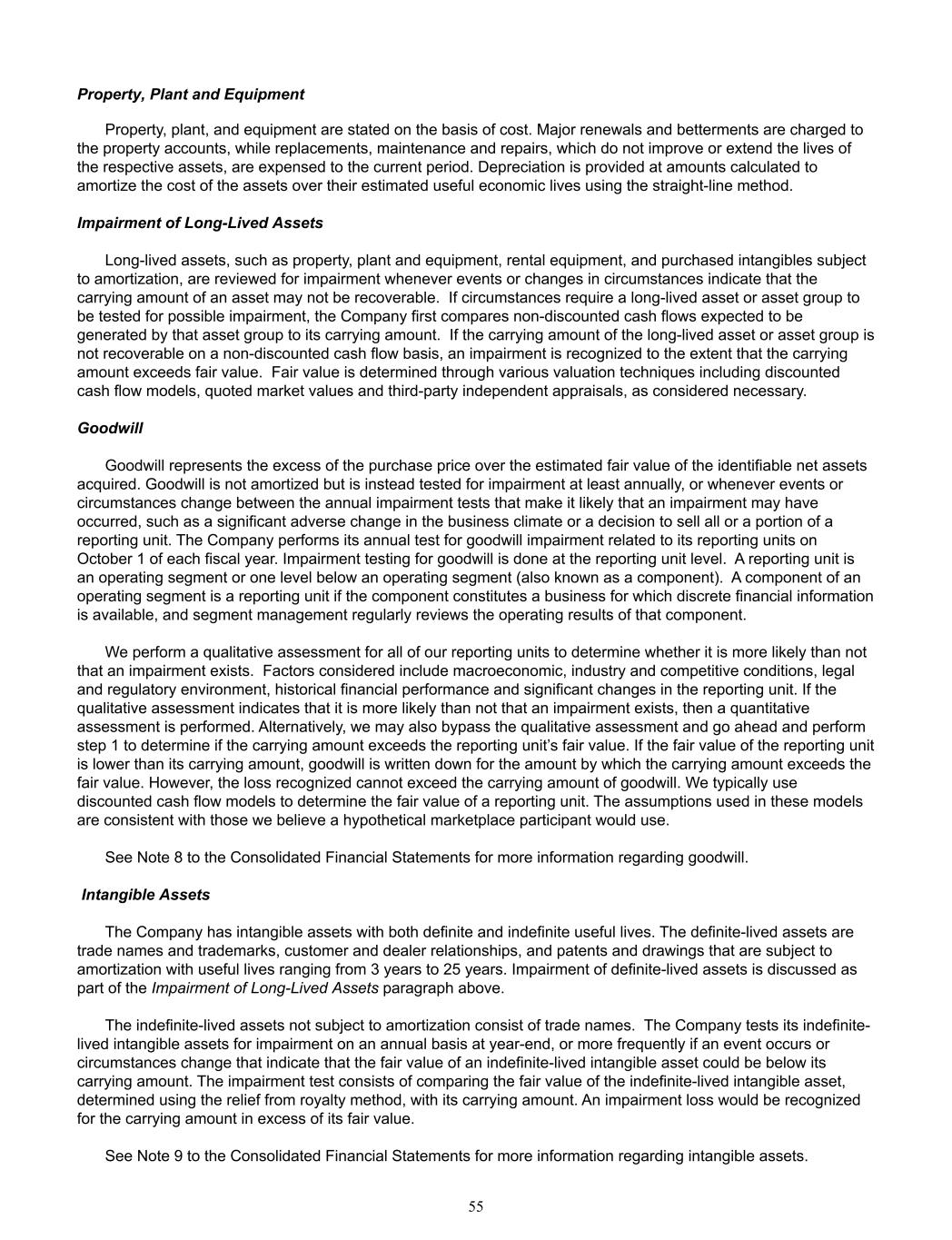
Property, Plant and Equipment Property, plant, and equipment are stated on the basis of cost. Major renewals and betterments are charged to the property accounts, while replacements, maintenance and repairs, which do not improve or extend the lives of the respective assets, are expensed to the current period. Depreciation is provided at amounts calculated to amortize the cost of the assets over their estimated useful economic lives using the straight-line method. Impairment of Long-Lived Assets Long-lived assets, such as property, plant and equipment, rental equipment, and purchased intangibles subject to amortization, are reviewed for impairment whenever events or changes in circumstances indicate that the carrying amount of an asset may not be recoverable. If circumstances require a long-lived asset or asset group to be tested for possible impairment, the Company first compares non-discounted cash flows expected to be generated by that asset group to its carrying amount. If the carrying amount of the long-lived asset or asset group is not recoverable on a non-discounted cash flow basis, an impairment is recognized to the extent that the carrying amount exceeds fair value. Fair value is determined through various valuation techniques including discounted cash flow models, quoted market values and third-party independent appraisals, as considered necessary. Goodwill Goodwill represents the excess of the purchase price over the estimated fair value of the identifiable net assets acquired. Goodwill is not amortized but is instead tested for impairment at least annually, or whenever events or circumstances change between the annual impairment tests that make it likely that an impairment may have occurred, such as a significant adverse change in the business climate or a decision to sell all or a portion of a reporting unit. The Company performs its annual test for goodwill impairment related to its reporting units on October 1 of each fiscal year. Impairment testing for goodwill is done at the reporting unit level. A reporting unit is an operating segment or one level below an operating segment (also known as a component). A component of an operating segment is a reporting unit if the component constitutes a business for which discrete financial information is available, and segment management regularly reviews the operating results of that component. We perform a qualitative assessment for all of our reporting units to determine whether it is more likely than not that an impairment exists. Factors considered include macroeconomic, industry and competitive conditions, legal and regulatory environment, historical financial performance and significant changes in the reporting unit. If the qualitative assessment indicates that it is more likely than not that an impairment exists, then a quantitative assessment is performed. Alternatively, we may also bypass the qualitative assessment and go ahead and perform step 1 to determine if the carrying amount exceeds the reporting unit’s fair value. If the fair value of the reporting unit is lower than its carrying amount, goodwill is written down for the amount by which the carrying amount exceeds the fair value. However, the loss recognized cannot exceed the carrying amount of goodwill. We typically use discounted cash flow models to determine the fair value of a reporting unit. The assumptions used in these models are consistent with those we believe a hypothetical marketplace participant would use. See Note 8 to the Consolidated Financial Statements for more information regarding goodwill. Intangible Assets The Company has intangible assets with both definite and indefinite useful lives. The definite-lived assets are trade names and trademarks, customer and dealer relationships, and patents and drawings that are subject to amortization with useful lives ranging from 3 years to 25 years. Impairment of definite-lived assets is discussed as part of the Impairment of Long-Lived Assets paragraph above. The indefinite-lived assets not subject to amortization consist of trade names. The Company tests its indefinite- lived intangible assets for impairment on an annual basis at year-end, or more frequently if an event occurs or circumstances change that indicate that the fair value of an indefinite-lived intangible asset could be below its carrying amount. The impairment test consists of comparing the fair value of the indefinite-lived intangible asset, determined using the relief from royalty method, with its carrying amount. An impairment loss would be recognized for the carrying amount in excess of its fair value. See Note 9 to the Consolidated Financial Statements for more information regarding intangible assets. 55
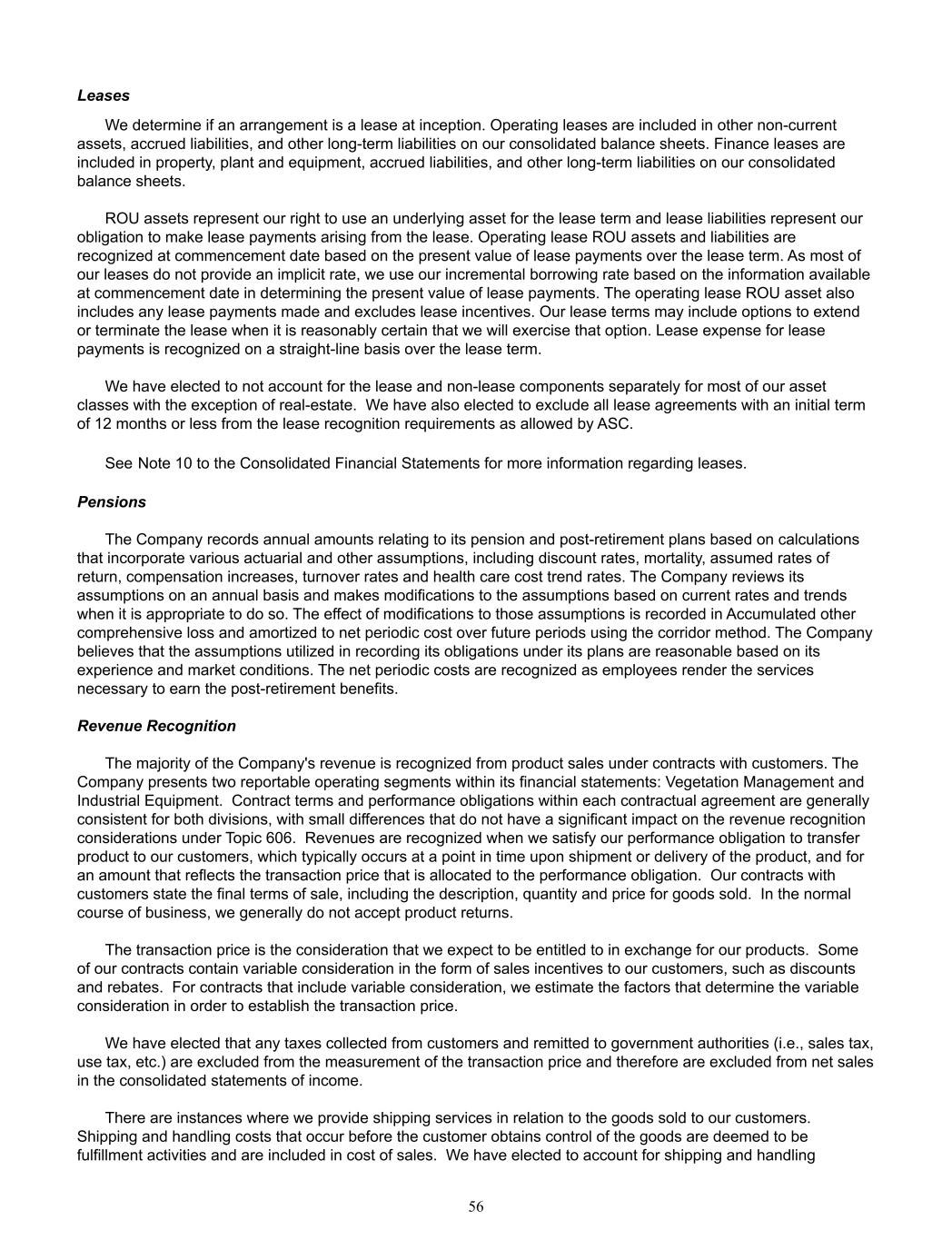
Leases We determine if an arrangement is a lease at inception. Operating leases are included in other non-current assets, accrued liabilities, and other long-term liabilities on our consolidated balance sheets. Finance leases are included in property, plant and equipment, accrued liabilities, and other long-term liabilities on our consolidated balance sheets. ROU assets represent our right to use an underlying asset for the lease term and lease liabilities represent our obligation to make lease payments arising from the lease. Operating lease ROU assets and liabilities are recognized at commencement date based on the present value of lease payments over the lease term. As most of our leases do not provide an implicit rate, we use our incremental borrowing rate based on the information available at commencement date in determining the present value of lease payments. The operating lease ROU asset also includes any lease payments made and excludes lease incentives. Our lease terms may include options to extend or terminate the lease when it is reasonably certain that we will exercise that option. Lease expense for lease payments is recognized on a straight-line basis over the lease term. We have elected to not account for the lease and non-lease components separately for most of our asset classes with the exception of real-estate. We have also elected to exclude all lease agreements with an initial term of 12 months or less from the lease recognition requirements as allowed by ASC. See Note 10 to the Consolidated Financial Statements for more information regarding leases. Pensions The Company records annual amounts relating to its pension and post-retirement plans based on calculations that incorporate various actuarial and other assumptions, including discount rates, mortality, assumed rates of return, compensation increases, turnover rates and health care cost trend rates. The Company reviews its assumptions on an annual basis and makes modifications to the assumptions based on current rates and trends when it is appropriate to do so. The effect of modifications to those assumptions is recorded in Accumulated other comprehensive loss and amortized to net periodic cost over future periods using the corridor method. The Company believes that the assumptions utilized in recording its obligations under its plans are reasonable based on its experience and market conditions. The net periodic costs are recognized as employees render the services necessary to earn the post-retirement benefits. Revenue Recognition The majority of the Company's revenue is recognized from product sales under contracts with customers. The Company presents two reportable operating segments within its financial statements: Vegetation Management and Industrial Equipment. Contract terms and performance obligations within each contractual agreement are generally consistent for both divisions, with small differences that do not have a significant impact on the revenue recognition considerations under Topic 606. Revenues are recognized when we satisfy our performance obligation to transfer product to our customers, which typically occurs at a point in time upon shipment or delivery of the product, and for an amount that reflects the transaction price that is allocated to the performance obligation. Our contracts with customers state the final terms of sale, including the description, quantity and price for goods sold. In the normal course of business, we generally do not accept product returns. The transaction price is the consideration that we expect to be entitled to in exchange for our products. Some of our contracts contain variable consideration in the form of sales incentives to our customers, such as discounts and rebates. For contracts that include variable consideration, we estimate the factors that determine the variable consideration in order to establish the transaction price. We have elected that any taxes collected from customers and remitted to government authorities (i.e., sales tax, use tax, etc.) are excluded from the measurement of the transaction price and therefore are excluded from net sales in the consolidated statements of income. There are instances where we provide shipping services in relation to the goods sold to our customers. Shipping and handling costs that occur before the customer obtains control of the goods are deemed to be fulfillment activities and are included in cost of sales. We have elected to account for shipping and handling 56
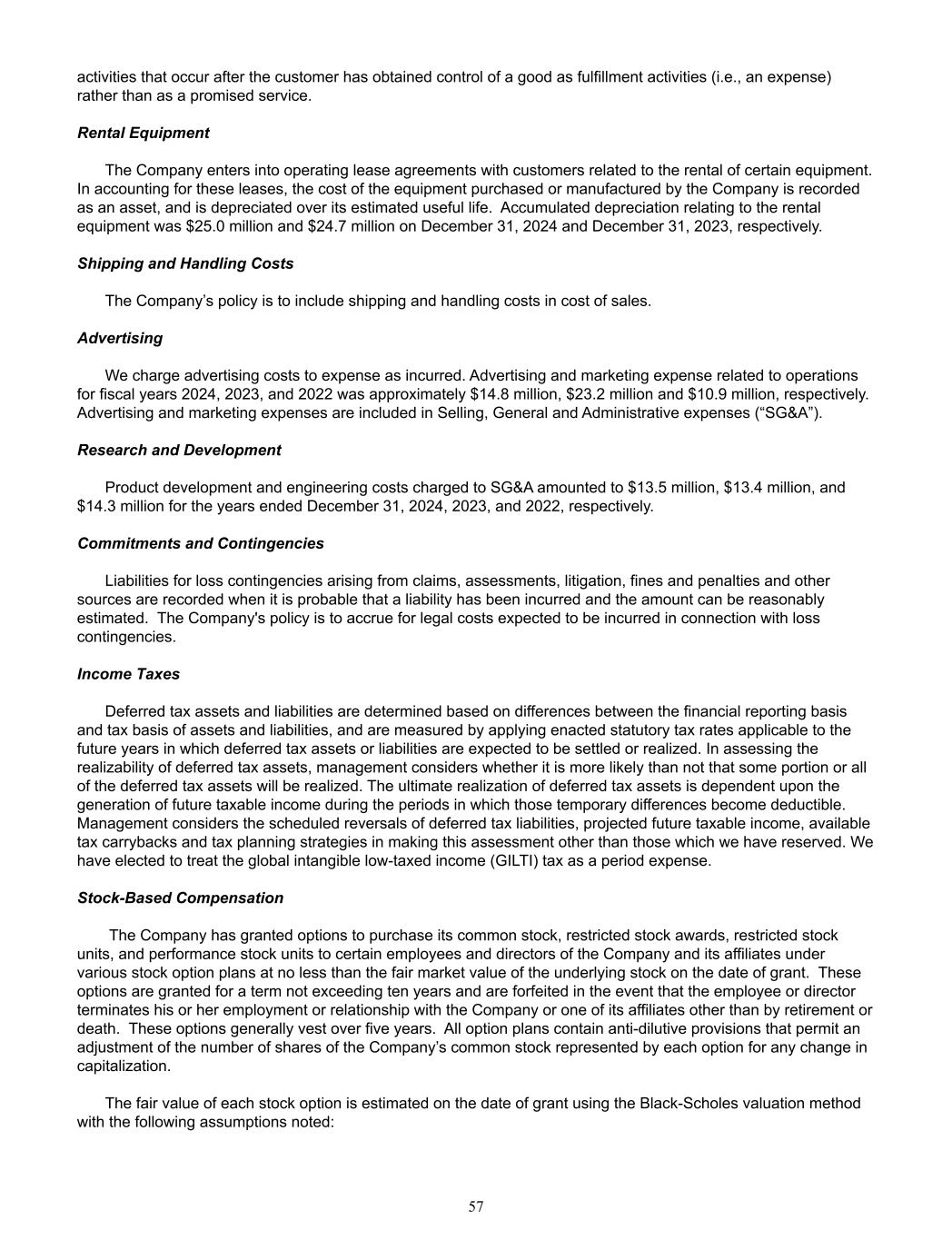
activities that occur after the customer has obtained control of a good as fulfillment activities (i.e., an expense) rather than as a promised service. Rental Equipment The Company enters into operating lease agreements with customers related to the rental of certain equipment. In accounting for these leases, the cost of the equipment purchased or manufactured by the Company is recorded as an asset, and is depreciated over its estimated useful life. Accumulated depreciation relating to the rental equipment was $25.0 million and $24.7 million on December 31, 2024 and December 31, 2023, respectively. Shipping and Handling Costs The Company’s policy is to include shipping and handling costs in cost of sales. Advertising We charge advertising costs to expense as incurred. Advertising and marketing expense related to operations for fiscal years 2024, 2023, and 2022 was approximately $14.8 million, $23.2 million and $10.9 million, respectively. Advertising and marketing expenses are included in Selling, General and Administrative expenses (“SG&A”). Research and Development Product development and engineering costs charged to SG&A amounted to $13.5 million, $13.4 million, and $14.3 million for the years ended December 31, 2024, 2023, and 2022, respectively. Commitments and Contingencies Liabilities for loss contingencies arising from claims, assessments, litigation, fines and penalties and other sources are recorded when it is probable that a liability has been incurred and the amount can be reasonably estimated. The Company's policy is to accrue for legal costs expected to be incurred in connection with loss contingencies. Income Taxes Deferred tax assets and liabilities are determined based on differences between the financial reporting basis and tax basis of assets and liabilities, and are measured by applying enacted statutory tax rates applicable to the future years in which deferred tax assets or liabilities are expected to be settled or realized. In assessing the realizability of deferred tax assets, management considers whether it is more likely than not that some portion or all of the deferred tax assets will be realized. The ultimate realization of deferred tax assets is dependent upon the generation of future taxable income during the periods in which those temporary differences become deductible. Management considers the scheduled reversals of deferred tax liabilities, projected future taxable income, available tax carrybacks and tax planning strategies in making this assessment other than those which we have reserved. We have elected to treat the global intangible low-taxed income (GILTI) tax as a period expense. Stock-Based Compensation The Company has granted options to purchase its common stock, restricted stock awards, restricted stock units, and performance stock units to certain employees and directors of the Company and its affiliates under various stock option plans at no less than the fair market value of the underlying stock on the date of grant. These options are granted for a term not exceeding ten years and are forfeited in the event that the employee or director terminates his or her employment or relationship with the Company or one of its affiliates other than by retirement or death. These options generally vest over five years. All option plans contain anti-dilutive provisions that permit an adjustment of the number of shares of the Company’s common stock represented by each option for any change in capitalization. The fair value of each stock option is estimated on the date of grant using the Black-Scholes valuation method with the following assumptions noted: 57

1. The risk-free rate is based on the U.S. Treasury rate over the expected life of the option at the time of the grant. 2. The dividend yield is calculated as the ratio of dividends paid per share of common stock to the stock price on the date of the grant. 3. The expected volatility factors are based on the historical movement of the Company’s common stock price over the expected life of the option. 4. The expected life is the average length of time in which officers, other employees, and non-employee directors are expected to exercise their options, and which are primarily based on historical experience. The Company calculated the fair value for options with the following weighted-average assumptions for 2024, 2023, and 2022: December 31, 2024 2023 2022 Risk-free interest rate 4.27 % 4.05 % 1.93 % Dividend yield 0.5 % 0.5 % 0.5 % Volatility factors 31.4 % 32.1 % 33.2 % Weighted-average expected life 8.0 years 8.0 years 8.0 years Fair Value Calculation Assumptions for Stock Compensation Earnings per Common Share (“EPS”) Basic EPS is computed using the weighted-average number of common shares outstanding during the year. The treasury stock method is used to compute diluted EPS which gives effect to the potential dilution of earnings that could have occurred if additional shares were issued for awards granted under the Company’s incentive stock option plans. The treasury stock method assumes that proceeds obtained upon exercise of awards granted under the incentive stock option plans are used to purchase outstanding common stock at the average market price during the period. 2. ACCOUNTING PRONOUNCEMENTS Accounting Pronouncements Not Yet Adopted In December 2023, the FASB issued ASU No. 2023-09, Improvements to Income Tax Disclosures (Topic 740). The ASU requires disaggregated information about a reporting entity’s effective tax rate reconciliation as well as additional information on income taxes paid. The ASU is effective on a prospective basis for annual periods beginning after December 15, 2024. Early adoption is also permitted for annual financial statements that have not yet been issued or made available for issuance. This ASU will result in the required additional disclosures being included in our consolidated financial statements, once adopted. In November 2024, the FASB issued ASU No. 2024-03, Expense Disaggregation Disclosures (Subtopic 220-40). The ASU requires disaggregated Income Statement Expenses. The ASU is effective for annual periods beginning after December 15, 2026, and interim reporting periods within annual reporting periods beginning after December 15, 2027. Early adoption is also permitted. This ASU will result in the required additional disclosures being included in our consolidated financial statements, once adopted. Accounting Pronouncements Adopted for Year End 2024 In November 2023, the Financial Accounting Standards Board (“FASB”) issued ASU No. 2023-07, Improvements to Reportable Segment Disclosures (Topic 280). This ASU updates reportable segment disclosure requirements by requiring disclosures of significant reportable segment expenses that are regularly provided to the Chief Operating Decision Maker (“CODM”) and included within each reported measure of a segment's profit or loss. This ASU also requires disclosure of the title and position of the individual identified as the CODM and an explanation of how the CODM uses the reported measures of a segment’s profit or loss in assessing segment performance and deciding how to allocate resources. The ASU is effective for annual periods beginning after December 15, 2023, and interim periods within fiscal years beginning after December 15, 2024. Adoption of the ASU should be applied retrospectively to all prior periods presented in the financial statements. Early adoption is 58

also permitted. Upon adoption this ASU will result in incremental disclosures as required. We have adopted the provision of this ASU for the year ending December 31, 2024. 3. BUSINESS COMBINATIONS On October 10, 2023, the Company acquired 100% of the issued and outstanding equity capital of Royal Truck & Equipment, Inc. (“Royal Truck”). Royal Truck is a leading manufacturer of truck mounted highway attenuator trucks and other specialty trucks and equipment for the highway infrastructure and traffic control market. The primary reason for the Royal Truck acquisition was to acquire business operations in an adjacent market, highway safety and equipment, where the Company sees compelling future opportunities. The acquisition price was approximately $32 million. The Company completed its review of the valuation of the purchase price allocation for Royal Truck during the first quarter of 2024. The Company has included the operating results of Royal Truck in its consolidated financial statements since the date of acquisition, these results are considered immaterial. 4. EARNINGS PER SHARE The following table sets forth the reconciliation from basic to diluted average common shares and the calculations of net income per common share. Net income for basic and diluted calculations does not differ. (in thousands, except per share amounts) 2024 2023 2022 Net income $ 115,930 $ 136,161 $ 101,928 Average common shares: Basic (weighted-average outstanding shares) 11,968 11,920 11,877 Dilutive potential common shares from stock options 69 67 57 Diluted (weighted-average outstanding shares) 12,037 11,987 11,934 Basic earnings per share $ 9.69 $ 11.42 $ 8.58 Diluted earnings per share $ 9.63 $ 11.36 $ 8.54 Stock options totaling 15,797 shares in 2024, 4,991 shares in 2023, and 25,610 shares in 2022 were not included in the diluted earnings per share calculation because the effect would have been anti-dilutive. 59
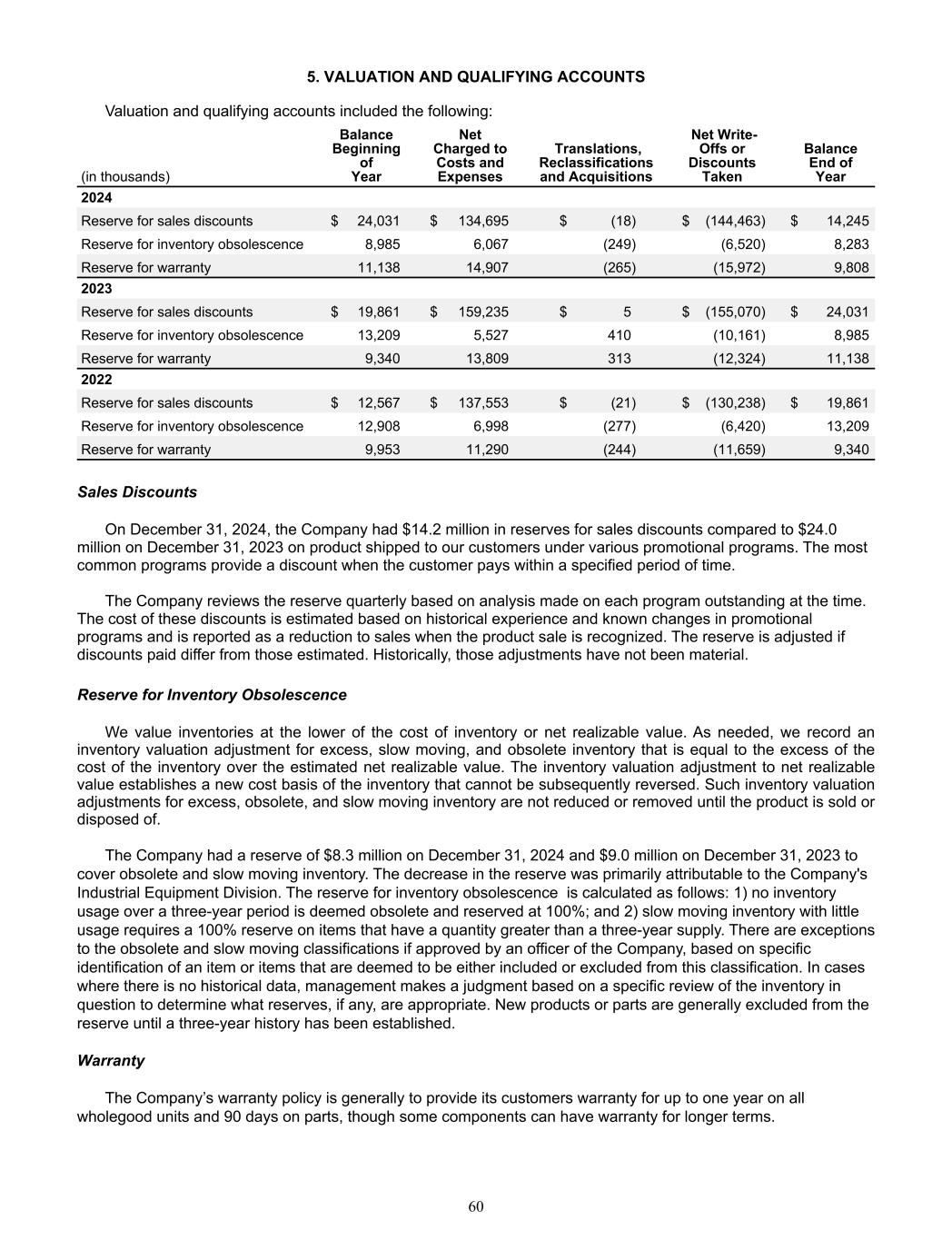
5. VALUATION AND QUALIFYING ACCOUNTS Valuation and qualifying accounts included the following: (in thousands) Balance Beginning of Year Net Charged to Costs and Expenses Translations, Reclassifications and Acquisitions Net Write- Offs or Discounts Taken Balance End of Year 2024 Reserve for sales discounts $ 24,031 $ 134,695 $ (18) $ (144,463) $ 14,245 Reserve for inventory obsolescence 8,985 6,067 (249) (6,520) 8,283 Reserve for warranty 11,138 14,907 (265) (15,972) 9,808 2023 Reserve for sales discounts $ 19,861 $ 159,235 $ 5 $ (155,070) $ 24,031 Reserve for inventory obsolescence 13,209 5,527 410 (10,161) 8,985 Reserve for warranty 9,340 13,809 313 (12,324) 11,138 2022 Reserve for sales discounts $ 12,567 $ 137,553 $ (21) $ (130,238) $ 19,861 Reserve for inventory obsolescence 12,908 6,998 (277) (6,420) 13,209 Reserve for warranty 9,953 11,290 (244) (11,659) 9,340 Sales Discounts On December 31, 2024, the Company had $14.2 million in reserves for sales discounts compared to $24.0 million on December 31, 2023 on product shipped to our customers under various promotional programs. The most common programs provide a discount when the customer pays within a specified period of time. The Company reviews the reserve quarterly based on analysis made on each program outstanding at the time. The cost of these discounts is estimated based on historical experience and known changes in promotional programs and is reported as a reduction to sales when the product sale is recognized. The reserve is adjusted if discounts paid differ from those estimated. Historically, those adjustments have not been material. Reserve for Inventory Obsolescence We value inventories at the lower of the cost of inventory or net realizable value. As needed, we record an inventory valuation adjustment for excess, slow moving, and obsolete inventory that is equal to the excess of the cost of the inventory over the estimated net realizable value. The inventory valuation adjustment to net realizable value establishes a new cost basis of the inventory that cannot be subsequently reversed. Such inventory valuation adjustments for excess, obsolete, and slow moving inventory are not reduced or removed until the product is sold or disposed of. The Company had a reserve of $8.3 million on December 31, 2024 and $9.0 million on December 31, 2023 to cover obsolete and slow moving inventory. The decrease in the reserve was primarily attributable to the Company's Industrial Equipment Division. The reserve for inventory obsolescence is calculated as follows: 1) no inventory usage over a three-year period is deemed obsolete and reserved at 100%; and 2) slow moving inventory with little usage requires a 100% reserve on items that have a quantity greater than a three-year supply. There are exceptions to the obsolete and slow moving classifications if approved by an officer of the Company, based on specific identification of an item or items that are deemed to be either included or excluded from this classification. In cases where there is no historical data, management makes a judgment based on a specific review of the inventory in question to determine what reserves, if any, are appropriate. New products or parts are generally excluded from the reserve until a three-year history has been established. Warranty The Company’s warranty policy is generally to provide its customers warranty for up to one year on all wholegood units and 90 days on parts, though some components can have warranty for longer terms. 60
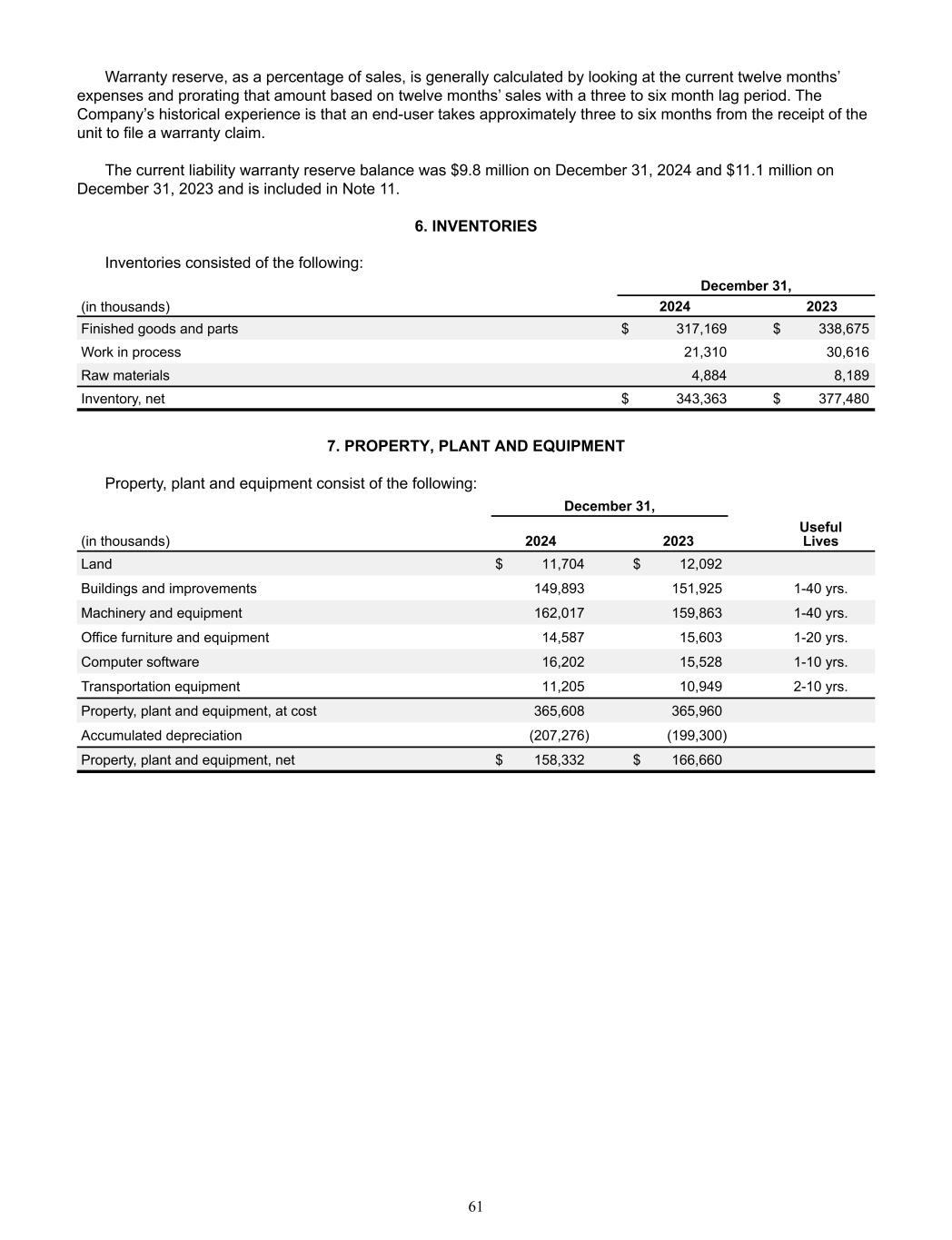
Warranty reserve, as a percentage of sales, is generally calculated by looking at the current twelve months’ expenses and prorating that amount based on twelve months’ sales with a three to six month lag period. The Company’s historical experience is that an end-user takes approximately three to six months from the receipt of the unit to file a warranty claim. The current liability warranty reserve balance was $9.8 million on December 31, 2024 and $11.1 million on December 31, 2023 and is included in Note 11. 6. INVENTORIES Inventories consisted of the following: December 31, (in thousands) 2024 2023 Finished goods and parts $ 317,169 $ 338,675 Work in process 21,310 30,616 Raw materials 4,884 8,189 Inventory, net $ 343,363 $ 377,480 7. PROPERTY, PLANT AND EQUIPMENT Property, plant and equipment consist of the following: December 31, (in thousands) 2024 2023 Useful Lives Land $ 11,704 $ 12,092 Buildings and improvements 149,893 151,925 1-40 yrs. Machinery and equipment 162,017 159,863 1-40 yrs. Office furniture and equipment 14,587 15,603 1-20 yrs. Computer software 16,202 15,528 1-10 yrs. Transportation equipment 11,205 10,949 2-10 yrs. Property, plant and equipment, at cost 365,608 365,960 Accumulated depreciation (207,276) (199,300) Property, plant and equipment, net $ 158,332 $ 166,660 61
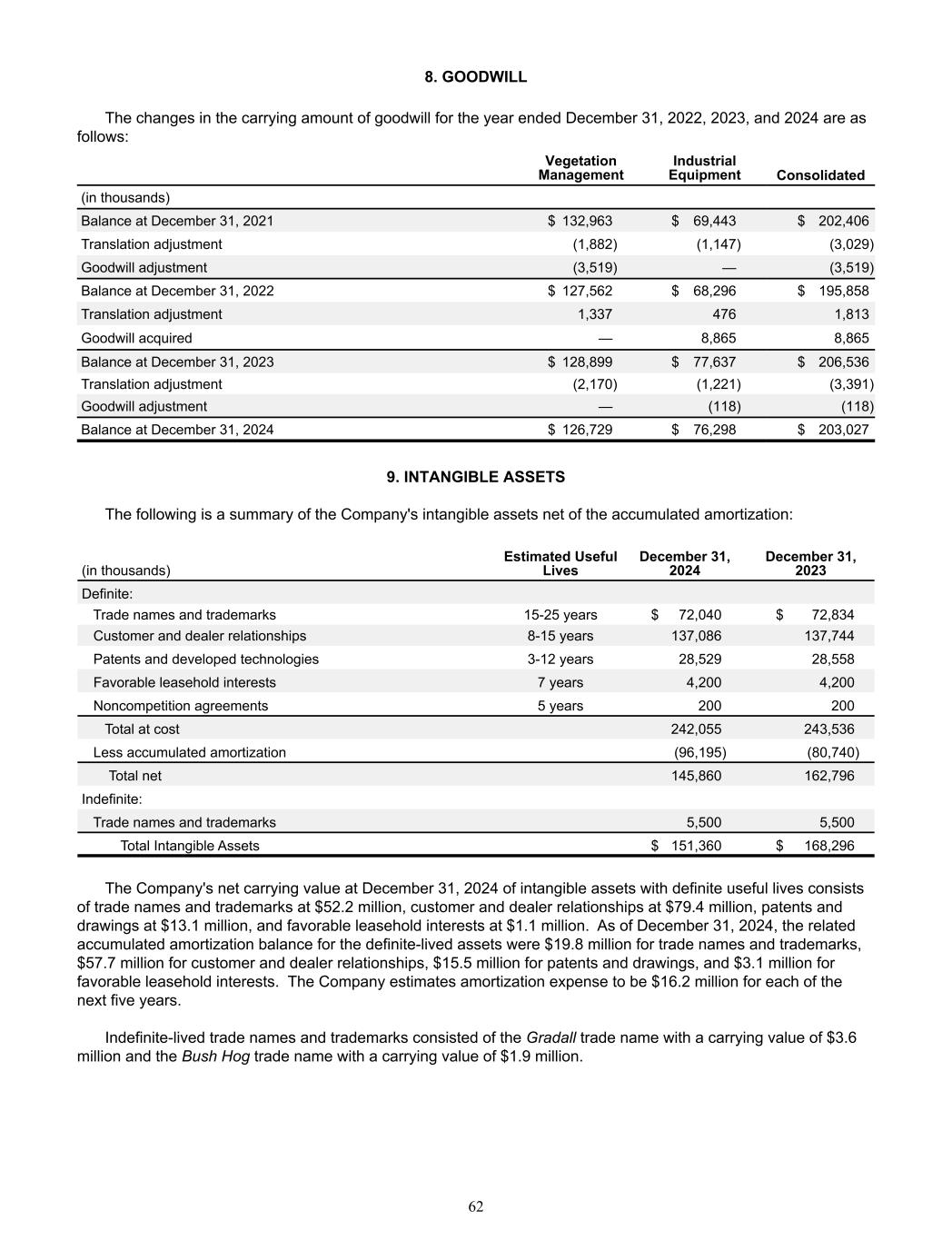
8. GOODWILL The changes in the carrying amount of goodwill for the year ended December 31, 2022, 2023, and 2024 are as follows: Vegetation Management Industrial Equipment Consolidated (in thousands) Balance at December 31, 2021 $ 132,963 $ 69,443 $ 202,406 Translation adjustment (1,882) (1,147) (3,029) Goodwill adjustment (3,519) — (3,519) Balance at December 31, 2022 $ 127,562 $ 68,296 $ 195,858 Translation adjustment 1,337 476 1,813 Goodwill acquired — 8,865 8,865 Balance at December 31, 2023 $ 128,899 $ 77,637 $ 206,536 Translation adjustment (2,170) (1,221) (3,391) Goodwill adjustment — (118) (118) Balance at December 31, 2024 $ 126,729 $ 76,298 $ 203,027 9. INTANGIBLE ASSETS The following is a summary of the Company's intangible assets net of the accumulated amortization: (in thousands) Estimated Useful Lives December 31, 2024 December 31, 2023 Definite: Trade names and trademarks 15-25 years $ 72,040 $ 72,834 Customer and dealer relationships 8-15 years 137,086 137,744 Patents and developed technologies 3-12 years 28,529 28,558 Favorable leasehold interests 7 years 4,200 4,200 Noncompetition agreements 5 years 200 200 Total at cost 242,055 243,536 Less accumulated amortization (96,195) (80,740) Total net 145,860 162,796 Indefinite: Trade names and trademarks 5,500 5,500 Total Intangible Assets $ 151,360 $ 168,296 The Company's net carrying value at December 31, 2024 of intangible assets with definite useful lives consists of trade names and trademarks at $52.2 million, customer and dealer relationships at $79.4 million, patents and drawings at $13.1 million, and favorable leasehold interests at $1.1 million. As of December 31, 2024, the related accumulated amortization balance for the definite-lived assets were $19.8 million for trade names and trademarks, $57.7 million for customer and dealer relationships, $15.5 million for patents and drawings, and $3.1 million for favorable leasehold interests. The Company estimates amortization expense to be $16.2 million for each of the next five years. Indefinite-lived trade names and trademarks consisted of the Gradall trade name with a carrying value of $3.6 million and the Bush Hog trade name with a carrying value of $1.9 million. 62
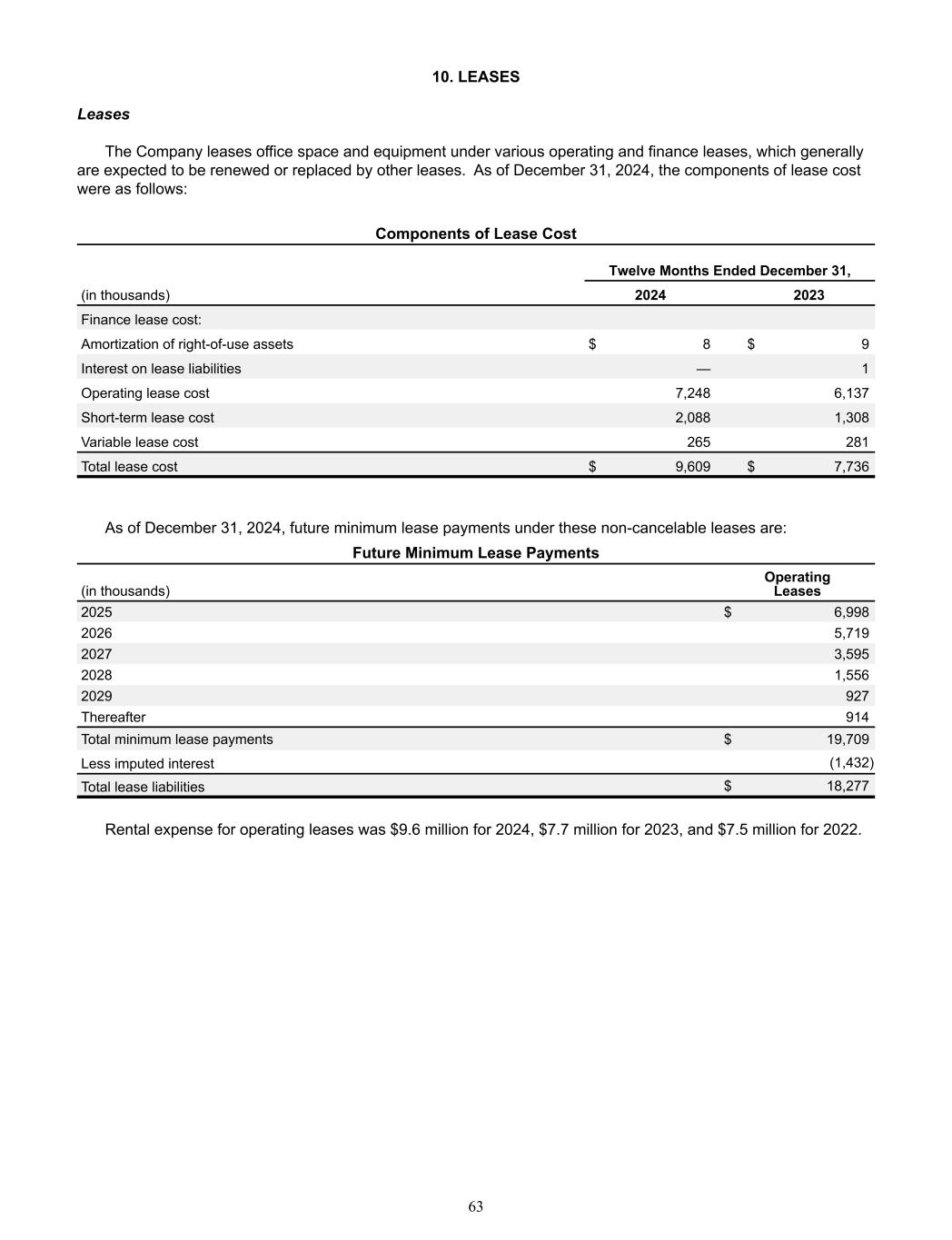
10. LEASES Leases The Company leases office space and equipment under various operating and finance leases, which generally are expected to be renewed or replaced by other leases. As of December 31, 2024, the components of lease cost were as follows: Components of Lease Cost Twelve Months Ended December 31, (in thousands) 2024 2023 Finance lease cost: Amortization of right-of-use assets $ 8 $ 9 Interest on lease liabilities — 1 Operating lease cost 7,248 6,137 Short-term lease cost 2,088 1,308 Variable lease cost 265 281 Total lease cost $ 9,609 $ 7,736 As of December 31, 2024, future minimum lease payments under these non-cancelable leases are: Future Minimum Lease Payments (in thousands) Operating Leases 2025 $ 6,998 2026 5,719 2027 3,595 2028 1,556 2029 927 Thereafter 914 Total minimum lease payments $ 19,709 Less imputed interest (1,432) Total lease liabilities $ 18,277 Rental expense for operating leases was $9.6 million for 2024, $7.7 million for 2023, and $7.5 million for 2022. 63

Future Lease Commencements As of December 31, 2024, we have additional operating leases that have not yet commenced in the amount of $0.6 million. These operating leases will commence in fiscal year 2025. Supplemental balance sheet information related to leases was as follows: Operating Leases December 31, (in thousands) 2024 2023 Other non-current assets $ 18,099 $ 16,279 Accrued liabilities 6,449 5,295 Other long-term liabilities 11,828 11,307 Total operating lease liabilities $ 18,277 $ 16,602 Weighted average remaining lease term 3.49 years 3.76 years Weighted average discount rate 4.57 % 4.05 % Supplemental cash flow information related to leases was as follows: Twelve Months Ended December 31, (in thousands) 2024 2023 Cash paid for amounts included in the measurement of lease liabilities: Operating cash flows from operating leases $ 6,503 $ 5,490 11. ACCRUED LIABILITIES Accrued liabilities consist of the following balances: December 31, (in thousands) 2024 2023 Salaries, wages and bonuses $ 38,063 $ 43,503 Lease liability 6,449 5,295 Taxes 1,392 1,965 Warranty 9,808 11,138 Retirement provision 2,575 2,785 Customer deposits 8,564 6,216 Other 10,686 15,809 Accrued liabilities $ 77,537 $ 86,711 12. FAIR VALUE OF FINANCIAL INSTRUMENTS U.S. GAAP requires or permits certain assets or liabilities to be measured at fair value on a recurring or non- recurring basis in our balance sheets. U.S. GAAP also requires the disclosure of the fair values of financial instruments when an option to elect fair value accounting has been provided but such election has not been made. A debt obligation is an example of such a financial instrument. Fair value is defined as the exchange price that would be received for an asset or paid to transfer a liability (an exit price) in the principal or most advantageous market for the asset or liability in an orderly transaction between market participants. There is a three-tier fair value hierarchy based upon the observability of inputs used in valuation techniques. Observable inputs (highest level) reflect market data obtained from independent sources, while 64
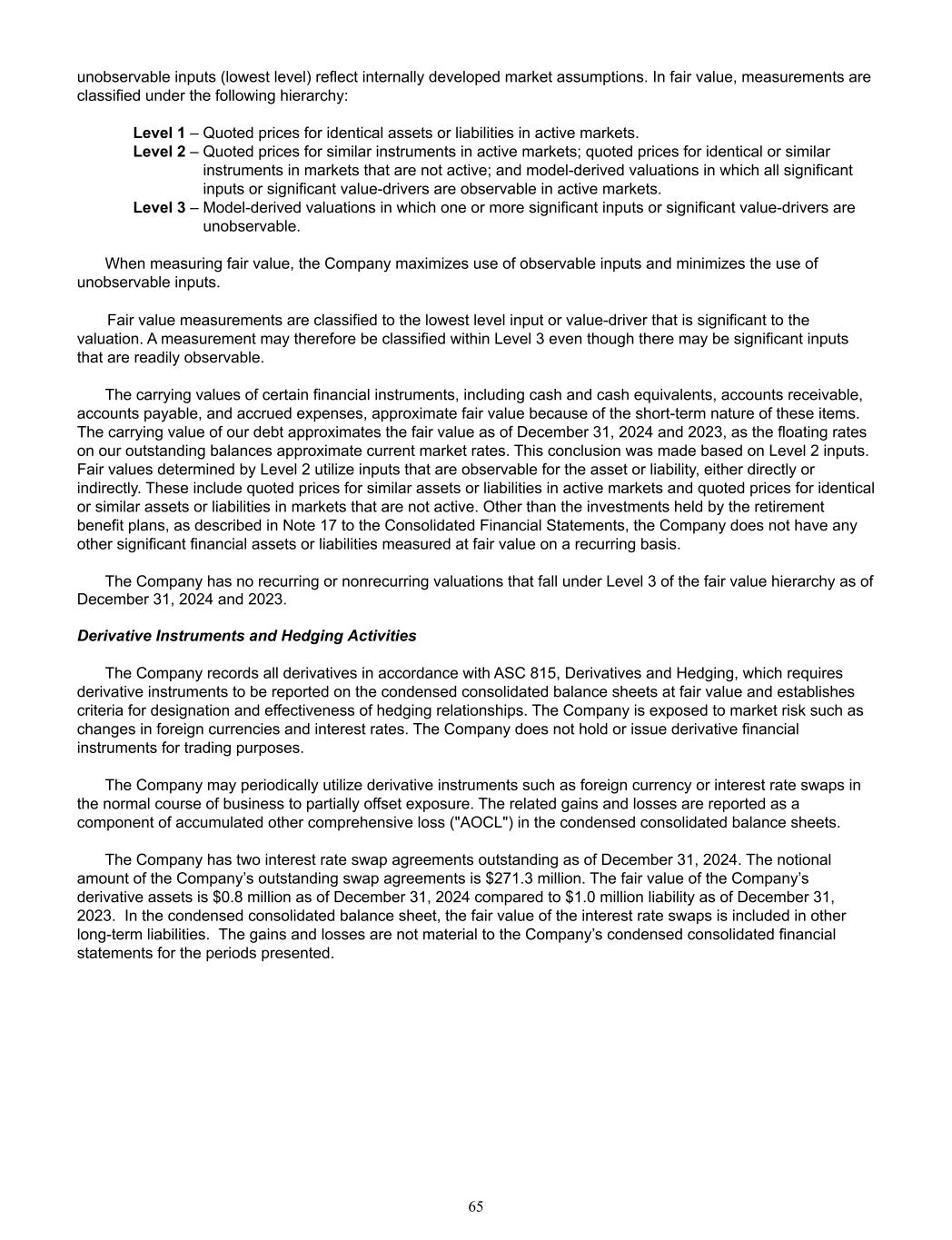
unobservable inputs (lowest level) reflect internally developed market assumptions. In fair value, measurements are classified under the following hierarchy: Level 1 – Quoted prices for identical assets or liabilities in active markets. Level 2 – Quoted prices for similar instruments in active markets; quoted prices for identical or similar instruments in markets that are not active; and model-derived valuations in which all significant inputs or significant value-drivers are observable in active markets. Level 3 – Model-derived valuations in which one or more significant inputs or significant value-drivers are unobservable. When measuring fair value, the Company maximizes use of observable inputs and minimizes the use of unobservable inputs. Fair value measurements are classified to the lowest level input or value-driver that is significant to the valuation. A measurement may therefore be classified within Level 3 even though there may be significant inputs that are readily observable. The carrying values of certain financial instruments, including cash and cash equivalents, accounts receivable, accounts payable, and accrued expenses, approximate fair value because of the short-term nature of these items. The carrying value of our debt approximates the fair value as of December 31, 2024 and 2023, as the floating rates on our outstanding balances approximate current market rates. This conclusion was made based on Level 2 inputs. Fair values determined by Level 2 utilize inputs that are observable for the asset or liability, either directly or indirectly. These include quoted prices for similar assets or liabilities in active markets and quoted prices for identical or similar assets or liabilities in markets that are not active. Other than the investments held by the retirement benefit plans, as described in Note 17 to the Consolidated Financial Statements, the Company does not have any other significant financial assets or liabilities measured at fair value on a recurring basis. The Company has no recurring or nonrecurring valuations that fall under Level 3 of the fair value hierarchy as of December 31, 2024 and 2023. Derivative Instruments and Hedging Activities The Company records all derivatives in accordance with ASC 815, Derivatives and Hedging, which requires derivative instruments to be reported on the condensed consolidated balance sheets at fair value and establishes criteria for designation and effectiveness of hedging relationships. The Company is exposed to market risk such as changes in foreign currencies and interest rates. The Company does not hold or issue derivative financial instruments for trading purposes. The Company may periodically utilize derivative instruments such as foreign currency or interest rate swaps in the normal course of business to partially offset exposure. The related gains and losses are reported as a component of accumulated other comprehensive loss ("AOCL") in the condensed consolidated balance sheets. The Company has two interest rate swap agreements outstanding as of December 31, 2024. The notional amount of the Company’s outstanding swap agreements is $271.3 million. The fair value of the Company’s derivative assets is $0.8 million as of December 31, 2024 compared to $1.0 million liability as of December 31, 2023. In the condensed consolidated balance sheet, the fair value of the interest rate swaps is included in other long-term liabilities. The gains and losses are not material to the Company’s condensed consolidated financial statements for the periods presented. 65
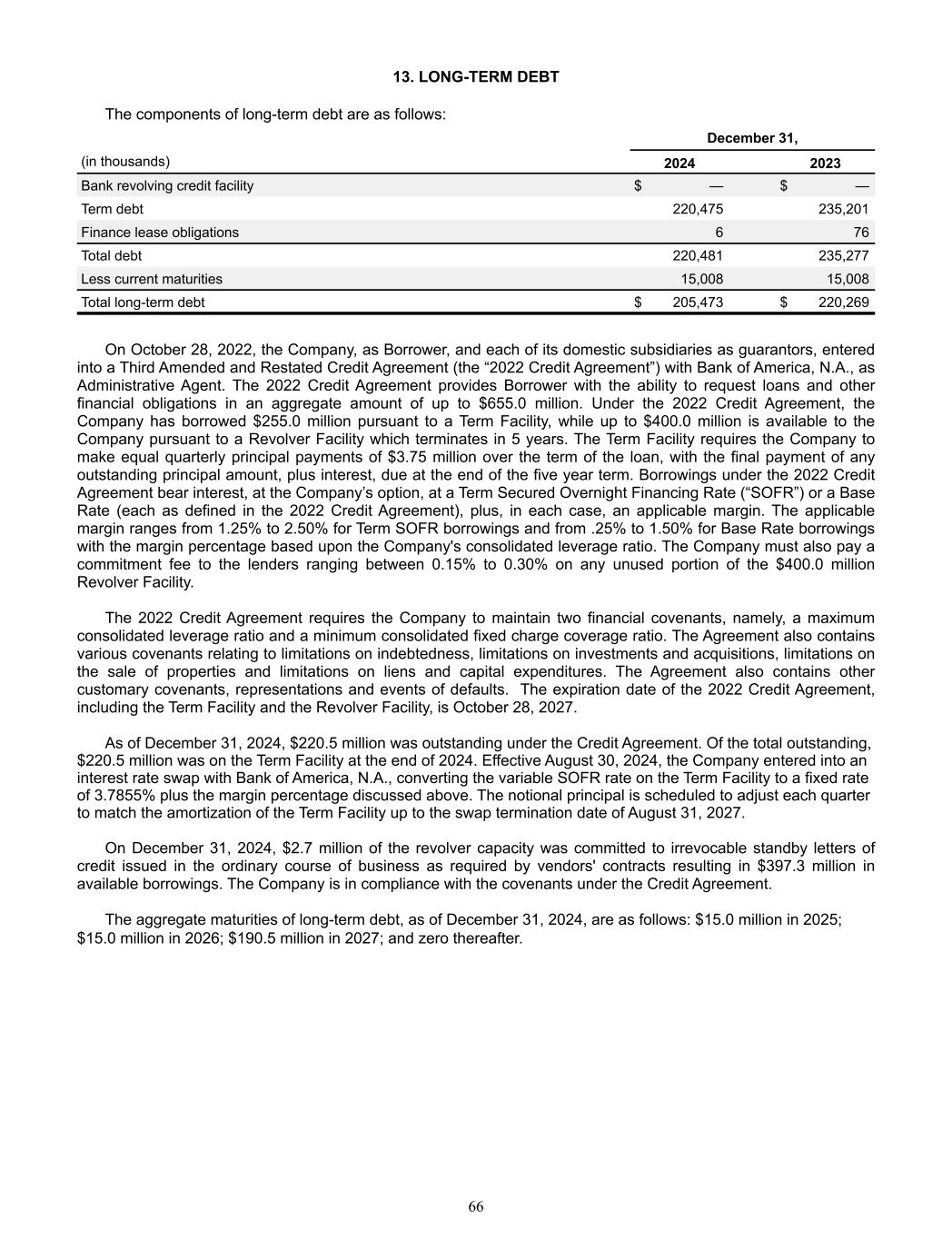
13. LONG-TERM DEBT The components of long-term debt are as follows: December 31, (in thousands) 2024 2023 Bank revolving credit facility $ — $ — Term debt 220,475 235,201 Finance lease obligations 6 76 Total debt 220,481 235,277 Less current maturities 15,008 15,008 Total long-term debt $ 205,473 $ 220,269 On October 28, 2022, the Company, as Borrower, and each of its domestic subsidiaries as guarantors, entered into a Third Amended and Restated Credit Agreement (the “2022 Credit Agreement”) with Bank of America, N.A., as Administrative Agent. The 2022 Credit Agreement provides Borrower with the ability to request loans and other financial obligations in an aggregate amount of up to $655.0 million. Under the 2022 Credit Agreement, the Company has borrowed $255.0 million pursuant to a Term Facility, while up to $400.0 million is available to the Company pursuant to a Revolver Facility which terminates in 5 years. The Term Facility requires the Company to make equal quarterly principal payments of $3.75 million over the term of the loan, with the final payment of any outstanding principal amount, plus interest, due at the end of the five year term. Borrowings under the 2022 Credit Agreement bear interest, at the Company’s option, at a Term Secured Overnight Financing Rate (“SOFR”) or a Base Rate (each as defined in the 2022 Credit Agreement), plus, in each case, an applicable margin. The applicable margin ranges from 1.25% to 2.50% for Term SOFR borrowings and from .25% to 1.50% for Base Rate borrowings with the margin percentage based upon the Company's consolidated leverage ratio. The Company must also pay a commitment fee to the lenders ranging between 0.15% to 0.30% on any unused portion of the $400.0 million Revolver Facility. The 2022 Credit Agreement requires the Company to maintain two financial covenants, namely, a maximum consolidated leverage ratio and a minimum consolidated fixed charge coverage ratio. The Agreement also contains various covenants relating to limitations on indebtedness, limitations on investments and acquisitions, limitations on the sale of properties and limitations on liens and capital expenditures. The Agreement also contains other customary covenants, representations and events of defaults. The expiration date of the 2022 Credit Agreement, including the Term Facility and the Revolver Facility, is October 28, 2027. As of December 31, 2024, $220.5 million was outstanding under the Credit Agreement. Of the total outstanding, $220.5 million was on the Term Facility at the end of 2024. Effective August 30, 2024, the Company entered into an interest rate swap with Bank of America, N.A., converting the variable SOFR rate on the Term Facility to a fixed rate of 3.7855% plus the margin percentage discussed above. The notional principal is scheduled to adjust each quarter to match the amortization of the Term Facility up to the swap termination date of August 31, 2027. On December 31, 2024, $2.7 million of the revolver capacity was committed to irrevocable standby letters of credit issued in the ordinary course of business as required by vendors' contracts resulting in $397.3 million in available borrowings. The Company is in compliance with the covenants under the Credit Agreement. The aggregate maturities of long-term debt, as of December 31, 2024, are as follows: $15.0 million in 2025; $15.0 million in 2026; $190.5 million in 2027; and zero thereafter. 66
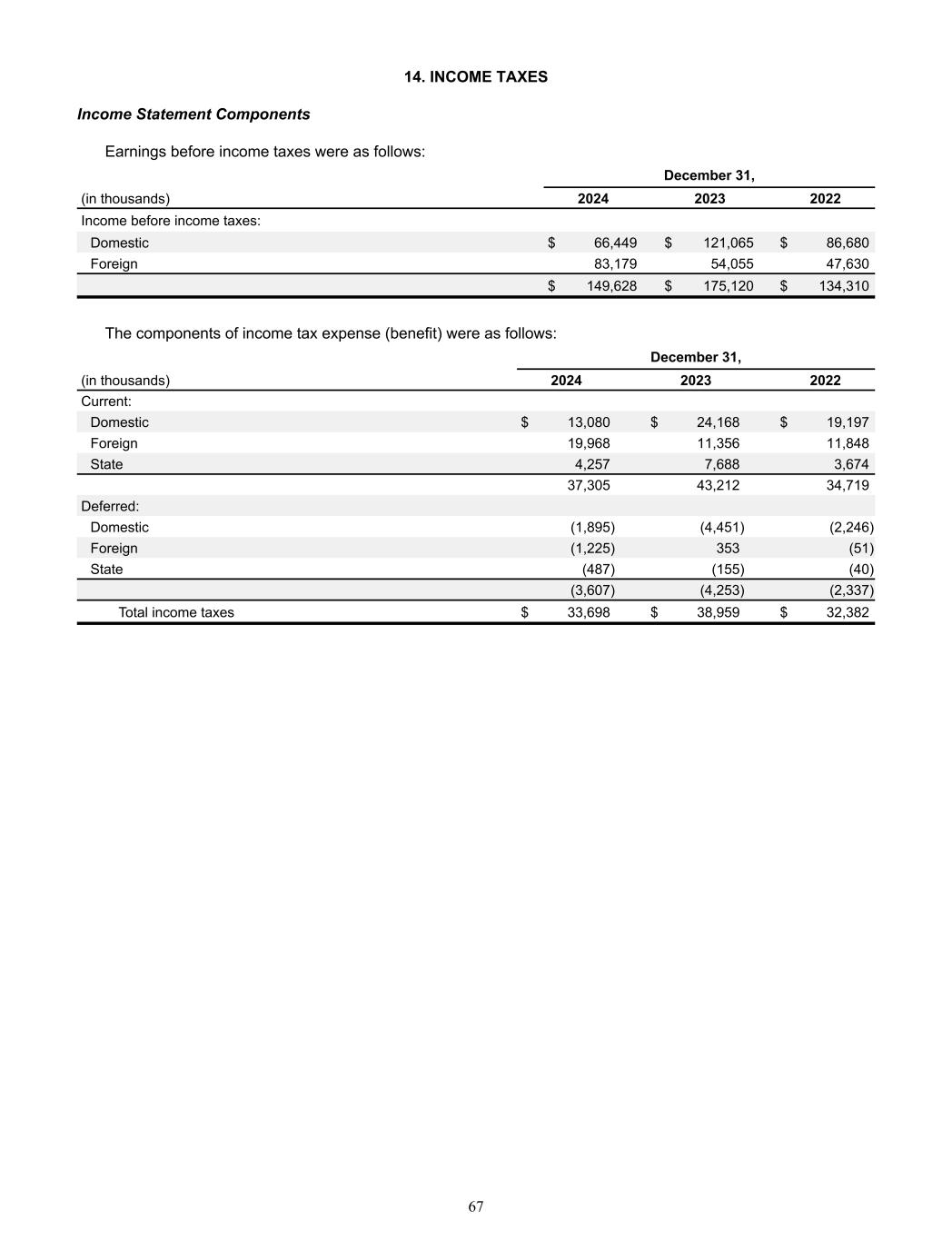
14. INCOME TAXES Income Statement Components Earnings before income taxes were as follows: December 31, (in thousands) 2024 2023 2022 Income before income taxes: Domestic $ 66,449 $ 121,065 $ 86,680 Foreign 83,179 54,055 47,630 $ 149,628 $ 175,120 $ 134,310 The components of income tax expense (benefit) were as follows: December 31, (in thousands) 2024 2023 2022 Current: Domestic $ 13,080 $ 24,168 $ 19,197 Foreign 19,968 11,356 11,848 State 4,257 7,688 3,674 37,305 43,212 34,719 Deferred: Domestic (1,895) (4,451) (2,246) Foreign (1,225) 353 (51) State (487) (155) (40) (3,607) (4,253) (2,337) Total income taxes $ 33,698 $ 38,959 $ 32,382 67

A reconciliation of the income tax at the Company’s U.S. statutory federal income tax rate to the provision for income tax follows. Some prior year components have been reclassified to conform to the current year presentation. December 31, (in thousands) 2024 2023 2022 Income tax expense at statutory rates $ 31,422 $ 36,775 $ 28,205 Increase (reduction) from: Jurisdictional rate differences 4,832 2,766 1,989 Executive compensation limitations 1,122 183 481 Valuation allowance (2,432) (789) (316) Stock based compensation 209 (24) 122 U.S. state taxes 2,876 6,076 2,632 Foreign tax (credit) / expense (1,498) (371) 267 R&D credit (net) (3,529) (3,618) (1585) Other credits (490) (628) — GILTI 871 109 500 FDII (187) (731) (192) Previously unrecognized tax (benefit) / expense 136 170 51 Other (net) 366 (959) 228 Provision for income taxes $ 33,698 $ 38,959 $ 32,382 Effective tax rate 22.5 % 22.2 % 24.1 % 68
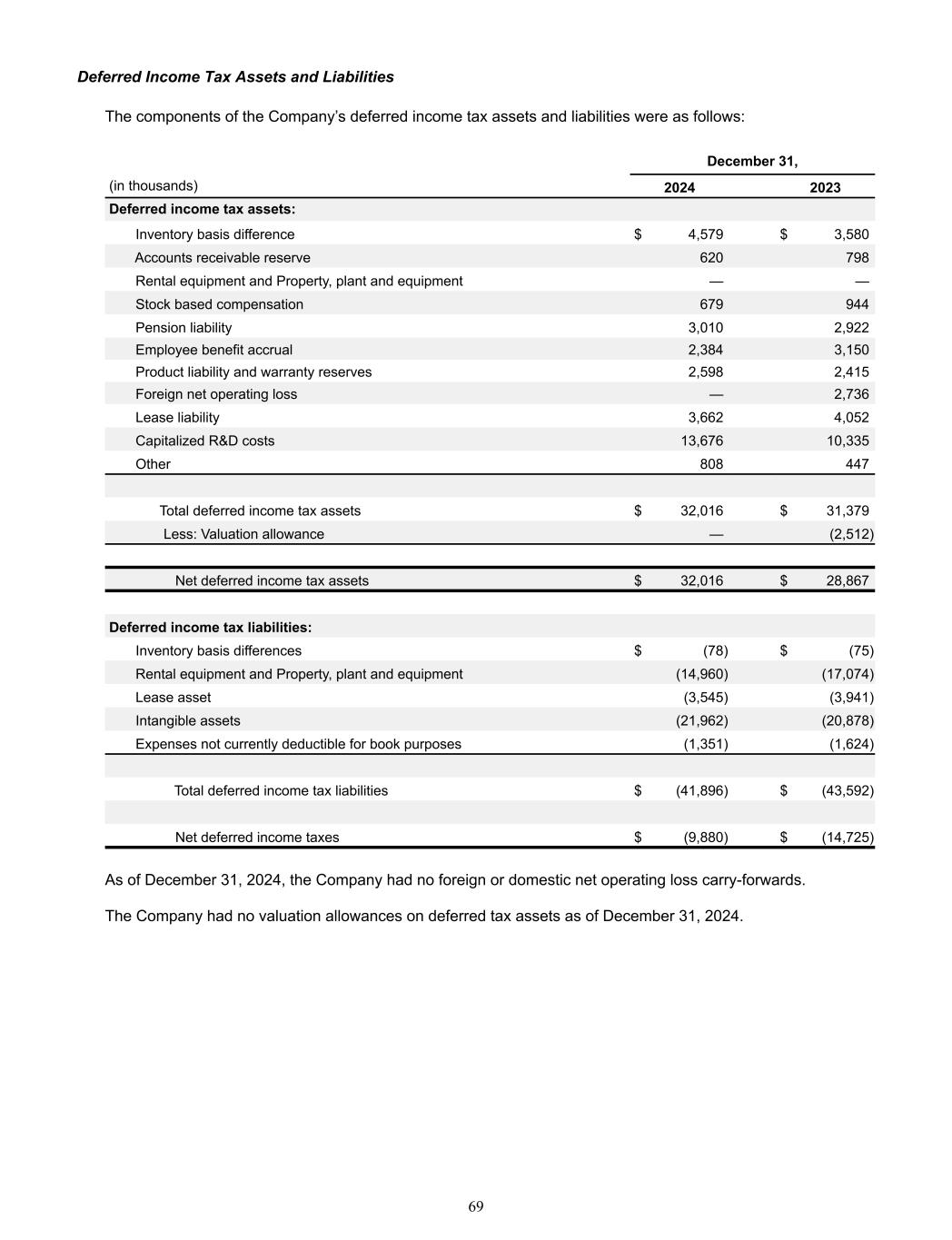
Deferred Income Tax Assets and Liabilities The components of the Company’s deferred income tax assets and liabilities were as follows: December 31, (in thousands) 2024 2023 Deferred income tax assets: Inventory basis difference $ 4,579 $ 3,580 Accounts receivable reserve 620 798 Rental equipment and Property, plant and equipment — — Stock based compensation 679 944 Pension liability 3,010 2,922 Employee benefit accrual 2,384 3,150 Product liability and warranty reserves 2,598 2,415 Foreign net operating loss — 2,736 Lease liability 3,662 4,052 Capitalized R&D costs 13,676 10,335 Other 808 447 Total deferred income tax assets $ 32,016 $ 31,379 Less: Valuation allowance — (2,512) Net deferred income tax assets $ 32,016 $ 28,867 Deferred income tax liabilities: Inventory basis differences $ (78) $ (75) Rental equipment and Property, plant and equipment (14,960) (17,074) Lease asset (3,545) (3,941) Intangible assets (21,962) (20,878) Expenses not currently deductible for book purposes (1,351) (1,624) Total deferred income tax liabilities $ (41,896) $ (43,592) Net deferred income taxes $ (9,880) $ (14,725) As of December 31, 2024, the Company had no foreign or domestic net operating loss carry-forwards. The Company had no valuation allowances on deferred tax assets as of December 31, 2024. 69
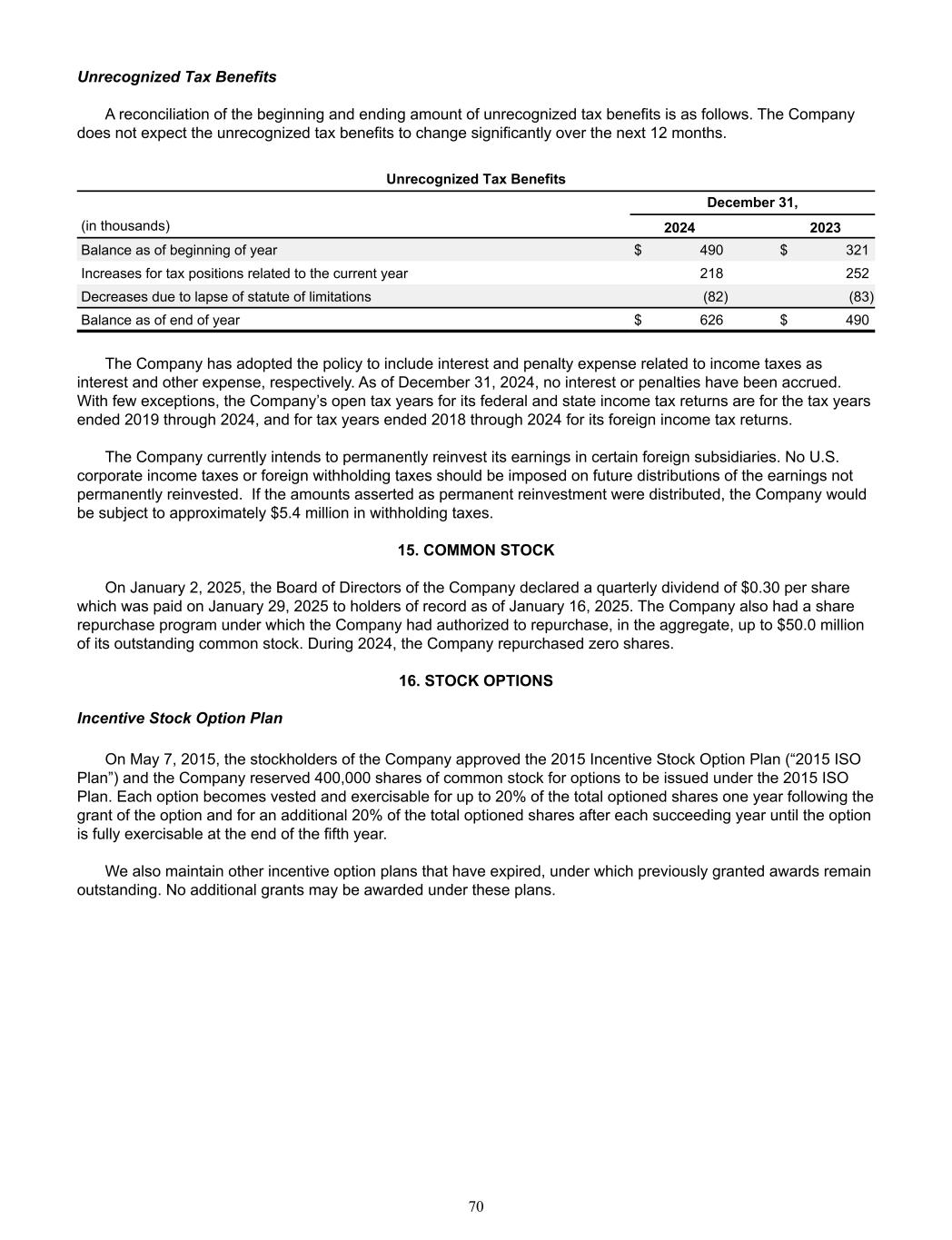
Unrecognized Tax Benefits A reconciliation of the beginning and ending amount of unrecognized tax benefits is as follows. The Company does not expect the unrecognized tax benefits to change significantly over the next 12 months. Unrecognized Tax Benefits December 31, (in thousands) 2024 2023 Balance as of beginning of year $ 490 $ 321 Increases for tax positions related to the current year 218 252 Decreases due to lapse of statute of limitations (82) (83) Balance as of end of year $ 626 $ 490 The Company has adopted the policy to include interest and penalty expense related to income taxes as interest and other expense, respectively. As of December 31, 2024, no interest or penalties have been accrued. With few exceptions, the Company’s open tax years for its federal and state income tax returns are for the tax years ended 2019 through 2024, and for tax years ended 2018 through 2024 for its foreign income tax returns. The Company currently intends to permanently reinvest its earnings in certain foreign subsidiaries. No U.S. corporate income taxes or foreign withholding taxes should be imposed on future distributions of the earnings not permanently reinvested. If the amounts asserted as permanent reinvestment were distributed, the Company would be subject to approximately $5.4 million in withholding taxes. 15. COMMON STOCK On January 2, 2025, the Board of Directors of the Company declared a quarterly dividend of $0.30 per share which was paid on January 29, 2025 to holders of record as of January 16, 2025. The Company also had a share repurchase program under which the Company had authorized to repurchase, in the aggregate, up to $50.0 million of its outstanding common stock. During 2024, the Company repurchased zero shares. 16. STOCK OPTIONS Incentive Stock Option Plan On May 7, 2015, the stockholders of the Company approved the 2015 Incentive Stock Option Plan (“2015 ISO Plan”) and the Company reserved 400,000 shares of common stock for options to be issued under the 2015 ISO Plan. Each option becomes vested and exercisable for up to 20% of the total optioned shares one year following the grant of the option and for an additional 20% of the total optioned shares after each succeeding year until the option is fully exercisable at the end of the fifth year. We also maintain other incentive option plans that have expired, under which previously granted awards remain outstanding. No additional grants may be awarded under these plans. 70

Following is a summary of activity in the Incentive Stock Option Plans for the periods indicated: 2024 2023 2022 Shares Exercise Price* Shares Exercise Price* Shares Exercise Price* Options outstanding at beginning of year 75,862 $ 128.64 84,647 $ 106.43 87,610 $ 91.24 Granted 17,519 203.55 14,425 178.25 17,625 137.93 Exercised (18,430) 103.81 (21,260) 72.09 (14,780) 50.79 Canceled (5,899) 169.97 (1,950) 148.08 (5,808) 114.48 Options outstanding at end of year 69,052 150.74 75,862 128.64 84,647 106.43 Options exercisable at end of year 29,757 $ 118.60 34,027 $ 100.00 43,412 $ 78.50 Options available for grant at end of year 261,888 273,558 286,033 *Weighted Averages Options outstanding and exercisable at December 31, 2024 were as follows: Qualified Stock Options Options Outstanding Options Exercisable Shares Remaining Contractual Life (yrs)* Exercise Price* Shares Exercise Price* Range of Exercise Price $52.51 - $83.99 5,275 1.52 $ 65.36 5,275 $ 65.36 $92.50 - $138.75 25,662 5.70 $ 121.62 16,377 $ 114.52 $156.38 - $234.57 38,115 7.96 $ 182.16 8,105 $ 161.52 Total 69,052 29,757 *Weighted Averages The weighted-average grant-date fair values of options granted during 2024, 2023, and 2022 were $86.89, $76.10 and $52.70, respectively. Stock option expense was $0.9 million, $0.8 million and $0.6 million for years ending 2024, 2023, and 2022, respectively. As of December 31, 2024, there was $1.8 million of total unrecognized compensation cost related to non-vested share-based compensation arrangements granted under the plans. That cost is expected to be recognized over a period of five years. Equity Incentive Plan On May 2, 2019, the stockholders of the Company approved the 2019 Equity Incentive Plan and the Company reserved 500,000 shares of common stock for issuance of equity awards including the issuance of non-qualified options for the purchase of shares of our common stock which may be granted to Company officers and non- employee directors. Options become vested and exercisable for up to 20% of the total optioned shares one year following the grant of the option and for an additional 20% of the total optioned shares after each succeeding year until the option is fully exercisable at the end of the fifth year. 2024 2023 2022 Options available for grant at end of year 321,669 356,156 381,531 We also maintain other incentive option plans that have expired, under which previously granted awards remain outstanding. No additional grants may be awarded under these plans. 71
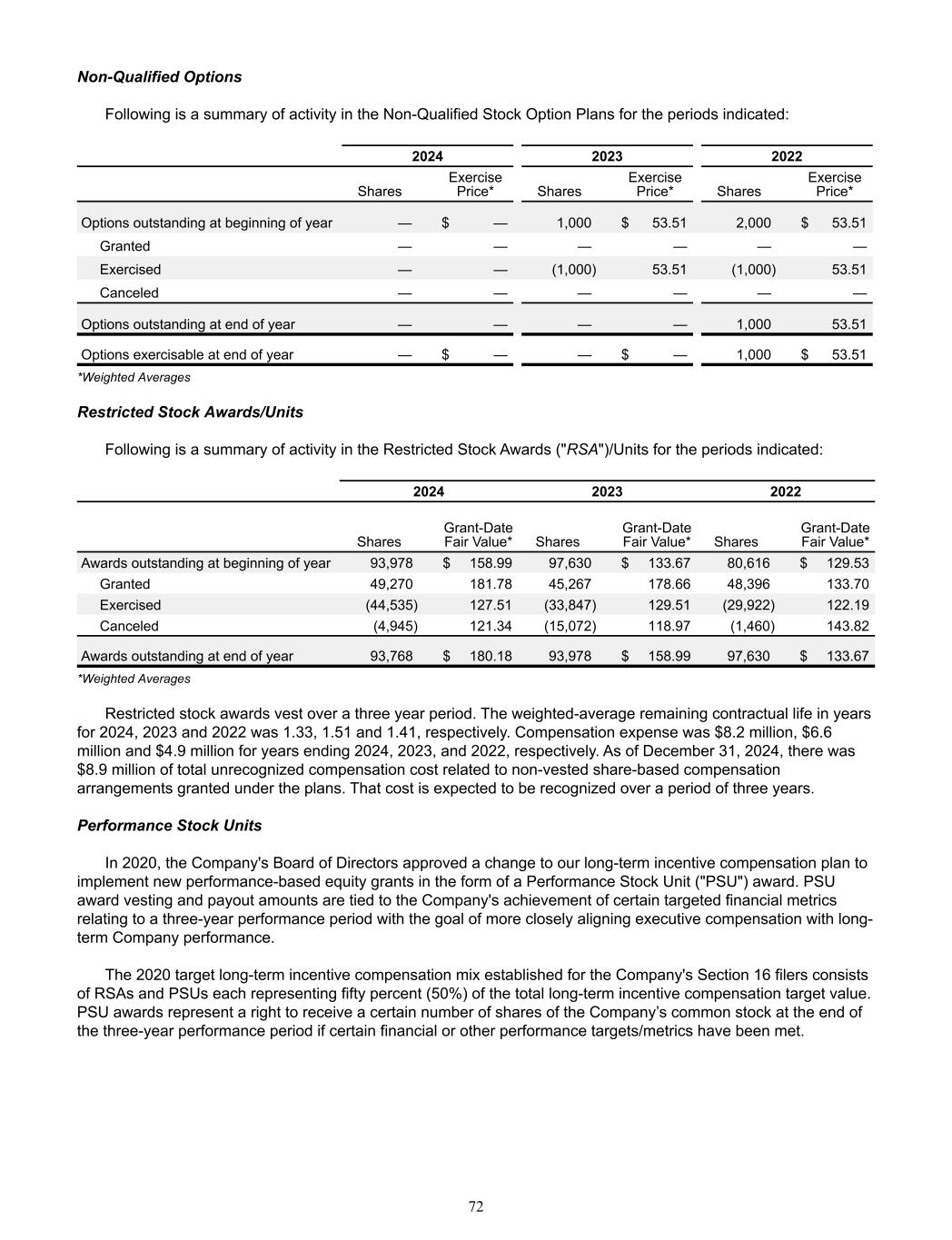
Non-Qualified Options Following is a summary of activity in the Non-Qualified Stock Option Plans for the periods indicated: 2024 2023 2022 Shares Exercise Price* Shares Exercise Price* Shares Exercise Price* Options outstanding at beginning of year — $ — 1,000 $ 53.51 2,000 $ 53.51 Granted — — — — — — Exercised — — (1,000) 53.51 (1,000) 53.51 Canceled — — — — — — Options outstanding at end of year — — — — 1,000 53.51 Options exercisable at end of year — $ — — $ — 1,000 $ 53.51 *Weighted Averages Restricted Stock Awards/Units Following is a summary of activity in the Restricted Stock Awards ("RSA")/Units for the periods indicated: 2024 2023 2022 Shares Grant-Date Fair Value* Shares Grant-Date Fair Value* Shares Grant-Date Fair Value* Awards outstanding at beginning of year 93,978 $ 158.99 97,630 $ 133.67 80,616 $ 129.53 Granted 49,270 181.78 45,267 178.66 48,396 133.70 Exercised (44,535) 127.51 (33,847) 129.51 (29,922) 122.19 Canceled (4,945) 121.34 (15,072) 118.97 (1,460) 143.82 Awards outstanding at end of year 93,768 $ 180.18 93,978 $ 158.99 97,630 $ 133.67 *Weighted Averages Restricted stock awards vest over a three year period. The weighted-average remaining contractual life in years for 2024, 2023 and 2022 was 1.33, 1.51 and 1.41, respectively. Compensation expense was $8.2 million, $6.6 million and $4.9 million for years ending 2024, 2023, and 2022, respectively. As of December 31, 2024, there was $8.9 million of total unrecognized compensation cost related to non-vested share-based compensation arrangements granted under the plans. That cost is expected to be recognized over a period of three years. Performance Stock Units In 2020, the Company's Board of Directors approved a change to our long-term incentive compensation plan to implement new performance-based equity grants in the form of a Performance Stock Unit ("PSU") award. PSU award vesting and payout amounts are tied to the Company's achievement of certain targeted financial metrics relating to a three-year performance period with the goal of more closely aligning executive compensation with long- term Company performance. The 2020 target long-term incentive compensation mix established for the Company's Section 16 filers consists of RSAs and PSUs each representing fifty percent (50%) of the total long-term incentive compensation target value. PSU awards represent a right to receive a certain number of shares of the Company’s common stock at the end of the three-year performance period if certain financial or other performance targets/metrics have been met. 72

17. RETIREMENT BENEFIT PLANS Defined Benefit Plans In connection with the February 3, 2006 purchase of all the net assets of the Gradall excavator business, the Company assumed sponsorship of two Gradall non-contributory defined benefit pension plans, both of which are frozen with respect to both future benefit accruals and future new entrants. The Gradall Company Employees’ Retirement Plan covers approximately 248 former employees and 43 current employees who (i) were formerly employed by JLG Industries, Inc., (ii) were not covered by a collective bargaining agreement and (iii) first participated in the plan before December 31, 2004. An amendment ceasing future benefit accruals for certain participants was effective December 31, 2004. A second amendment discontinued all future benefit accruals for all participants effective April 24, 2006. The Gradall Company Hourly Employees’ Pension Plan covered former employees and current employees who (i) were formerly employed by JLG Industries, Inc., (ii) were covered by a collective bargaining agreement and (iii) first participated in the plan before April 6, 1997. An amendment ceasing all future benefit accruals was effective April 6, 1997. The following table sets forth the change in plan assets, change in projected benefit obligation, rate assumptions and components of net periodic benefit cost as of December 31 with respect to the plan. The measurement dates of the assets and liabilities of the plan were December 31 of the respective years presented. Reconciliation of Funded Status Year Ended December 31, (in thousands) 2024 2023 Change in projected benefit obligation Benefit obligation at beginning of year $ 16,947 $ 17,271 Service cost 2 2 Interest cost 800 848 Liability actuarial (gain) loss (923) (35) Benefits paid (1,162) (1,139) Benefit obligation at end of year $ 15,664 $ 16,947 Change in fair value of plan assets Fair value of plan assets at beginning of year $ 18,775 $ 18,269 Return on plan assets 133 1,645 Employer contributions — — Benefits paid (1,162) (1,139) Fair value of plan assets at end of year 17,746 18,775 Funded status $ 2,082 $ 1,828 The Company recognizes the overfunded or underfunded status (i.e., the difference between the fair value of plan assets and the projected benefit obligations) of defined benefit postretirement plans as an asset or liability in its consolidated balance sheet and recognizes changes in the funded status in the year in which the changes occur. The Company measures the funded status of a plan as of the date of the year-end consolidated balance sheet. The accumulated benefit obligation for our pension plan represents the actuarial present value of benefits based on employee service and compensation as of a certain date and does not include an assumption about future compensation levels. In determining the projected benefit obligation and the net pension cost, we used the following significant weighted-average assumptions: 73
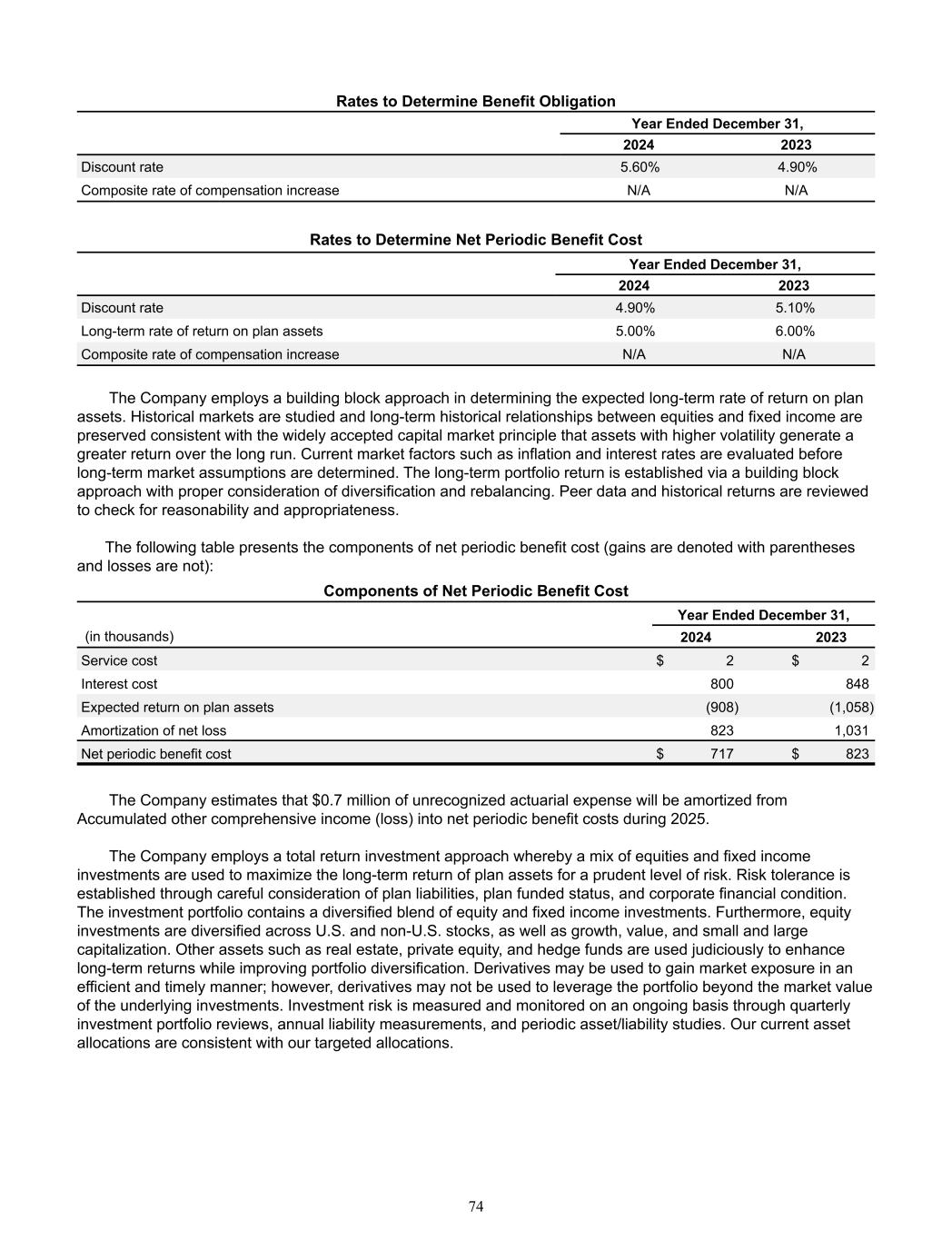
Rates to Determine Benefit Obligation Year Ended December 31, 2024 2023 Discount rate 5.60% 4.90% Composite rate of compensation increase N/A N/A Rates to Determine Net Periodic Benefit Cost Year Ended December 31, 2024 2023 Discount rate 4.90% 5.10% Long-term rate of return on plan assets 5.00% 6.00% Composite rate of compensation increase N/A N/A The Company employs a building block approach in determining the expected long-term rate of return on plan assets. Historical markets are studied and long-term historical relationships between equities and fixed income are preserved consistent with the widely accepted capital market principle that assets with higher volatility generate a greater return over the long run. Current market factors such as inflation and interest rates are evaluated before long-term market assumptions are determined. The long-term portfolio return is established via a building block approach with proper consideration of diversification and rebalancing. Peer data and historical returns are reviewed to check for reasonability and appropriateness. The following table presents the components of net periodic benefit cost (gains are denoted with parentheses and losses are not): Components of Net Periodic Benefit Cost Year Ended December 31, (in thousands) 2024 2023 Service cost $ 2 $ 2 Interest cost 800 848 Expected return on plan assets (908) (1,058) Amortization of net loss 823 1,031 Net periodic benefit cost $ 717 $ 823 The Company estimates that $0.7 million of unrecognized actuarial expense will be amortized from Accumulated other comprehensive income (loss) into net periodic benefit costs during 2025. The Company employs a total return investment approach whereby a mix of equities and fixed income investments are used to maximize the long-term return of plan assets for a prudent level of risk. Risk tolerance is established through careful consideration of plan liabilities, plan funded status, and corporate financial condition. The investment portfolio contains a diversified blend of equity and fixed income investments. Furthermore, equity investments are diversified across U.S. and non-U.S. stocks, as well as growth, value, and small and large capitalization. Other assets such as real estate, private equity, and hedge funds are used judiciously to enhance long-term returns while improving portfolio diversification. Derivatives may be used to gain market exposure in an efficient and timely manner; however, derivatives may not be used to leverage the portfolio beyond the market value of the underlying investments. Investment risk is measured and monitored on an ongoing basis through quarterly investment portfolio reviews, annual liability measurements, and periodic asset/liability studies. Our current asset allocations are consistent with our targeted allocations. 74
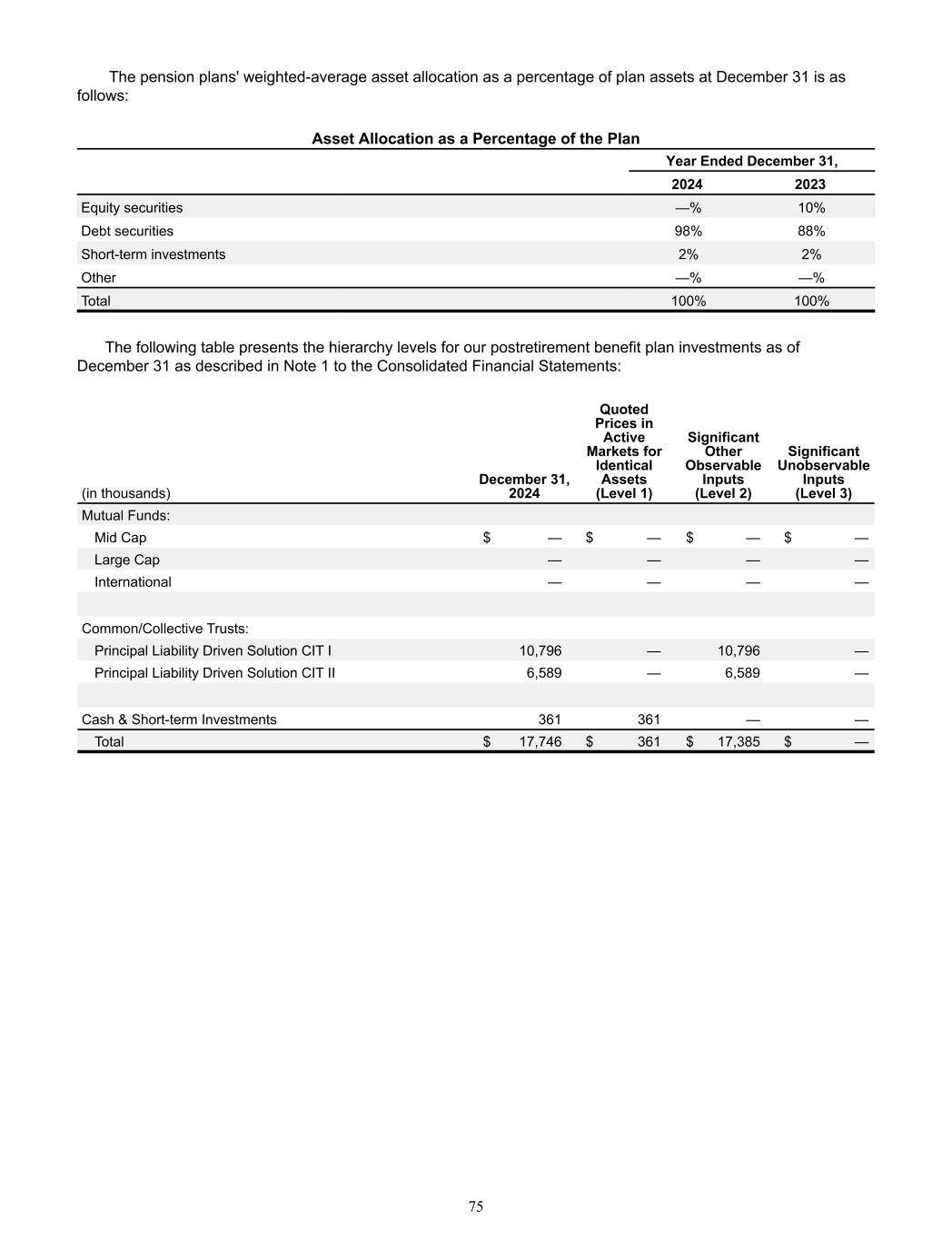
The pension plans' weighted-average asset allocation as a percentage of plan assets at December 31 is as follows: Asset Allocation as a Percentage of the Plan Year Ended December 31, 2024 2023 Equity securities —% 10% Debt securities 98% 88% Short-term investments 2% 2% Other —% —% Total 100% 100% The following table presents the hierarchy levels for our postretirement benefit plan investments as of December 31 as described in Note 1 to the Consolidated Financial Statements: (in thousands) December 31, 2024 Quoted Prices in Active Markets for Identical Assets (Level 1) Significant Other Observable Inputs (Level 2) Significant Unobservable Inputs (Level 3) Mutual Funds: Mid Cap $ — $ — $ — $ — Large Cap — — — — International — — — — Common/Collective Trusts: Principal Liability Driven Solution CIT I 10,796 — 10,796 — Principal Liability Driven Solution CIT II 6,589 — 6,589 — Cash & Short-term Investments 361 361 — — Total $ 17,746 $ 361 $ 17,385 $ — 75
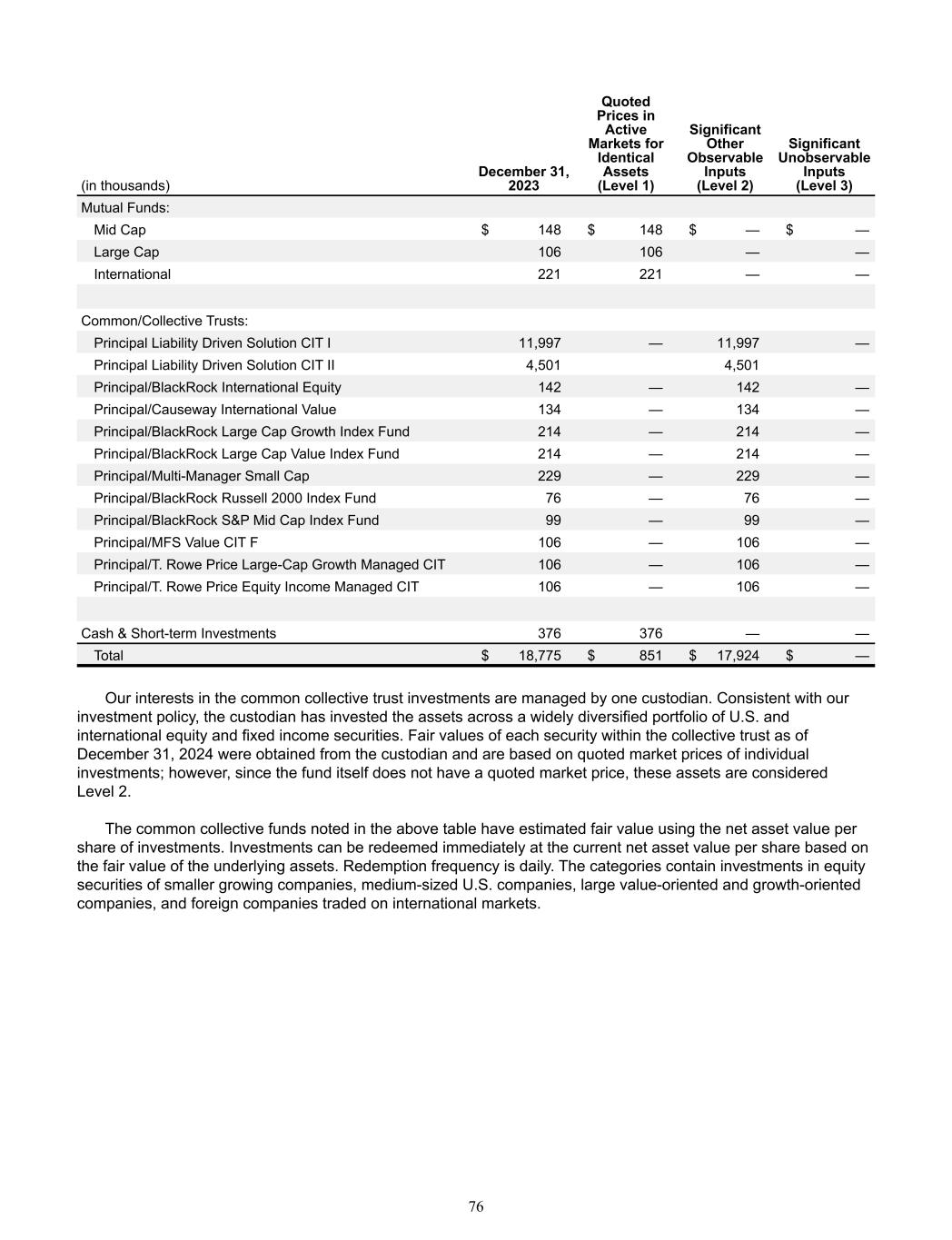
(in thousands) December 31, 2023 Quoted Prices in Active Markets for Identical Assets (Level 1) Significant Other Observable Inputs (Level 2) Significant Unobservable Inputs (Level 3) Mutual Funds: Mid Cap $ 148 $ 148 $ — $ — Large Cap 106 106 — — International 221 221 — — Common/Collective Trusts: Principal Liability Driven Solution CIT I 11,997 — 11,997 — Principal Liability Driven Solution CIT II 4,501 4,501 Principal/BlackRock International Equity 142 — 142 — Principal/Causeway International Value 134 — 134 — Principal/BlackRock Large Cap Growth Index Fund 214 — 214 — Principal/BlackRock Large Cap Value Index Fund 214 — 214 — Principal/Multi-Manager Small Cap 229 — 229 — Principal/BlackRock Russell 2000 Index Fund 76 — 76 — Principal/BlackRock S&P Mid Cap Index Fund 99 — 99 — Principal/MFS Value CIT F 106 — 106 — Principal/T. Rowe Price Large-Cap Growth Managed CIT 106 — 106 — Principal/T. Rowe Price Equity Income Managed CIT 106 — 106 — Cash & Short-term Investments 376 376 — — Total $ 18,775 $ 851 $ 17,924 $ — Our interests in the common collective trust investments are managed by one custodian. Consistent with our investment policy, the custodian has invested the assets across a widely diversified portfolio of U.S. and international equity and fixed income securities. Fair values of each security within the collective trust as of December 31, 2024 were obtained from the custodian and are based on quoted market prices of individual investments; however, since the fund itself does not have a quoted market price, these assets are considered Level 2. The common collective funds noted in the above table have estimated fair value using the net asset value per share of investments. Investments can be redeemed immediately at the current net asset value per share based on the fair value of the underlying assets. Redemption frequency is daily. The categories contain investments in equity securities of smaller growing companies, medium-sized U.S. companies, large value-oriented and growth-oriented companies, and foreign companies traded on international markets. 76

Expected benefit payments are estimated using the same assumptions used in determining our benefit obligation as of December 31, 2024. The following table illustrates the estimated pension benefit payments that are projected to be paid: Projected Future Benefit Payments (in thousands) Employees’ Retirement Plan 2025 $ 1,290 2026 1,290 2027 1,289 2028 1,273 2029 1,255 Years 2030 through 2034 5,982 Supplemental Retirement Plan The Board of Directors of the Company adopted the Alamo Group Inc. Supplemental Executive Retirement Plan (the “SERP”), effective as of January 3, 2011. The SERP will benefit certain key management or other highly compensated employees of the Company and/or certain subsidiaries who are selected by the Compensation Committee and approved by the Board to participate. The SERP is intended to provide a benefit from the Company upon retirement, death or disability, or a change in control of the Company. Accordingly, the SERP obligates the Company to pay to a participant a Retirement Benefit (as defined in the SERP) upon the occurrence of certain payment events to the extent a participant has a vested right thereto. A participant’s right to his or her Retirement Benefit becomes vested in the Company’s contributions upon 10 years of Credited Service (as defined in the SERP) or a change in control of the Company. The Retirement Benefit is based on 20% of the final three-year average salary of each participant on or after his or her normal retirement age (65 years of age). In the event of the participant’s death or a change in control, the participant’s vested retirement benefit will be paid in a lump sum to the participant or his or her estate, as applicable, within 90 days after the participant’s death or a change in control, as applicable. In the event that the participant is entitled to a benefit from the SERP due to disability, retirement or other termination of employment, the benefit will be paid in monthly installments over a period of fifteen years. The Company records amounts relating to the SERP based on calculations that incorporate various actuarial and other assumptions, including discount rates, rate of compensation increases, retirement dates and life expectancy. The net periodic costs are recognized as employees render the services necessary to earn the SERP benefits. In May of 2015, the Board amended the SERP to allow the Board to modify the retirement benefit percentage either higher or lower than 20%. In May of 2016, the Board added additional highly compensated employees to the plan. As of December 31, 2024, the current retirement benefit (as defined in the plan) for the participants ranges from 10% to 20%. 77
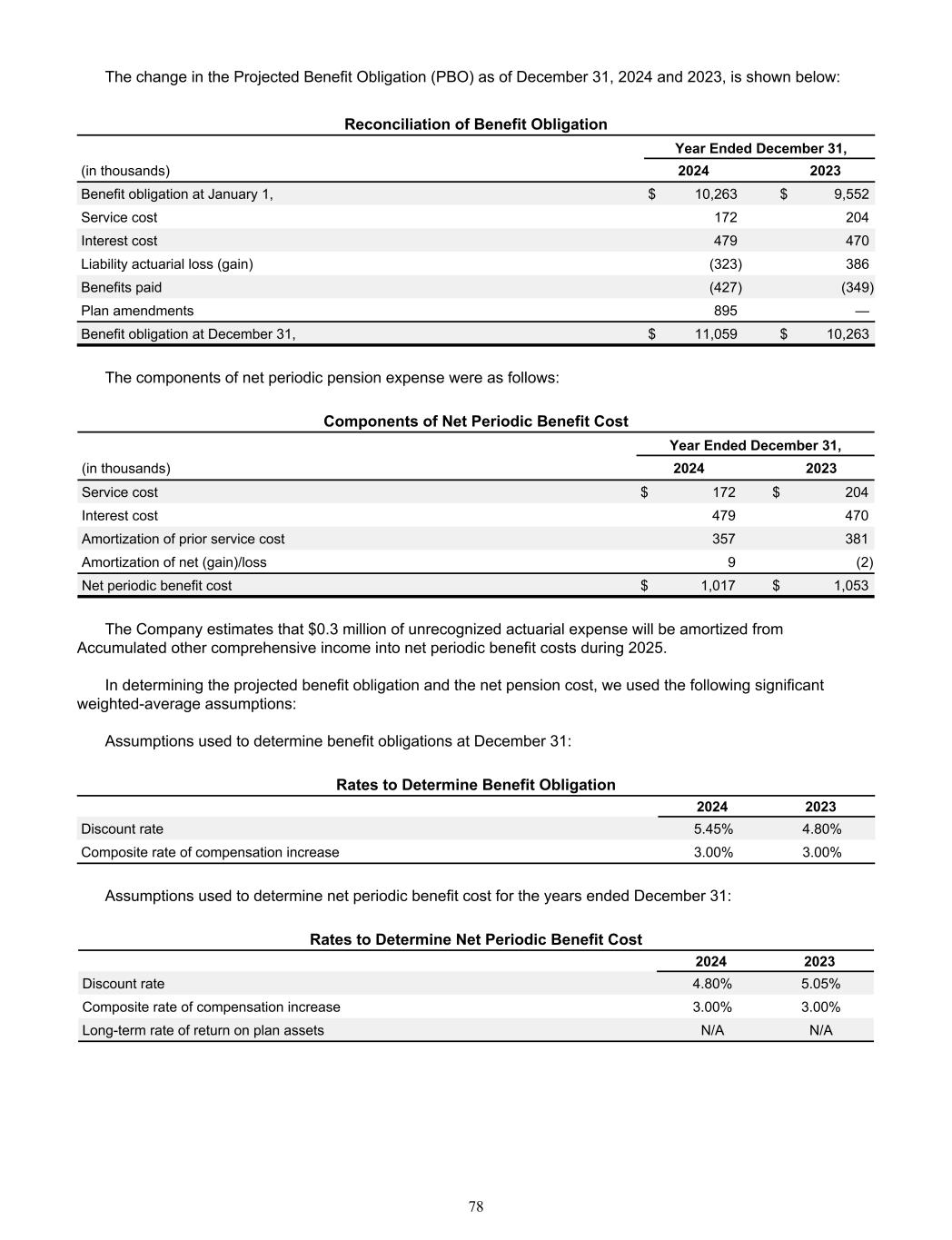
The change in the Projected Benefit Obligation (PBO) as of December 31, 2024 and 2023, is shown below: Reconciliation of Benefit Obligation Year Ended December 31, (in thousands) 2024 2023 Benefit obligation at January 1, $ 10,263 $ 9,552 Service cost 172 204 Interest cost 479 470 Liability actuarial loss (gain) (323) 386 Benefits paid (427) (349) Plan amendments 895 — Benefit obligation at December 31, $ 11,059 $ 10,263 The components of net periodic pension expense were as follows: Components of Net Periodic Benefit Cost Year Ended December 31, (in thousands) 2024 2023 Service cost $ 172 $ 204 Interest cost 479 470 Amortization of prior service cost 357 381 Amortization of net (gain)/loss 9 (2) Net periodic benefit cost $ 1,017 $ 1,053 The Company estimates that $0.3 million of unrecognized actuarial expense will be amortized from Accumulated other comprehensive income into net periodic benefit costs during 2025. In determining the projected benefit obligation and the net pension cost, we used the following significant weighted-average assumptions: Assumptions used to determine benefit obligations at December 31: Rates to Determine Benefit Obligation 2024 2023 Discount rate 5.45% 4.80% Composite rate of compensation increase 3.00% 3.00% Assumptions used to determine net periodic benefit cost for the years ended December 31: Rates to Determine Net Periodic Benefit Cost 2024 2023 Discount rate 4.80% 5.05% Composite rate of compensation increase 3.00% 3.00% Long-term rate of return on plan assets N/A N/A 78

Future estimated benefits expected to be paid from the plan over the next ten years as follows: Projected Future Benefit Payments (in thousands) SERP 2025 $ 687 2026 954 2027 957 2028 959 2029 962 Years 2030 through 2034 4,969 Defined Contribution Plans The Company has two defined contribution plans, The Gradall Salaried Employees’ Savings and Investment Plan (“Salary Plan”) and The International Association of Machinist and Aerospace Workers Retirement Plan (“IAM Plan”). The Company contributed $0.6 million, $0.5 million, and $0.5 million to the IAM Plan for the plan years ended December 31, 2024, 2023 and 2022, respectively. The Company converted the Salary Plan into its 401(k) retirement and savings plan and put the Hourly Plan into a separate 401(k) retirement and savings plan. The Company provides a defined contribution 401(k) retirement and savings plan for eligible U.S. employees. Company matching contributions are based on a percentage of employee contributions. Company contributions to the plan during 2024, 2023 and 2022 were $4.3 million, $4.5 million, and $4.2 million, respectively. Three of the Company’s international subsidiaries also participate in a defined contribution and savings plan covering eligible employees. The Company’s international subsidiaries contribute between 0% and 10% of the participant’s salary up to a specific limit. Total contributions made to the above plans were $1.2 million, $1.1 million, and $0.9 million for the years ended December 31, 2024, 2023 and 2022, respectively. 18. REVENUE AND SEGMENT REPORTING Disaggregation of revenue is presented in the tables below by product type. Management has determined that this level of disaggregation would be beneficial to users of the financial statements. Revenue by Product Type December 31, (in thousands) 2024 2023 2022 Net Sales Wholegoods $ 1,287,596 $ 1,347,264 $ 1,185,885 Parts 279,071 286,164 280,261 Other * 61,846 56,223 47,470 Consolidated $ 1,628,513 $ 1,689,651 $ 1,513,616 *Other includes rental sales, extended warranty sales and service sales as it is considered immaterial. The Company’s sales are principally within the United States, United Kingdom, France, Canada, Brazil, Netherlands and Australia. The Company sells its products primarily through a network of independent dealers and distributors to governmental end-users, related independent contractors, as well as to the agricultural and commercial turf markets. The Company’s Chief Operating Decision Maker (CODM) is the Chief Executive Officer. The CODM is responsible for evaluating the performance of the Company’s operating segments. This evaluation of operating segments supports the allocation of resources, both financial and human, to optimize income from operations as the measure of segment profit and loss. Our reportable segments are our two Divisions: Vegetation Management and Industrial Equipment. 79
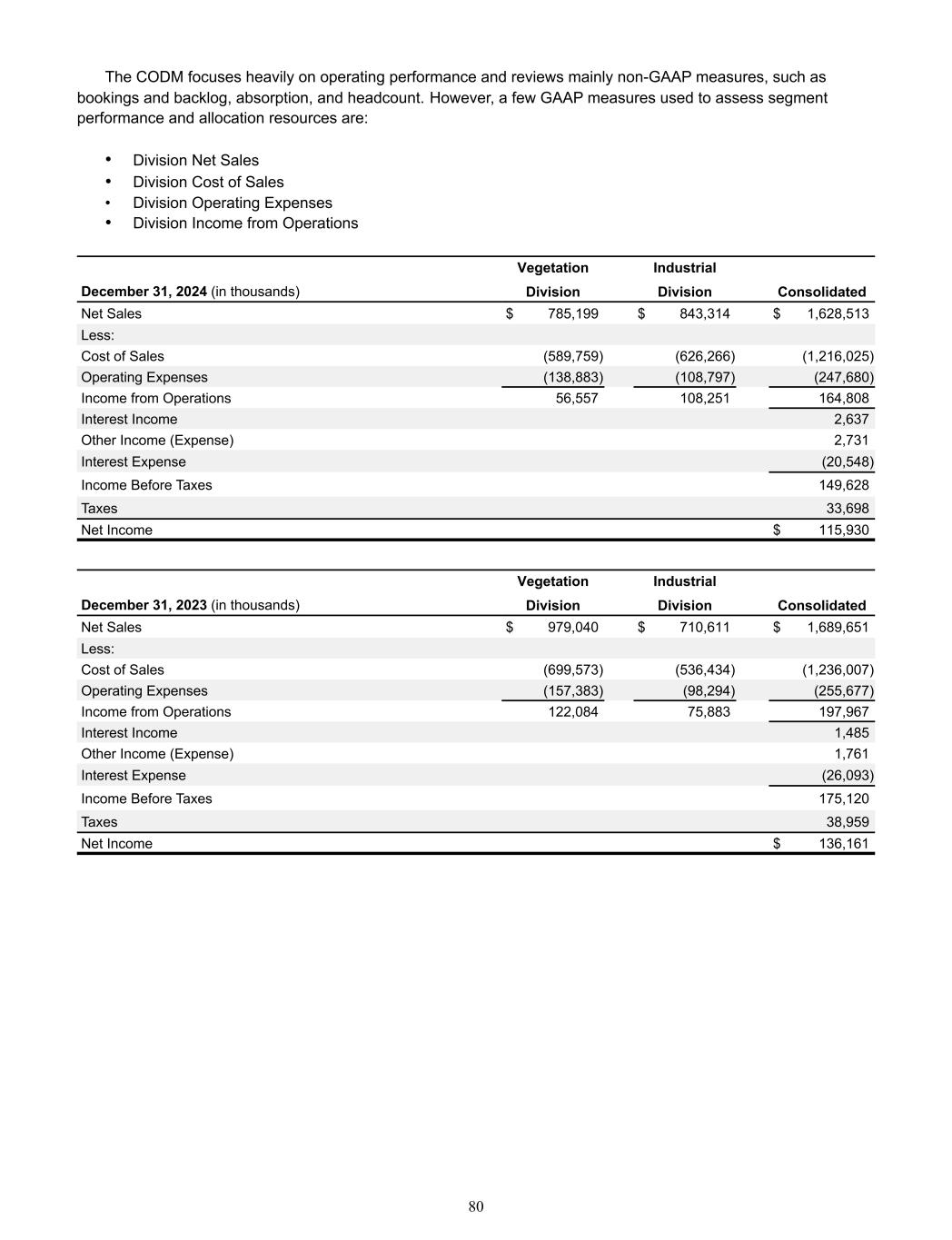
The CODM focuses heavily on operating performance and reviews mainly non-GAAP measures, such as bookings and backlog, absorption, and headcount. However, a few GAAP measures used to assess segment performance and allocation resources are: • Division Net Sales • Division Cost of Sales • Division Operating Expenses • Division Income from Operations Vegetation Industrial December 31, 2024 (in thousands) Division Division Consolidated Net Sales $ 785,199 $ 843,314 $ 1,628,513 Less: Cost of Sales (589,759) (626,266) (1,216,025) Operating Expenses (138,883) (108,797) (247,680) Income from Operations 56,557 108,251 164,808 Interest Income 2,637 Other Income (Expense) 2,731 Interest Expense (20,548) Income Before Taxes 149,628 Taxes 33,698 Net Income $ 115,930 Vegetation Industrial December 31, 2023 (in thousands) Division Division Consolidated Net Sales $ 979,040 $ 710,611 $ 1,689,651 Less: Cost of Sales (699,573) (536,434) (1,236,007) Operating Expenses (157,383) (98,294) (255,677) Income from Operations 122,084 75,883 197,967 Interest Income 1,485 Other Income (Expense) 1,761 Interest Expense (26,093) Income Before Taxes 175,120 Taxes 38,959 Net Income $ 136,161 80
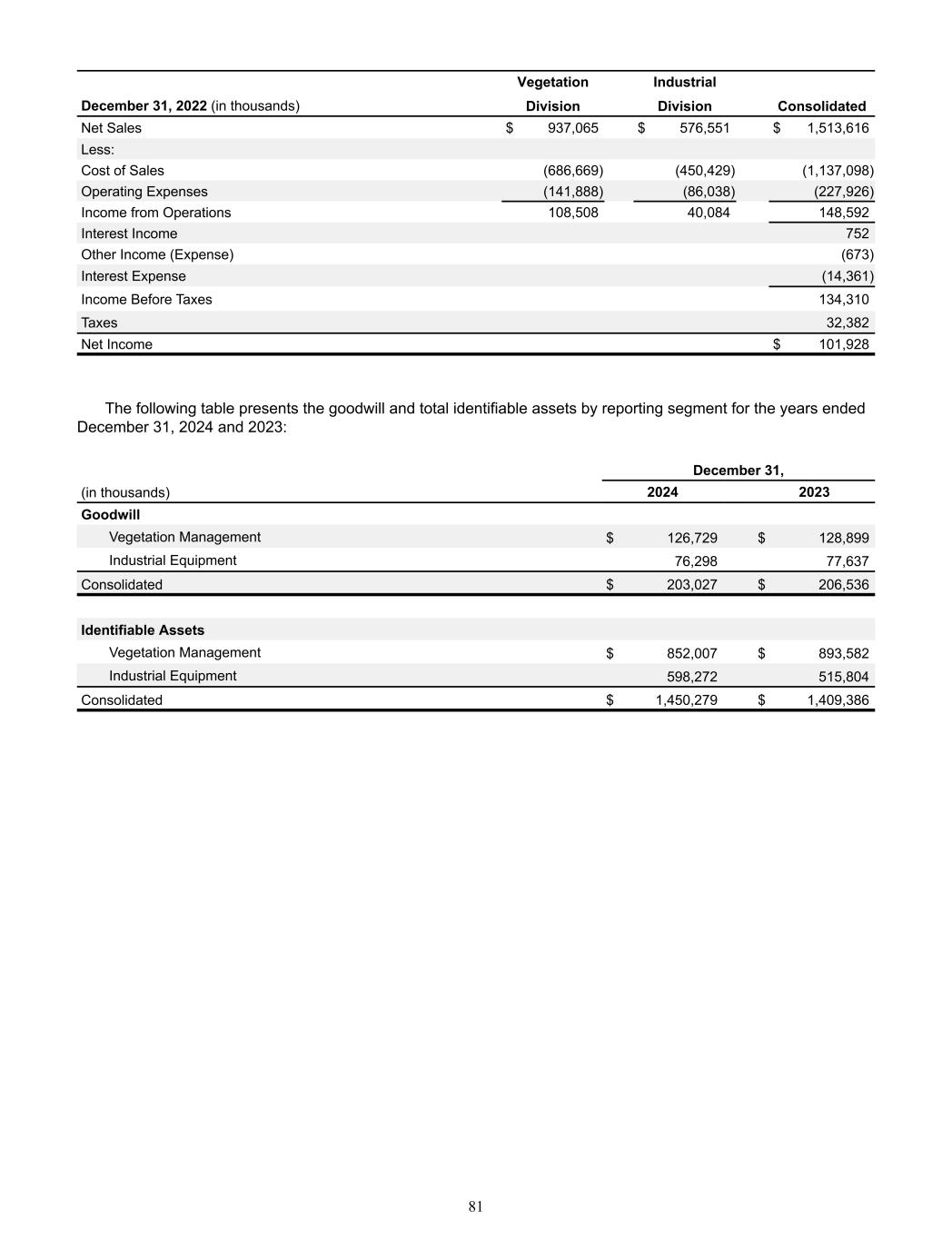
Vegetation Industrial December 31, 2022 (in thousands) Division Division Consolidated Net Sales $ 937,065 $ 576,551 $ 1,513,616 Less: Cost of Sales (686,669) (450,429) (1,137,098) Operating Expenses (141,888) (86,038) (227,926) Income from Operations 108,508 40,084 148,592 Interest Income 752 Other Income (Expense) (673) Interest Expense (14,361) Income Before Taxes 134,310 Taxes 32,382 Net Income $ 101,928 The following table presents the goodwill and total identifiable assets by reporting segment for the years ended December 31, 2024 and 2023: December 31, (in thousands) 2024 2023 Goodwill Vegetation Management $ 126,729 $ 128,899 Industrial Equipment 76,298 77,637 Consolidated $ 203,027 $ 206,536 Identifiable Assets Vegetation Management $ 852,007 $ 893,582 Industrial Equipment 598,272 515,804 Consolidated $ 1,450,279 $ 1,409,386 81
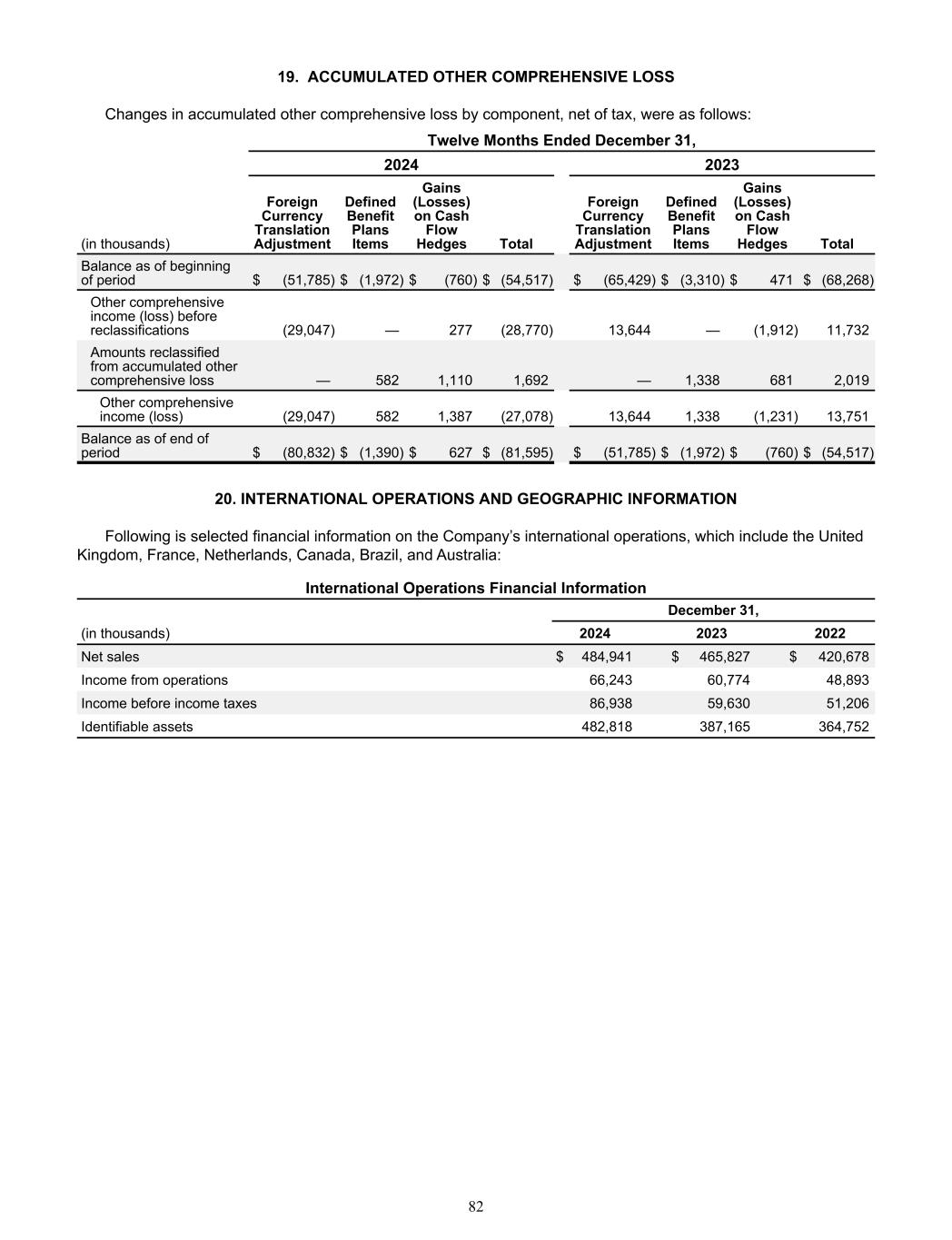
19. ACCUMULATED OTHER COMPREHENSIVE LOSS Changes in accumulated other comprehensive loss by component, net of tax, were as follows: Twelve Months Ended December 31, 2024 2023 (in thousands) Foreign Currency Translation Adjustment Defined Benefit Plans Items Gains (Losses) on Cash Flow Hedges Total Foreign Currency Translation Adjustment Defined Benefit Plans Items Gains (Losses) on Cash Flow Hedges Total Balance as of beginning of period $ (51,785) $ (1,972) $ (760) $ (54,517) $ (65,429) $ (3,310) $ 471 $ (68,268) Other comprehensive income (loss) before reclassifications (29,047) — 277 (28,770) 13,644 — (1,912) 11,732 Amounts reclassified from accumulated other comprehensive loss — 582 1,110 1,692 — 1,338 681 2,019 Other comprehensive income (loss) (29,047) 582 1,387 (27,078) 13,644 1,338 (1,231) 13,751 Balance as of end of period $ (80,832) $ (1,390) $ 627 $ (81,595) $ (51,785) $ (1,972) $ (760) $ (54,517) 20. INTERNATIONAL OPERATIONS AND GEOGRAPHIC INFORMATION Following is selected financial information on the Company’s international operations, which include the United Kingdom, France, Netherlands, Canada, Brazil, and Australia: International Operations Financial Information December 31, (in thousands) 2024 2023 2022 Net sales $ 484,941 $ 465,827 $ 420,678 Income from operations 66,243 60,774 48,893 Income before income taxes 86,938 59,630 51,206 Identifiable assets 482,818 387,165 364,752 82
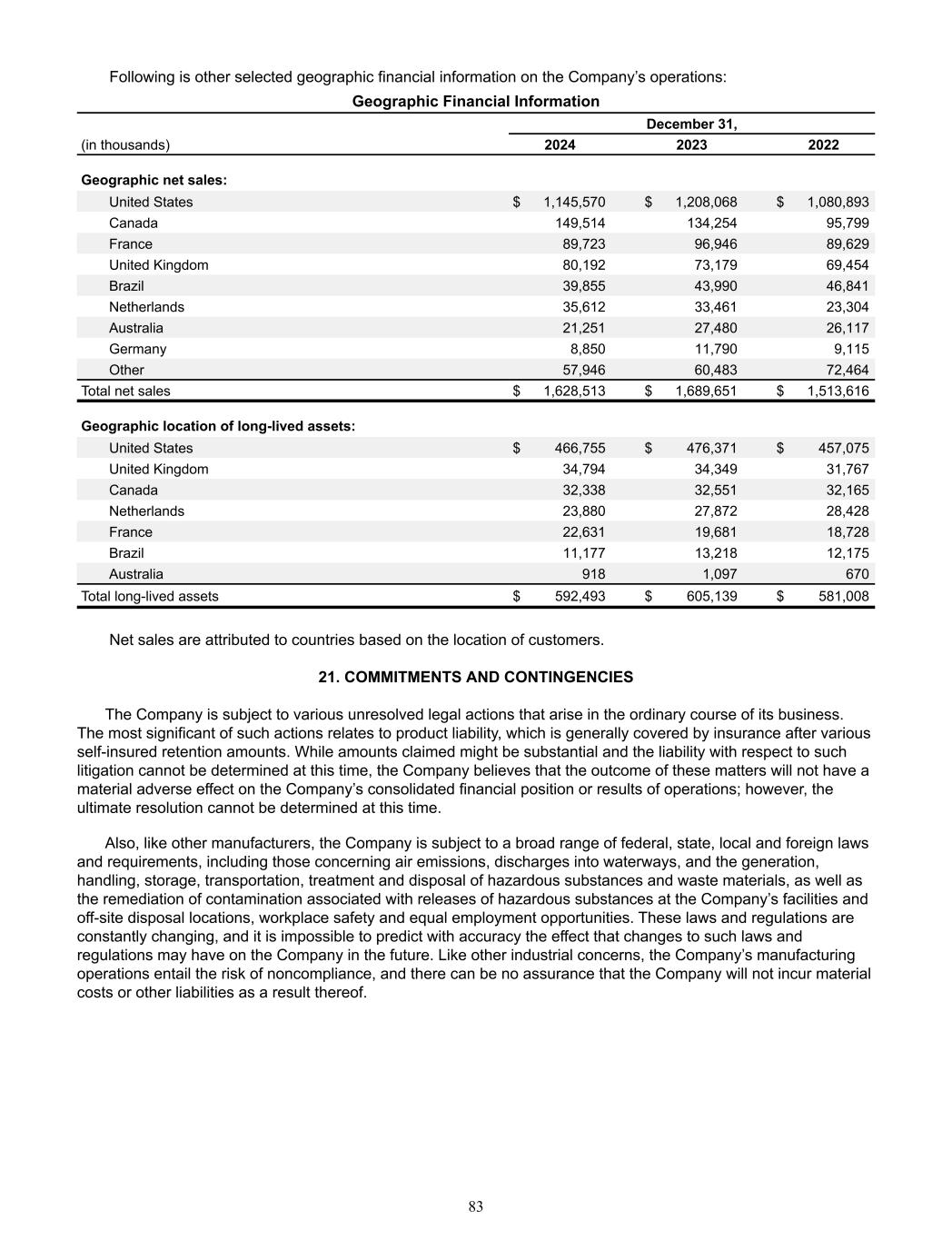
Following is other selected geographic financial information on the Company’s operations: Geographic Financial Information December 31, (in thousands) 2024 2023 2022 Geographic net sales: United States $ 1,145,570 $ 1,208,068 $ 1,080,893 Canada 149,514 134,254 95,799 France 89,723 96,946 89,629 United Kingdom 80,192 73,179 69,454 Brazil 39,855 43,990 46,841 Netherlands 35,612 33,461 23,304 Australia 21,251 27,480 26,117 Germany 8,850 11,790 9,115 Other 57,946 60,483 72,464 Total net sales $ 1,628,513 $ 1,689,651 $ 1,513,616 Geographic location of long-lived assets: United States $ 466,755 $ 476,371 $ 457,075 United Kingdom 34,794 34,349 31,767 Canada 32,338 32,551 32,165 Netherlands 23,880 27,872 28,428 France 22,631 19,681 18,728 Brazil 11,177 13,218 12,175 Australia 918 1,097 670 Total long-lived assets $ 592,493 $ 605,139 $ 581,008 Net sales are attributed to countries based on the location of customers. 21. COMMITMENTS AND CONTINGENCIES The Company is subject to various unresolved legal actions that arise in the ordinary course of its business. The most significant of such actions relates to product liability, which is generally covered by insurance after various self-insured retention amounts. While amounts claimed might be substantial and the liability with respect to such litigation cannot be determined at this time, the Company believes that the outcome of these matters will not have a material adverse effect on the Company’s consolidated financial position or results of operations; however, the ultimate resolution cannot be determined at this time. Also, like other manufacturers, the Company is subject to a broad range of federal, state, local and foreign laws and requirements, including those concerning air emissions, discharges into waterways, and the generation, handling, storage, transportation, treatment and disposal of hazardous substances and waste materials, as well as the remediation of contamination associated with releases of hazardous substances at the Company’s facilities and off-site disposal locations, workplace safety and equal employment opportunities. These laws and regulations are constantly changing, and it is impossible to predict with accuracy the effect that changes to such laws and regulations may have on the Company in the future. Like other industrial concerns, the Company’s manufacturing operations entail the risk of noncompliance, and there can be no assurance that the Company will not incur material costs or other liabilities as a result thereof. 83
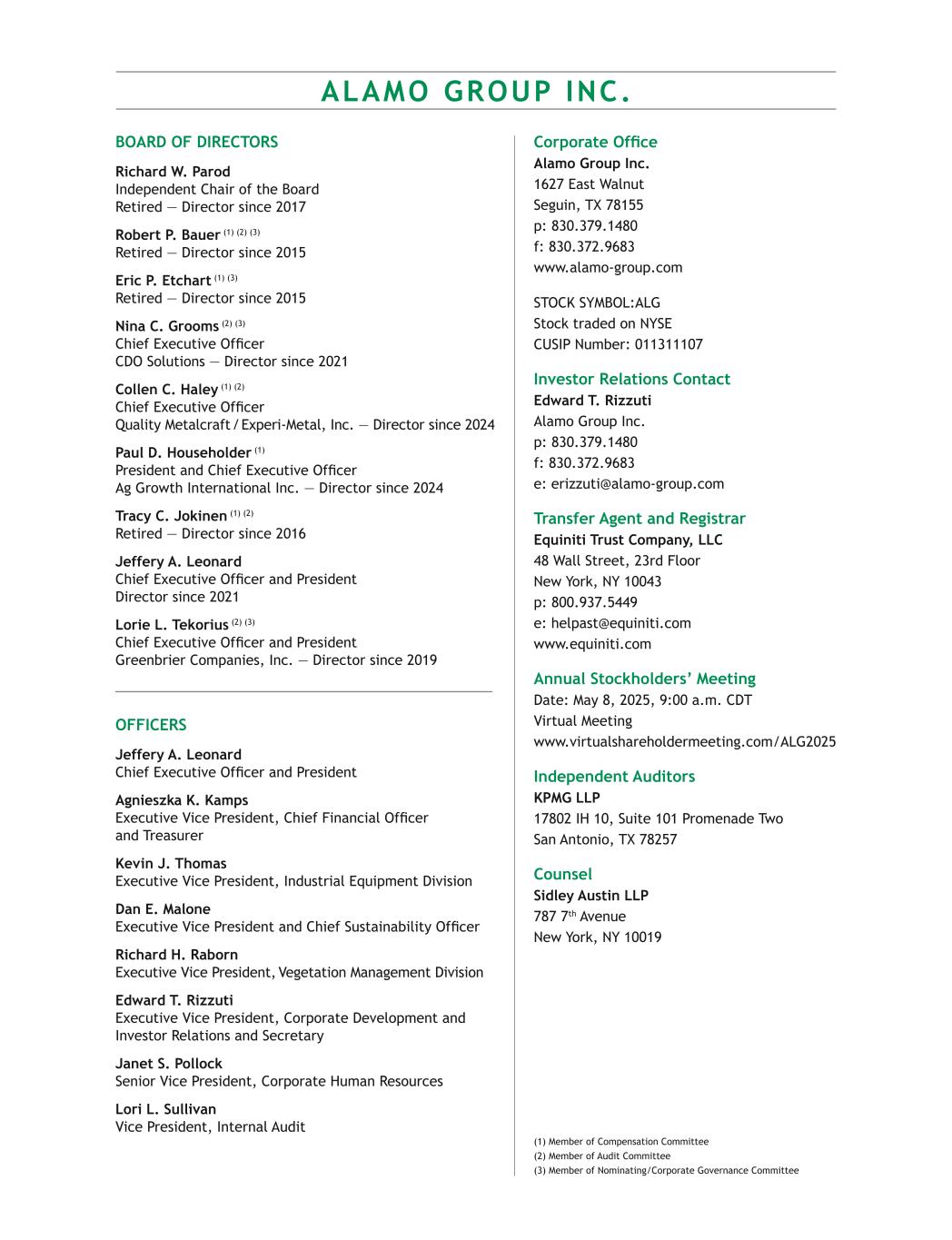
ALAMO GROUP INC. BOARD OF DIRECTORS Richard W. Parod Independent Chair of the Board Retired — Director since 2017 Robert P. Bauer (1) (2) (3) Retired — Director since 2015 Eric P. Etchart (1) (3) Retired — Director since 2015 Nina C. Grooms (2) (3) Chief Executive Officer CDO Solutions — Director since 2021 Collen C. Haley (1) (2) Chief Executive Officer Quality Metalcraft / Experi-Metal, Inc. — Director since 2024 Paul D. Householder (1) President and Chief Executive Officer Ag Growth International Inc. — Director since 2024 Tracy C. Jokinen (1) (2) Retired — Director since 2016 Jeffery A. Leonard Chief Executive Officer and President Director since 2021 Lorie L. Tekorius (2) (3) Chief Executive Officer and President Greenbrier Companies, Inc. — Director since 2019 OFFICERS Jeffery A. Leonard Chief Executive Officer and President Agnieszka K. Kamps Executive Vice President, Chief Financial Officer and Treasurer Kevin J. Thomas Executive Vice President, Industrial Equipment Division Dan E. Malone Executive Vice President and Chief Sustainability Officer Richard H. Raborn Executive Vice President, Vegetation Management Division Edward T. Rizzuti Executive Vice President, Corporate Development and Investor Relations and Secretary Janet S. Pollock Senior Vice President, Corporate Human Resources Lori L. Sullivan Vice President, Internal Audit Corporate Office Alamo Group Inc. 1627 East Walnut Seguin, TX 78155 p: 830.379.1480 f: 830.372.9683 www.alamo-group.com STOCK SYMBOL:ALG Stock traded on NYSE CUSIP Number: 011311107 Investor Relations Contact Edward T. Rizzuti Alamo Group Inc. p: 830.379.1480 f: 830.372.9683 e: erizzuti@alamo-group.com Transfer Agent and Registrar Equiniti Trust Company, LLC 48 Wall Street, 23rd Floor New York, NY 10043 p: 800.937.5449 e: helpast@equiniti.com www.equiniti.com Annual Stockholders’ Meeting Date: May 8, 2025, 9:00 a.m. CDT Virtual Meeting www.virtualshareholdermeeting.com/ALG2025 Independent Auditors KPMG LLP 17802 IH 10, Suite 101 Promenade Two San Antonio, TX 78257 Counsel Sidley Austin LLP 787 7th Avenue New York, NY 10019 (1) Member of Compensation Committee (2) Member of Audit Committee (3) Member of Nominating/Corporate Governance Committee


ALAMO GROUP INC. WWW.ALAMO-GROUP.COM